

HIKING in PATAGONIA – The Ultimate Guide to the Best Treks
- Last Updated: February 5, 2024
Everything you need to know about hiking in Patagonia. From trekking in Torres del Paine to El Chalten and everywhere in between, this list of the best hikes in Patagonia will help you plan your big adventure!
Often and widely considered as having the most breathtaking, scenic landscapes in the world, trekking in Patagonia is every hiker’s dream, whether it is for the avid day hiker to the seasoned, experienced multi-day trekker.
Patagonia is a land of dreams, ranging from the raging rivers of the Rio Moscu to the iceberg glacial lakes of Tigre Sur.
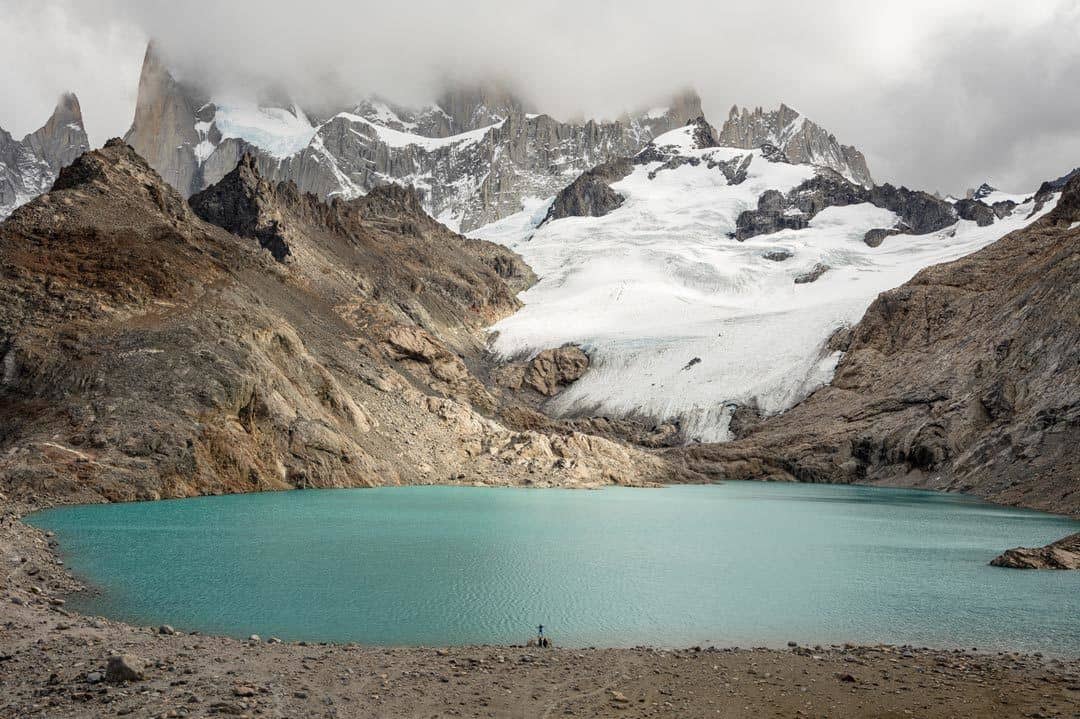
The hiking routes take you from lush meadows of wild flowers to snowy-rugged peaks at the base of the world famous Mount Fitz Roy.
Just the thought of hiking in Torres Del Paine National Park sends shivers down my spine. Ever wanted to visit one of the world’s most famous granite peaks? Cerro Torre in Patagonia is your place to do so.
There are literally endless kilometres of hikes to do, but it can be very difficult to choose just one when everything looks like it’s worthy of being on a postcard.
Patagonia truly is one if not the most beautiful places on earth, so where do you begin?
It’s every adventurer’s desire to get a taste of what trekking and hiking in Patagonia is like, so I have established a list of the best day hikes to the some of the world’s most stunning multi-day treks.
READ MORE: Don’t miss our guide on backpacking in Patagonia on a budget.
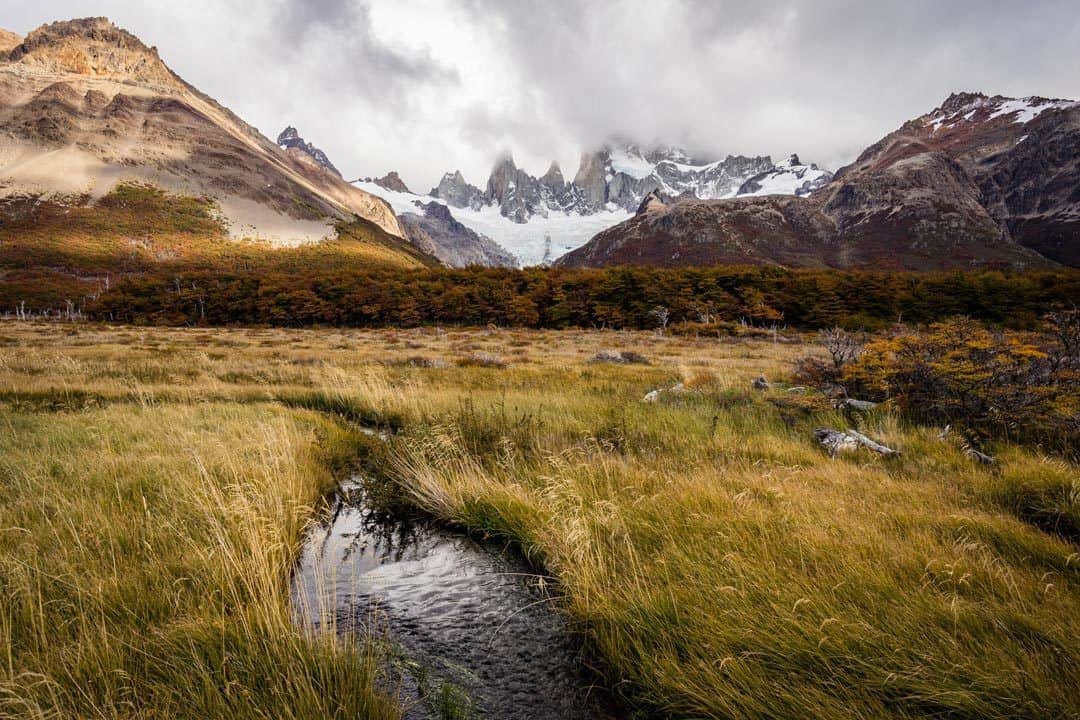
Table of Contents
Hiking to Mirador Las Torres
Lago grey (grey glacier), the french valley – valle del frances, los cuernos trail, the “o” circuit, short hike to condor lookout, day hike to the base of mount fitz roy – laguna de los tres, day hike to cerro torre, the huemul circuit, laguna esmeralda, glaciar vinciguerra, sierra valdivieso circuit, laguna tigre sur, valle rio moscu, cerro castillo, pumalin park – cascadas waterfalls hike (escondidas), save this pin for later, the best time to go hiking in patagonia.
Early November until late April are generally the best times to go hiking in Patagonia, however this can change from year to year due to varying amounts of snowfall.
Not a fan of the cold? Try and head there in February and March for the warmer months for some great Patagonia trekking.
Also it’s necessary to know that weather in Patagonia is so varied and can change at any time, which can very quickly alter your Patagonia hiking trip. Keep that in mind when planning your adventure.
Hiking according to the seasons in Patagonia has both pros and cons no matter what time of year you decide to go, so if you were going to pick a time, aim for the end of March to mid-April, where weather seems to be slightly cooler but more stable allowing you to enjoy Patagonia in all its glory.
But the best reason for visiting Patagonia at that time of year is to see the entire region in autumn colours! Simply breathtaking.
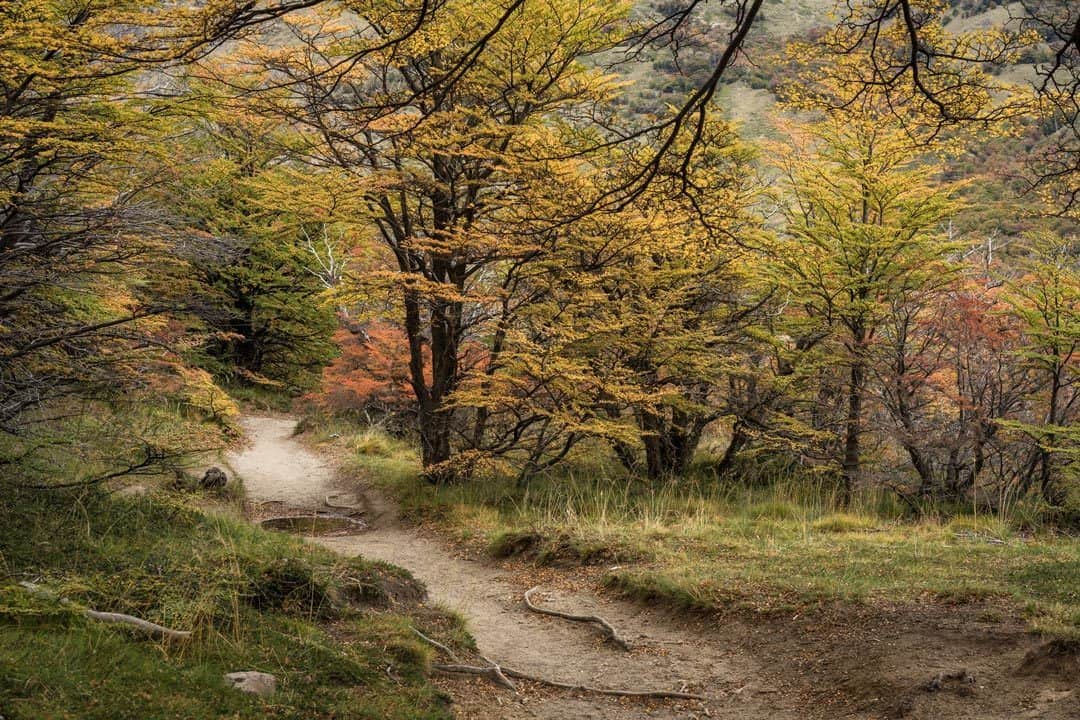
Hiking In Torres del Paine National Park
When it come to hiking in Patagonia, no trip would be complete without spending at least a few days in Torres del Paine National Park, the crown jewel of Chile.
Whether you’re interested in just heading into the park for a day hike, using one of the accommodations inside the park as a base (we personally recommend EcoCamp ), or carrying all of your camping gear and completing the famous O Circuit, you definitely won’t be disappointed with the trekking here.
- Time Required: 8 to 9 hours
- Distance: 18km
- Difficulty: Hard
- Start / Finish Points: Hotel Las Torres
Widely considered to be the most popular day hike in Torres del Paine, Mirador Las Torres is just one of the magical places you can hike to when in Torres del Paine.
Las Torres translated to English means ‘The Towers’, and mirador means ‘Lookout’ , so you should have an idea of what to expect up there.
The Towers are a series of 3 jagged peaks that literally tower over a turquoise lake below, and chances are you’ve already seen a photo of them at least once in your life.
This particular trek is 18 kilometres of visual delights, despite it being considered as a difficult hike, and the views once you reach the top are just awesome!
Most of the trek is uphill, but don’t let that put you off this classic day hike, as cascading waterfalls, forests beaming with life and boulder fields dominating the higher landscapes and just waiting for you to enjoy.
The last hour is extremely steep, so make sure you save some energy for the final slog.
If you are after a really magical experience spend the night in the park and start hiking up in the dark. If the weather cooperates you’ll be rewarded with Las Torres looking as though they’re on fire with the red sun lighting them up at sunrise.
Las Torres is a hiker’s dream, and if you could only choose one trek in the whole of Patagonia, this would be it! Return via the same way you climbed, starting and finishing at the Hotel Las Torres.
Prefer to hike with a guide? Book your Mirador Las Torres tour here with Get Your Guide.
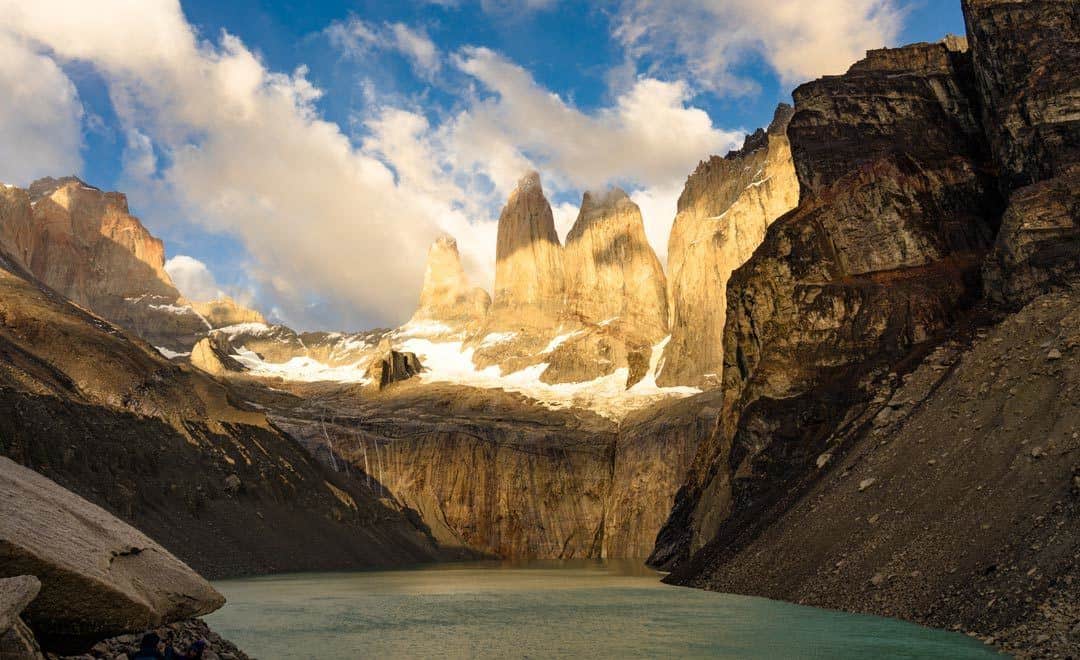
- Time Required: 3 to 4 hours
- Distance: 11 kilometres
- Difficulty: Easy to moderate
- Start / Finish Points: Mountain Lodge Paine Grande to Refugio Grey
As you might know there are quite a few glaciers in Patagonia (you can even visit some on an amazing glacier cruise in the Chilean fjords ), but this one takes the cake as the best of the best.
Along the famous “W” Trek, towards the western part of the hike, is a long section that follows the Lago Grey lake, which is gradually fed by a huge glacier known as Glaciar Grey.
Here you can expect to see pale blue icebergs floating around in the Lago Grey, as parts of Glaciar Grey collapse into the lake below and it’s a spectacular sight to see!
From Refugio Grey to Mountain Lodge Paine Grande is a 3 to 4 hour hike spanning over 11 kilometres, with little ascent or descent making it a fairly easy day out.
Expect to see vast areas of vegetation, wild flowers and the odd section of track that requires a tricky traverse but nothing too major. Keep an eye out for the majestic Cerro Torre piercing the sky.
Camping is available at Mountain Lodge Paine Grande and Refugio Grey if you want to spend the night there. Otherwise take the ferry to Paine Grande or Refugio Grey and start walking.
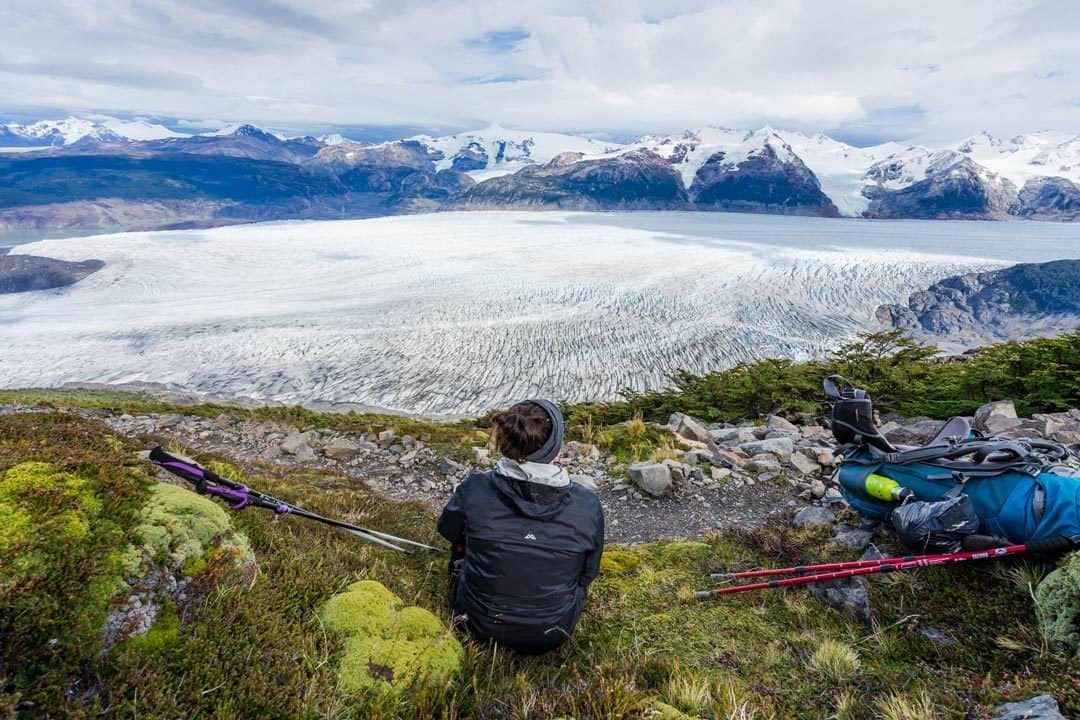
Alesha enjoying the view over Grey Glacier.
- Time Required: 3 to 4 hours
- Distance: 12km
- Difficulty: Moderate
- Start / Finish Points: Refugio Los Cuernos
You always have energy in Patagonia, even when you are literally falling asleep, so don’t miss this epic side trip that takes you between the Cerro Paine Grande and the Cuernos del Paine following the flowing river of the Rio Frances.
Why this hike is the one of the most spectacular side trips is because it has frozen waterfalls…how cool is that?!
READ MORE: We’ve just published our best hiking tips after 15 years trekking!
Also pretty dangerous though, so don’t be getting your ice picks out too soon, because there are views much higher up that you can enjoy, such as the 15 minute trek past the Campamento Britanico placing you in an almost cathedral of mountains.
The Mirador right towards the end is complete with a series of tarns beaming the reflections of the surrounding mountains making it that ideal moment to getting that camera of yours out! Camping is available (minus the facilities of toilets etc). Return the same way you came.
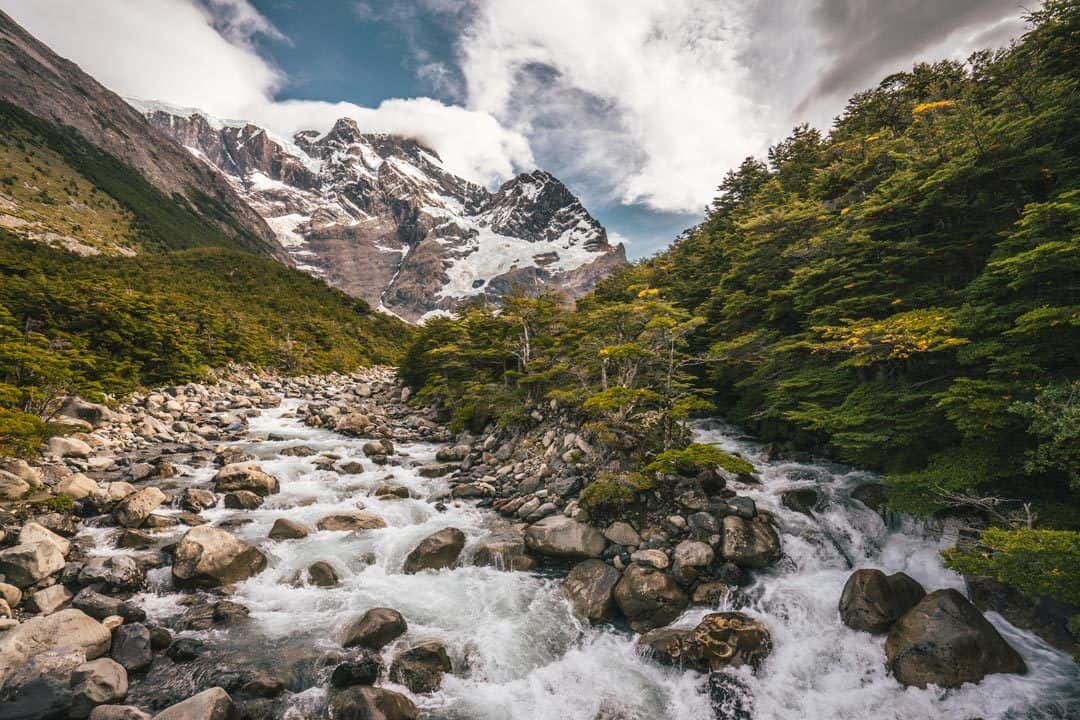
- Time Required: 6 hours
- Distance: 22km
- Difficulty: Moderate
- Start / Finish Points: Hotel Las Torres to Refugio Los Cuernos
Based along the front half of the park, home to the W Trek, is a fantastic day hike weaving around a series of steep banks perched along the edges of the Lago Nordenskjold.
Los Cuernos Trail, which means ‘The Horns’ in English and named after the mountains you can see that are shaped like horns, is a beautiful stretch offering views of the Cuernos del Paine, which never cease to amaze, and gorgeous vistas over the lake.
If you still have bounce in your step when you finish the trail, consider a side trips up the Valle del Frances, an additional 12 kilometre stunning section of track.
Plenty of camping is available on the south side of Cuernos Del Paine if you prefer to take more time on this hike (just keep in mind it gets quite windy in these camp spots).
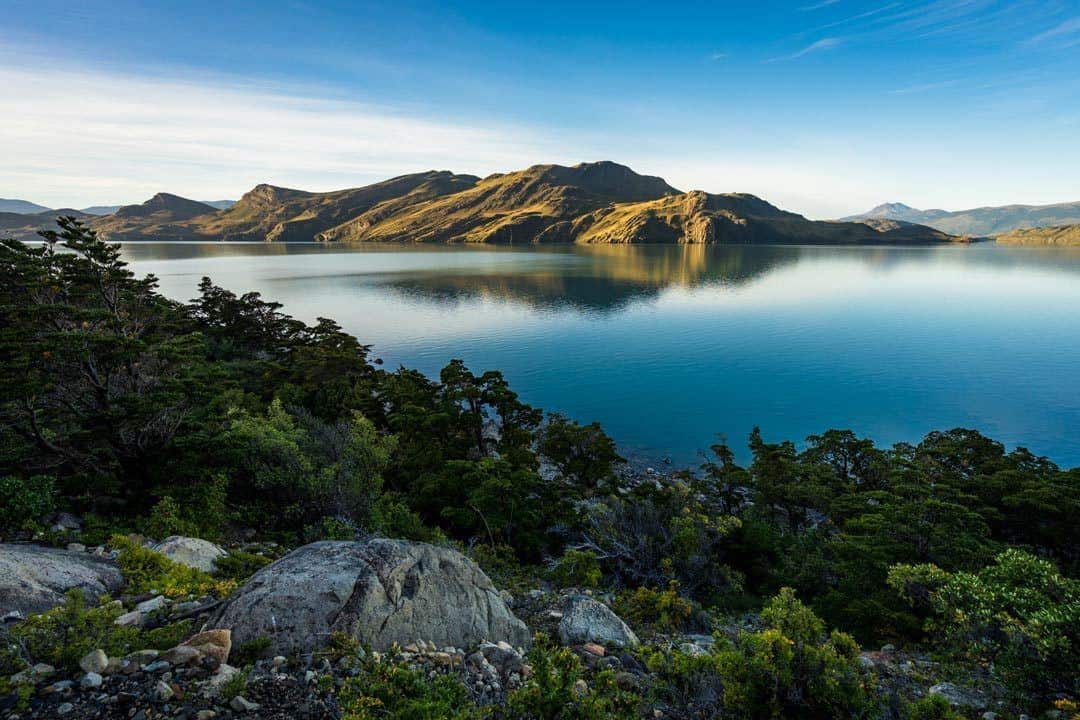
- Time Required: 6-8 days
- Distance: 135km
- Difficulty: Hard
- Start / Finish Points – Hotel Las Torres
Defined as one of the best treks on earth, the Paine Circuit, commonly known to the hiking world as the “O” Circuit due to its shape on a map, is a must do if you have a sense of adventure.
The circuit literally has it all, from pristine forests, meadows of native wild flowers to the grand peaks of Cerro Paine and Cuernos del Paine…and let’s not forget the addition of Las Torres along the eastern side of the trek.
You are best off starting at Hotel Las Torres and heading to Campamento Seron, where views of Cerro Paine (1,508 metres) dominate your surrounds along with rivers flowing off Lago Paine.
Once you connect with the track along the Rio de los Perros, mountains begin to pop-up more frequently along with glaciers, but be sure to pitch your tent at the campsite on Lago Dickinson, as views here are some of the best along the hike.
As you continue to be blown away by Grey Glacier in Torres del Paine (hopefully not by the wind), you find yourself on the trail that begins the “W” trek, which is the shorter, more popular sister of the O Circuit, which begins at Refugio Grey camping area.
Finishing the “O” circuit adds side trips along the French Valley (a must-do hike) and up to Las Torres to watch the sunrise, then heading back down to where you started.
If you want to finish on an alternative route, from Mountain Lodge Paine Grande you can hike along the Rio Grey to the Lago del Toro administration centre.
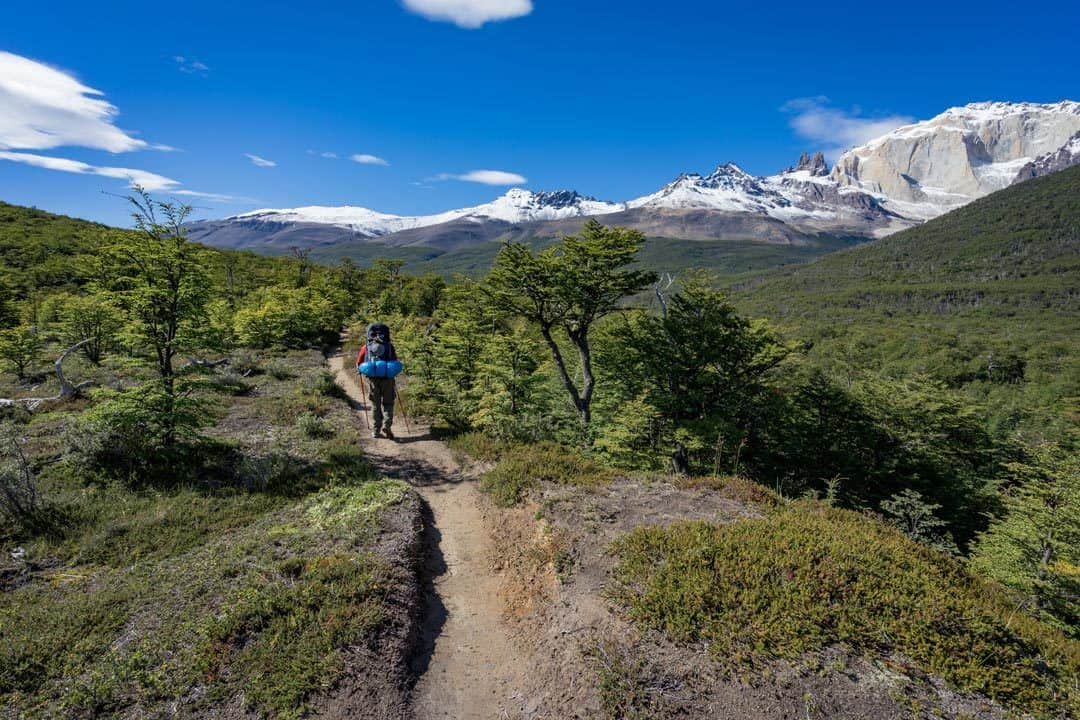
Trekking In El Chalten
While Torres del Paine is the most popular place to go hiking in Patagonia, the truth is El Chalten is the place that will steal most people’s hearts.
Across the border in Argentina, further north of Perito Moreno and its amazing glacier, is a tiny village called El Chalten that sits in the middle of Los Glaciares National Park.
What makes El Chalten so epic is that not only is entrance to the national park free (yes!!!), all of the hikes start from right in the middle of the village.
So once you’ve finished ticking off the quintessential Torres del Paine treks, head off to tackle some of the best hikes in El Chalten!
- Time Required: 1 hour
- Distance: 2km
- Difficulty : Easy
- Start / Finish Points: El Chaten
Based out of El Chaten is one of the shortest hikes in Patagonia, which mostly consists of a gradual ascent to views from Las Aguilas.
Just because it’s short doesn’t mean it’s not worth doing. The views are quite unexpected, as Viedma Lake appears with a backdrop of stunning, ever-covered mountains of snow.
This is a great hike to do for sunrise in case you don’t feel like camping out in the middle of the park. Return the same way you came.
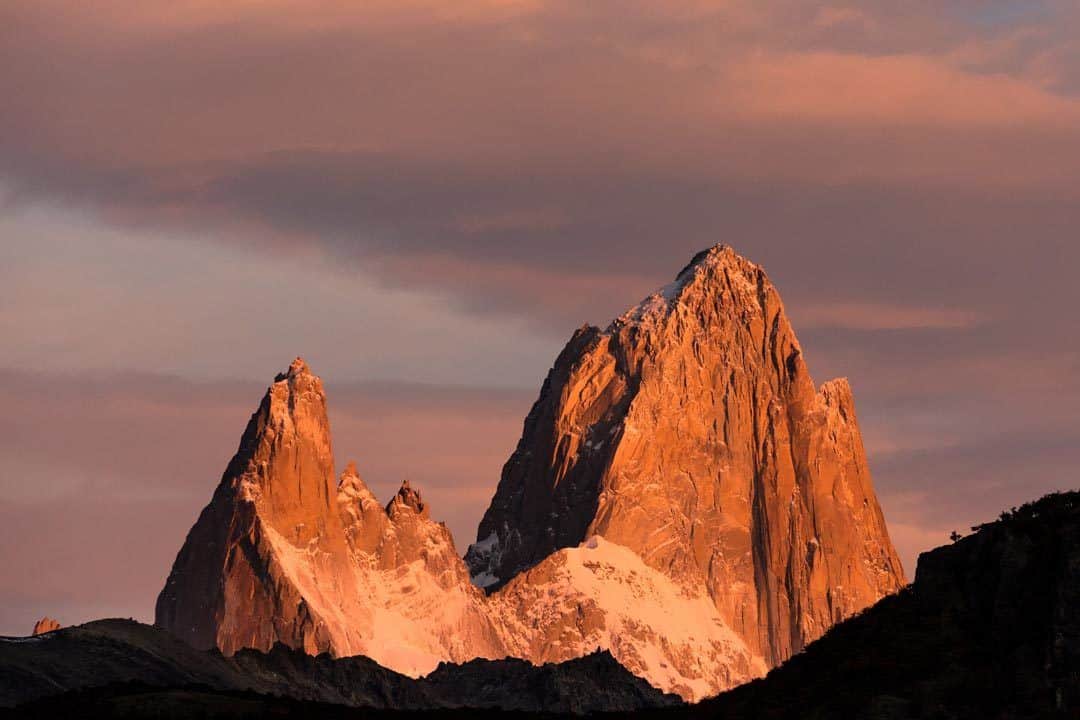
- Time Required: 8 hours
- Distance: 26km
- Difficulty: Moderate to hard
- Start / Finish Points: Northwest end of El Chalten
This hike will be the one that takes you as close as you can get to the foothill of Mt Fitz Roy, and one of the best hikes in El Chalten.
It’s best off to start early to enjoy the morning alpine glow on the peaks above, but that could be said of most treks in Patagonia.
The trail is pretty mellow to begin with, and there are a few narrow sections through forests which are lovely. Then the hard part comes.
Zig-zagging up and up for the last hour, you will finally reach Laguna de los Tres, with the most epic views of Mt Fitz Roy soaring above you!
Depending how skilled you are in the mountains, there is a climb that proceeds up the peak of Cerro Madsen (1,806 metres) for even better views of Fitz Roy.
Return the same way you came to head back to El Chalten, unless you are deciding to camp at Campamento Poincenot.
Prefer to have a guide? Book your Mount Fitz Roy tour here with Get Your Guide.
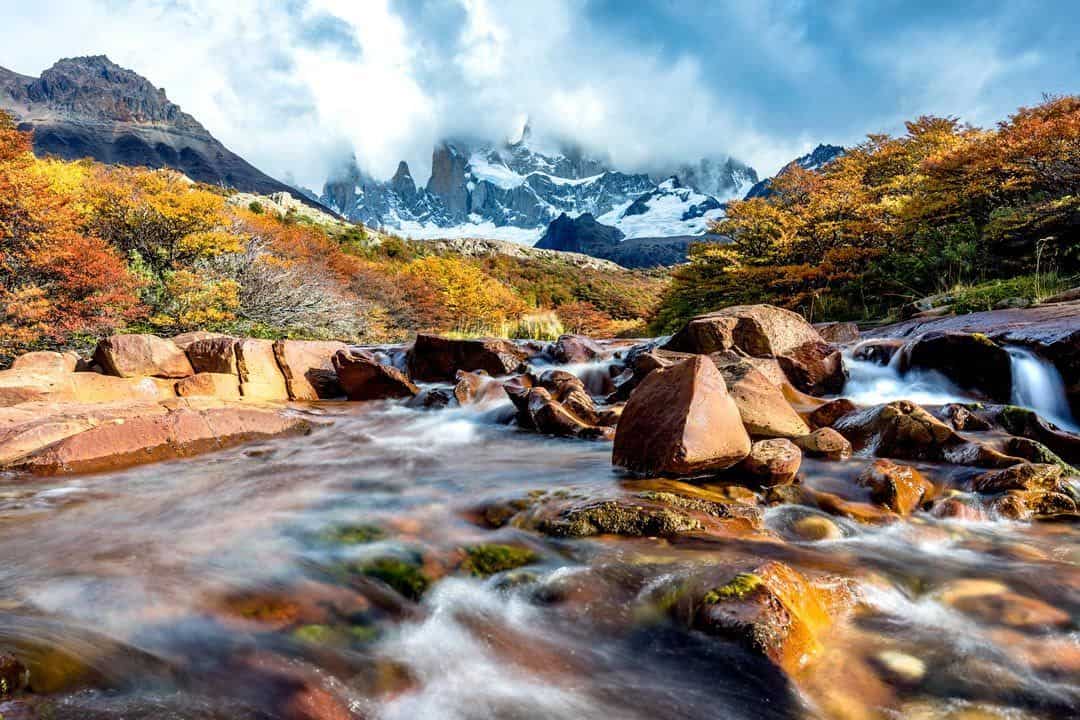
- Time Required: 2 days (can be done as a day hike)
- Distance: 19km
- Difficulty: Easy
- Start / Finish Points: El Chalten
A perfect opportunity to get up close and personal with Cerro Torre, reaching into the sky at 3102 metres, can be done as a day hike, but I think it’s pretty cool to take refuge at Campamento de Agostini at the base of Laguna Torre.
This 2-day trek is a culmination of lush meadows, rugged ever-changing glaciers and stunning views of Cerro Torre and its surround snowcapped peaks.
As a side trip, opt for the Mirador Maestri lookout which will add an additional 5 kilometres to your adventure. At Mirador Maestri be prepared for uninterrupted views of Cerro Torre in all its glory!
On return, head back the same way you came with views looking down the Rio Fitz Roy (a glaciated river from Glaciar Torre).
Prefer to have a guide? Book your Cerro Torre tour here with Get Your Guide.
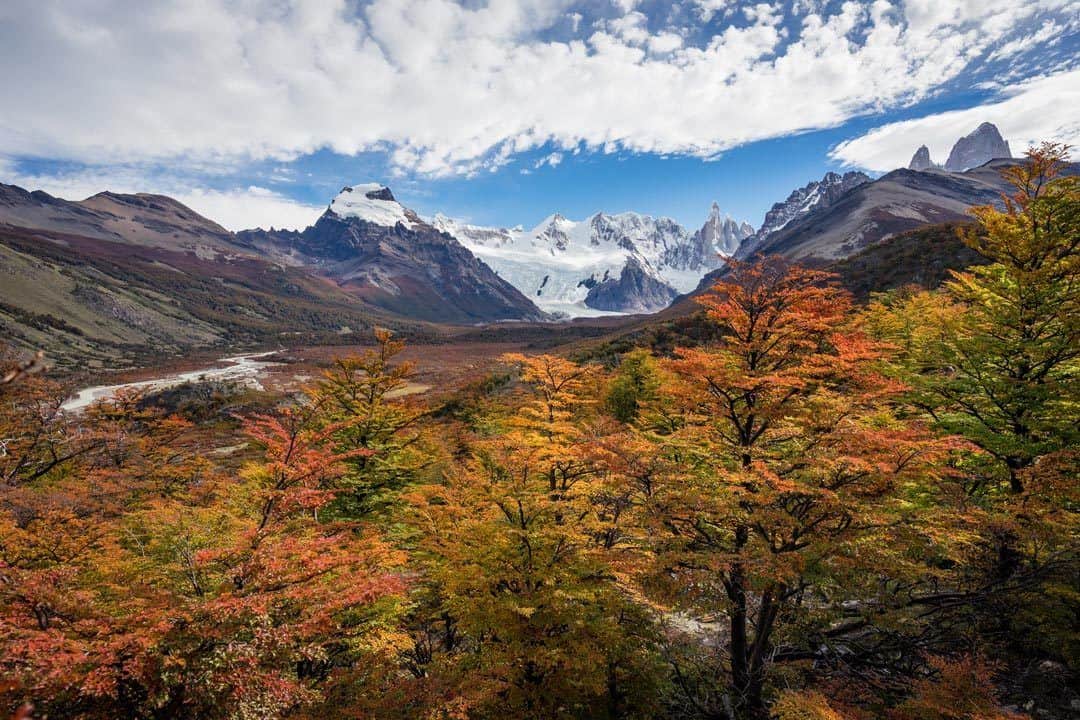
- Days Required: 4 days
- Distance: 63km
- Difficulty: Very difficult
This one is up there as one of the most difficult treks in Patagonia, so be prepared to be fully tested in this stunning lesser-known area of El Chalten.
This Patagonian trek, while demanding in nature, takes you into areas where Cerro Solo can be seen almost standing alone, hence the name ‘solo’.
Mount Huemul is also just as impressive as the contrast between the forest floor, fields of green pastures and rocky spires mix to create stunning views.
The Huemul track puts you to the test with a river crossing almost chest deep as you navigate the Rio Tunel with majestic mountain backdrops.
It only gets harder from here as the Southern Patagonian Ice Field nears, with a climb to Paso del Viento, which is sure to get your blood pumping.
But that’s not all, with a demanding climb to Passo Huemul presenting the clash of Lago Videma (lake) and the walls of the Videma Glaciar.
Views here are gobsmackingly awesome! Take your time to breathe in the fresh air before descending back the way you came.
The Huemul Circuit is considered as a very difficult trek, so its best off to hire a local guide who can help you navigate the rivers and provide insights into one of Patagonia’s most magical areas if you aren’t experienced.
Either way you’ll need a harness and know how to use it, so all hikers on the Huemul Circuit must check in at the information centre before departure to prove they know what they’re doing.
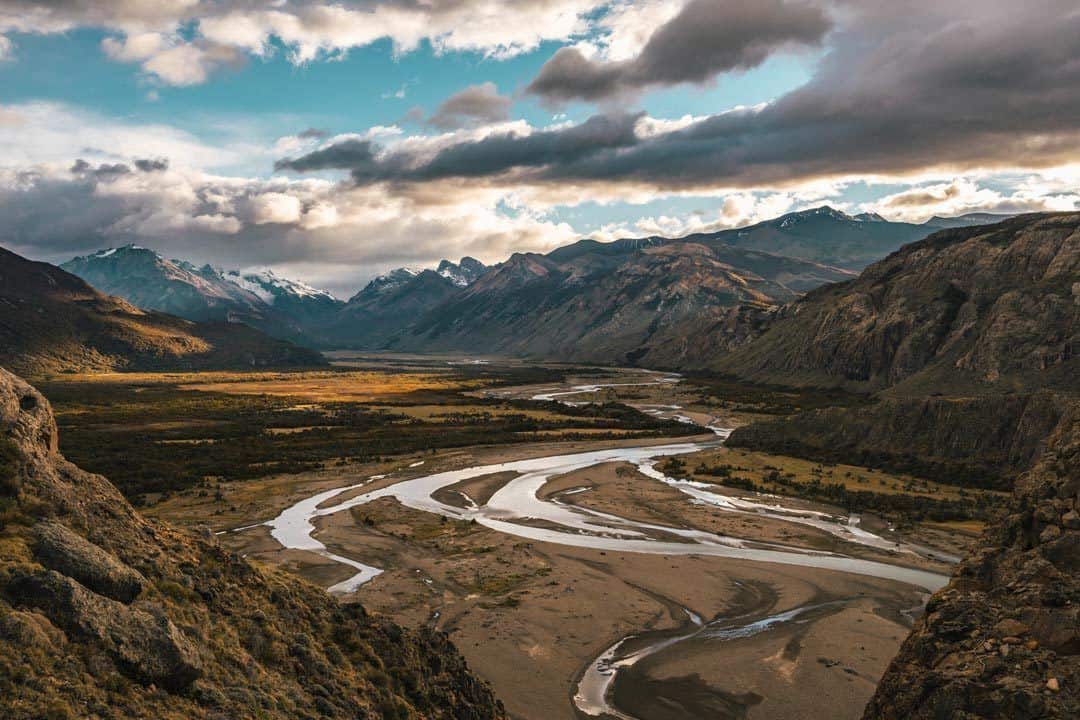
The Best Hikes in Ushuaia
Located at the bottom of Argentina and known as being ‘the end of the world’, Ushuaia is a place that often draws visitors looking to hang out at the bottom of South America. (Click here to read about our experience there.)
It also is a departure point for many people heading off on an expedition to Antarctica.
For those of us that love the outdoors, Ushuaia offers so much more though, and it’s worth spending a few days here to get in some good treks. These are some of the favourite hikes in Ushuaia!
- Distance: 9km
- Start / Finish Points: Refugio Valle Los Lobos
Patagonia isn’t all about multi-day treks, as sometimes the shorter it is the sweeter it tastes. Laguna Esmeralda is an easy 9 kilometre hike to the base of a glacier known as Glaciar Del Albino.
If you prefer to spend extra time taking in the stunning views, a refugios ‘ campsite’ is available near the lake towards the end of the hike allowing you to absorb your surrounds.
At the top, be rewarded with mesmerising views of the Esmeralda Valley down below.
Although this day hike is short, there is an opportunity to put on your crampons and go for a walk along Glaciar del Albino.
The walk on Glaciar del Albino does require advanced hiking skills and that extra bounce in your step, so add up to 4 hours on to your day.
If you’re not fully prepared for it and know what you are doing, don’t go past the 50 metre marker unless your name is Jimmy Chin.
- Days Required: 5 to 6 hours
- Distance: 13km
- Difficulty: Moderate
- Start / Finish Points: Tubera Valle Andorra
This moderately difficult Patagonian trek takes you to a series of glacial lakes with a few steep ascents, making this hike a worthy challenge for avid single day trekkers.
After a series of gradual/steep ascents, Laguna Encatada is finally reached, which is surrounded by lush meadows of grass with reflections of rugged peaks glimmering off its surface.
Hiking to Laguna Encatada provides a unique opportunity to climb the steady peak of Cerro Esfinge, rising to 1275 metres. At the top, the views are breathtaking!
When I think of this hike, I see rugged peaks, flowing hills of dark green grass blowing in the wind with cascading streams of water, and that’s exactly what it is!
The Glaciar Vinciguerra hike sees glaciers precariously wedged between the mountains you are hiking around, as glacial melt trickles past fields of wild flowers.
The water from the glaciers ends up accumulating in glacial lakes where the odd chunk of ice sits bobbing in the freezing waters.
Return the same way you came.
- Time Required: 4 Days
- Distance: 48.5km
- Difficulty: Demanding
- Start / Finish Points: Ruta Nacional 3 or Posada del Peregrine
Deep within the heart of the Fuegian Andes lays one of the more challenging treks in Argentina, but one that you definitely need to consider as a must do hike in Patagonia.
Trekking in the Patagonian Andes wouldn’t be complete with just lush-rugged forests; allow some icy peaks extending from the area’s many glaciers and crystal clear lakes (probably not ideal for swimming) to encompass your surrounds.
This particular trek is a lot quieter than some like the “O” Circuit, as tracks remain barely trodden, so a good sense of direction is always appreciated before attempting this 4 day, 48.5 kilometre trek.
Due to unstable weather conditions in this part of Argentina, it’s always appropriate to take more supplies than you think you will need.
Sierra Valdivieso is a culmination of muddy paths with contrasting streams of blue glimmering glacial water and is something that will acquire your sense of adventure.
This hike in the Fuegian Andes is a classic mix of snow, ice and scree which can be difficult in parts, but once you ascend to the high passes it all makes getting dirty worth it!
Prefer to have a guide? Book your Ushuaia hiking tour with Get Your Guide.
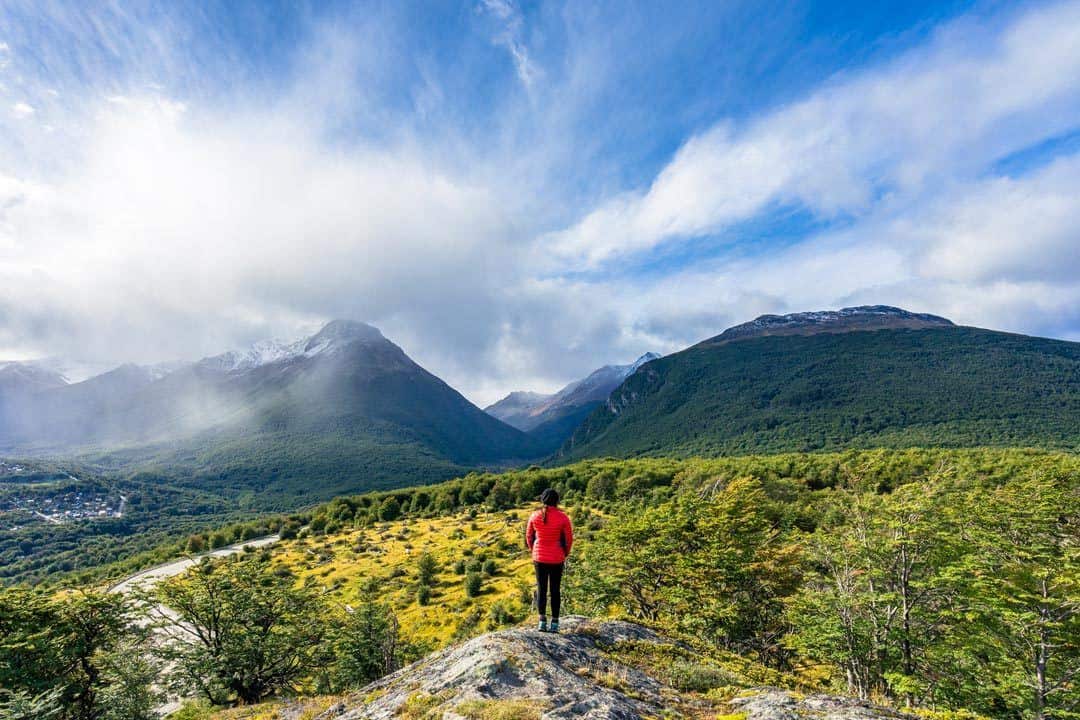
The Best Hikes Along The Carretera Austral
One of the least-visited parts of Patagonia is the long, narrow strip of coastline that makes up the bottom part of Chile.
While most people will make it to Torres del Paine and Puerto Natales , few cross back into the country and continue along the epic highway known as the Carretera Austral.
Public transport is just about non-existent along this long, rugged road, which leaves people to either hitchhike or self-drive between the towns.
When winter comes the place all but shuts down, so that leaves a big part of Chile that not many people see. But that doesn’t mean you shouldn’t check it out!
The Carretera Austral has some insane landscapes and gorgeous mountains and lakes. The coastline is as dramatic as you could imagine, and that all ads up for some amazing hiking!
- Time Required: 4 hours to 2 days (depending on side trips)
- Distance: 8km
- Start / Finish Points: Villa O’Higgins
Patagonia is known for its spectacular glacial landscapes and what better opportunity than to view them by hiking the Laguna Tigre Sur, a moderately difficult hike into some of the most densely populated region of glaciers.
This particular hike is best undertaken with the expertise of a local guide due to it being slightly confusing in regards to finding the correct track to take.
But don’t let that put you off visiting this glaciated area, as Laguna Tigre Sur offers a look into the wilder side of Patagonia, with the odd tricky ridge walk leading you to nearly undiscovered views, glaciers and mountain peaks.
High above the Glaciar Tigre is the Cordon Nevado where chilling winds and extreme temperatures can make things difficult so come prepared for the cold.
There are two side trips to choose from or you can do both with camping spots available. The first side trip leads to the base of the larger Glaciar Tigre Sur where wild flowers thrive in small pockets.
There are a few sections which require the use of your hands to navigate smaller gaps in the larger boulders. At the end of the trail its icebergs galore! Allow 2 hours for this side trip.
The 2 nd side trip continues onto the smaller glacier known as Glaciar Tigre, taking you past large gorges, pristine streams and colourful meadows. Allow 3 hours for this side trip and return the same way you came.
- Time Required: 2 days
- Start / Finish Points: Villa O’Higgins
Similar to what Laguna Tigre Sur provides in terms of glacial views, Valle Rio Moscu is an easy walk generally hiked in 2 days in order to explore a heavily glaciated valley towered by Patagonia’s famous jagged mountain tops.
Hiking at Valle Rio Moscu has a few tricky components such as small stream crossings, best to be taken when the river is low (check with local guides when this is).
The Rio Moscu is a fast-flowing river fed by smaller streams originating from the Cordon de Villa O’Higgins range, while glacial melt from the Ventisquero Rio Moscu contributes an overwhelming amount of water to the raging river.
Ideally it’s best to spend 2 days in the valley as you can explore a spectacular frozen world sitting high in the mountains above.
Camping is available at Refugio Rio Moscu, approximately halfway along the Rio Moscu.
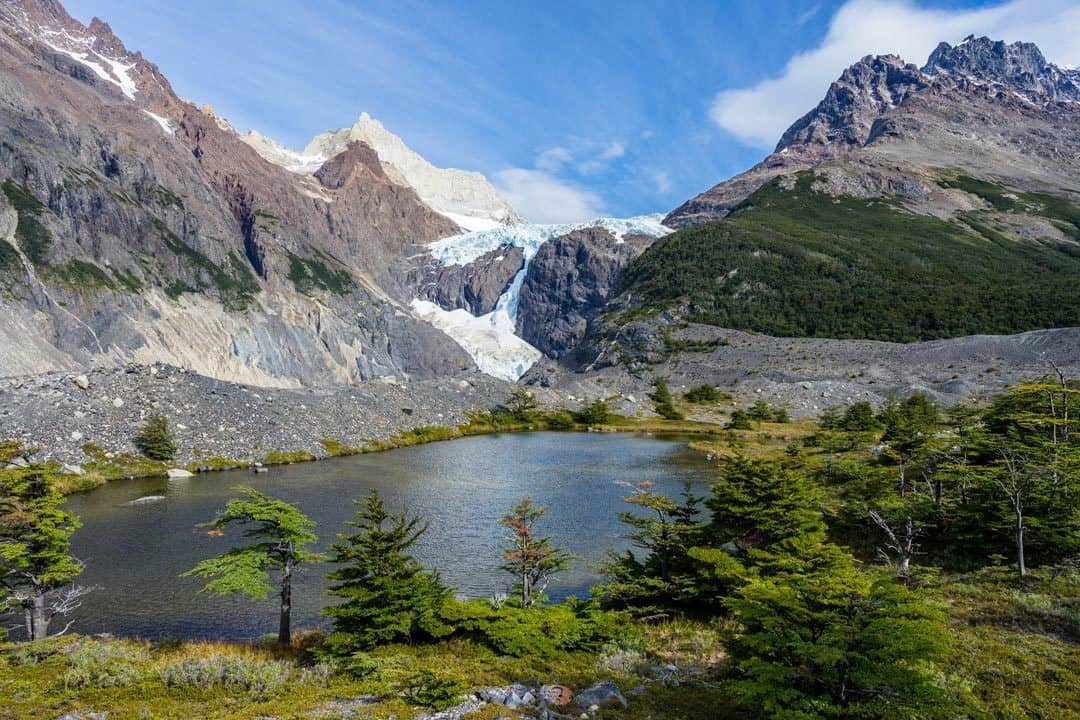
- Days Required: 4 days
- Distance: 62km
- Difficulty: Moderate to demanding
- Start / Finish Points: Las Horquetas Grandes to Villa Cerro Castillo
This 4-day trek will take you through majestic alpine landscapes guaranteed to lead you to plummeting waterfalls, isolated glaciers tucked away into the mountainous backdrops which you will find yourself immersed.
Cerro Castillo is a culmination of everything you think Patagonia is, all jam packed into this one epic Patagonian trek.
It will put you to the test with river crossings in freezing glacial waters, and parts of it needing spot-on navigational skills. Although tracks are well-trodden, they can be impeded by Patagonia’s wild untamed weather.
The whole hike consists of weaving in and out of a valley where mountains range from 1500 metres to a massive 2,675 metres of Cerro Castillo.
Camping is available the whole way along the trek, allowing you to take your time on one of Patagonia’s lesser known hikes which is increasing in popularity.
To gain a different perspective of Cerro Castillo, opt for the side trip into Upper Valle Parada, adding an additional 3 kilometres to your trek, where small lakes such as Laguna Duff remain hidden gems and well worth the extra few hours’ efforts.
The hike finishes at Villa Cerro Castillo, which can be taken by following either the Rio Ibanez or the adjacent path at Morro Rojo peak.
- Days Required: 1 to 2 hours
- Distance: 3.5km
- Start / Finish Points: Caleta Gonzalo
Pumalin Park is one of the world’s most remarkable nature reserves, not just because it is absolutely stunning, but because it would have been wiped off the planet if it wasn’t for a one awesome human being.
Doug Tompkins, the founder of the adventure gear company North Face, bought 400’000 hectares of land that was under threat from logging companies and turned it into a privately-owned by public-accessed park.
He later donated it to the Chilean government under the condition it would continue to be protected. The government agreed, adding more land to it, and today it is South America’s largest national park.
Pumalin Park can be kayaked if you prefer water, as 4 to 10-day kayak trips are available in this stunning part of the world.
However this article is all about hiking in Patagonia, so your best bet is to go for either those shorter hikes taking up to 30 minutes to the more demanding 8-hour plus hikes.
Cascadas is the one to go for as it showcases (as the name suggests) ‘cascading’ waterfalls. You will have to navigate through dense forests and wobbly wooden bridges and ladders before you reach the prize at the end of the trail, being the majestic Cascadas Bajas waterfall.
Camping is available at Rio Gonzalo.
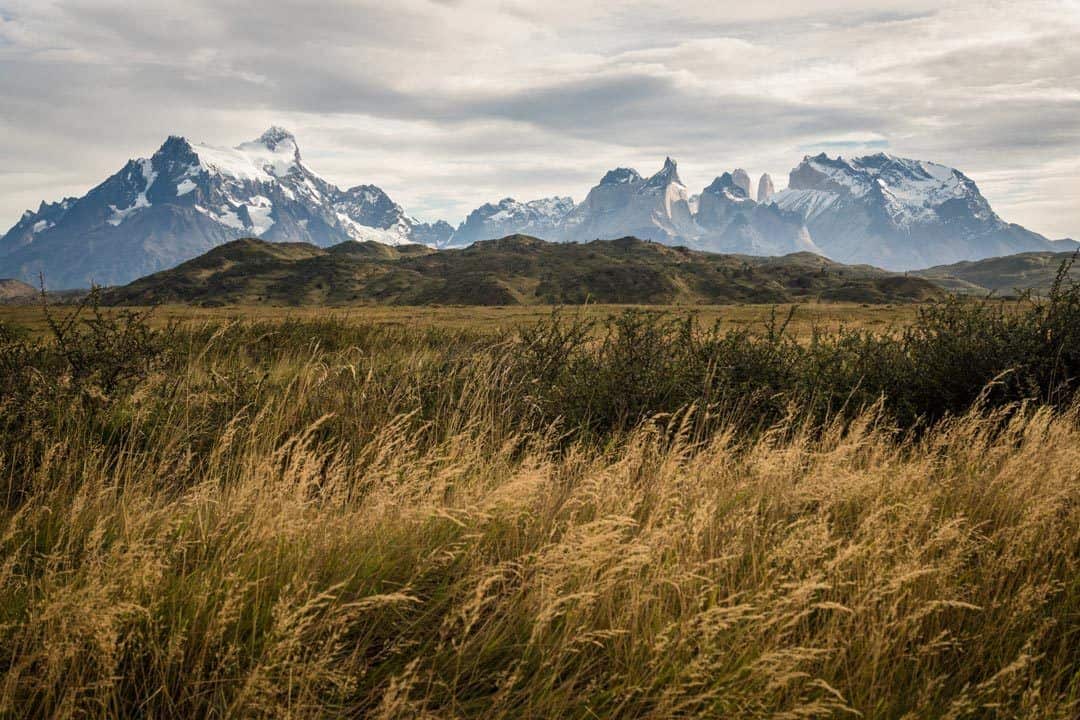
The Ultimate Trekking in Patagonia Packing List
Patagonia is certainly one of the most extreme, potentially harsh climates on earth, therefore it’s necessary to be prepared for all conditions months before you venture to the South American continent.
Hiking gear in Patagonia is quite expensive therefore it’s better to have your gear sorted before you travel to your destination. This packing list for hiking in Patagonia should give you a good idea on what to bring.
- Good quality, lightweight tent. Check out our guide to the best backpacking tents to find one that suits your style and budget.
- Thermal layering including top and pants
- Hiking pants, both long and short, or get convertible pants. These should be waterproof, otherwise get a pair of slip-over waterproof pants as well
- Gore-Tex (waterproof) hiking boots
- Quality backpack for hiking
- Down jacket – these puffy jackets are essential for keeping your torso warm
- Rain and wind jacket – make sure you get a quality jacket that doesn’t leak
- Sleeping bag and silk liner – The warmer the sleeping bag the better
- Cold weather gloves – you will need waterproof gloves aswell as a pair of inner gloves to keep your fingers warm
- Plenty of socks (dry socks are the best)
- A beanie – keeping your head warm is essential
- Hiking poles – if you’re carrying a heavy bag, hiking poles will help you balance. They also provide support for your knees.
- Ability to carry sufficient water (5 litres is ideal)
- Food to last the entire hike. You can pre-order food in some of the refugios in Torres del Paine, but that’s about it. Better to be over-prepared and over-fed then the other way around when hiking.
[box] Have you ever been hiking in Patagonia? Leave a comment below and tell us what your favourite trek was![/box]
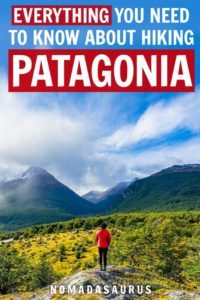
Calumn Hockey
Hi, We’re Alesha and Jarryd!

We’ve been traveling the world together since 2008, searching for the planet’s best destinations and adventures.
Love Travel?
Sign up for our free weekly newsletter for the best travel tips, ideas and deals!
We respect your privacy. Unsubscribe at any time.
READ MORE...
Getting Around Magnetic Island – ‘How to’ Transportation Guide
The Ultimate GUIDE to the Best MAGNETIC ISLAND BEACHES and Bays
14 Best Day Trips From Reykjavik, Iceland (2024 Guide)
Related Posts
25 awesome things to do in banff, canada, how to become an airbnb host (tips and advice for 2024), the ultimate guide to the lakes loop hike, tajikistan, the magic of the galapagos islands in pictures, 18 thoughts on “hiking in patagonia – the ultimate guide to the best treks”.
Happy to read your post. I found your blog is very useful and informative. Thank you for sharing with us.
Actually, I am planning to hike in Patagonia in December. I hope I will have good weather. I loved your article; fascinating and helpful.
Patagonia is such a special place. Hope you get good weather. Even if you don’t it is still so beautiful in the rain or snow. Happy travels
Why you keep lying that Patagonia is chilean? Patagonia is ONLY on the Argentinian side (EAST of Los Andes.
Mt. Fitz has been high on our list since we saw Tommy Caldwell and Alex Honnold do the traverse there. I don’t think we’re up to the standards of the traverse but we’d definitely like to do some hiking around there, looks epic!
Great article guys, thanks!
Glad you enjoyed the article. Hope you get to climb Mt Fitz one day. 🙂
Great work guys, will definitely follow you in instagram, could you recommend some good travel companies who can help me with these hiking circuits, will be a solo traveller.
Hi Basu, thank you so much. We did our hikes through Eco Camp and they were brilliant. They have nice accommodation. We did not go with any other agent. 🙂
Thanks for this comprehensive list of treks near El Chalten. Could you tell me how is the biking scene in the town? I am a cyclist and love to ride in new places I visit. I was planning to take my bike on my trip to El Chalten, but not sure if it will be a good idea.
Glad this article could help. We didn’t go biking ourselves in El Chalten so we can not say about the treks. We are sure there is some in the area. If you contact one of the adventure tour companies they may be able to help. All the best and have a great time.
Fantastic blog! For the short hikes ie. <5 hours, are the trails easy to follow or well marked or do we need to know how to navigate? Thank you!
Thank you so much. Yes the paths are easy to follow and there are signage. You do have to have your own wheels to get to some of the hikes as the tourist shuttle doesn’t go near the beginning of them. Have a great time
This was great! Thanks! I know the answer to this, but I’m going to ask it anyways. Since there are camping spots along the way, are there toilets? Should we buy biodegradable TP for the day hikes?
Hi Sam, there are toilets at the campgrounds. Surprisingly all of them are flush toilets. Toilet paper is provided but always bring your own as the toilets run out. When you are hiking and need to use the bush toilet. Please bury your business and pick up your toilet paper. Thanks
Great Post, looking forward to exploring Patagonia.
Thank you so much
Love your blog 🙂 I wish I had more money to travel, cos nothing is better then collecting memories while traveling.
Thank you so much Miljan. Collecting memories is beautiful
Leave a comment Cancel reply
Save my name, email, and website in this browser for the next time I comment.
Table of contents
A Guide to Backpacking & Hiking in Patagonia

Some of the links on this page are affiliate links
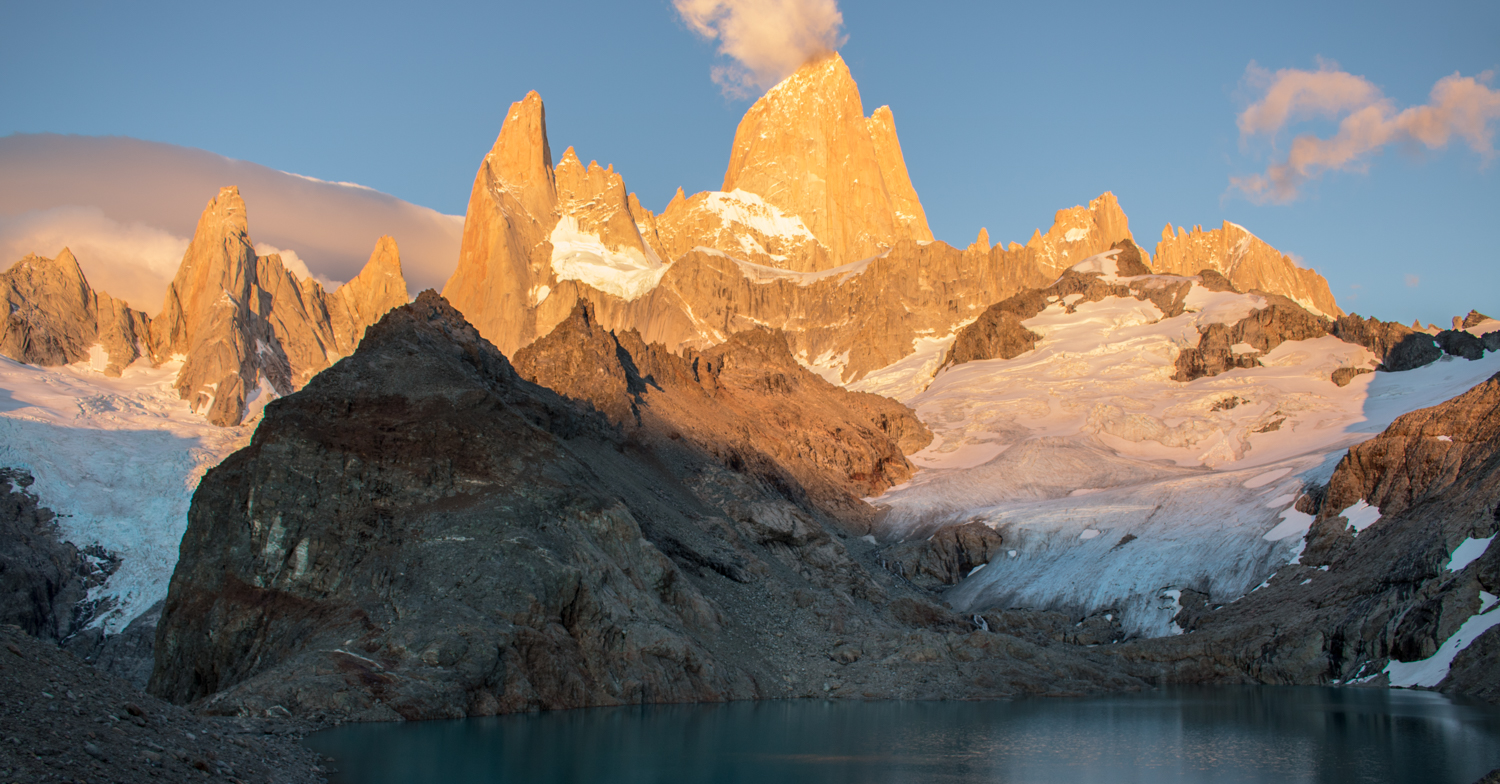
Patagonia is one of the most pristine and wild regions on our planet. Just the word itself evokes images of windswept landscapes with jagged granite spires twisting to the sky, immense glaciers and some of the largest ice fields on Earth. Spanning the southern regions of Chile and Argentina, hiking in Patagonia offers a diverse mix of landscape, flora and fauna, including guanacos, condors, red-headed woodpeckers, and if you’re lucky – maybe even a puma, huemul, or pygmy owl.
For all its beauty and grandeur, hiking in Patagonia can be a very accessible activity. Trekking tourism has been rapidly increasing in Patagonia over the past five years, so you should expect to be sharing the trails. Though many people hike with organized tour groups, hiking independently is very possible in most places. Even those with little backpacking experience will find trekking in Patagonia to be an accessible and absolutely unforgettable adventure.
For more information on what gear you’ll need, we recommend checking out the following resources:
- Backpacking in Patagonia Gear Checklist
- A Guide to Hiking in Torres del Paine: W, O, and Q Treks
- Best Backpacking Gear – CleverHiker Gear Guide
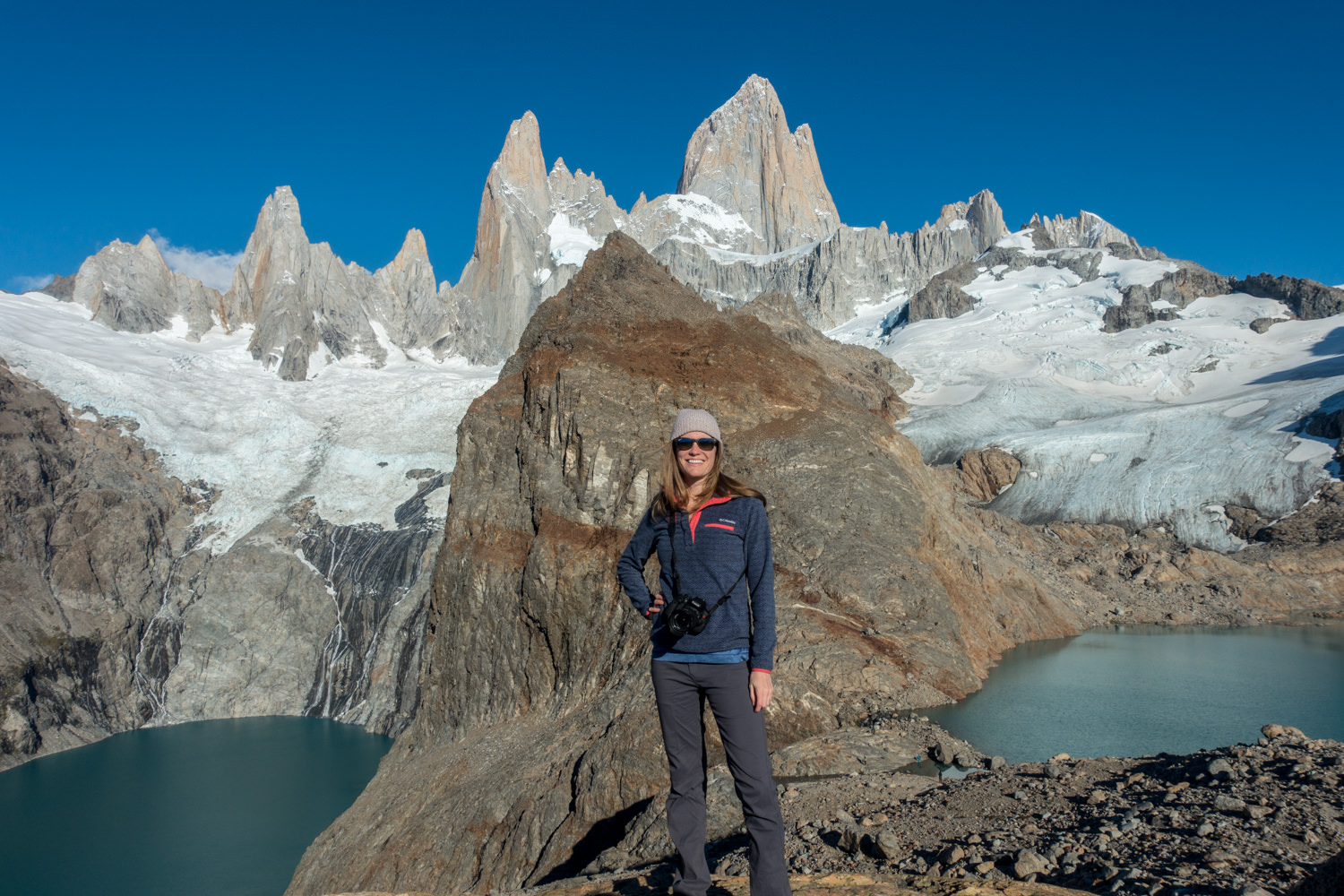
WHEN TO VISIT
SUMMER (December-February) : The peak hiking season in Patagonia is during the summer months of December through February when the temperatures are the warmest and days are the longest. Though hiking in 60-70 degree temperatures is quite nice, the crowds will be high and the wind can be fierce during this time of year, with gusts up to 75 mph at times. It’s common to receive some precipitation during the summer months, though with less intensity than in the fall.
FALL (March-April) : Hiking in the fall months can be a nice alternative to summer. The temperatures will be slightly cooler, but the crowds will be lighter and the wind is often less intense during this time.However, precipitation can be highest during the months of April and May, so you’ll want to plan accordingly. Many people also choose to come during fall months to watch the trees turn from green to a fiery red, which is a breathtaking contrast against granite and glaciers.
SPRING (September-November) : Hiking in the spring months is a great way to enjoy Patagonia before the swathes of tourists arrive. Temperatures will be cool with daytime highs averaging in the 50’s, so you’ll need to bring warmer clothing. You can also expect less wind and less precipitation during spring months compared to summer.
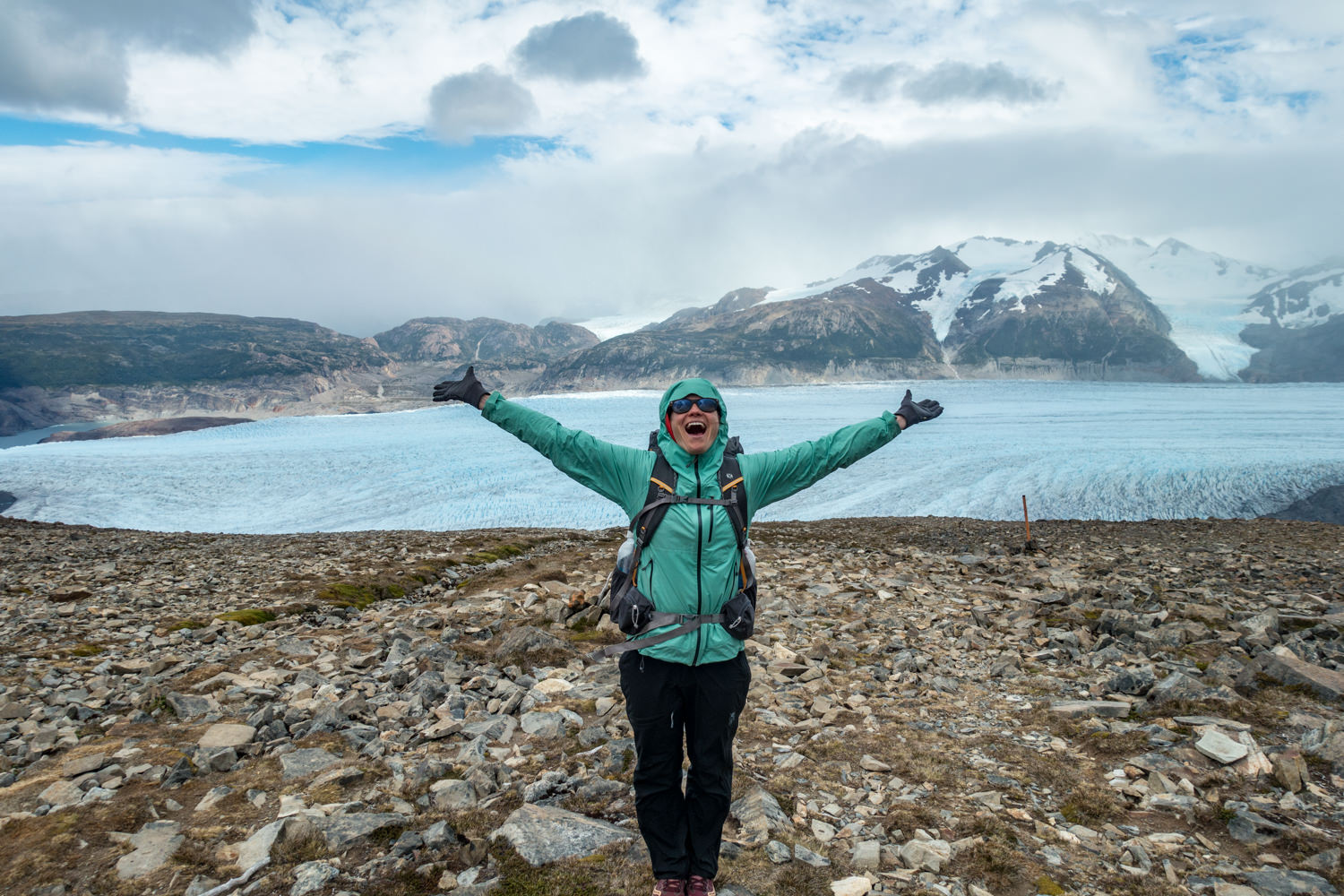
Weather (and wind!)
The weather in Patagonia is ever-changing and unpredictable. You’ll often hear people talk about how you can experience all four seasons in one day, any day of the year. Check out our Patagonia Packing List to make sure you’re prepared for the wide range of weather condition you’ll encounter.
During your trip, you’ll most likely experience some rain, but what will stick with you is the wind. It’ll be like nothing you’ve experienced before. The strongest winds occur during the summer months of December to February, with gusts up to 75 mph possible. The air is calmer in spring and fall and almost non-existent in winter. Always be careful on exposed ledges, suspension bridges, or on pass days if winds are high.
The best source for finding information on weather is at www.windguru.com , which will provide information on wind speed and gusts, precipitation, and cloud cover. If you stop by a ranger station in the area you’ll be hiking, they’ll most likely have the Wind Guru forecast printed and can help you decipher the somewhat confusing grid of numbers.
GETTING THERE
Most people traveling to Patagonia will first arrive at either the Comodoro Arturo Merino Benítez International Airport in Santiago, Chile or the Ministro Pistarini International Airport in Buenos Aires, Argentina. From here, most people take a domestic flight to the Patagonia region. If you fly into Santiago, it’s most economical to take a domestic flight to Punta Arenas, Chile to begin. If you are coming from Buenos Aires, it generally makes the most sense to fly to El Calafate, Argentina. The reason for this is because it can be very expensive and time consuming to fly between countries (ie. from Santiago to El Calafate). For example, to fly from Santiago to El Calafate on our last trip would have taken 16 hours due to a long layover in Buenos Aires en route to El Calafate. It was also a very costly option. So plan your international and domestic flights accordingly.
Once you’re in the Southern region, it is easy, affordable, and convenient to bus between the main trekking areas in Patagonia. More on that below.
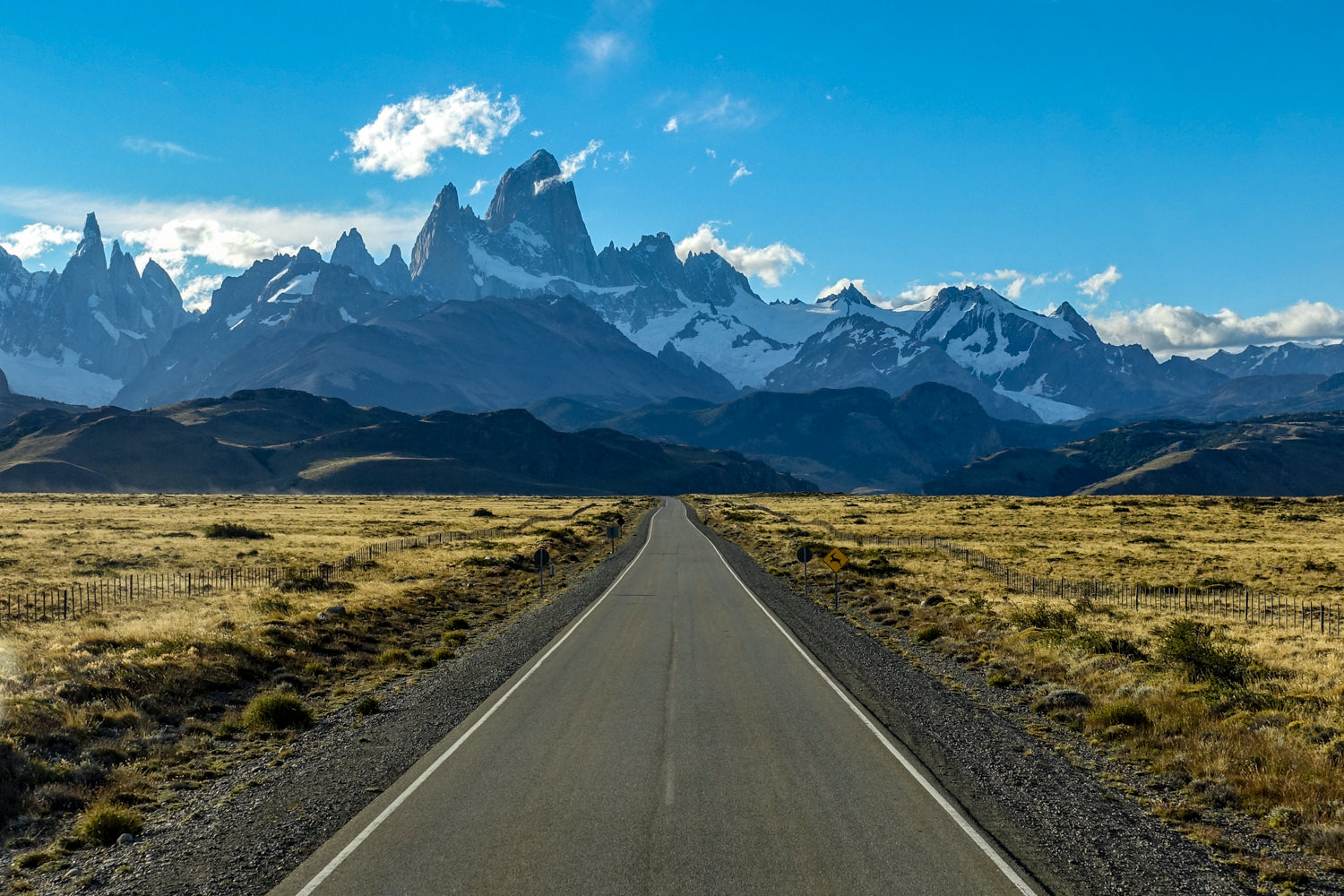
GETTING AROUND – bus transportation
Although there are some long distance buses running routes connecting the northern and central regions of Patagonia to the south, for this section we’ll focus primarily on getting around the Torres del Paine and Los Glaciares regions, as this is the most common route people will use during their visit.
There are many bus companies running routes between the towns of El Chalten, El Calafate, Puerto Natales, and Punta Arenas. Most of the buses are reliable, comfortable, and punctual. We recommend buying your bus tickets ahead of time, especially during peak season. Purchasing your bus tickets online is easy and convenient with BusBud and Recorrido.cl . You can save a couple bucks by purchasing your tickets in country, but for the piece of mind and ease of planning, we found this convenience to be well worth the money.
Below is an idea of general bus times between towns. We found the buses to be very punctual and their estimated times to be accurate, with the exception of the bus from Puerto Natales to El Calafate, which involves an inherently unpredictable border crossing.
- Punta Arenas -> Puerto Natales: 3 – 3.5 hours
- Puerto Natales -> El Calafate: 5 – 5.5 hours (with border crossing)
- Puerto Natales -> Torres del Paine -> 1.5 – 2 hours
- El Calafate -> El Chalten: 3 hours
Our one complaint regarding the bus travel was that it is very difficult, perhaps even impossible, to make the bus trip from Punta Arenas to El Calafate in one day due to the schedule. Almost all people have to break the trip into two days with day one from Punta Arenas to Puerto Natales and the next day traveling from Puerto Natales to El Calafate. It’s possible to catch a bus from El Calafate to El Chalten that same day.
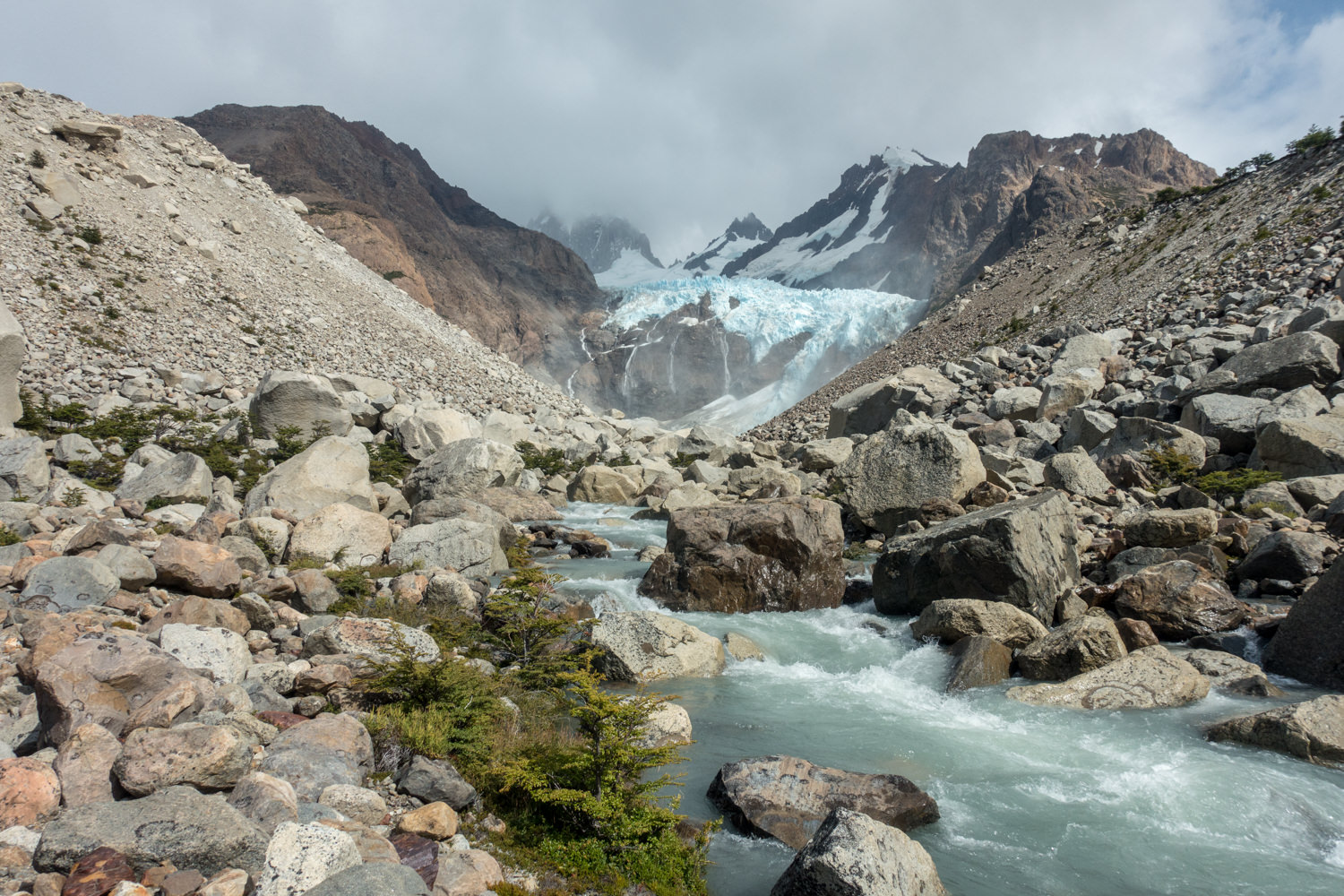
VISA & customs
According to the US State Department, U.S. citizens do not need a visa for visits of up to 90 days for tourism or business in both Chile and Argentina . We recommend checking with the State Department of each country prior to your trip to ensure requirements haven’t changed.
Upon arrival, you’ll receive a visa at no cost. You’re able to move freely between the countries with very little hassle. You’ll want to make sure you hold onto the immigration form you’ll receive from Chile upon entrance, as you will need to present this to many hotels as well as customs prior to leaving the country.
Regarding customs, Chile is very particular and strict about the food you bring into the country. If you’re bringing any plant or animal products you must declare them on the immigration form. There are heavy fines associated with bringing in items that you failed to declare, so to be on the safe side, we recommend declaring any food items. For example, we brought some freeze-dried backpacking meals and energy bars from the United States which contained meat product, so we declared them. We had no issues.
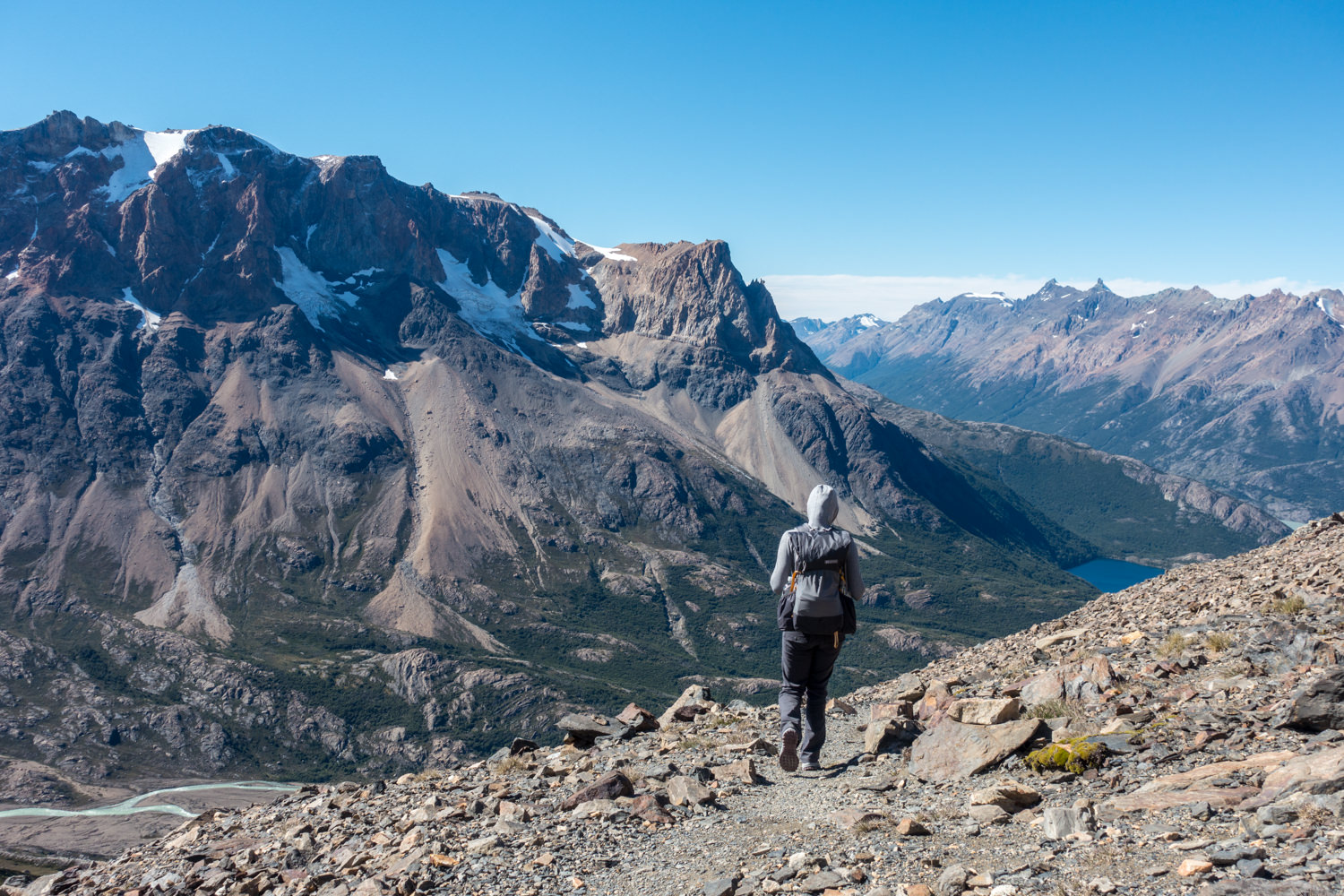
To put it simply, Patagonia is not a cheap place to visit. Compared to other South American destinations, you can expect to pay more for lodging, food, and pretty much everything. If you’re on a tight budget, there are generally free or very cheap places to pitch a tent around many of the towns. Also, buying your food at grocery stores rather than restaurants or refugios can make for a more affordable trip.
The type of lodging you choose along your hiking route will dictate costs significantly. Generally speaking, there are three levels of accommodation in Torres del Paine: refugios, supported camping (you prearrange renting equipment at each site), and camping (you bring your own gear). In the Fitz Roy area, camping is free. If you choose to hike with a guided group in either region, you should expect to pay significantly more than if you decide to hike independently. More on this later.
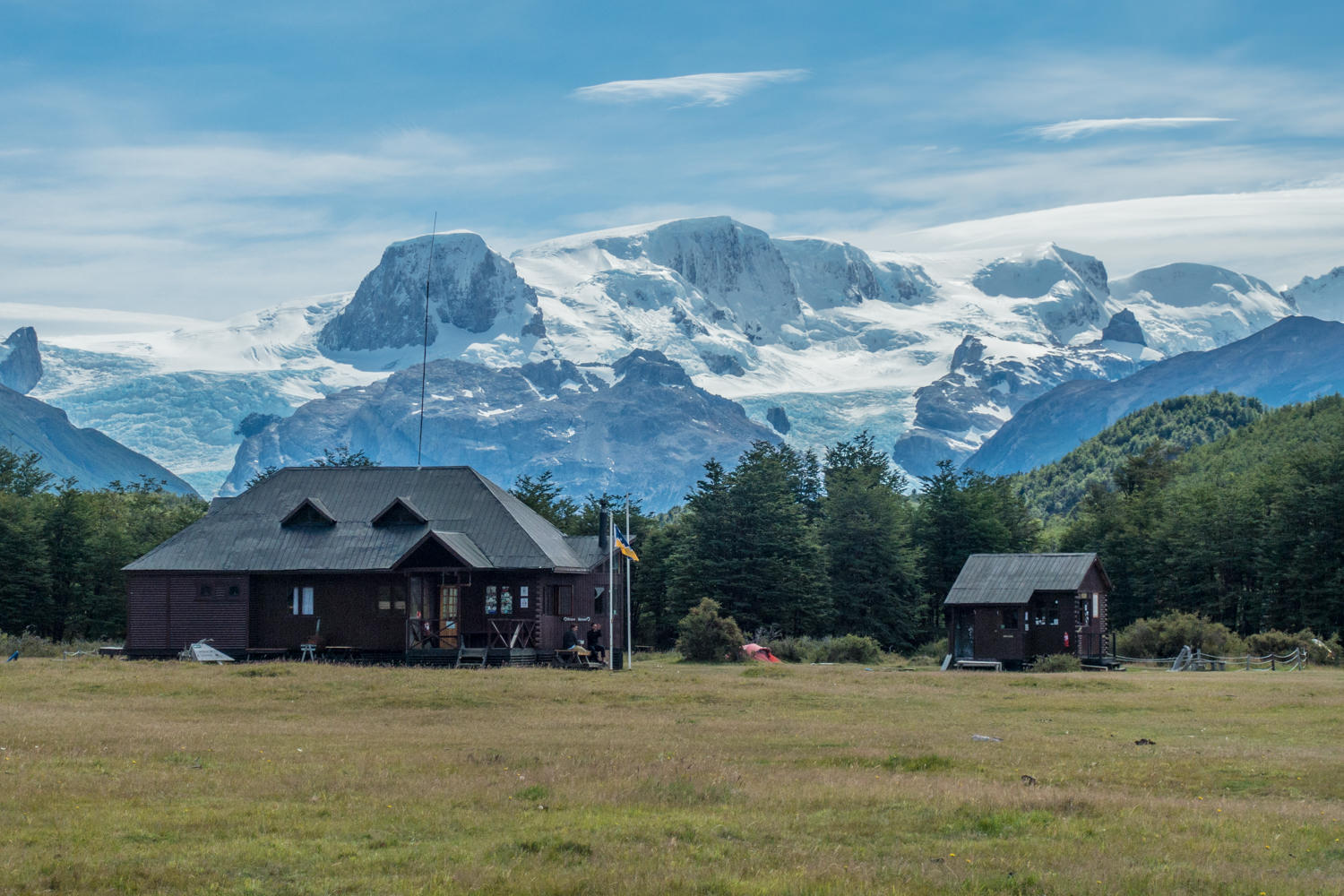
refugios or camping?
Many of the hiking areas in Patagonia have a system of mountain huts called refugiosalong popular backpacking routes. For many, the existence of refugios are what makes hiking so accessible in Patagonia. They almost always provide meals, drinks, and snacks for purchase so the only thing many hikers need to carry is a daypack with their essentials.
Refugios can range from small charming huts with 6 rooms to large hotels serving hundreds. Regardless of size, almost all refugio sleeping options offer dorm-style bunk bed accommodation. Almost every refugio offers meals and has a small store, though prices are quite expensive. You’ll have the option of adding full-board to your refugio stay which includes a breakfast, a packed lunch for the next day, and dinner. Most refugios also have showers, shared bathrooms, and areas to chill. We recommend packing your own sleeping bag , as some refugios only offer a bottom sheet on the bed.
For a more economical and adventurous option, you can camp at all the sites with a reservation, where necessary. The campsites are generally located right outside or very near the refugios. Although you’re not paying to spend the night, you’re almost always able to use the facilities in a refugio, buy a meal or a beer, take a shower, and use the outlets to charge your devices (though it’s customary for refugio guests to get first dibs). Having a glass of wine in the refugio before crawling into your tent is a rare and wonderful wilderness luxury!
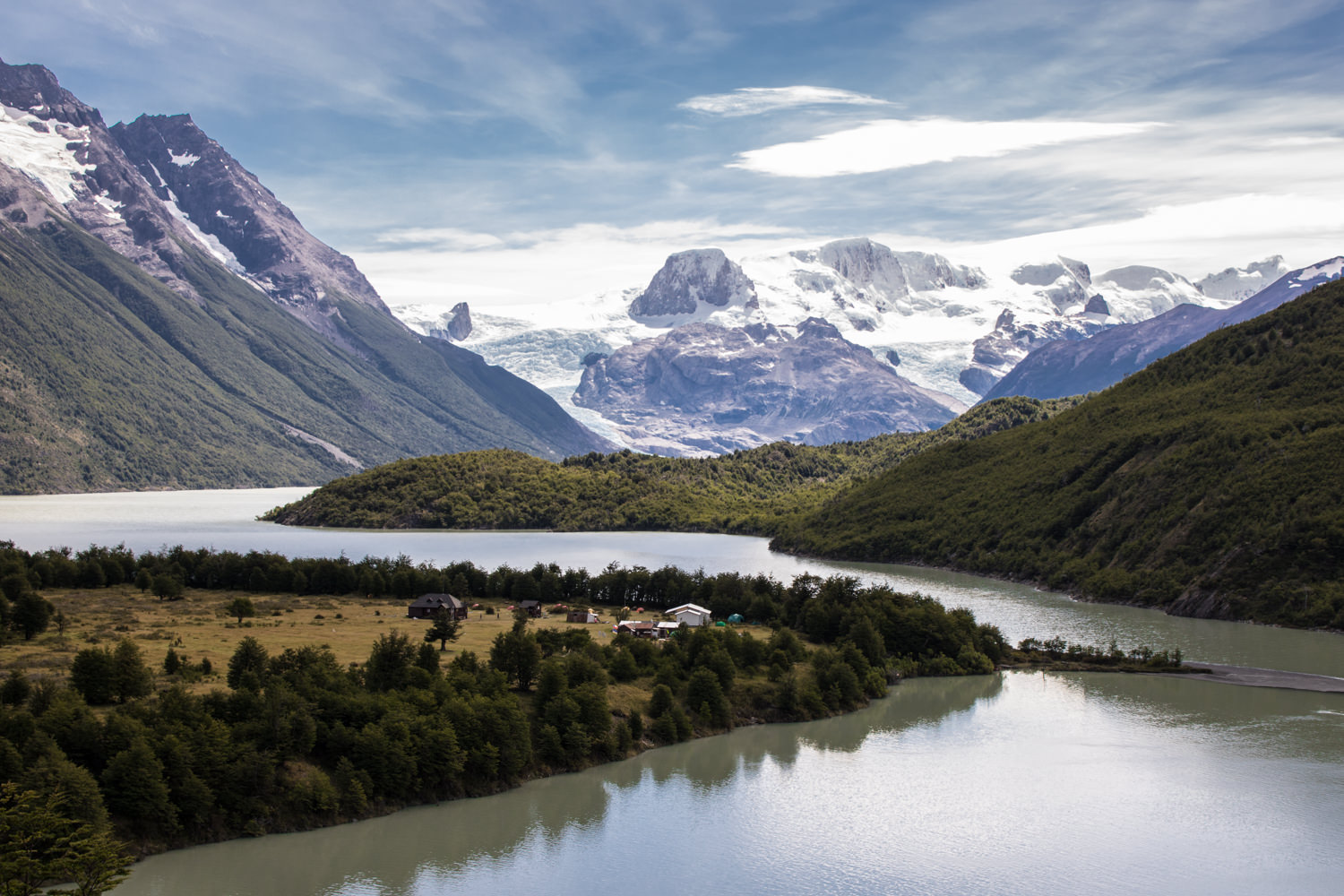
UNDERSTANDING THE REGIONS
Patagonia is a vast, massive region spanning thousands of miles. For ease of planning, we’ll break down each region and discuss highlights of each area. Most people who visit Patagonia for the first time will visit the Torres del Paine region of Chile and the Fitz Roy region of Argentina. Though these places absolutely deserve to be on anyone’s itinerary to Patagonia, there are also more off-the-beaten-track options that offer just as much beauty with significantly more solitude.
TORRES DEL PAINE – If it’s your first time visiting Patagonia, a trip to Torres del Paine should definitely be on your itinerary. Located on the Chilean side of the Andes and a two-hour bus ride from the gateway town of Puerto Natales, most people spend multiple days hiking through this region on either the W, O, or Q trek. It’s one of the busiest hiking regions in all of Patagonia, so don’t expect too much solitude. If you’re hiking independently, you’ll need to begin planning and booking your campsites months in advance, as competition is high and coordinating with the three reservation systems ( Fantástico Sur , Vertice , and CONAF ) can be a test of patience. If you have the time and ability, we highly recommend completing the full circuit or O Trek in Torres del Paine.
LOS GLACIARES NATIONAL PARK – Argentina’s most famous National Park, Los Glaciares, is home to the famous Fitz Roy massif as well as the Perito Moreno Glacier. Often referred to as the adventure capital of Argentina, the charming and quaint town of El Chalten is the jumping off point for hikes around Fitz Roy, with trails literally leaving from town. There are many great day hiking opportunities, but we recommend immersing yourself in this region with a multi-day backpacking trip. Located three hours south of El Chalten, the larger and more commercialized town of El Calafate is the jumping off point for a visit to the world-famous Perito Moreno Glacier.

CHILEAN LAKES DISTRICT -Compared to the glaciated regions down south, the Lakes District in Chile offers a landscape dotted with lakes, rivers, volcanoes, and a temperate rainforest. Though not as epic as the Patagonian regions down south, there are many hikes in the Huerquehue National Park and Villarrica National Park. This region is also the official starting point for the famous Carretera Austral, the rugged and picturesque “highway” that stretches 1,240 kilometers down to Southern Chile.
NORTHERN ARGENTINE PATAGONIA – This beautiful region has numerous glacial lakes, stunning mountain vistas, and wonderful white water rafting opportunities.Most travelers accessing this region do so through Bariloche, which is often referred to as the Argentine Switzerland. Home to two National Parks – Parque Nacional Lanín and Parque Nacional Nahuel Huapi, there are numerous hiking and backpacking opportunities including some awesome refugio trips where you can string together hikes to isolated huts in the mountains. There are also some great multi-day backpacking trips through Parque Nacional Nahuel Huapi.
AYSEN – Perhaps the region we’re most excited to explore on our next trip – the Aysen region – is located between the Lakes District of the north and the more popular Torres del Paine region in the south. The Aysen region is vast, remote and has so much to offer on a less-traveled route. You can expect huge glaciers, turquoise lakes, temperate rainforests, and great backpacking and hiking options. This area is far less developed than both the Lakes District and the Southern Patagonia regions so transportation and logistics can be more difficult. The Cerro Castillo Reserve is located in this region and offers a fantastic 4-day backpacking trip. We recommend renting your own wheels to explore. You’ll also see many cyclists and hitchhiking backpackers along the Carretera Austral, the stunning 1240 kilometer highway, which alternates between pavement, gravel, and dirt, and runs through the heart of this Aysen region.
SOUTHERN ARGENTINE PATAGONIA (TIERRA EL FUEGO) – At the southernmost tip of South America sits the large archipelago of Tierra del Fuego. Though you can access this region by bus or ferry, most people opt to fly to the town of Ushuaia. Often considered the “end of the world”, Ushuaia is a resort town most notably used as a jumping off point for cruises to Antarctica. Only 7km outside of Ushuaia is Parque Nacional Tierra del Fuego which has some of the most rugged and extreme landscapes on the continent. The most popular day hike in Tierra del Fuego is the Glaciar Martial, which is a steep but beautiful climb to expansive summit views of the Beagle Channel and Cordillera Darwin. There are also some multi-day backpacking opportunities, such as the Montes Martial Circuit, though they are quite challenging and can be logistically more complicated.
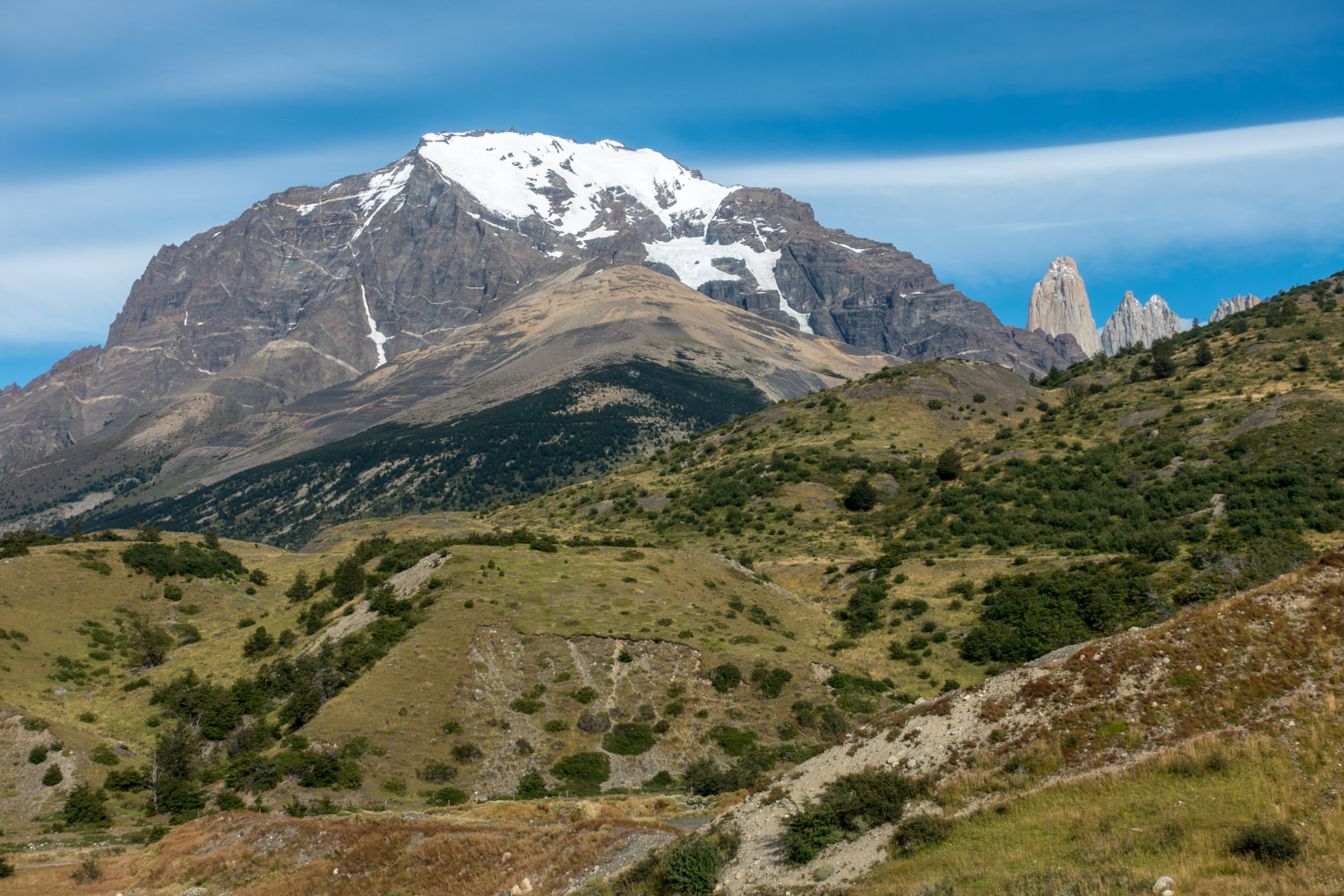
POPULAR HIKES AND BACKPACKING TRIPS
It would be impossible to list all the varied and unique trails in Patagonia. So instead, we wanted to highlight a few of our favorites and some popular recommendations. These trekking routes are all exceptional and a great place to start for your first trip to Patagonia.
W TREK – Located in Parque Nacional Torres del Paine, the W trek is by far the most popular multi-day hike in Patagonia. Covering roughly 80 km (~50 miles) and usually completed in 4-5 days, the W Trek highlights some of the best sights in the region.

O TREK – Also known as the Circuit of Torres del Paine, the O Trek covers the same trail as the W Trek, but also traverses the less visited backside of the park. Over the course of 110 km (68 miles) you’ll connect the two ends of the W. Generally completed in 6-9 days, you’ll spend 2-3 nights camping on the backside, which offers more solitude albeit less dramatic views. However, compared to the W trek where you can stay in refugios every night, camping is required to complete the O Trek.
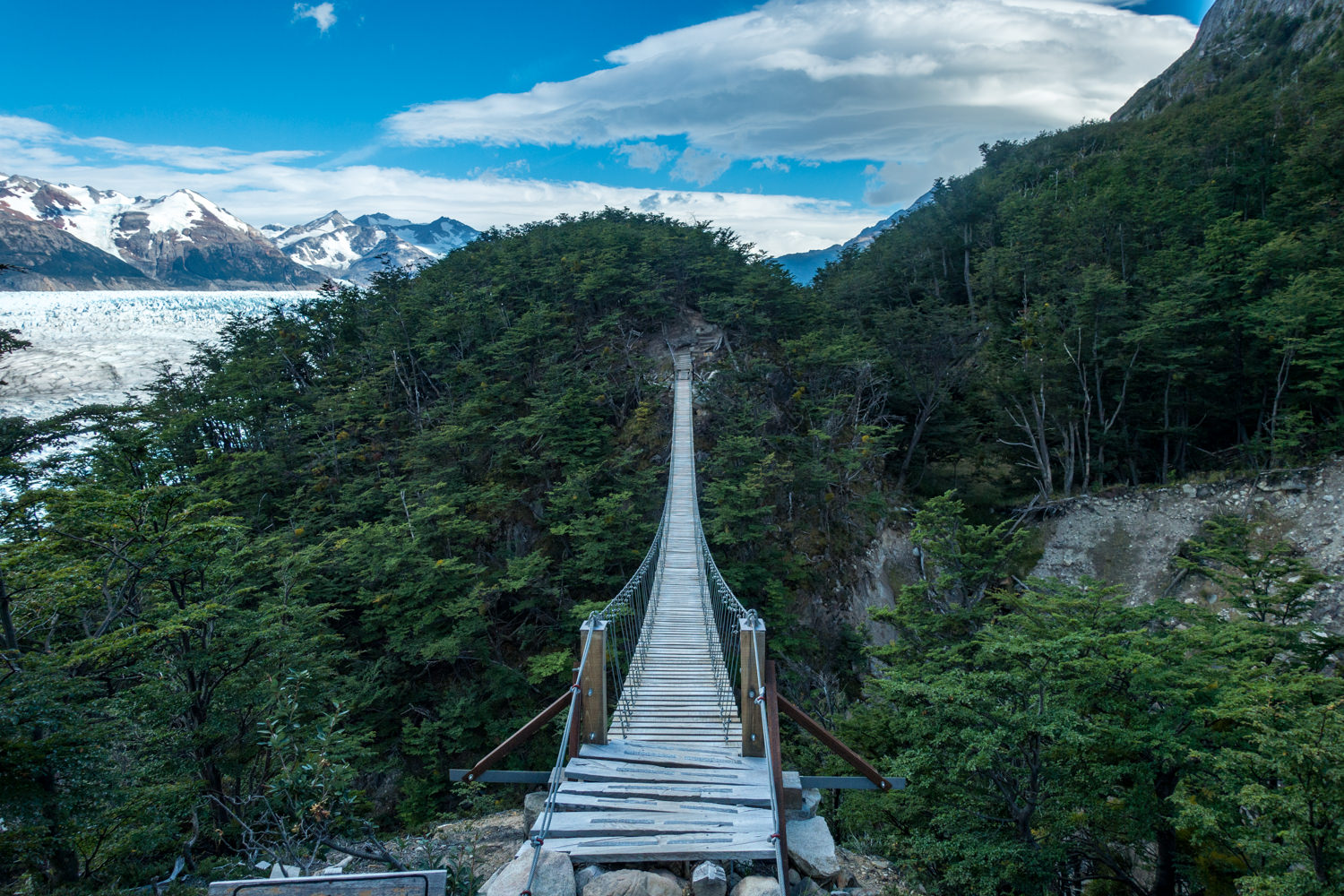
FITZ ROY – Hiking in the Fitz Roy region should be on everybody’s itinerary when visiting Patagonia. El Chalten is the laidback, charming town you’ll use as a base, with trails leaving right from town. The two most popular day hikes are Laguna de Los Tres and Cerro Torre, however there are four free campsites in the park which you can use to string together a backpacking trip.

HUEMUL CIRCUIT – One of Patagonia’s most challenging routes, the 4-day, 70 km (40 mile) loop around Cerro Huemul will give you some of the best views of the Southern Patagonian Ice Field. However, this hike is not for beginners. The trail is unmarked in many places, requiring GPS or map/compass navigation. Furthermore, in order to complete the loop, you’ll have to do a Tyrolean Traverse (basically a self-propelled zip line) and bring or rent your own equipment (harness, carabiner, etc). Depending on the time of year and water flow, you may be able to ford the rivers rather than zipline, but you’ll still be required to have the equipment. In order to complete this loop, you’ll have to register with the park rangers in El Chaten, where they’ll make sure you have the gear you need. You’ll also be required to watch a mandatory safety video before setting off. For more information on the Huemul Circuit, check out The Hiking Guide to the Huemul Circuit.
CERRO CASTILLO – Located in the Aysen region of Patagonia, the Cerro Castillo Reserve offers fantastic backpacking opportunities. You’ll encounter the same immense beauty of glaciers, stunning mountains, and turquoise lakes, but with a fraction of the crowds down south. The 45 km route can be completed in 3-5 days and campsites are free. Logistics can be more complicated, but the payoff will be well worth it.
NAHUEL HUAPI TRAVERSE – Located right outside the town of Bariloche in the Argentina Lakes District, the 40 km (25 mile) traverse can be completed in 3 days. You have the option of sleeping in refugios or camping in free campsites along the route. Though most of the trail is well-marked, the hiking can be tough and you’ll have to navigate some somewhat sketchy scree fields as you cross several passes.

MAPS AND GUIDEBOOKS
When we began planning our trip to Patagonia, we found most of the resources to be grossly outdated, with the existing guidebooks receiving poor reviews. Moon released a new guidebook (see below) in the fall of 2017, which we found helpful, but we used a combination of internet resources, maps, and guidebooks to plan our trip.
- Moon Patagonia – We used this book heavily in the planning phases of our trip. It offers a nice overview of all the regions and towns. Though there is limited detailed information on specific hiking and backpacking routes, we still found it to be a helpful resource.
- Torres del Paine Trekking Map – This waterproof and tear-resistant topographical map includes contour lines, point-to-point time estimates, shelters, camping and clear information on water sources. We used this map everyday on our O Trek.
- El Chalten Trekking Map – Updated in 2018, this topographical map covers all the trails in the hiking area of El Chaltén: the Fitz Roy mountain, Cerro Torre, Huemul Trail, Piedra Del Fraile, Poincenot, De Agostini, trail to Paso Marconi over the Patagonian Southern Ice Field, and others. It also covers Lago del Desierto and significant part of Lago O’Higgins and the glaciers that flow into it on the Chilean side.

Trekking difficulty will depend on a multitude of factors including your experience, physical fitness, pack weight, and weather conditions. There are many different hikes to choose from in Patagonia with varying degrees of difficulty. If you’re hiking in Torres del Paine or around Fitz Roy, the trails are well-maintained and easy to follow. Most of the popular hikes in Patagonia are not technical (no ropes, ice axes, or crampons needed). That said, there will be some long days with big ups and downs, but with most trails are at low elevation, so you won’t have to contend with the altitude issues.
Make sure to choose a trip that fits your fitness level and train adequately before your hike. And as always, keep your pack weight down – you’ll thank us later 🙂
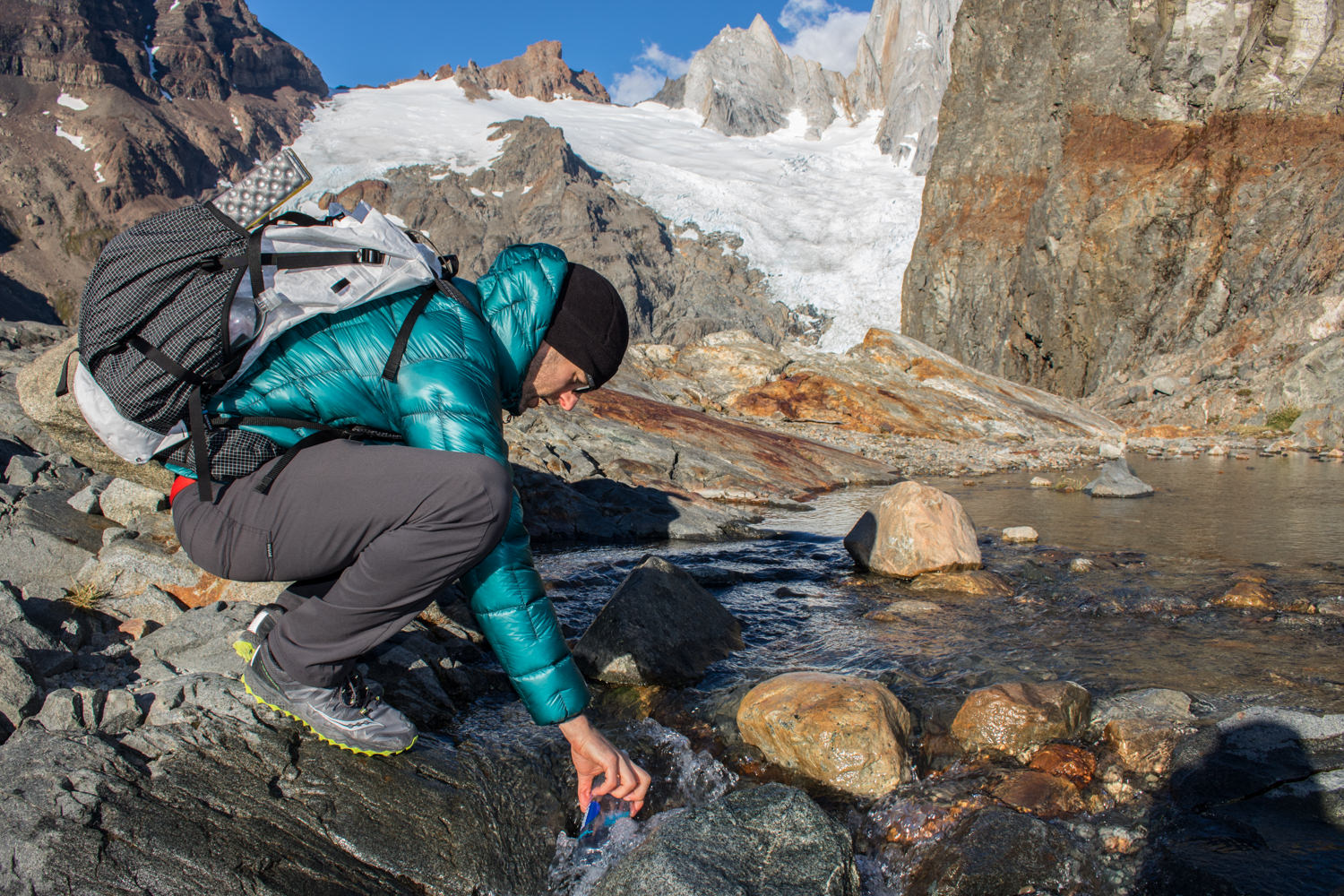
One of the pleasures of hiking in Patagonia is that you can drink water directly from the source on the trail. The National Park Service in Patagonia does a really great job at educating visitors on how to prevent contamination of water sources and keep the water safe for everyone. We still recommend you judge your water source before dipping your bottle. If there is live stock in the area or if the source runs through a trekking trail, you may be better off waiting for the next source. We brought along some chlorine dioxide tablets , but never had to use them.
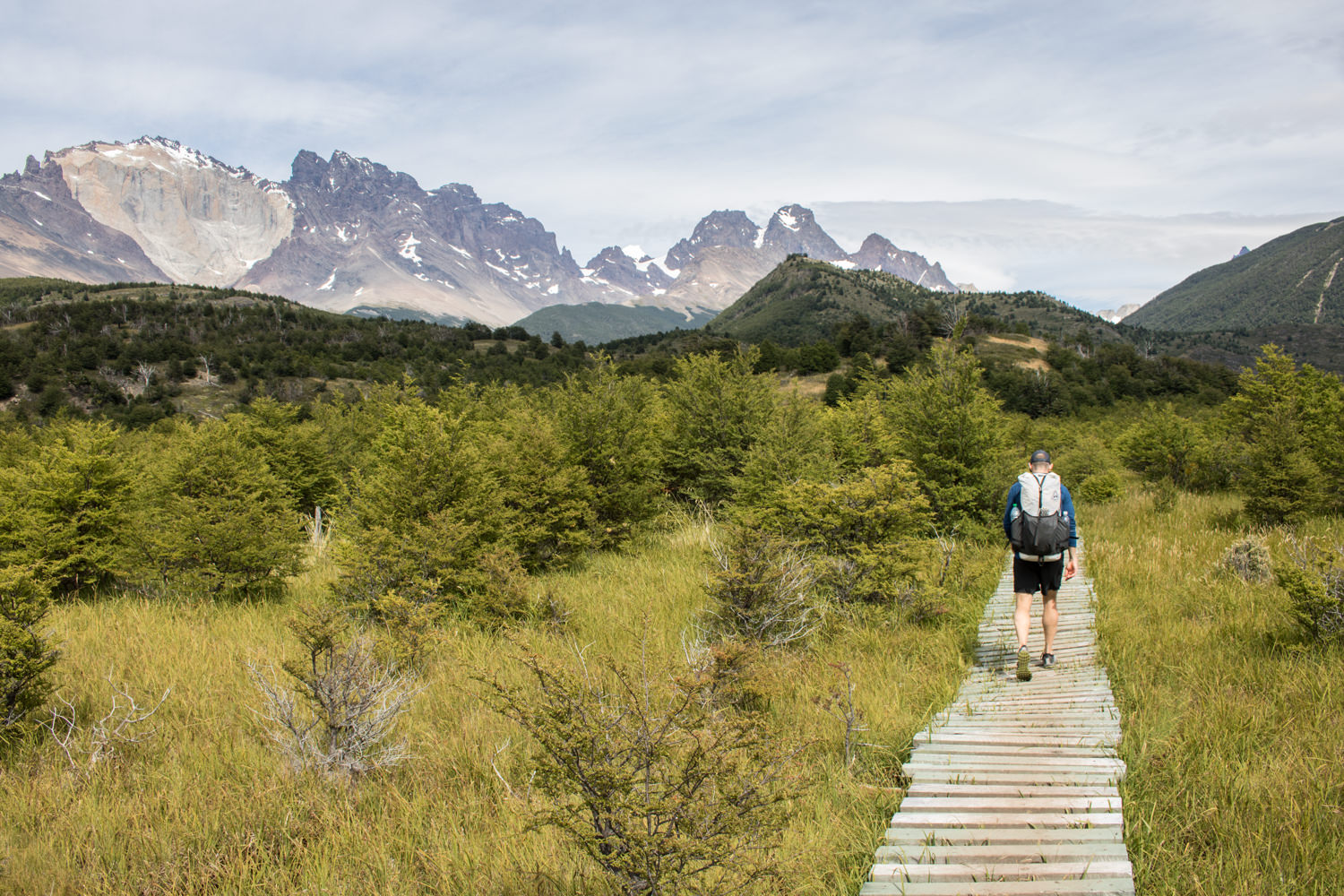
INDEPENDENT OR GUIDED TREKKING
This is an important question for many hikers and the choice will likely come down to experience and personal preference. If you’re an experienced backpacker traveling along a popular route (W or O trek or Fitz Roy hikes), it is absolutely possible to hike independently. The trails are well-marked and maintained. If you plan to hike independently, make sure you have a good map, necessary campsites booked (mandatory in Torres del Paine), and a guidebook before you hit the trail. Also, expect to put in a good amount of planning time to fully prepare for your hike. If you are camping, you will also need to bring all your camping gear with you. There is also an option of renting gear in nearby towns, or if hiking in Torres del Paine, you can also prearrange to rent gear at each campsite.
That said, guides can bring more to the table than just logistics management. Making reservations for camping in Torres del Paine can be confusing and logistically frustrating as you have to organize through three separate reservation systems. When you book with an agency, they take care of all the details (lodging, food, transportation, permits, etc). Furthermore, a good guide can also teach you about the local culture, flora, and fauna. However, be expected to pay a high price for these services.
Though quality of service and lodging options can vary greatly within each travel agency, below are some average costs of guided treks within Torres del Paine with full board (all meals) included. Some agencies include all your transportation and lodging from Punta Arenas.
- W Trek : $1500-$3000 per person
- O Trek: $2000-$4000 per person
GUIDED TREKKING PROS
- All pre-trip details handled (permits, campsites, etc)
- All transportation arranged
- Little worry about any details while hiking (lodging, meals, route, schedule, etc.)
- Local information on culture, food, etc.
INDEPENDENT TREKKING PROS
- Can be much less expensive
- Hike on your own schedule
- No group dynamics to deal with, just you and the trail.
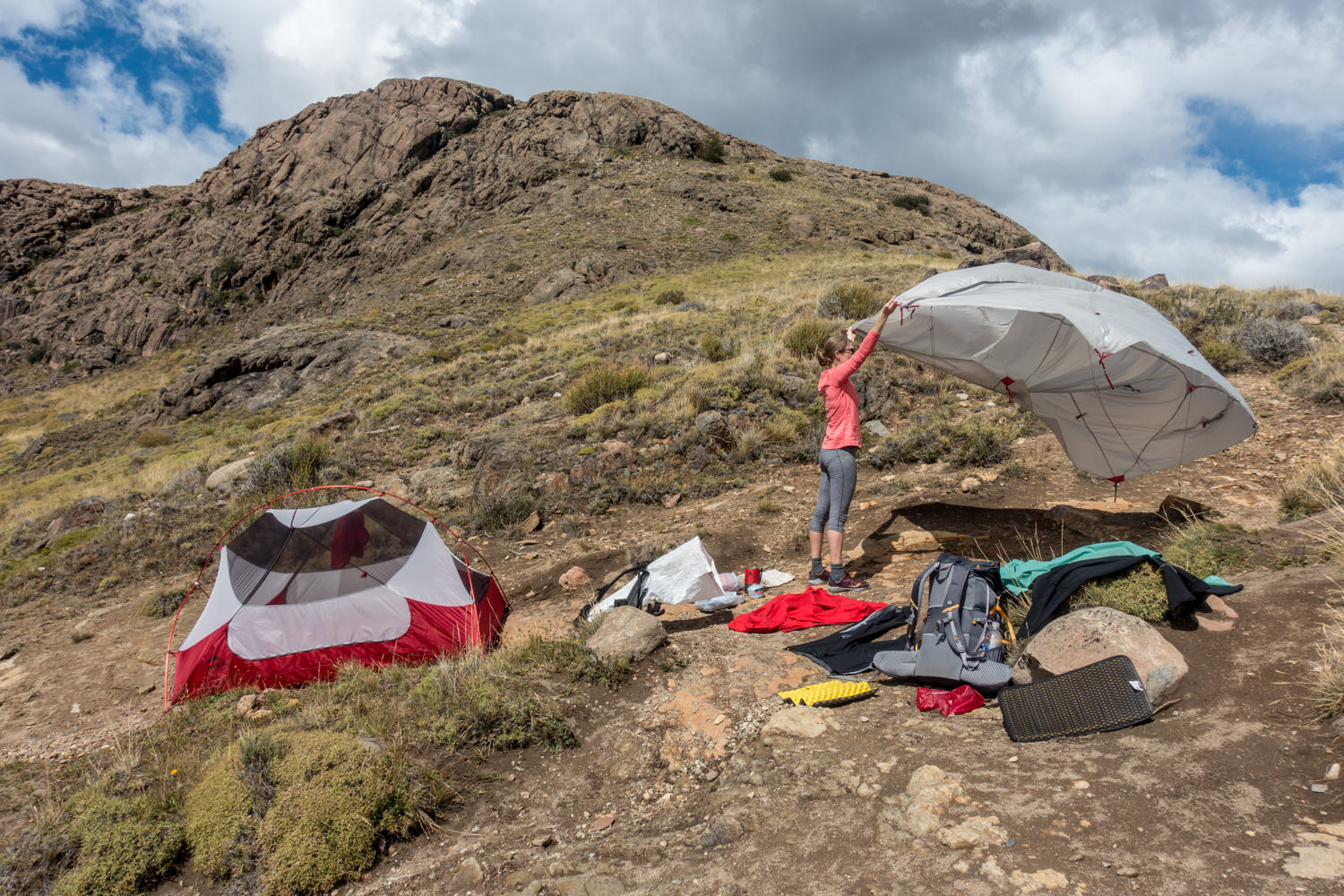
WHAT TO PACK
Whether you’re heading out to do the W Trek in Torres del Paine or chasing sunrises on Fitz Roy, you’ll want to make sure you have the essential gear you need to be safe and comfortable. Below is a quite snapshot of some of the big gear items we brought. For a more full gear list, check out our Patagonia Gear Checklist . For more information on general lightweight backpacking gear, check out our CleverHiker Gear Guide .
- Tent : MSR Hubba Hubba NX
- Backpacks : Hyperlite Mountain Gear Southwest 400 and Gossamer Gear Gorilla 40
- Sleeping Bags/Quilts : Feathered Friends Egret Nano 20 and Katabatic Flex 22 Quilt
- Sleeping Pads: REI Flash Insulated Pad and NEMO Tensor Insulated
- Stove: MSR WindBurner Stove System
Travel Insurance
We highly recommend purchasing travel insurance if you plan to trek in Patagonia. Most trekking locations in Patagonia are remote, so if something goes wrong, you’re likely to need an emergency evacuation and that can get insanely expensive.
We did a bunch of research on travel insurance companies and ended up choosing World Nomads for our travels. Their rates were reasonable, their coverage met our needs, and communicating with them was easy. We fortunately didn’t need to use our travel insurance, but the peace of mind alone was well worth it.

LEAVE NO TRACE
Patagonia is a truly special and uniquely wild place and for this reason thousands of visitors flock to this region every year. Undeniably, the cumulative effect of human interaction is taking a toll on this fragile environment. To minimize the effect of visitors and ensure the natural beauty of Patagonia remains for years to come, we ask that you please abide by strict Leave No Trace Principles while visiting.
CONSIDER GIVING BACK
Patagonia, and more specifically, Torres del Paine is one of the last truly wild and remote spaces. At CleverHiker we encourage people to get out and experience nature at it’s finest and that mission comes with a great responsibility. If you were lucky enough to experience the breathtaking beauty of Torres del Paine, we encourage you to give what you can to continued conservation efforts. We all need to be stewards of the natural world to protect our wilderness for generations to come.
We’ve donated to the Torres del Paine Legacy Fund which works to preserve and restore ecosystems, improve tourist infrastructure by mitigating visitor impacts, promotes community development, and diversifies recreational activities. The best part? 100% of your donation will directly support sustainability actions in Torres del Paine.
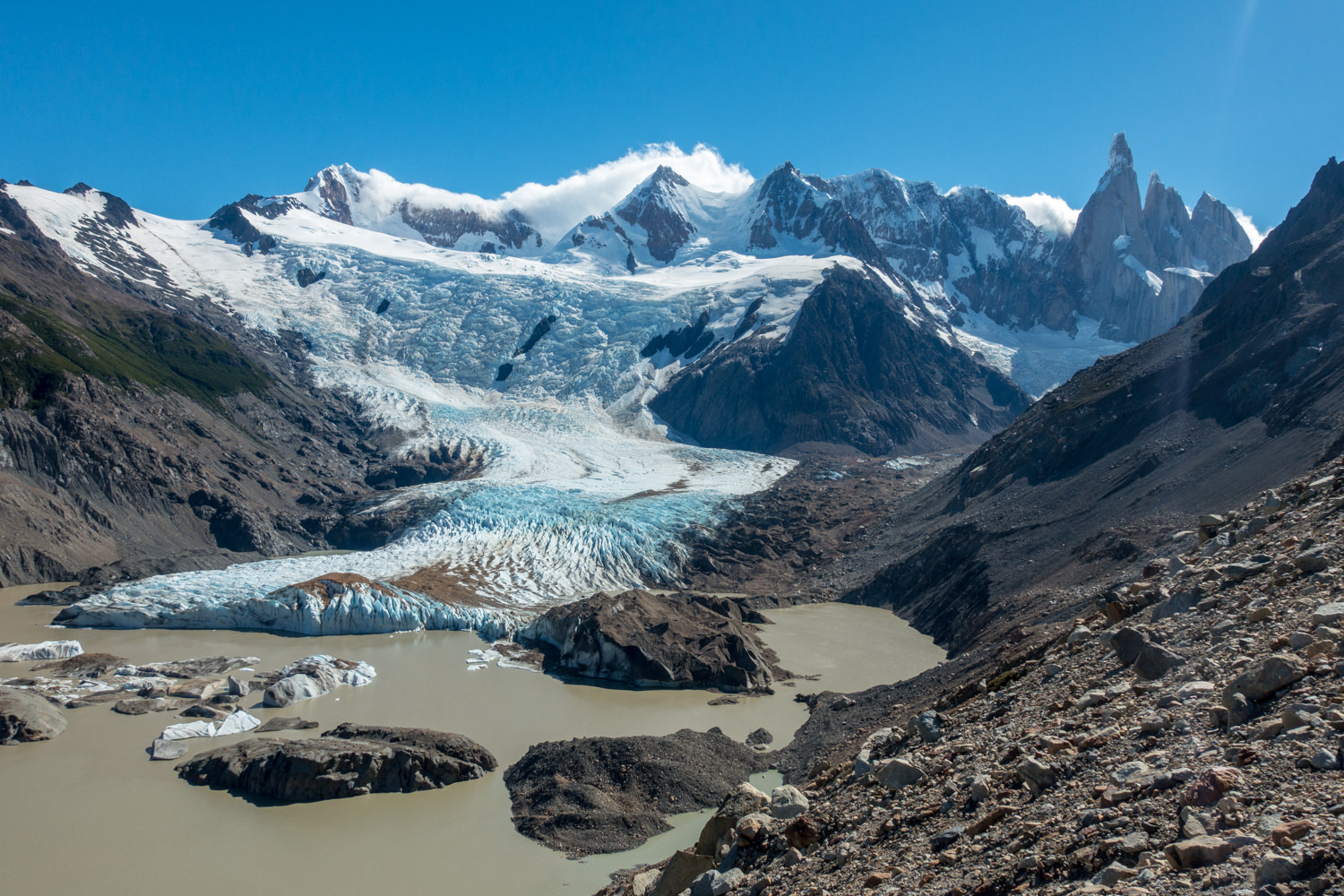
More Resources
Hopefully you found this guide helpful for planning your trip to Patagonia.For more helpful resources check out the links below.
- Patagonia Gear Checklist: What to Pack
- CleverHiker Top Gear Awards
- Essential Trail Skills Video Series
- Lightweight Gear Basics Video Series
patagonia photo gallery
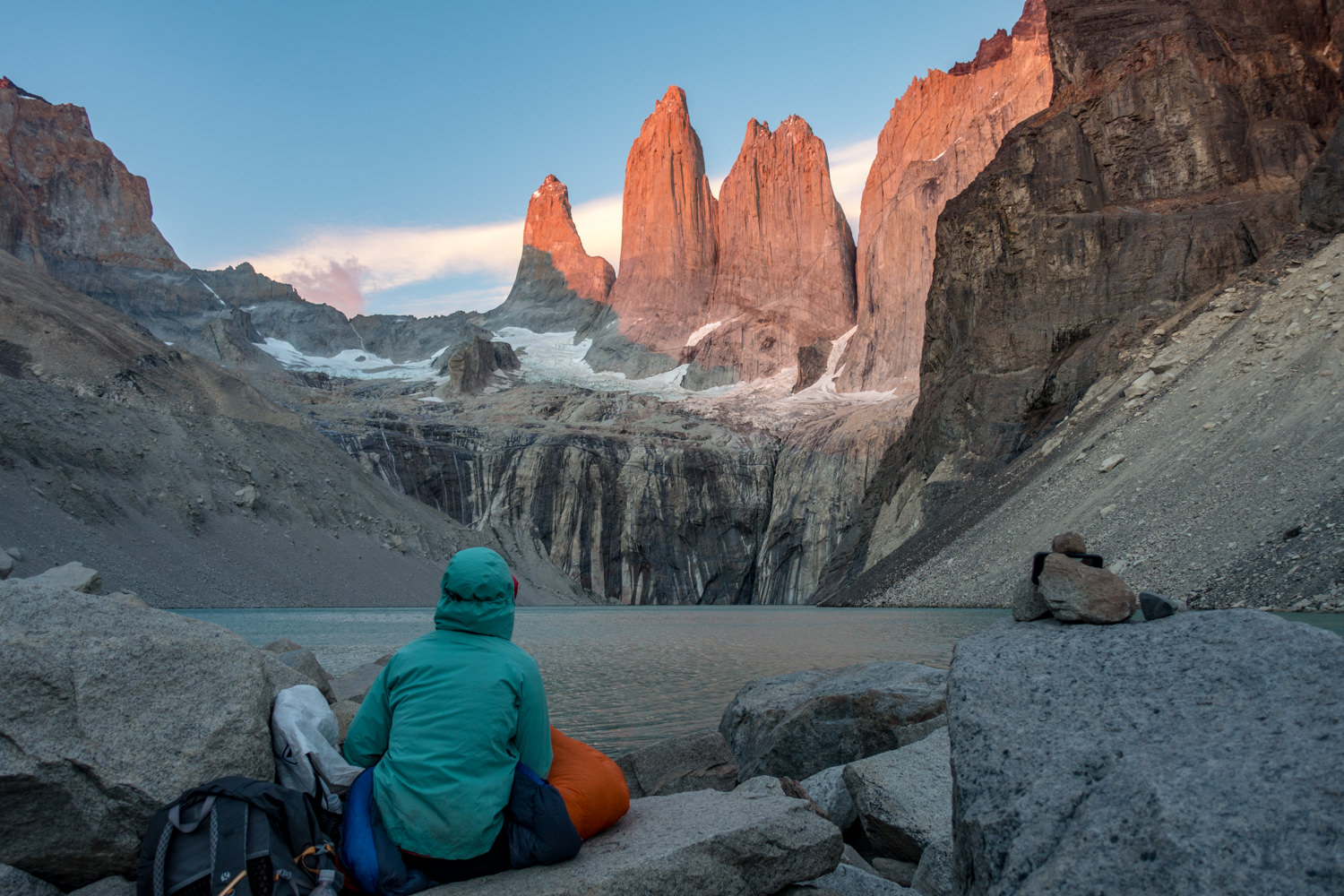
Disclosure: Some of the links on this page are affiliate links, which means we may receive a small commission if purchases are made through those links. This adds no cost to our readers and helps us keep our site up and running. Our reputation is our most important asset, which is why we only provide completely honest and unbiased recommendations.
Related Content
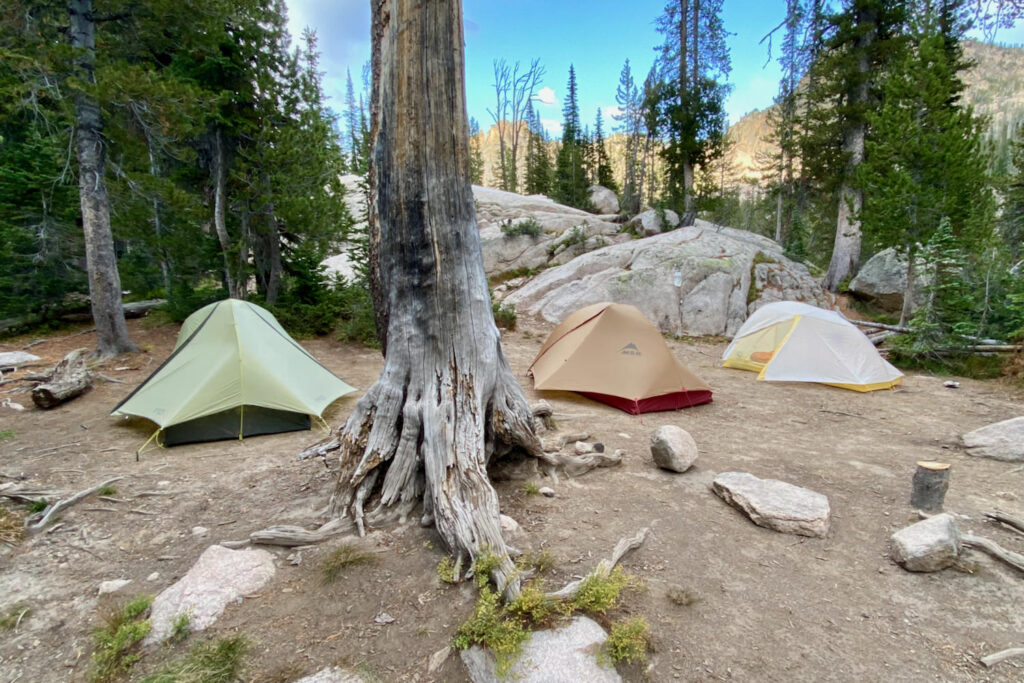
Big Agnes Tiger Wall vs. NEMO Hornet OSMO vs. MSR FreeLite
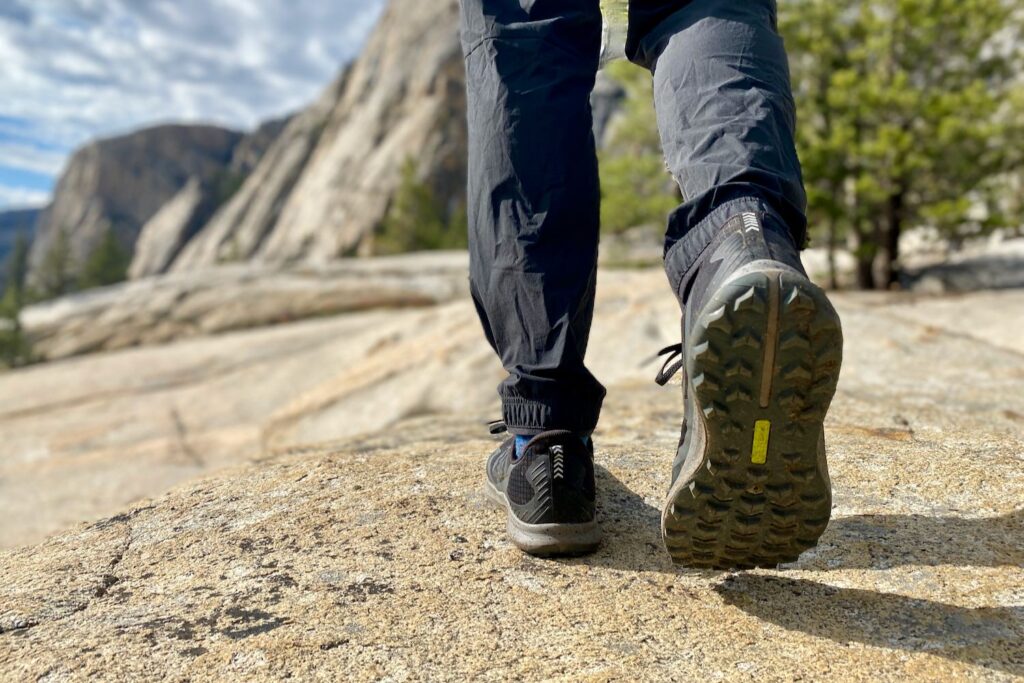
Hiking Boot & Shoe Soles for Grip, Traction & Different Terrains
Get the best content from cleverhiker & around the backpacking world.
Social media is great, but our bi-weekly newsletter is a much better way to stay in the know.
Sign up to get our curated emails with the best content from CleverHiker and around the backpacking world. You’ll be turned on to new videos, trip reports, gear reviews, inspiring outdoor stories and much more. So get in the mix!

Hiking in Patagonia: Your Ultimate Guide to Scenic Trails & Multi-Day Treks
Everything you need to know about hiking in Patagonia, from Torres del Paine to El Chalten: when to visit, best hikes, how to plan and what to pack.
Are you ready to embark on the adventure of a lifetime? Patagonia beckons hikers from around the globe. Situated in the southern regions of Chile and Argentina, this remote corner of our planet boasts awe-inspiring landscapes, challenging trails and unique wildlife. From the iconic Torres del Paine to the hidden gems of Ushuaia, Patagonia has something for everyone.
Whether embarking on a scenic trail or multi-day hike, you can expect a treasure trove of windswept landscapes, jagged granite spires, immense glaciers, and some of the largest ice fields on Earth. In this ultimate guide to hiking in Patagonia, we’ll equip you with all the information you need to plan your dream trek.
This article contains affiliate links from the Amazon Associate and Travelpayouts programs. Wild Travel Tales will earn from qualifying purchases, at no extra cost to you .
The Best Time to Go Hiking in Patagonia
Before we dive into the specific treks, let’s talk about the best time to visit Patagonia. Each season offers a unique experience, and your choice will depend on your budget, tolerance for different weather conditions and other travel plans. In this section, we’ll delve into the weather patterns, seasons, and the ideal months for hiking in Patagonia.
Generally, the period from early November to late April is considered ideal for hiking. If you prefer milder temperatures, aim for February and March. For the full spectrum of Patagonian beauty, visit in late March to mid-April when the region is painted in stunning autumn colours. However, Patagonia’s weather is known for its unpredictability, so be prepared for sudden changes.
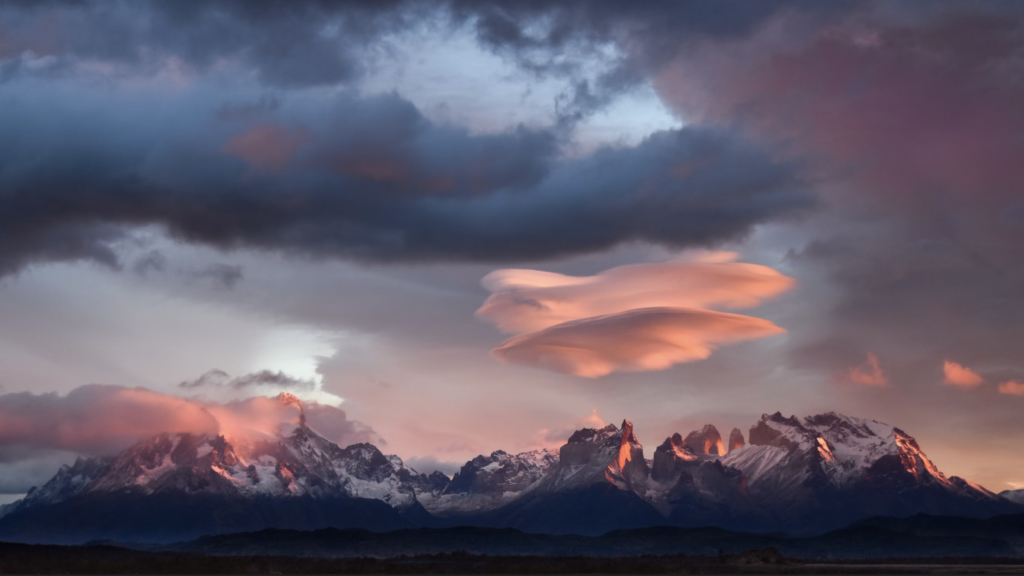
Weather in Patagonia
The weather in Patagonia is famously unpredictable, and understanding its patterns is vital for planning your trek. You can experience all four seasons in a single day, any day of the year. As Patagonia’s weather can change rapidly, you must come prepared with appropriate gear for all conditions.
Proper preparation is key to a successful hike. While the information below acts as a useful guide, local ranger stations will be an invaluable resource for up-to-date weather forecasts and safety advice.
Summer (December-February)
- Summary: December through February marks the peak hiking season in Patagonia. This period is considered the most favorable time for travelers to explore the region due to milder weather and longer daylight hours. Fierce winds are common, sometimes reaching up to 120km/hour.
- Weather: During this time, temperatures are at their warmest and typically range from 15°C to 24°C (60°F to 70°F). The weather is relatively more stable and less extreme.
- Daylight: The days are long, providing ample daylight for exploration. This is especially important for trekkers who need sufficient daylight for their adventures.
- Crowds: Patagonia can get crowded during the peak season, especially in popular national parks and trekking areas. If you prefer a quieter and more secluded experience, you might want to explore less-visited regions or consider visiting during the shoulder season.
- Precipitation: Occasional precipitation, but typically less frequent and intense than in autumn. There are also reduced chances of snowfall.
- Trail accessibility: The majority of the trekking routes, including popular ones like the W Trek in Torres del Paine National Park, are fully accessible and well-marked during the peak season. Trails are less likely to be affected by snow and ice, making hiking conditions more manageable.
- Wildlife: Peak season coincides with the breeding and nesting seasons for many of Patagonia’s wildlife species. It’s an excellent time for birdwatching and observing animals like guanacos, foxes, condors, and even penguins along the coast.
Autumn (March-April)
- Summary: Autumn offers a quieter alternative to the bustling summer season. Hiking in Patagonia over this shoulder season will provide a quiet and unique experience.
- Weather: Slightly cooler temperatures than summer, with daytime temperatures ranging from 8°C to 15°C (46°F to 59°F) on average. The wind is also milder. However, temperatures can still drop significantly at night, so packing warm layers is essential.
- Daylight: Daylight hours start to decrease as autumn progresses. You can expect around 10 to 12 hours of daylight in March and slightly less in April. While this means shorter daylight for activities, it can also lead to stunning sunrise and sunset opportunities.
- Crowds: One of the significant advantages of traveling in Patagonia during March to April is the reduced number of tourists. The peak season crowds have mostly dissipated, making it easier to find accommodations and enjoy the wilderness in a quieter, more contemplative atmosphere.
- Precipitation: Higher levels of precipitation are possible, so waterproof gear is advisable. Additionally, some areas may experience the first snowfalls of the season, particularly in late April.
- Trail accessibility: Many trekking routes and trails remain accessible during March and April, but the conditions can be more challenging due to cooler temperatures and potential rain or snow. Some higher-altitude trails may become less accessible as snow accumulates.
- Wildlife: Patagonia’s wildlife remains active during the autumn months. You may have opportunities to see animals like guanacos, foxes, and birds as they prepare for the winter season. Additionally, this time of year can be ideal for birdwatching, as migratory species pass through the region.
Spring (September-November)
- Summary: Spring is an excellent time to explore Patagonia, as the region awakens from winter but before the tourist rush. During this time, you’ll witness the landscapes coming to life with blooming flowers and newborn wildlife. However, the weather can be quite variable and trails may still have some remnants of snow and mud.
- Weather: Spring in Patagonia is characterized by gradually warming temperatures. Daytime temperatures typically range from 8°C to 15°C (46°F to 59°F) in September and can reach 15°C to 20°C (59°F to 68°F) in November. However, be prepared for chilly nights, especially in September when temperatures can drop significantly.
- Daylight: Daylight hours increase as spring progresses. In September, you can expect around 11 to 13 hours of daylight, while in November, there are approximately 15 hours of daylight. Longer daylight hours provide more time for outdoor activities.
- Crowds: Traveling during spring allows you to avoid the peak summer crowds. While some tourists may start arriving in November, the region remains relatively uncrowded compared to the December to February period.
- Precipitation: Precipitation levels can vary, but spring tends to be less rainy than the autumn months. You may still encounter occasional rain showers, especially in September, so having waterproof gear is advisable. As the season progresses, rain becomes less frequent.
- Trail accessibility: Trail conditions in early spring can be challenging, with some lingering snow and muddy sections in higher-altitude areas. As the season advances, trails become more accessible and drier. Popular trekking routes like the W Trek are generally open, but it’s essential to check trail conditions and be prepared for variable terrain.
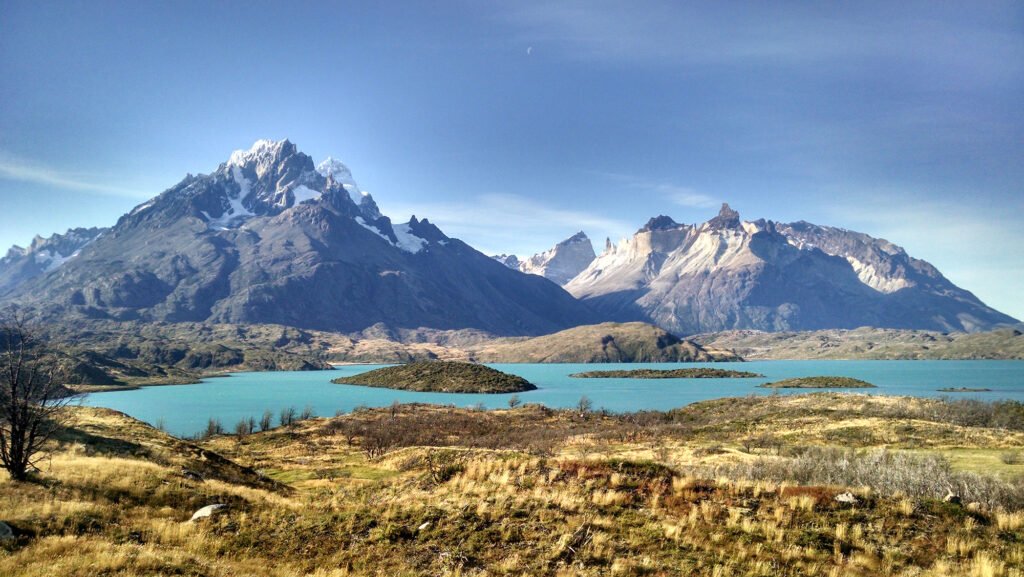
How Many Days Does it Take to go Hiking in Patagonia?
Determining the ideal duration for your Patagonian adventure depends on several factors, including your interests, fitness level, and the specific trails you plan to hike. Patagonia offers a wide range of hiking options, from day hikes to multi-day treks. Here’s a general guideline to help you plan:
- Day Hikes: If you have limited time or prefer a more relaxed experience, day hikes can be incredibly rewarding. Many of Patagonia’s iconic trails, such as Laguna de Los Tres in El Chaltén or Mirador Las Torres in Torres del Paine, can be completed in a day.
- Multi-Day Treks: For a more immersive experience, consider embarking on multi-day treks. The duration can vary significantly depending on the trail. The popular W Trek in Torres del Paine typically takes 4-5 days, while the more extensive O Circuit can span 6-9 days.
- Combination: To make the most of your visit, consider a combination of day hikes and multi-day treks. This approach allows you to explore the highlights while also delving deeper into the wilderness.
Remember that travel times between hiking destinations, rest days, and acclimatization are factors to consider when determining the duration of your Patagonian adventure. It’s advisable to plan for some flexibility in your itinerary, allowing you to fully immerse yourself in the stunning landscapes and unexpected discoveries that Patagonia has to offer.
Building in extra days also allows you to adjust your plans based on adverse weather conditions. Spending an extra night or two in a warm hostel, instead of braving the rain on a multi-day hike to ensure you keep to your itinerary, can make all the difference!
Getting to Patagonia
Patagonia spans both Chile and Argentina, and its vast wilderness is located in the southern reaches of these countries. Here’s a guide to help you reach Patagonia efficiently:
1. International Airports:
- Santiago, Chile: Many travelers fly into Santiago, Chile, for international arrivals.
- Buenos Aires, Argentina: Buenos Aires, Argentina, is another common international gateway to Patagonia.
2. Domestic Flights:
- Punta Arenas, Chile: If arriving in Santiago, consider taking a domestic flight to Punta Arenas, Chile, to minimize travel costs and time.
- El Calafate, Argentina: If departing from Buenos Aires, domestic flights to El Calafate, Argentina, offer convenience.
3. Bus Transportation:
- Connecting to Main Trekking Areas: Upon arriving in southern Patagonia, efficient and affordable bus transportation is readily available to connect you to the main trekking areas.
Hiking In Torres del Paine National Park
Now that we’ve covered essential planning aspects, let’s dive into the heart of Patagonia: Torres del Paine National Park. This iconic destination offers some of the most breathtaking hikes in the region. You can access the park via Puerto Natales .
Hiking to Mirador Las Torres
- Time Required: 8 to 9 hours
- Distance: 18km
- Difficulty: Moderately challenging with steep sections
- Start / Finish Points: Hotel Las Torres
- Highlights: Witness the famous Torres del Paine towers mirrored in the glacial lake
One cannot speak of hiking in Patagonia without mentioning Torres del Paine National Park. A must-visit for any trekking enthusiast, the Mirador Las Torres trail offers a challenging but immensely rewarding day hike. The path spans 18 kilometers and leads to the iconic Towers – three jagged peaks overlooking a turquoise lake. The last leg of the hike is steep, but the views are absolutely breathtaking. If you’re an early riser, consider starting before dawn to witness the iconic granite spires bathed in the fiery glow of sunrise.
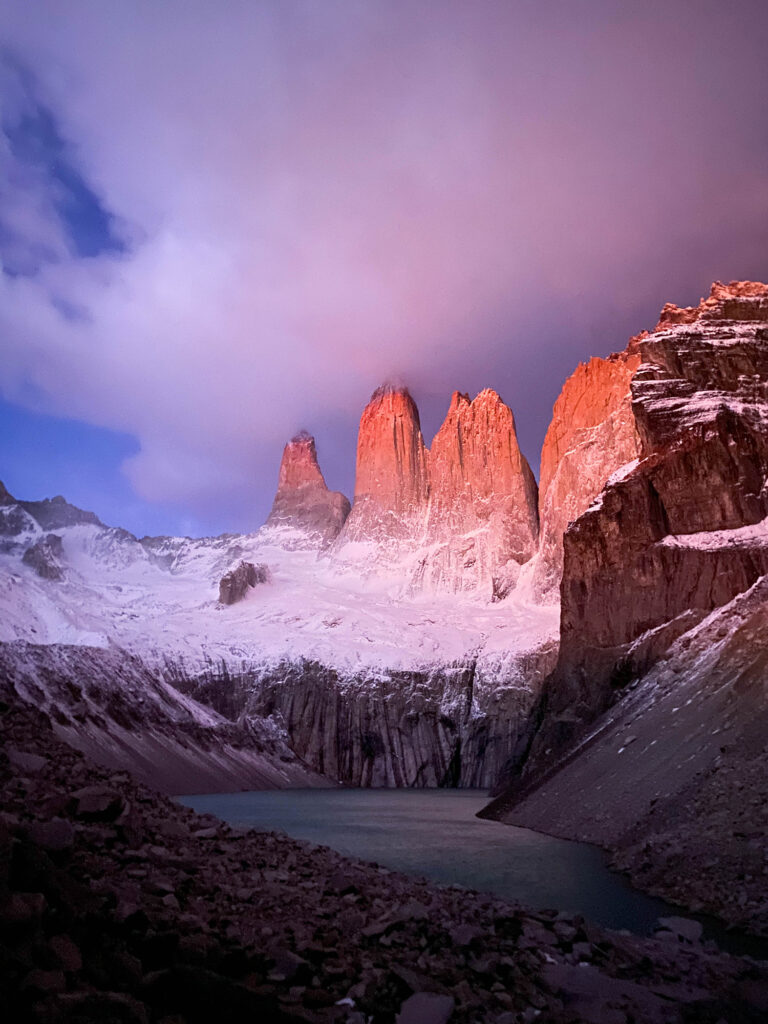
Lago Grey (Grey Glacier)
- Time Required: 3 to 4 hours
- Distance: 11 kilometers
- Difficulty: Easy to moderate
- Start / Finish Points: Mountain Lodge Paine Grande to Refugio Grey
- Highlights: Get up close to Grey Glacier’s stunning ice formations and ethereal blue glacier
For those craving a more relaxed hike with stunning glacier views, the Lago Grey trail is perfect. This 11-kilometer route takes you along the W Trek, offering glimpses of the awe-inspiring Glaciar Grey and its floating icebergs. The terrain is relatively easy, with a few tricky sections. If you’re in the mood for camping, you can spend the night at Mountain Lodge Paine Grande or Refugio Grey and enjoy the serene surroundings.
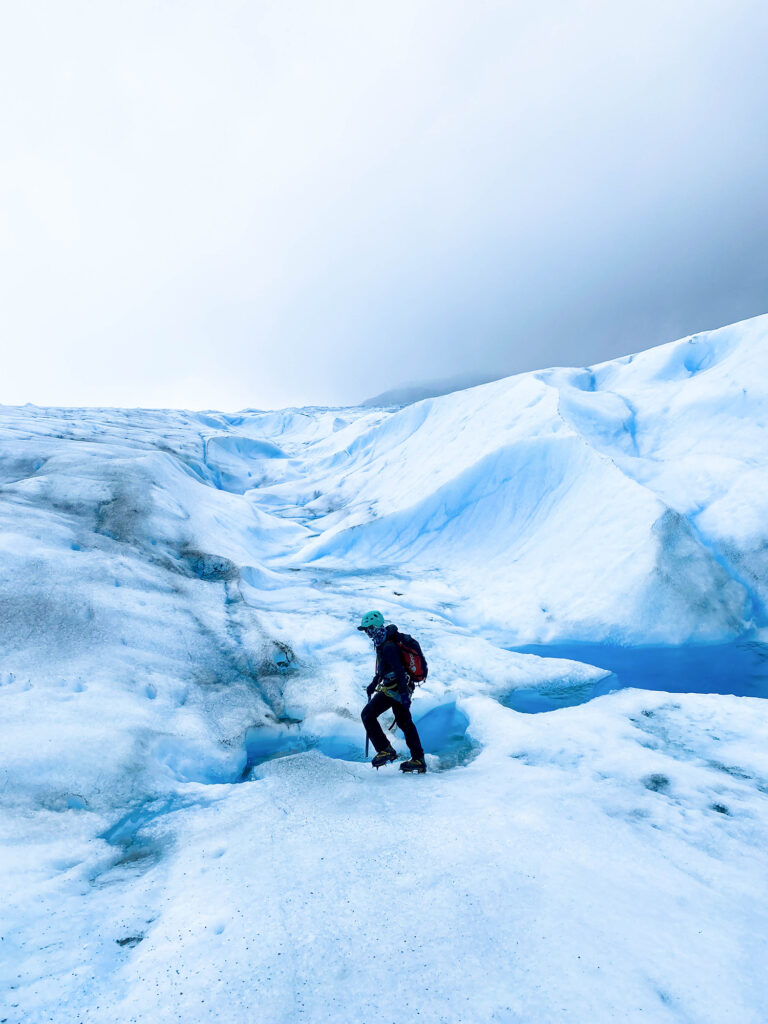
Valle del Frances (The French Valley)
- Distance: 12km
- Difficulty: Moderate
- Start / Finish Points: Refugio Los Cuernos
- Highlights: Jaw-dropping vistas of the granite peaks and hanging glaciers
Prepare to be mesmerised by the beauty of the French Valley, which offers breathtaking panoramic views of the Paine Massif. This moderate hike takes you between Cerro Paine Grande and Cuernos del Paine, following the Rio Frances. The highlight of this trail is the frozen waterfalls, a sight to behold. Although the path can be challenging, the rewards are ample. The Mirador at the end provides breathtaking views of the surrounding mountains and tarns reflecting the scenery.

Los Cuernos Trail
Offering a fantastic day hike, the Los Cuernos Trail winds its way around the stunning Lago Nordenskjold. You’ll be treated to incredible vistas of Cuernos del Paine and the lake’s clear waters. For those with extra energy, consider exploring the Valle del Frances, an additional 12-kilometer section known for its beauty. Camping options are available on the south side of Cuernos Del Paine if you want to extend your hike.
- Time Required: 6 hours
- Distance: 22km
- Start / Finish Points: Hotel Las Torres to Refugio Los Cuernos
- Highlights: Diverse landscapes and stunning views of the Cuernos del Paine

- Time Required: 4 to 5 days
- Distance: Approximately 50-70 kilometers (31-44 miles)
- Difficulty: Moderate to challenging, with steep ascents and variable weather.
- Start / Finish Points: Typically, the trek begins and ends at the administrative center of Torres del Paine National Park, near Laguna Amarga.
- Highlights: The “W” Trek in Torres del Paine National Park encompasses Mirador Las Torres, Lago Grey, the French Valley, and Los Cuernos, making it a comprehensive hiking experience.
Hiking the W Trek in Torres del Paine National Park is a bucket-list adventure for nature enthusiasts, offering a chance to immerse yourself in Patagonia’s pristine wilderness and witness some of the world’s most awe-inspiring natural wonders. You can also go ice hiking on Grey Glacier , a unique and unforgettable experience. Various accommodation options are available along the route, including campsites and mountain lodges (refugios). Reservations should be made in advance, especially during the high season. Plan ahead, pack appropriately, and embark on this unforgettable journey through Chile’s breathtaking landscapes.
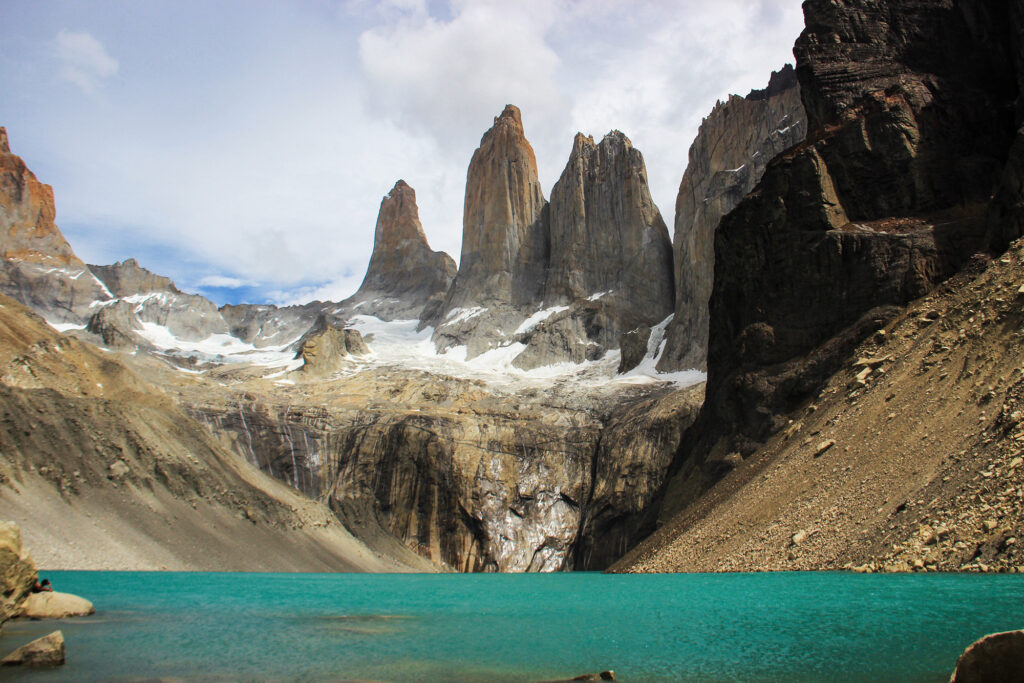
The O Circuit
- Time Required: 6-8 days
- Distance: 135km
- Difficulty: Hard
- Highlights: In addition to the sights of the W Trek, you will also see John Gardner Pass, Grey Glacier Peninsula, Paso los Perros
Considered one of the world’s best treks, the O Circuit is a must for adventurous souls. It is an extension of the W Trek, following the same trail for 4-5 days before continuing in a loop. It is a more remote, immersive wilderness experience that takes you deeper into Torres del Paine National Park.
This 135-kilometer circuit encompasses pristine forests, meadows of wildflowers, grand peaks like Cerro Paine and Cuernos del Paine, and even the iconic Las Torres. Starting at Hotel Las Torres and heading to Campamento Seron, you’ll encounter ever-changing landscapes and breathtaking scenery. Side trips to the French Valley and Las Torres are highly recommended, and you can finish your journey at Mountain Lodge Paine Grande or Lago del Toro.
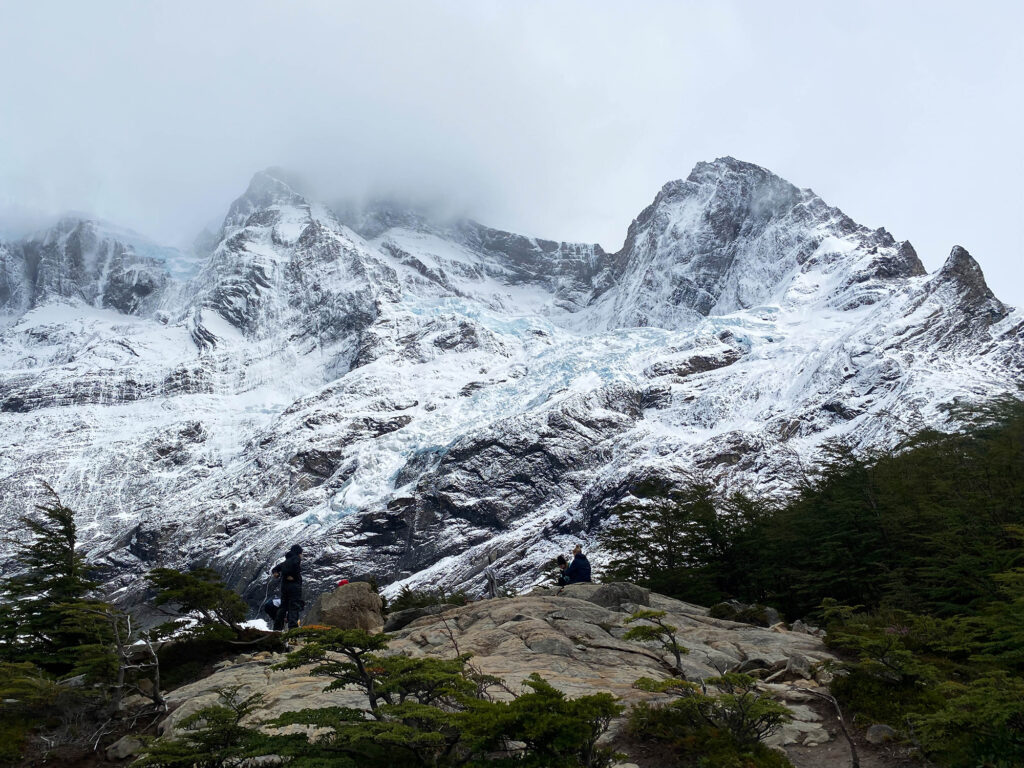
Hiking in El Chalten
While Torres del Paine is undeniably stunning, El Chalten has its own charm. It is a beloved destination for backpackers, offering unparalleled hiking opportunities amid stunning landscapes. Here are some of the best hikes in El Chalten .
Short Hike to Condor Lookout
- Time Required: 1 hour
- Distance: 2km
- Difficulty: Easy
- Start / Finish Points: El Chalten
- Highlights: Panoramic vistas and potential condor sightings
A short but sweet hike, the Condor Lookout offers unexpected views of Viedma Lake framed by snow-covered peaks. This is an excellent option for a sunrise hike, allowing you to witness the alpine glow on the mountains. The trail is gradual, making it accessible for most hikers.
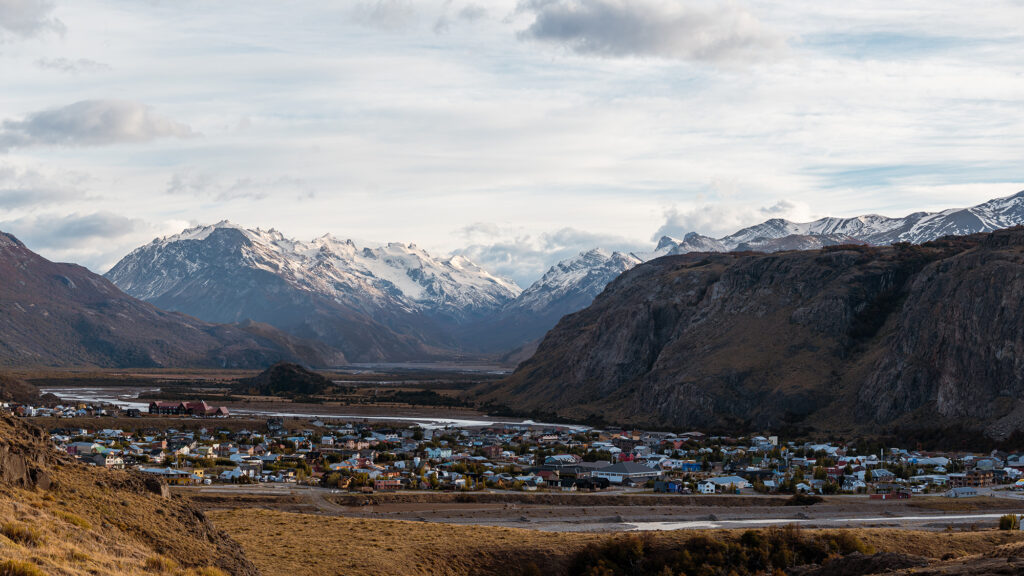
Day Hike to Laguna de Los Tres (Base Of Mt Fitz Roy)
- Time Required: 8 hours
- Distance: 26km
- Start / Finish Points: Northwest end of El Chalten
- Highlights: The incredible sight of Mt Fitz Roy mirrored in the lake
You cannot go hiking in Patagonia without visiting Mt Fitz Roy. For those seeking an up-close encounter with Mt Fitz Roy, the Laguna De Los Tres hike is a must. Starting early is advisable to catch the morning alpine glow. The trail begins gently, passing through forests, but the last hour involves a steep ascent. Your reward? The mesmerising Laguna De Los Tres with Fitz Roy towering above. If you’re up for it, consider climbing Cerro Madsen for even better views.
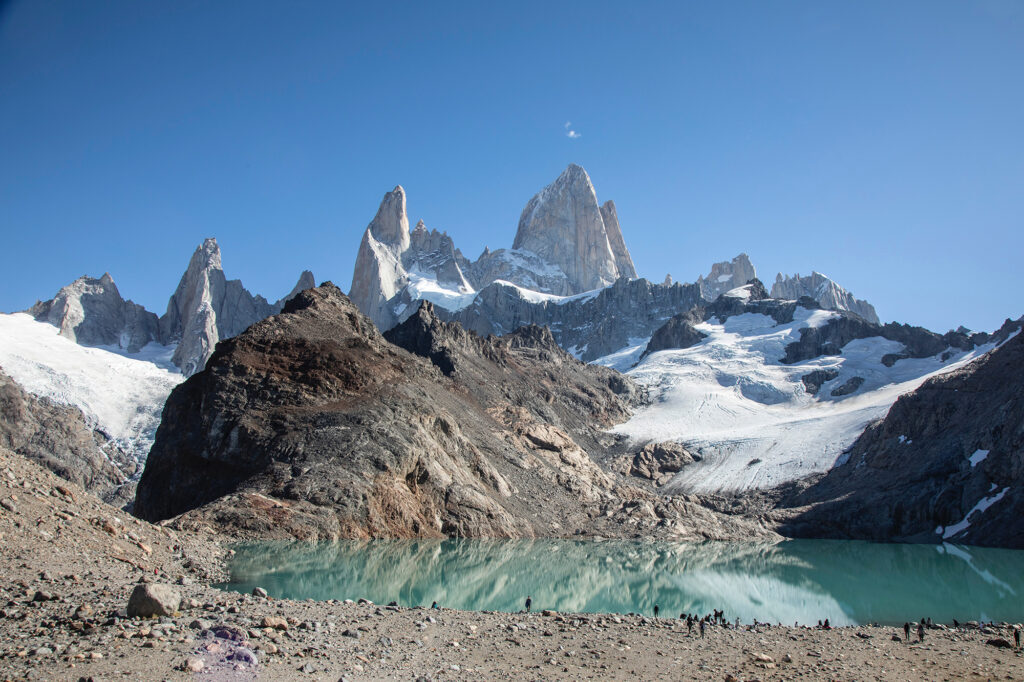
Day Hike to Laguna Suica
- Time Required: 1-2 days (can be done as a day hike)
- Distance: 19km
- Difficulty: Moderate to difficult, with some scrambling and rock climbing required
- Highlights: Scenic views of Mt Fitzroy and surrounding mountains, looming over a sparkling blue lake, with no crowds!
If you’re looking for expansive views of Mt Fitz Roy without the crowds, this is the hike for you. Instead of taking the ascent to Laguna de Los Tres, veer off the beaten path to Laguna Suica. This option offers arguably better views, and you’re likely to have the whole lake to yourself!
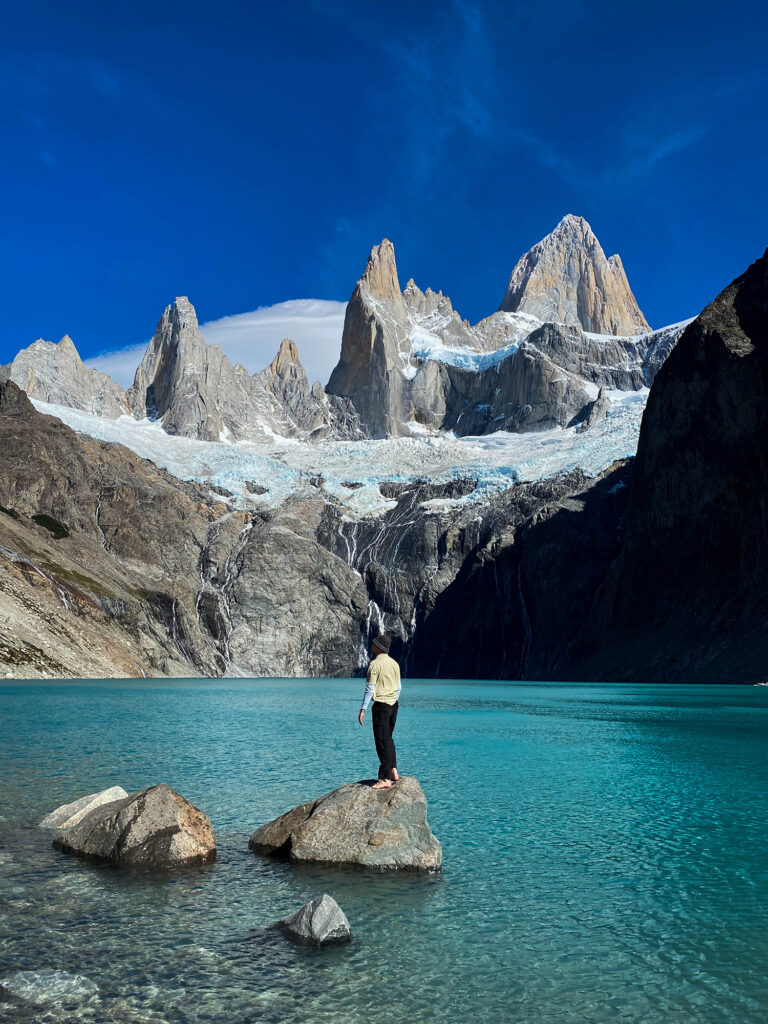
Day Hike to Cerro Torre
- Highlights: Views of Cerro Torre and its surrounding spires
Cerro Torre, reaching 3102 meters into the sky, is a sight to behold. This 2-day hike takes you through lush meadows, ever-changing glaciers, and offers stunning views of Cerro Torre and its neighboring peaks. A side trip to Mirador Maestri adds even more beauty to your journey. Return the same way you came, or camp at Campamento de Agostini for an immersive experience.
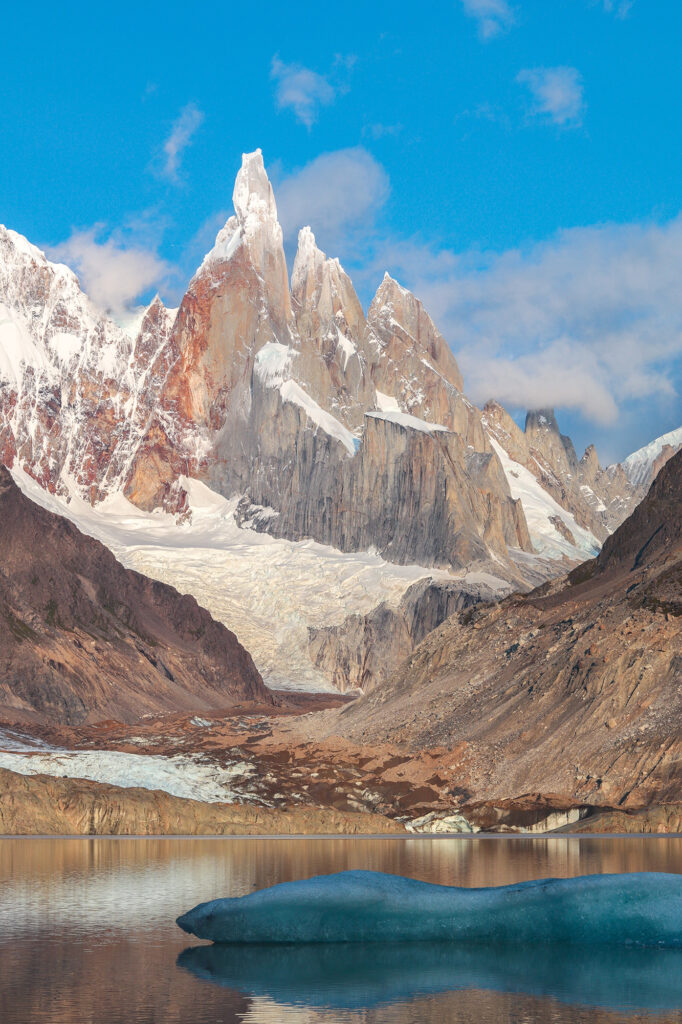
The Huemul Circuit
- Time Required: 4 days
- Distance: 63km
- Difficulty: Difficult, for advanced hikers
- Highlights: Panoramic views of Southern Patagonia, including Laguna Toro, Paso del Viento, Paso Huemul and Lake Viedma
The Huemul Circuit is not for the faint of heart, but it rewards intrepid hikers with a unique Patagonian experience. This trek takes you through breathtaking landscapes, including the majestic Mount Huemul and the Southern Patagonian Ice Field. It is known for its challenging terrain, river crossings, and rugged paths.
It’s a trek for those seeking adventure, and the relative isolation of the route ensures a sense of solitude and connection with the wilderness.
While hiking the Huemul Circuit, you may encounter a variety of wildlife, including guanacos, condors, foxes, and numerous bird species. The trek also takes you through diverse ecosystems, from lush forests to alpine meadows.
Be prepared for a difficult hike, but the views are worth every effort. Hiring a local guide is advisable for this demanding trek.
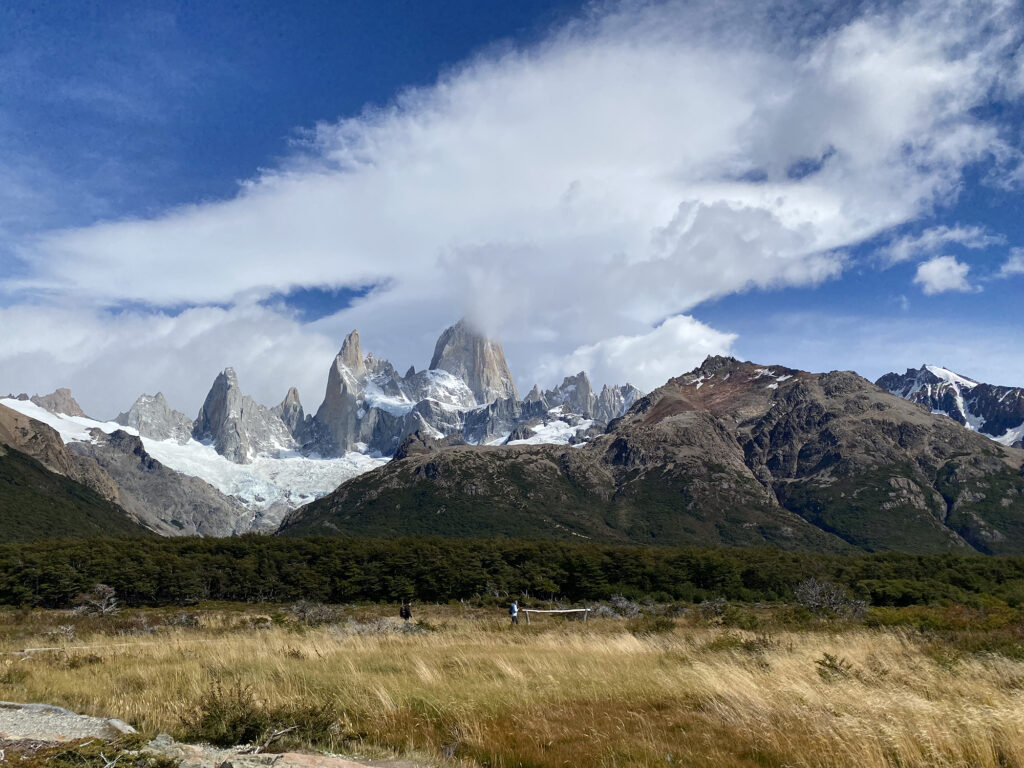
Best Hikes in Ushuaia
Located at the southernmost tip of Argentina, Ushuaia is known as ‘the end of the world’. It is the furthest of your options when hiking in Patagonia, but the views are totally worth it. Besides being a gateway to Antarctica, it offers some fantastic treks.
Laguna Esmeralda
- Distance: 9km
- Start / Finish Points: Refugio Valle Los Lobos
- Highlights: The stunning emerald-colored lake and surrounding landscapes
For a short but sweet hike, Laguna Esmeralda is a striking turquoise lake nestled amidst snow-capped peaks. This 9-kilometer trail leads to the base of Glaciar Del Albino, with an option to continue onto the glacier if you’re up for it. The refugio near the lake allows you to soak in the stunning views.
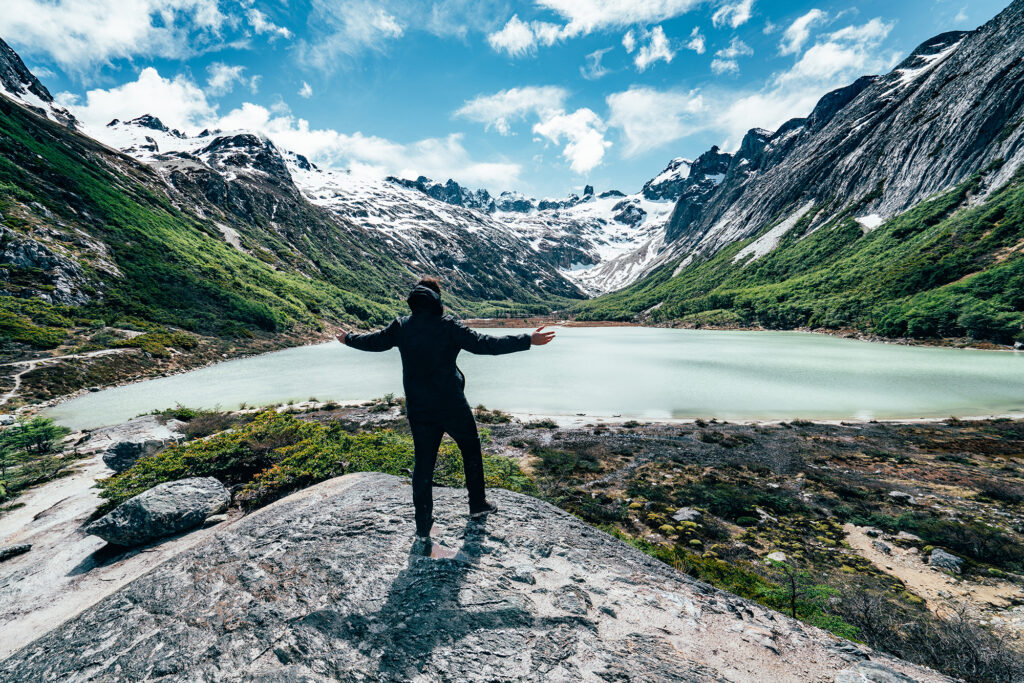
Glaciar Vinciguerra
- Time Required: 5 to 6 hours
- Distance: 13km
- Start / Finish Points: Tubera Valle Andorra
- Highlights: Close encounter with a glacier and pristine alpine scenery
The Glaciar Vinciguerra trek takes you to a series of glacial lakes with steep ascents, making it a satisfying challenge for a day hike. You’ll encounter Laguna Encatada, surrounded by lush meadows and rugged peaks. If you’re feeling adventurous, climb Cerro Esfinge for even better views.
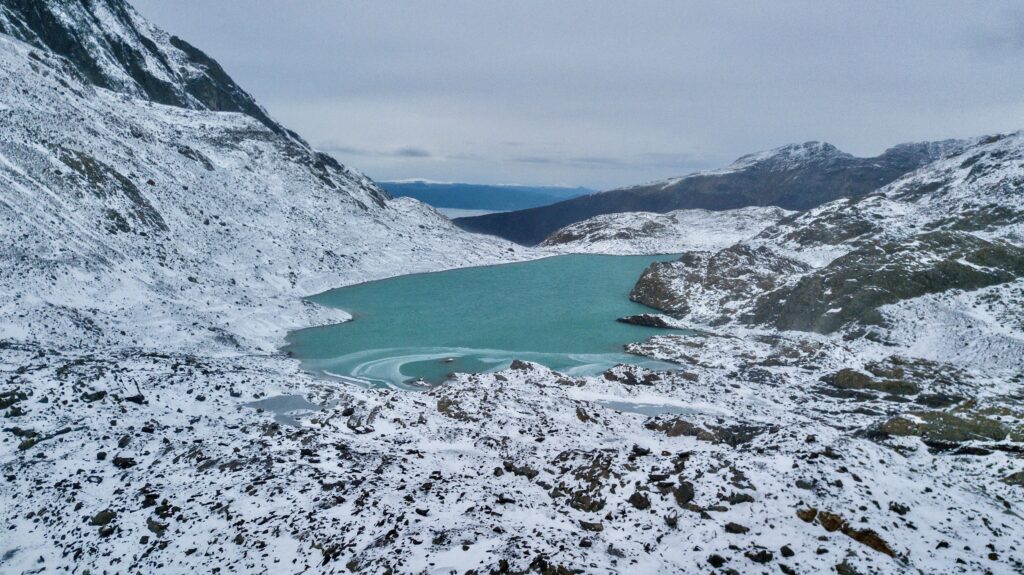
Sierra Valdivieso Circuit
- Distance: 48.5km
- Difficulty: Demanding
- Start / Finish Points: Ruta Nacional 3 or Posada del Peregrine
- Highlights: A multi-day trek encapsulating all the highlights of Ushuaia
Deep within the Fuegian Andes lies the Sierra Valdivieso Circuit, one of the most challenging treks in Argentina. This trek takes you through snowy peaks, glaciers, and crystal-clear lakes. The trail is less traveled, so good navigation skills are essential. Due to unpredictable weather, carry extra supplies.
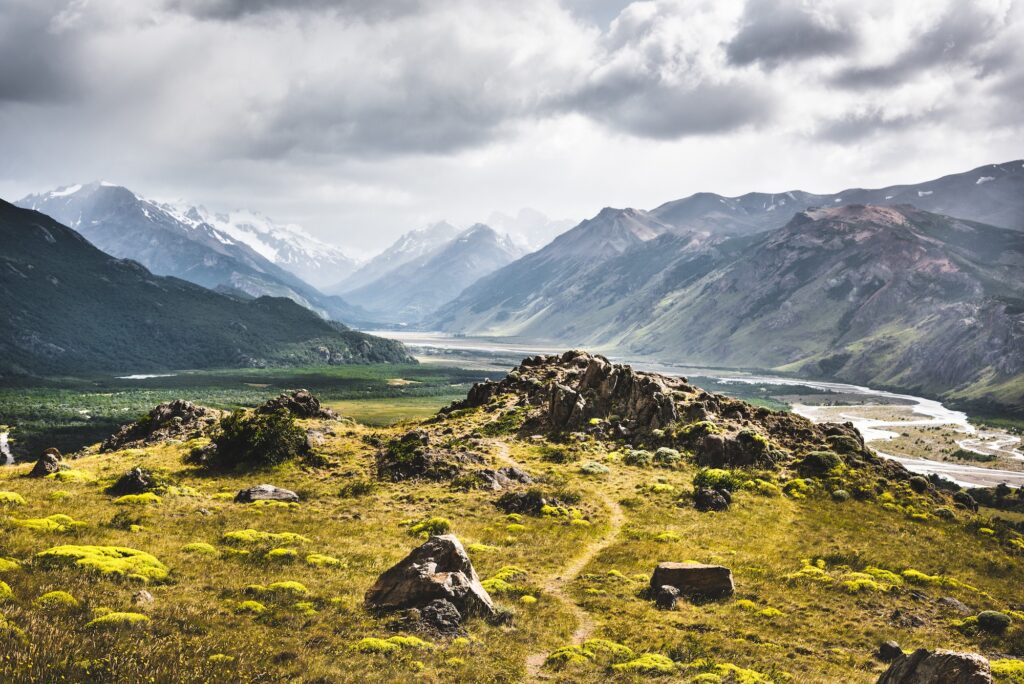
Best Hikes Along the Carretera Austral
While Patagonia’s most famous hiking destinations are often found in the well-known national parks and reserves, the Carretera Austral offers a unique opportunity to explore some of the region’s less-traveled trails. This remote highway stretches over 1,240 kilometers, running through the heart of Chilean Patagonia. Along the way, you’ll encounter a variety of off-the-beaten-path hiking experiences.
Laguna Tigre Sur
- Time Required: About 4 to 5 hours
- Distance: 8km
- Start / Finish Points: Villa O’Higgins
- Highlights: Remote and pristine landscape with the chance to spot wildlife
Located in the pristine Pumalin Park, the hike to Laguna Tigre Sur is a hidden gem. This relatively short trail takes you through lush temperate rainforests, offering glimpses of Patagonia’s diverse flora and fauna. The reward at the end is the serene Laguna Tigre Sur, a tranquil lake surrounded by ancient forests. The area’s remoteness ensures a peaceful and immersive experience.
Valle Rio Moscu
- Time Required: About 5 to 7 hours
- Highlights: Lush valleys and beautiful river views
Deep within the Aysen region, Valle Rio Moscu offers an enchanting trek through pristine wilderness. This valley is known for its stunning scenery, including dramatic waterfalls, lush forests, and crystal-clear rivers. The trail takes you along the Moscu River, surrounded by towering peaks and glaciers. Be prepared for challenging river crossings, but the breathtaking views make it all worthwhile.
Cerro Castillo
- Time Required: 3 to 5 days, depending on the route
- Distance: 62km
- Difficulty: Moderate to challenging
- Start / Finish Points: Las Horquetas Grandes to Villa Cerro Castillo
- Highlights: Stunning mountain scenery and pristine wilderness
While Cerro Castillo is often associated with its well-known reserve, you can also explore its lesser-known and equally spectacular trails. The Cerro Castillo trek takes you through lush forests, across pristine rivers, and up to high alpine meadows. The reward is the stunning view of Cerro Castillo’s jagged peaks and glaciers. This trek is a fantastic alternative for those looking to avoid the crowds while still enjoying the beauty of the region.
Pumalin Park – Cascadas Waterfalls Hike (Escondidas)
- Time Required: 1 to 2 hours
- Distance: 3.5km
- Start / Finish Points: Caleta Gonzalo
- Highlights: Remarkable nature reserve with cascading waterfalls
Pumalin Park is a true wilderness paradise, and the Cascadas Waterfalls Hike is a prime example of its natural beauty. This trail leads you through dense forests, alongside pristine rivers, and to a series of cascading waterfalls. The lush vegetation, combined with the sounds of rushing water, creates a magical atmosphere. While the hike itself is not particularly long or strenuous, it offers a peaceful escape into the heart of Patagonia.
Planning Your Hike in Patagonia
Can you hike patagonia on your own.
Choosing between independent or guided trekking depends on your experience and personal preferences. If you’re an experienced backpacker tackling a well-traveled route like the W Trek or hikes around Fitz Roy, independent hiking is entirely feasible. These trails are well-marked, and with proper planning, you can have a successful journey. However, meticulous preparation is essential, including booking campsites in advance.
For those seeking a more guided experience or exploring less-traveled routes, organized tours provide valuable support and expertise. Guided tours handle logistics, navigation, and safety measures, allowing you to focus on enjoying the scenery and adventure. Let’s explore the pros and cons of both options.
Hiking in Patagonia Independently (incl. Solo Hiking)
- Freedom: Hiking independently allows you to set your own pace and explore as you wish.
- Cost: It’s generally more budget-friendly than guided tours.
- Self-Discovery: You’ll gain valuable wilderness skills and self-sufficiency.
- Navigational Challenges: Patagonia’s trails can be challenging to navigate, and weather conditions can change rapidly.
- Safety: In remote areas, getting help in emergencies can be difficult.
- Logistics: Planning routes, permits, and accommodations can be time-consuming.
Hiring a Guide for Patagonia (incl. Group Tours)
- Expertise: Guides offer in-depth knowledge of the terrain, flora, fauna, and local culture.
- Safety: They are trained in wilderness first aid and can respond to emergencies.
- Logistical Support: Guides handle permits, accommodations, and meal planning.
- Cost: Guided tours are more expensive due to the added services.
- Less Freedom: You’ll follow a predefined itinerary.
Ultimately, the decision comes down to your experience, comfort level, and objectives. Experienced hikers with wilderness navigation skills may relish the freedom of independent trekking. However, if you’re new to Patagonia or prefer a structured experience, hiring a guide can enhance your adventure and safety.
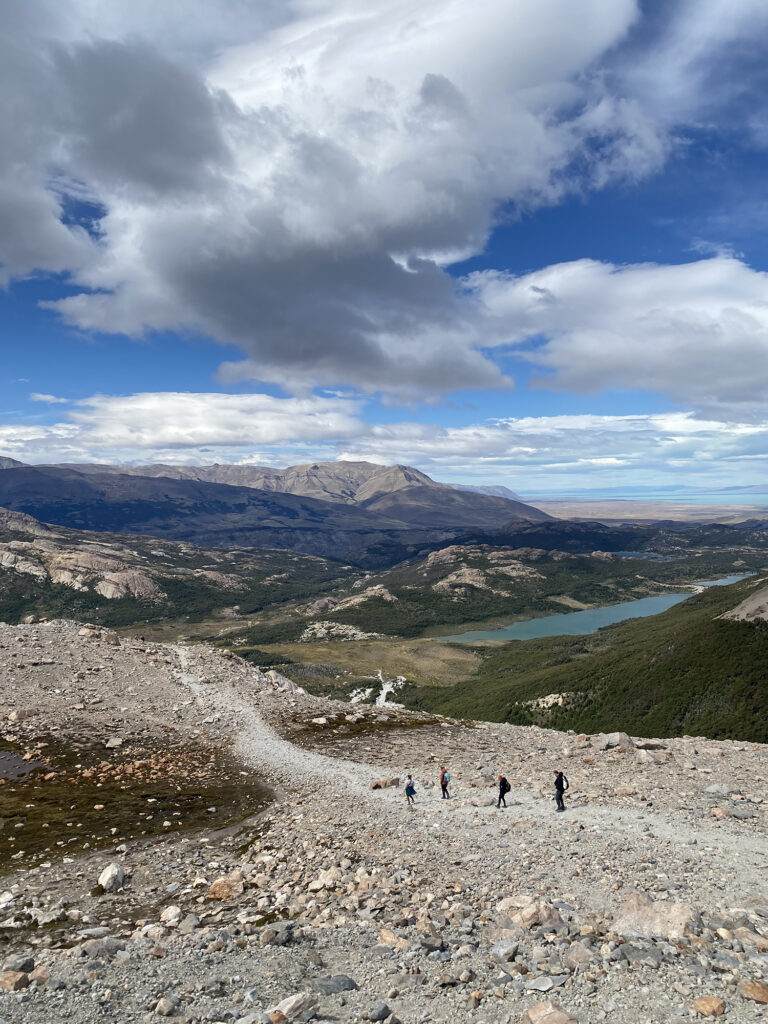
Is Hiking in Patagonia Difficult?
Patagonia’s hiking trails offer varying levels of difficulty, from relatively easy day hikes to challenging multi-day treks. The difficulty of your hike depends on factors such as trail conditions, terrain, and weather. Here’s a breakdown:
- Easy Hikes: Short, well-marked trails with minimal elevation gain, suitable for beginners and families. Examples include Laguna Esmeralda and Condor Lookout.
- Moderate Hikes: Longer day hikes or multi-day treks with moderate elevation gain and varied terrain. Trails like the W Trek and Cerro Torre fall into this category.
- Challenging Hikes: Multi-day treks with significant elevation changes, steep ascents or descents, and unpredictable weather. The O Circuit and Huemul Circuit are more challenging options.
- Technical Hikes: Some routes may involve technical climbing or glacier travel, requiring specialized skills and equipment. Seek guidance from experts for these adventures.
It’s crucial to choose hikes that match your fitness level and experience. Beginners can enjoy many fantastic trails in Patagonia with the right preparation and gear.
Can Beginners Go Hiking in Patagonia?
Yes, beginners can certainly enjoy hiking in Patagonia, but it’s essential to plan appropriately and choose suitable trails. Here are some tips for novice hikers:
- Select Easy to Moderate Trails: Start with shorter and less challenging hikes that match your fitness level. Laguna Esmeralda, Condor Lookout, and the short hikes in Torres del Paine are excellent options.
- Prepare Physically: Begin a fitness routine that includes cardiovascular and leg-strengthening exercises to build endurance for hiking.
- Acclimate: If possible, spend a day or two in a nearby town like Puerto Natales or El Calafate to acclimate to the altitude and climate.
- Gear Up: Invest in proper hiking gear, including waterproof and insulated clothing, sturdy hiking boots, and trekking poles for stability.
- Travel Light: Keep your backpack as light as possible to reduce the strain on your body.
- Plan Adequate Time: Allocate extra time for rests and adjustments to the pace, especially if you’re not accustomed to hiking.
- Stay Informed: Check trail conditions, weather forecasts, and park regulations before embarking on your hike.
- Travel with a Group: If you’re uncertain about your hiking abilities, consider joining a guided tour or traveling with experienced hikers.
Remember that safety should be a priority, and it’s better to start with easier hikes and gradually progress to more challenging trails as you gain confidence and experience.
Cost of Hiking in Patagonia
It’s important to note that Patagonia is not a budget-friendly destination compared to other South American locations. Expect higher costs for lodging, food, and various amenities. However, there are options to save money. Some factors influencing the cost of your trip include duration, accommodation preferences, and whether you hire a guide. Here’s a breakdown of potential expenses:
- Flights: International and domestic flights to Patagonia can be a significant expense, so booking in advance and searching for deals is advisable.
- Accommodation: Options range from camping (cheapest) to hostels, cabins, and luxury lodges (more expensive). Prices increase during peak seasons.
- Park Fees: Most national parks in Patagonia charge entrance fees. The costs vary, so check with each park for updated prices.
- Food: Dining out in Patagonia can be pricey, especially in remote areas. Consider bringing some of your own food for longer treks to save money.
- Gear and Equipment: Investing in quality hiking gear, clothing, and camping equipment can be expensive upfront but pays off in comfort and safety.
- Guides: Hiring a guide or joining a guided tour adds to the cost but provides expertise and logistical support.
- Transportation: Transportation within Patagonia, such as buses or boats, will contribute to your expenses.
- Miscellaneous: Budget for additional expenses like permits, travel insurance, and souvenirs.
It’s possible to go hiking in Patagonia on a tight budget by camping, preparing your own meals, and choosing less expensive accommodations. Conversely, those seeking more comfort and convenience can opt for guided tours and upscale lodging. Careful planning and budgeting will help you make the most of your Patagonian adventure within your financial means.
How Safe is Hiking in Patagonia?
Hiking in Patagonia offers incredible experiences, but it’s essential to prioritise safety due to its remote and challenging nature. Here are some safety considerations:
- Weather: Be prepared for rapidly changing weather conditions. Carry adequate clothing, rain gear, and layers to stay warm and dry.
- Navigation: Trails can be poorly marked, and getting lost is a risk. Carry maps, a compass, and a GPS device, and know how to use them.
- Wildlife: Patagonia is home to various wildlife, including pumas. Understand how to react if you encounter animals and store food securely.
- Altitude: Some hikes reach high altitudes. Acclimatize gradually and be aware of symptoms of altitude sickness.
- Water: Water sources can be contaminated. Use water treatment methods to ensure safe drinking water.
- Emergency Contact: Inform someone of your itinerary and expected return time. Cell phone coverage can be limited.
- Health: Ensure you have any necessary medications and a basic first aid kit. Be prepared for minor injuries and know basic first aid.
- Group Travel: Traveling with others or hiring a guide can enhance safety, especially for beginners.
- Local Advice: Seek advice from local rangers and experts who can provide up-to-date information on trail conditions and safety concerns.
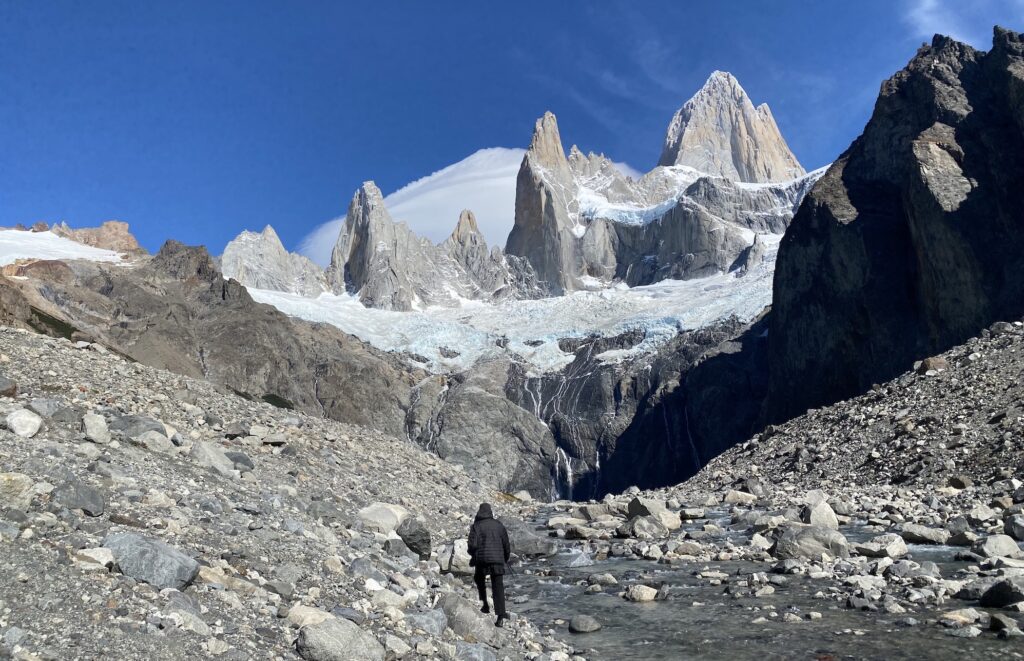
Hiking in Patagonia Packing List
Before you embark on your Patagonian adventure, it’s essential to have the right gear and supplies to ensure a safe and enjoyable journey. Here’s a comprehensive packing list to help you prepare for trekking in Patagonia:
- Moisture-wicking base layers (top and bottom)
- Insulating mid-layers (fleece or down jacket)
- Waterproof and windproof outer layer (jacket and pants)
- Quick-drying hiking pants
- Sturdy and comfortable hiking boots
- Warm gloves
- Wool hat or beanie
- Moisture-wicking socks and sock liners
- Gaiters (for keeping debris out of your boots)
- Sun hat and sunglasses
- Bandana or buff (for sun protection)
- Swimsuit (for swimming in thermal pools or lakes)
Backpacking Gear
- Hiking backpack with rain cover (40-70 liters, depending on your trip)
- Tent or lightweight shelter (if camping)
- Sleeping bag suitable for cold weather
- Sleeping pad or mattress
- Cooking stov e and cookware (if camping)
- Lightweight utensils, cup, and bowl
- Headlam p or flashlight with extra batteries
- Multi-tool or camping knife
- Lighter or waterproof matches
- Trekking poles (optional but recommended)
- Dry bags or stuff sacks (for organising gear)
- Navigation tools (maps, compass, GPS)
Personal Items
- Passport and any necessary visas
- Travel insurance information
- Cash in local currency (ATMs may be scarce)
- First-aid kit with essential medications
- Toiletries (toothbrush, toothpaste, soap, etc.)
- Microfiber towel
- Insect repellent
- Sunscreen and lip balm with SPF
- Personal identification (ID or driver’s license)
- Camera and accessories
- Charging cables and portable power bank
Food and Water
- High-energy snacks (nuts, energy bars, dried fruit, etc.)
- Dehydrated or freeze-dried meals (if camping)
- Reusable water bottle or hydration reservoir (3+ liters)
- Water purification filter or water purification tablets
Miscellaneous
- Travel itinerary and emergency contact information
- Travel adapters and chargers
- Travel-sized sewing kit
- Ziplock bags (for organizing and waterproofing)
- Trash bags (for packing out waste)
- Local guidebooks or trail maps
- Notepad and pen
- Entertainment (book, playing cards, etc.)
- Solar charger for electronics
- Binoculars for wildlife viewing
- Travel pillow
- Camp shoes (lightweight sandals or camp slippers)
- Down booties for keeping feet warm in camp
Leave No Trace Principles
When hiking in Patagonia, it’s crucial to adhere to Leave No Trace principles to minimize your impact on the environment. These principles include:
- Plan ahead and prepare: Research your route, obtain necessary permits, and pack appropriately to minimize waste and resource use.
- Travel and camp on durable surfaces: Stick to established trails and campsites to prevent soil erosion and damage to fragile ecosystems.
- Dispose of waste properly: Pack out all trash and waste, including biodegradable items like food scraps and toilet paper.
- Leave what you find: Preserve the natural environment by not picking plants, disturbing wildlife, or removing rocks and historical or cultural artifacts.
- Minimize campfire impact: Use a camp stove for cooking instead of making fires, as fires can scar the landscape and deplete limited wood resources.
- Respect wildlife: Observe animals from a distance, avoid feeding them, and keep a safe distance to prevent stress and harm.
- Be considerate of other visitors: Keep noise levels down, yield the trail to others, and maintain a friendly and respectful attitude towards fellow hikers.
By following these principles, you can help protect the fragile ecosystems of Patagonia and ensure that this pristine wilderness remains a natural wonder for generations to come.
Hiking in Patagonia is a journey into the heart of one of Earth’s most awe-inspiring landscapes. From the towering peaks of Torres del Paine to the hidden treasures of the Carretera Austral, this region offers a diverse range of trails for adventurers of all levels. Whether you choose to hike independently or join a guided tour, careful preparation, respect for the environment, and a sense of wonder are essential companions on your Patagonian trek.
As you embark on your adventure, take the time to savour the beauty of Patagonia, listen to the whispers of the wind, and marvel at the sheer majesty of nature. In this remote corner of the world, you’ll discover not only breathtaking landscapes but also a profound connection to the wild and untamed spirit of Patagonia. So lace up your boots, shoulder your pack, and set out to explore this magnificent land – Patagonia awaits your footprints, and the adventure of a lifetime awaits your spirit.
Hiking in Patagonia offers a range of difficulty levels. Some trails are suitable for beginners with minimal elevation gain, while others are more challenging, requiring experience and endurance. Choose trails that match your fitness level and goals.
Yes, beginners can hike in Patagonia. Many trails are beginner-friendly, such as short day hikes and well-marked paths. However, it’s essential to prepare physically, choose appropriate trails, and be equipped with proper gear for varying weather conditions.
The duration of your hike in Patagonia varies greatly depending on the trail and your itinerary. You can enjoy short day hikes or embark on multi-day treks that last from a few days to several weeks. It’s flexible and depends on your preferences.
Yes, you can hike in Patagonia independently. Many trails are well-marked, and with proper preparation, navigation tools, and safety precautions, solo hiking is possible. However, some remote and technical routes may require guides or group travel.
Hiking in Patagonia can be safe if you prioritize safety precautions. Weather conditions can change rapidly, and wildlife is present. With proper gear, navigation tools, and knowledge, you can minimize risks. Traveling with others or hiring guides can enhance safety, especially for beginners.
The cost of hiking in Patagonia varies depending on factors like accommodation, transportation, gear, and whether you choose guided tours. Budget-conscious travelers can camp and cook their meals to save money, while those seeking more comfort might spend more on lodging and services.
The best time to visit Patagonia depends on your interests. For milder weather and more accessible trails, consider the spring and summer months from November to March. However, each season offers unique experiences, so plan based on your preferences.
Both Chilean and Argentine Patagonia both offer breathtaking landscapes and hiking opportunities. Argentina offers similar views at a much lower budget: you can even camp for free. Chile has more developed infrastructure, which comes with bigger crowds and higher cost. But it is also arguably (ever so slightly) more beautiful than Argentina. Your choice may depend on specific destinations, visa requirements, or the type of experiences you seek.
Determining the most beautiful part of Patagonia is subjective, as it offers diverse landscapes. Torres del Paine National Park in Chile and Los Glaciares National Park in Argentina are often considered among the most stunning areas. Each region has its own unique charm.
Patagonia is rich in wildlife, including guanacos, foxes, condors, red-headed woodpeckers, and if you’re fortunate, elusive creatures like pumas, huemuls, or pygmy owls. The marine life is abundant, with whales, seals, and penguins along the coast. Patagonia’s biodiversity is a highlight for nature enthusiasts.

Lucas is a travel writer with deep experience exploring South America. He enjoys hiking through mountain ranges, cycling across deserts and paddling down rivers.
Best Food in Puerto Natales: 17 Top Restaurants & Cafes
Get our best tips direct to your inbox.
12 unmissable hikes in Patagonia: wonder at the pristine wilderness
Nov 16, 2021 • 10 min read
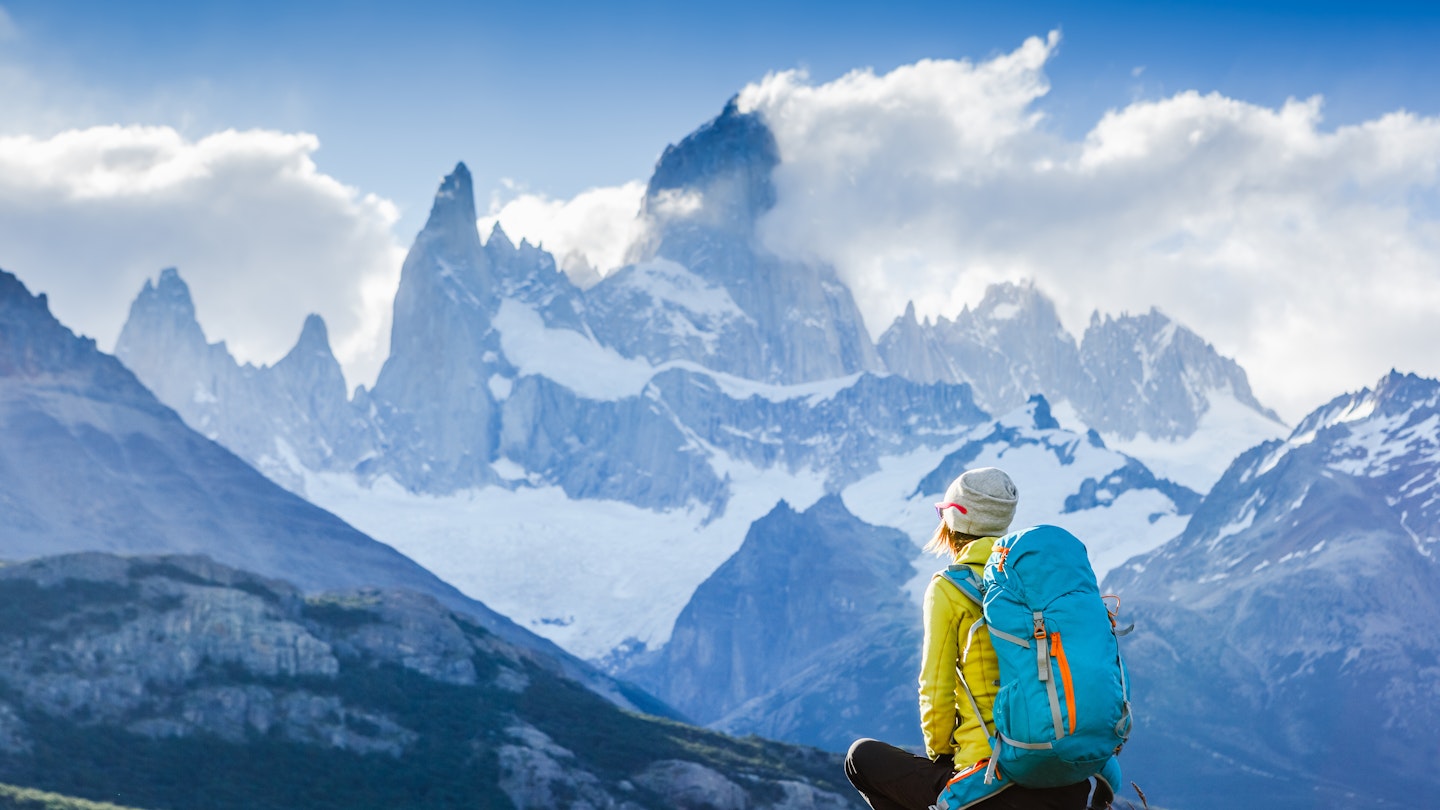
From short walks to multi-day treks, there are many inspiring hikes to choose from in Patagonia © Olga Danylenko / Shutterstock
The name “Patagonia” typically conjures up visions of endless pampas (grasslands) and southern cowboys, but there is so much more to the region than that. Covering a massive chunk of southern Chile and Argentina , this unique 402,734 sq mile region is a patchwork of diverse terrains and microclimates that challenges and surprises hikers of all abilities.
Criss-crossed by glacial rivers and streams, alternately covered in scrubland and ancient woodland, and dotted with myriad ice-melt lakes ranging from pale blue to navy, Patagonia bristles with mountain ranges (particularly on the Chilean side) and glitters with glaciers. Whether you’re looking to rough it on multi-day treks through pristine wilderness, hike from hut to hut in epic national parks , exert yourself on varied day treks before returning to the comfort of your boutique guesthouse, or just stretch your legs beneath the shade of Chile’s and Argentina’s oldest trees while road-tripping along Chile’s Carretera Austral , Patagonia has a great deal to offer.
Trekking in Patagonia and Tierra Del Fuego (included in this list of hikes) is largely confined to the peak and shoulder seasons of November to late March. If hiking off the beaten track, make sure someone knows your proposed route, take a tent sturdy enough to withstand the famous Patagonian wind – La Escoba de Dios (God’s Broom) – and all the supplies you’ll need . During any hike, all-weather gear is a must (since you may experience four seasons in one day!). Accommodations must be booked many weeks in advance for the December to February high season.
Here are 12 of the region's very best hikes.

The "W", Torres del Paine National Park (Chile)
Best overnight hike
46 miles (74km) one way, 3–5 days, moderate
The shorter of the two multi-day treks that Chile’s iconic Torres del Paine National Park is known for, this trail is shaped like the letter "W" (hence the name). You take a boat across Lake Pehoé, hike through woodland along the banks of Lake Grey to the icy monolith of Glacier Grey before retracing your steps. You then pass along the shores of glacial Lake Nordenskjold, and climb steeply up the French Valley for an up-close look at Los Cuernos – the park’s bell-shaped mountain range. A final stint through scrubland, across hills and up the Ascencio river valley brings you to the trident peaks of Las Torres. You can either camp en route at designated campsites, go from refugio (bunk hut) to refugio , or even glamp along the way. Due to Torres del Paine’s immense popularity, all accommodations and camping spots have to be pre-booked months in advance. The "W" is best hiked west to east if you’re camping, so that you’ll have used up most supplies before tackling the steep ascent to the granite towers.
Laguna de Los Tres, Parque Nacional Los Glaciares (Argentina)
Most scenic and most challenging
15.5 miles (25km) round trip, 8–10 hours, moderate
Only accessible on less windy days, this is the most scenic and challenging of all the day hikes around southern Argentina’s compact trekking capital of El Chaltén . The well-marked trail ascends through ñire (small southern beech) woodlands from the north end of El Chaltén’s main street, past the turquoise Laguna Capri, and across boggy terrain to Camapamento Poincenot, popular with climbers. A steep, exposed trail zigzags up the mountain side to the glacial lagoon, where you get excellent bonus views of Cerro Fitz Roy (11171ft/3405m) – the mountain resembling a jagged tooth. Dip your feet in the water and see how quickly they lose all feeling!
Lagunas Altas Trail, Parque Nacional Patagonia (Chile)
Easiest to access
14.2 miles (23km) loop, 8 hours, moderate
The most easily accessible trail in Parque Nacional Patagonia , due to its location near the entrance to the park this invigorating leg-stretcher is stupendously scenic. Climbing a forested ridge from the Westwind Campsite near the visitors center, the trail passes several tiny glacial meltwater lakes as you cross open terrain. You’ll find that your jaw drops open more than once during the hike at the all-encompassing views of the northern Patagonian ice field, Chacabuco Valley and the Jeinimeni Mountains en route.
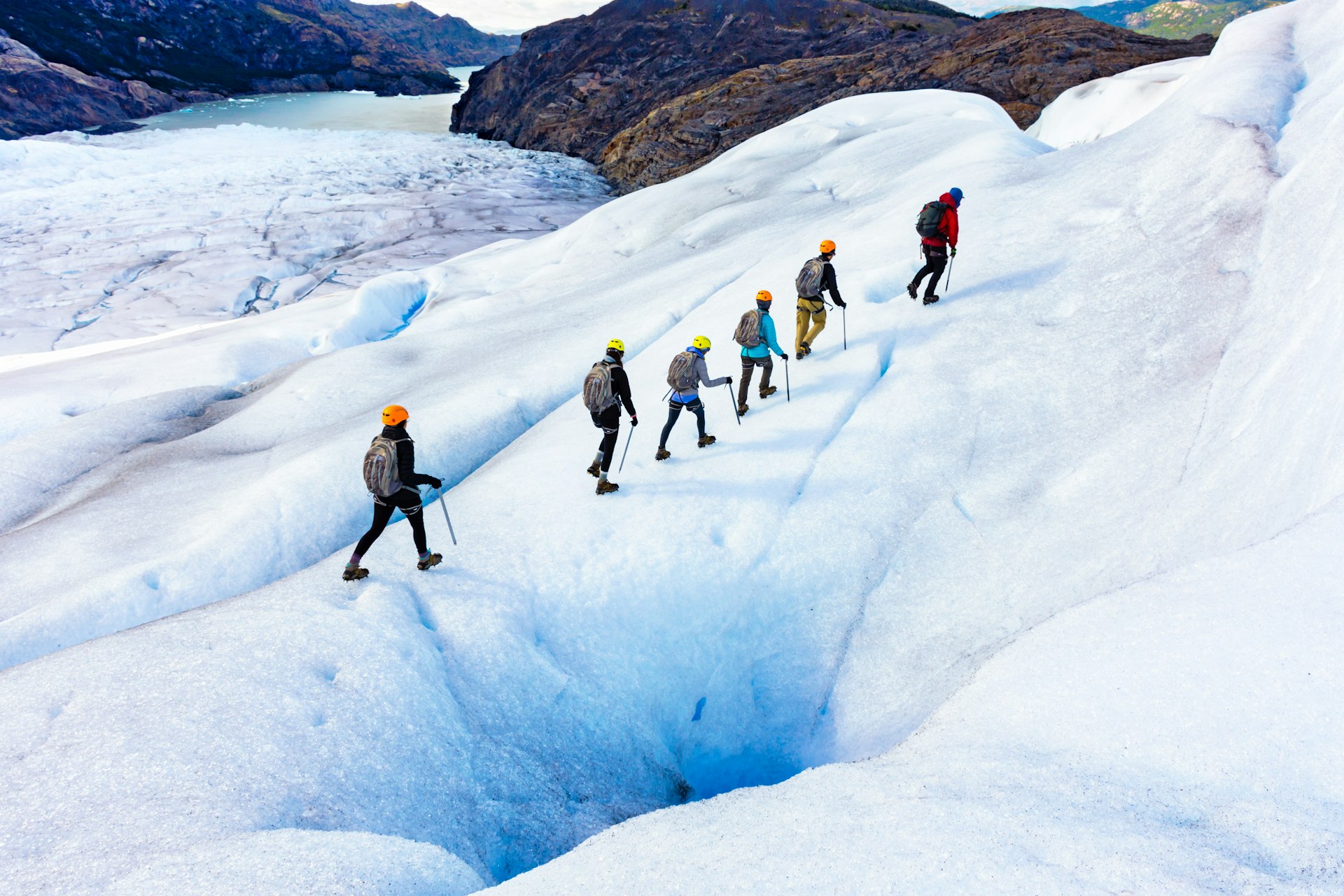
The "Circuit", Torres del Paine National Park (Chile)
Best long-distance trek
68 miles (110km) loop, 6–10 days, moderate
If you have more time to spare, hike the loop-shaped Circuit, the longest trek in Torres del Paine, trekked in a clockwise direction. Incorporating the "W", this spectacular loop gives you unique views of the backs of Los Cuernos and Las Torres – the park’s two mountain ranges – from remote back country. The terrain is never boring, as you climb partially-forested hills en route from the Serón campsite to the Dickson campsite and refugio , enjoying views of Lake Paine and Lake Dickson along the way, and taking boardwalks across boggy sections. This first half of the hike is where you’re most likely to come face to face with one of the park’s many mountain lions.
From Refugio Dickson, you enter dense southern forest with its thickets of giant wild rhubarb and ferns, with glimpses of waterfalls through the trees. The highest and most challenging part of the trek is the weather-dependent crossing of the John Gardner Pass (4002ft/1220m) between the Los Perros Campsite and Refugio Grey. Once you reach the top, the Glacier Grey icefield opens up below you like a vast, frozen river. As with the "W", you can either camp all the way, or go from refugio to refugio .
Los Alerces Trail, Parque Nacional Pumalín Douglas R. Tompkins (Chile)
Best easy hike
0.5 mile (700m) loop, 30 minutes, easy
Alerce trees are the giants of Patagonia. Growing up to 148ft (45m) in height and living for up to 3000 years, and used for making southern Chile’s unique shingled roof tiles, they were cut down almost to extinction by colonists in the late 19th and early 20th centuries and now have protected status. Off the Carretera Austral, some 7.7 miles (12.5km) south of the Caleta Gonzalo car ferry landing, this wonderful interpretive trail passes through a particularly impressive grove of these millennia-old skyscrapers of the forest.

Laguna Torre, Parque Nacional Los Glaciares (Argentina)
Best hike with icebergs and glaciers
13.6 miles (22km) roundtrip, 6–8 hours, moderate
Another excellent day hike from El Chaltén, this trail takes you from the south of town through the Fitz Roy river valley. Passing a small hydroelectric station, you climb through lenga and ñire woods to reach the Mirador Laguna Torre, with views of glaciers beneath the Adela mountain range, Cerro Torre, Mt Fitz Roy and the granite "needles" popular with rock climbers. Crossing an alluvial plain bisected by the glacial Fitz Roy river, you pass the partially sheltered De Agostini campsite before skirting the iceberg-filled Laguna Torre to reach Mirador Maestri, overlooking the Grande glacier.
Laguna de Los Témpanos, Parque Nacional Queulat (Chile)
Best hike in Parque Nacional Queulat
1.2 miles (2km) return, 1 hour, easy
If you do just one hike in Parque Nacional Queulat , off Chile’s Carretera Austral in northern Patagonia, make it this one. From the main car park, after crossing the hanging bridge high above the raging Ventisquero river, you may have to brave the perpetual rain. Expect to beslapped in the face with moisture-laden ferns as you make your way through dense forest and damp undergrowth along this straightforward trail to a splendid glacial lagoon – but it’s well worth it. From the banks of the lagoon, you get uninterrupted views of the Ventisquero Colgante – a hanging glacier across the lagoon, filled with car-sized chunks of calved ice. The frequently inclement weather, and the park’s remoteness, means you’re likely to have it all to yourself.
Volcan Chaitén Crater Trail, Parque Nacional Pumalín Douglas R. Tompkins (Chile)
Best all-encompassing view
2.7 miles (4.4km) round trip, 3 hours, moderate
In 2008, the eponymous volcano in northern Patagonia staged a surprise eruption and buried half the town of Chaitén under mud and ash. This relatively steep five-hour round-trip trek starts near Puente Los Gigos, off the Carretera Austral, north of the now-rebuilt town. Following the eruption path of the volcano, the trail gets progressively more barren the higher you get. Your reward at the top is the all-encompassing view of the still-smoking crater and the surrounding forest.
Dientes de Navarino Circuit, Navarino Island (Chile)
Best demanding trek
33.2 mile (53.5km) loop, 4–5 days, difficult
On Chile’s southernmost permanently inhabited territory (across the Beagle Channel from Tierra del Fuego), this demanding trail loops around the jagged pinnacles of the Dientes de Navarino mountain range. Requiring camping wild and excellent navigation skills, it’s best done in a clockwise direction with at least one other companion. The trail cuts across bare stony plateaux, skirts glacial lakes, traverses boggy lowlands, and crosses exposed mountain passes, with highlights including expansive views of the Beagle Channel from Cerro Bandera and Paso Virginia (near the beginning and end of the trek, respectively). Watch your footing on the steep, rapid descent from the latter pass.
Lago del Desierto – Chile trail (Argentina/Chile)
Best hike that crosses an international border
12.4 miles (20km) one way, 6–8 hours, moderate
In recent years, this cross-border trail connecting tiny El Chaltén in southern Argentina to Chile’s equally tiny Villa O’Higgins has gained in popularity with adventurous hikers (and cyclists). Best done from Argentina to Chile (as that avoids a relentless uphill slog), it involves taking a boat across the pristine Lago del Desierto, some 23 miles (37km) north of El Chaltén, getting stamped out at the Argentine border post, then trekking through hilly, dense woodland until you reach the sign welcoming you to Chile, where the narrow trail becomes a broad, forest-fringed gravel road. It then winds its way down to Lago O’Higgins, to the tiny border post of Candelario Mancilla. From here, you have to catch another ferry across Lake O’Higgins/San Martin. During high season, when ferries across both lakes are more frequent, you can time the hike so that it’s doable in a day; otherwise you may have to camp at one or both border posts.
Avilés Trail, Parque Nacional Patagonia (Chile)
Best hike for camping wild
29 miles (47km) one way, 3–4 days, difficult
Connecting the eponymous forest lake in the Reserva Nacional Lago Jeinimeni (accessed from Chile Chico) with the Casa Piedra campsite in the scenic Avilés Valley in Parque Nacional Patagonia further south, this is a serious off-the-beaten-track endeavor that requires organizing transfers to and from the trailheads in advance and ample wilderness trekking experience. While the terrain is only moderately demanding, the trail through the valley is rudimentary and minimally marked, there are multiple river crossings and you have to camp wild, bringing all your supplies with you.
Cabo Froward (Chile)
Most remote
45.3 miles (73km) round trip, 4 days, difficult
The goal of this adventurous hike is to reach Cape Froward – the southernmost mainland point on the continent of South America. Starting at the trailhead some 56 miles (90km) south of Punta Arenas , the trail mostly hugs the coast, meandering along wind-battered cliffs, traversing boggy undergrowth, and passing the San Isidro lighthouse. Unless you’re an experienced wayfarer, it’s best to join a guided hike with Erratic Rock from Puerto Natales , as the trek involves fording narrow, deep rivers at low tide and camping wild. The trail isn’t well-marked in places.
You might also like: Chile's best hikes and treks through extraordinary landscapes The best hikes in Argentina: from ice fields to rainforest trails I went on a solo trip to Patagonia (and I loved it)
This article was first published Apr 1, 2014 and updated Nov 16, 2021.
Explore related stories

Jan 8, 2024 • 11 min read
From Andean treks to whale watching off Patagonia, here are the top things to do in Argentina.

Feb 8, 2023 • 4 min read
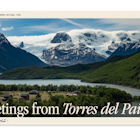
Feb 7, 2023 • 5 min read
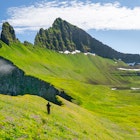
Dec 6, 2022 • 10 min read
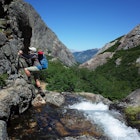
Nov 28, 2022 • 6 min read
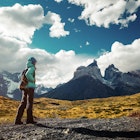
Oct 5, 2022 • 6 min read
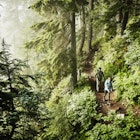
Jul 29, 2022 • 15 min read

Dec 13, 2021 • 11 min read
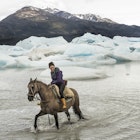
Dec 3, 2021 • 10 min read
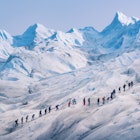
Oct 28, 2021 • 6 min read
Spark Nomad
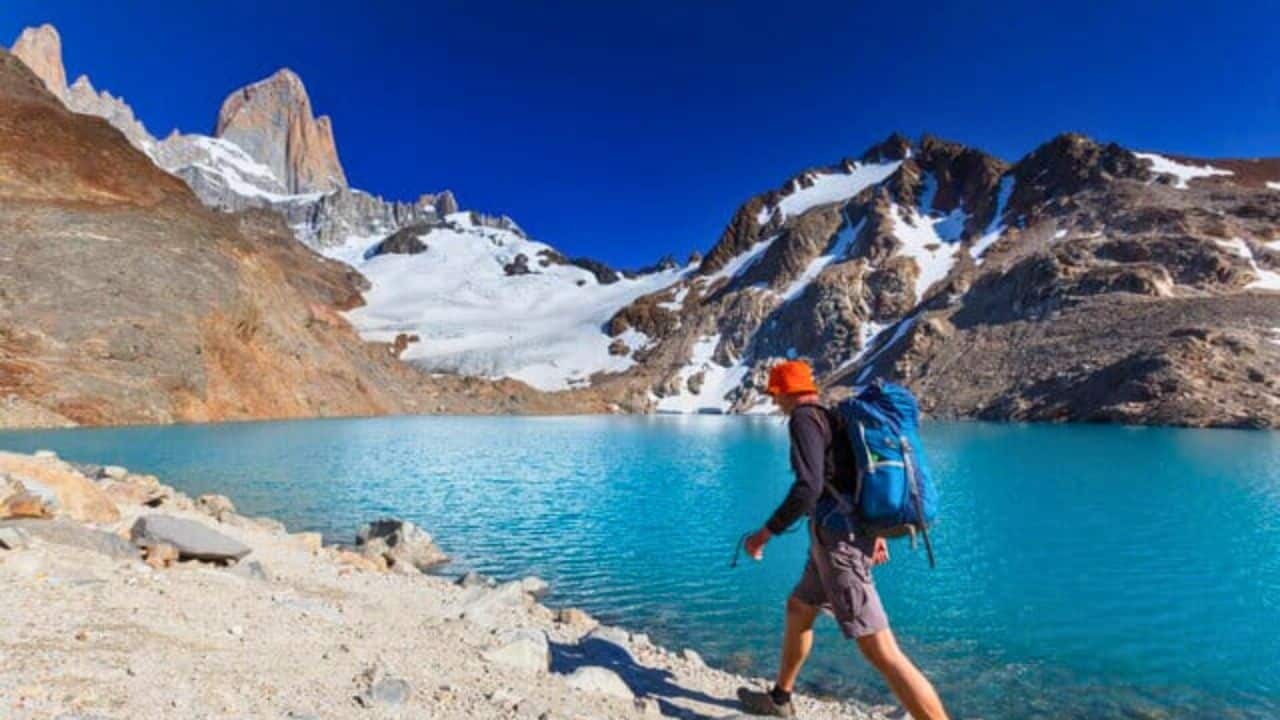
The Ultimate Patagonia Hiking Guide: Explore the Best Trails and Landscapes
Can’t make up your mind about where to hike in Patagonia? The region’s numerous world-class trails live up to its reputation as a trekker’s paradise. Here are our favorite trails for a unique and breathtaking Patagonia hiking experience.
Patagonia is a vast natural landscape in the southern tip of South America with unique flora and fauna and distinctive history and culture. Apart from its diverse wildlife, the region has some of the best scenic and breathtaking landscapes, ranking Patagonia among the top spots for outdoor enthusiasts and tourists.
One of the ways through which people explore the scenic beauty of this place is through hiking. Today’s blog will explore the 15 best hiking trails this landscape offers.
Table of Contents
Best Hikes in Patagonia – Chilean Patagonia
1. volcán chaitén .
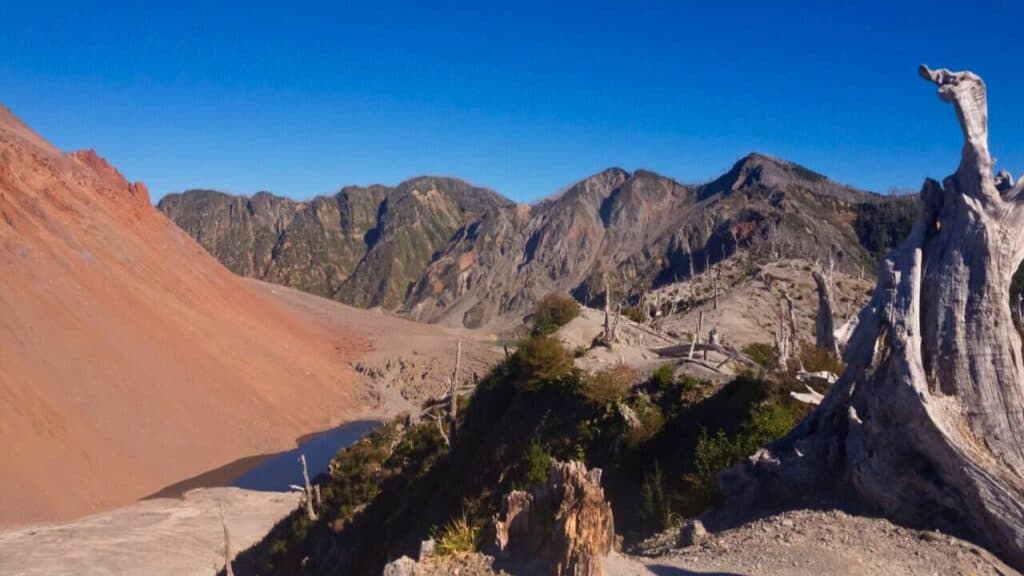
Volcán Chaitén, an active stratovolcano in southern Chile, is a fountain of liquid magma in the Andes mountain range, close to Argentina. It has an elevation of 8,750 feet (2,671 meters) above sea level.
Hikers should not miss the opportunity to climb Chaitén in southern Los Rios. It is a popular activity owing to the breathtaking Andes and Chaitén River panoramas. A well-known destination on the to-do list of explorers and hikers, this crater trail follows the lava path of the 2008 eruption; it provides astonishing perspectives of the volcanic landscape.
Considered a difficult yet rewarding climb, this trail, which is around 7 miles (11 kilometers) round trip, takes 5 to 6 hours. Chaitén is an active volcano; explorers and climbers should know the updated advisories about this destination.
2. Pumalin National Park
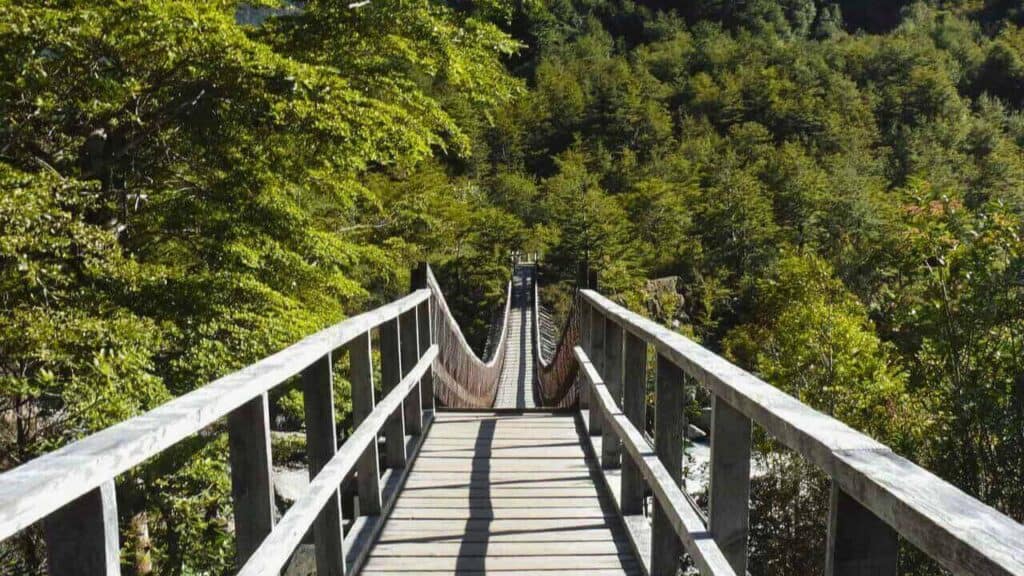
Located in Chilean Patagonia, Pumalin Douglas Tompkins National Park is a vast nature reserve in the Palena province of the Los Lagos region. With an area of 994,331 acres (402,392 hectares), the park has 11 easy-to-follow and well-marked hiking trails, allowing hikers to explore this mesmerizing landscape.
A sanctuary for those who appreciate the great outdoors, the entrance to the nature reserve is free. It offers unique and diverse flora and fauna to visitors from all over the world. You can find abundant wildlife, such as pumas, guanacos, and Chilean flamingos, at the Pumalin National Park, an excellent spot to visit if you enjoy nature and watching birds.
3. Tierra del Fuego National Park
The Tierra del Fuego National Park , located at the southernmost tip of Argentina, offers hikers an incredible adventure through Patagonia’s stunning landscape. The park covers over 240 square miles (622 square kilometers) and features a diverse range of terrain, including snow-capped mountains, lush forests, and crystal-clear lakes. Visitors can take advantage of the park’s well-maintained hiking trails, which range from easy walks to challenging treks.
Hikers can immerse themselves in the region’s natural beauty while spotting wildlife such as guanacos, foxes, and beavers. The park’s most famous trek is the Coastal Path, which offers breathtaking views of the Beagle Channel and passes through the famous Lapataia Bay. With its unparalleled scenery and diverse wildlife, Tierra del Fuego National Park is a must-visit destination for hikers exploring Patagonia .
4. Sendero Alerce Andino
This moderate trail in Alerce Andino National Park near Puerto Montt in Los Lagos takes hikers through a forest of large Alerce (Fitzroya) trees, some over 3,000 years old.
Approximately 3-4 hours are required to traverse the entire loop of this trail, which is about 5 mi (8 km) in length and offers beautiful views of the surrounding landscape.
5. Sendero Cascadas Escondidas
Surrounded by verdant rainforest, the Hidden Waterfalls trail is a 2.2-mile (3.5 km) trek that would take about 1.5 to two hours within the Pumalín National Park.
Pause and immerse yourself in nature in the two viewpoints that seem to overlook two seemingly hidden waterfalls in the middle of the forest.
6. The Glacier Viewpoint Trail
The Glacier Viewpoint Trail is a popular hike in Chilean Patagonia’s Pumalín National Park. This trail takes you through lush forests and scenic river valleys, leading to a stunning view of the park’s glaciers. This hike is approximately 4 mi (6.4 km) round trip and takes approximately 2 to 3 hours to complete.
The trail is considered easy to moderate in difficulty, making it a great option for hikers of all levels. Along the way, you’ll have the chance to stop and take in the stunning views, snap some photos, and appreciate the tranquility of the surrounding wilderness. It’s important to come prepared with the right gear and supplies and to follow all necessary safety precautions.
7. Laguna de Los Témpanos
Hiking the 2.5-mi (4 km) round trip to Laguna de Los Témpanos (Lagoon of the Icebergs) in the Aysen region near Puyuhuapi is a viable choice for hikers of varying fitness levels. The Queulat National Park provides a stunning backdrop for your journey, with its towering trees and untouched landscapes creating an environment of calm and serenity.
The crystal-clear waters of the Laguna de Los Témpanos, which receives the meltwater of the glaciers, are one of its main attractions. The lagoon supports a wide range of exotic and fascinating aquatic life. The sparkling water and towering peaks provide a wonderfully stunning backdrop for seeing these critters and the surrounding area as you wander along the lake’s edge.
8. Dientes de Navarino Circuit
The Dientes de Navarino Circuit, dubbed by Lonely Planet “the southernmost trek in the world,” is in southern Chile’s Navarino Island near Tierra del Fuego Island. Notable for its stunning vistas of the surrounding glaciers, the circuit will give you a front-row seat to these breathtaking sights, with the sparkling ice- and snow-capped peaks as a backdrop.
It will take 5 to 7 days to complete the 33-mile (53 km) trail. This circuit is considered one of Patagonia’s most exciting and gratifying hikes due to the wide variety of views you’ll experience along the way.
9. Piedra del Aguila
Hiking up the Piedra del Aguila trail in Futaleufu, Los Lagos, Chilean Patagonia, is an unforgettable experience. From the center of Futaleufu, the trek involves a round-trip distance of about 5 mi (8 km) and should take about 4 hours and 45 minutes. Some parts of the trail are quite steep, making the overall difficulty of the trek moderate. But the stunning panoramas of nature are well worth the work.
This one-of-a-kind path leads to the top of Eagle’s Rock, an impressive granite rock structure from which you can take in breathtaking views. The hike’s highlights include sparkling lakes, snow-capped mountains, and verdant forests.
Best Hikes in Patagonia – Chile’s Torres Del Paine National Park
Torres del Paine is a national park in the Patagonia district of Chile. There are a few climbing trails accessible in Torres del Paine, going from simple strolls to additional difficult trips. Perhaps the most famous trails in the region are the W Trek and the O Circuit.
10. The ‘W’ Trek
The W Trek spans around 50 mi (80 km) and takes four to five days of hiking. Trekkers should have some hiking experience and be in decent physical shape, as this is a moderate to tough journey. While the track is well-marked and well-maintained, hikers should still pack for all eventualities, including possible sudden weather changes, by bringing enough food, water, shelter, and warm clothing.
While the park is accessible throughout the year, check the weather forecasts before heading out, as the weather can change instantly and without warning.
11. The ‘O’ Trek
Also known as the Full Circuit, the O Trek is a longer, more strenuous hike that takes about eight to eleven days to complete. The Circuit covers over 75 mi (120 km) and takes hikers on a loop around the park, offering a more comprehensive experience of the park’s beauty.
Hikers can expect to observe a wide range of local flora and fauna on their journey, from birds like the Andean condor to mammals like the guanaco and puma. The park is also home to various native tree species, notably the ire, a beech tree that has adapted to the arid conditions of the Patagonian Andes.
Best Hikes in Patagonia – Argentine Patagonia
Argentine Patagonia is a hiker’s paradise, offering a variety of trails to explore. Many options exist, whether for an easy day hike or a multi-day backpacking trip. Here are some of the best hikes in Argentine Patagonia:
12. Perito Moreno Glacier

The Perito Moreno Glacier , situated in Argentina’s Santa Cruz province within the Los Glaciares National Park, measures 19 mi (30 km) and 3 miles (5 km) in length. Hiking the glacier typically takes approximately 12 hours, making it a full-day activity. Despite its challenging terrain, including steep sections, the trail is still manageable for hikers of various skill levels.
For a more immersive experience, visitors can opt for the Big Ice Tour , which takes them deep into the glacier. The tour departs from El Calafate and involves sailing across the stunningly blue Lago Argentino before disembarking on the glacier.
Visitors will be provided with crampons and led by expert guides, allowing them to explore the glacier’s interior, including deep crevasses, caves, and underground lagoons. It’s worth noting that this tour is recommended only for physically fit people.
13. Cerro Chaltén
One of Argentina’s more popular hiking trails, Cerro Chaltén offers spectacular views of Mount Fitz Roy along its 5 mi (8 km) course. It’s a relatively easy hike and can be completed in 4 to 6 hours, depending on your pace.
14. Laguna de Los Tres/Mount Fitz Roy
Another popular trail, Laguna de Los Tres , follows a 13.5 mi (22 km) route around the Fitz Roy mountain range. It culminates with stunning views of a breathtaking glacial lake in the heart of Argentine Patagonia, making it one of the most beautiful natural attractions in the region.
The entire journey takes anywhere from 7 to 10 hours, depending on how long you stop to enjoy the scenery. Visitors to Laguna de Los Tres can embark on a challenging hike to reach the lake, which typically takes several hours. The hike is considered moderate to difficult, with steep inclines and rocky terrain, but the stunning views along the way make it well worth the effort.
15. Nahuel Huapi National Park

The city of Bariloche is a charming Swiss alpine hamlet with numerous first-rate trekking opportunities. With its rugged peaks and abundance of pristine mountain lagoons, the adjacent Nahuel Huapi National Park is considered a hiking paradise and one of Argentina’s greatest parks for the adventurous.
A four-day tour will take you through a secluded section of the national park, with stunning views of the region’s glittering lakes (it is, after all, part of the Argentine Lakes District), picture-perfect volcanoes, and the forest-fringed slopes that define this area of Patagonia.
Best Time to Hike in Patagonia
The best time to hike in Patagonia is spring or fall. During this period, the weather is milder and more pleasant for hiking, with temperatures ranging between 50-68 degrees Fahrenheit (10-20 degrees Celsius).
The skies are generally clear and sunny during these months, making it ideal for taking in the breathtaking views of the diverse terrain. In addition, there are fewer crowds during spring and fall, so you can enjoy your hike without worrying about other trail hikers.
When planning a hike in Patagonia, it’s best to check local weather forecasts beforehand, as conditions can change quickly. Additionally, multi-day backpacking trips can provide an unforgettable trekking experience through some of the most remote regions.
Equipment and Things to Pack For a Hike in Patagonia
When packing for a hike in Patagonia, you should pack light. You’ll have to carry whatever you bring, so don’t bring anything unnecessary.
- Hiking clothes. It can become very warm during the day, depending on the time of year you visit.
- Hiking shoes and rain clothes
- Sun protection
- Basic first aid kit
- Some snacks and water bottles
- A little cash in case of emergency
- Waterproof bag to keep valuable items
- A plastic bag for trash, as you’d want to take all your trash with you when hiking
How To Stay Safe During Your Hike In Patagonia?
When hiking the trails of Patagonia, it’s essential to stay safe by always carrying a map and a reliable GPS device to avoid getting lost in the vast wilderness. Dress in layers to adapt to the rapidly changing weather, and make sure to inform someone of your hiking plan and expected return time. These precautions will help ensure a safe and enjoyable adventure in the breathtaking landscapes of Patagonia.
Additionally, consider protecting yourself with travel insurance such as SafetyWing , which can cover medical emergencies, trip cancellations, and other unforeseen incidents during your stay. Use the widget below to snag the perfect policy for your needs and travel with peace of mind knowing you’ve got your back covered, no matter what adventures come your way!
Frequently Asked Questions (FAQs) – Patagonia Hiking
How hard is it to hike in patagonia .
Hiking in Patagonia varies from trek to trek. There are treks like the Tierra del Fuego National Park and Perito Moreno Glacier, which are family-friendly and easy to hike. There are also treks like the W and the O Circuit, which take days to hike and require good physical condition to be completed.
Is Hiking Patagonia Worth It?
We would say, “Yes, it is worth it!” Patagonia hiking offers you the most scenic and beautiful landscapes on the planet. Also, the region’s flora and fauna are endemic and cannot be found anywhere in the world.
Is Hiking in Patagonia Safe?
Yes, hiking in Patagonia is definitely worth it. Patagonia hiking offers you the most scenic and beautiful landscapes on the planet. Also, the region’s flora and fauna are endemic and cannot be found anywhere in the world.
Where Is the Best Hiking in Patagonia?
The best hiking trails of Patagonia include the W Ttrek, the O Trek circuit, the Laguna de Los Tres, the Volcán Chaitén, and Pumalín National Park.
Conclusion – Patagonia Hiking
If you want to be awed by the vastness and wonder of raw nature at its best, you shouldn’t miss out on a Patagonia hiking adventure. As the hikes listed above are all unique and memorable, there is no one best trail: only wonderful experiences that largely depend on your own preferences (and stamina) as a trekker.
Regardless of your chosen trails, remember to take your trash and leave the place better than you found it. Contributing to preserving and protecting one of the planet’s natural wonderlands.
Your Ultimate Travel Guide & Booking Resources
Skyscanner is my trusted ally for booking flights, guiding me to the perfect travel options while making the journey planning process a breeze with its user-friendly interface and extensive search capabilities.
12Go Asia is my ultimate travel companion in Asia, offering the best budget service platform for seamless booking of trains, buses, ferries, and flights, ensuring every adventure unfolds smoothly and effortlessly.
Booking.com is my ultimate lodging partner. It offers many accommodations worldwide and simplifies my travel experiences with its user-friendly platform and unbeatable deals.
Get Your Guide is my go-to for personalized travel experiences, enriching my journeys with unique tours and activities curated to my interests, making every adventure unforgettable and tailored to my preferences.
SafetyWing is my peace of mind on the go, offering comprehensive travel medical insurance with affordable plans and hassle-free claims, ensuring I can explore the world worry-free, knowing I’m protected wherever I roam.
LifeStraw Go Bottle is my trusted hydration companion for outdoor adventures, filtering water on-the-go to keep me safe and hydrated, ensuring every hike or travel experience is worry-free and enjoyable.
Related reads:
- 30 Best Argentina Gifts You Can Buy On Amazon – For All Occasions!
- A Guide To 21 Exciting Things To Do in Punta Arenas Chile
Founder of Spark Nomad, Radical FIRE, Copywriter
Expertise: Personal finance and travel content. I’m a full-time traveler, and I’ve been to 49 countries and 5 continents. Education: Bachelor of Economics at Radboud University, Master in Finance at Radboud University, Minor in Economics at Chapman University. Over 200 articles, essays, and short stories published across the web.
Marjolein Dilven is a journalist and founder of Spark Nomad, a travel platform, and Radical FIRE, a personal finance platform. Marjolein has a finance and economics background with a master’s in Finance. She has quit her job to travel the world, documenting her travels on Spark Nomad to help people plan their travels. Marjolein Dilven has written for publications like MSN, Associated Press, CNBC, Town News syndicate, and more.
- Skip to primary navigation
- Skip to main content
- Skip to primary sidebar
- Skip to footer

The Opinionated Travelogue of a Photo Maniac
- Middle East
- North America
- South America
- Pacific Islands
- FOOD & WINE
- TRAVEL GUIDES
- TRAVEL RESOURCES
- Rants & Raves
- Travel Blogger Interviews
- Contact Form
- Privacy Policy
- Featured Elsewhere
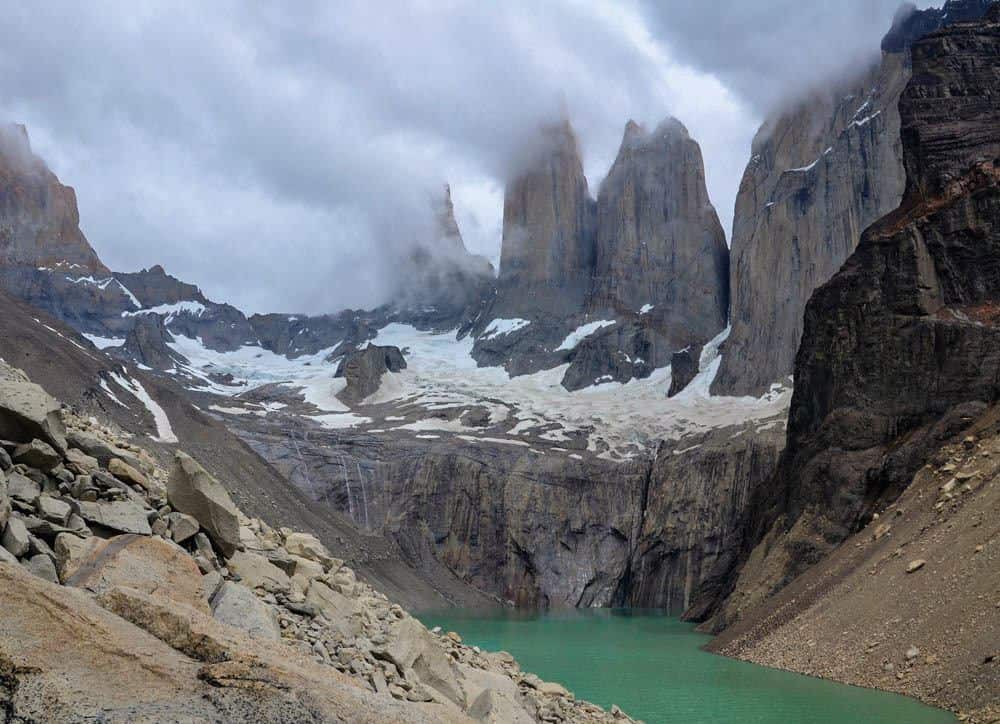
Essential Guide for Planning a Hiking Trip in Patagonia
Last Modified: April 12, 2023 // by Anda // 58 Comments
Hiking in Patagonia is breathtakingly beautiful and exciting! This vast, wild region at the tip of South America is a place like no other, and once you see it you’ll understand why. Massive glaciers, jagged granite peaks, azure lakes, roaring waterfalls, and sublime flower fields. Tall mountain peaks and huge swatches of scrubland, dotted with roaming guanacos, lamas and ñandús.
There are not many places in the world where you will fill a deeper connection with nature and witness its tremendous power. There is a reason why hikers from all around the world consider hiking in Patagonia an experience of a lifetime. But the land of massive glaciers and azure lake is as wild as it is beautiful. Therefore, in order to have a great time here, there are a few things that you should know BEFORE planning your hiking trip to Patagonia.
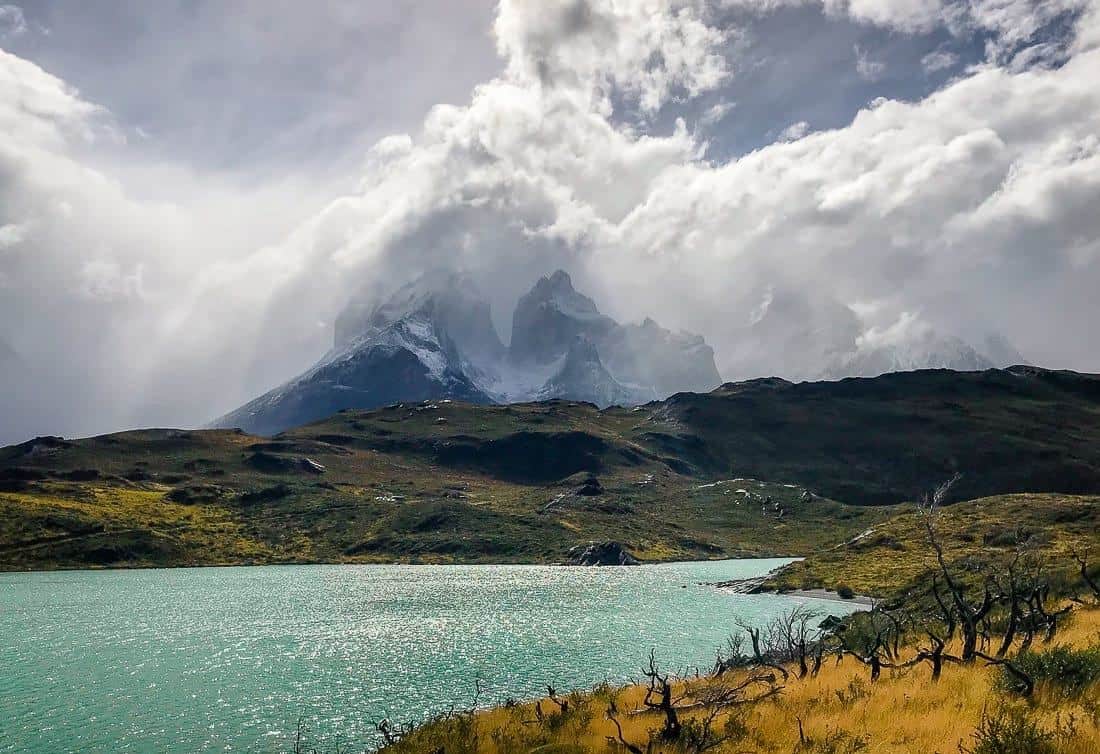
Table of Contents
Hiking the Chillian Patagonia
Hiking the argentinean patagonia, best time to hike in patagonia, multi-day treks vs. day hikes in patagonia, how difficult are the hikes in patagonia, tips for hiking in patagonia, the bottom line, where to hike in patagonia.
Patagonia straddles two countries, divided by the Andes Mountains: Chile and Argentina. The Chilean side of Patagonia brags about the famous Torres del Paine National Park , while the Argentinean side boasts the stunning Mount Fitz Roy and Perito Moreno Glacier.
Some of the best hikes in Patagonia are in Chille’s Torres del Paine National Park , which is acknowledged as one the most spectacular places to see in South America, home to fantastic trails and treks, like the epic Torres del Paine W Trek.
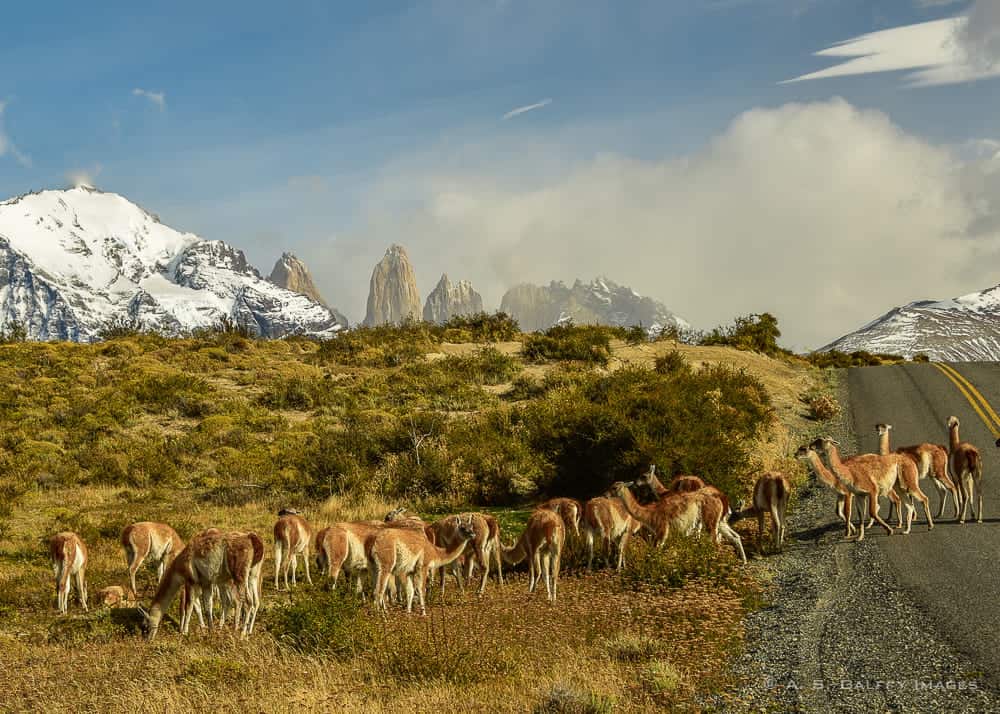
But Argentinean Patagonia is also home to unbelievably beautiful trails and tracks, like the hike to Laguna de Los Tres and Mount Fitz Roy . There are several world famous treks that start in El Chalten. Some of these hikes are quite easy and can be attempted even by families with small children. Others are longer and more difficult and present a challenge even for the more seasoned hikers.
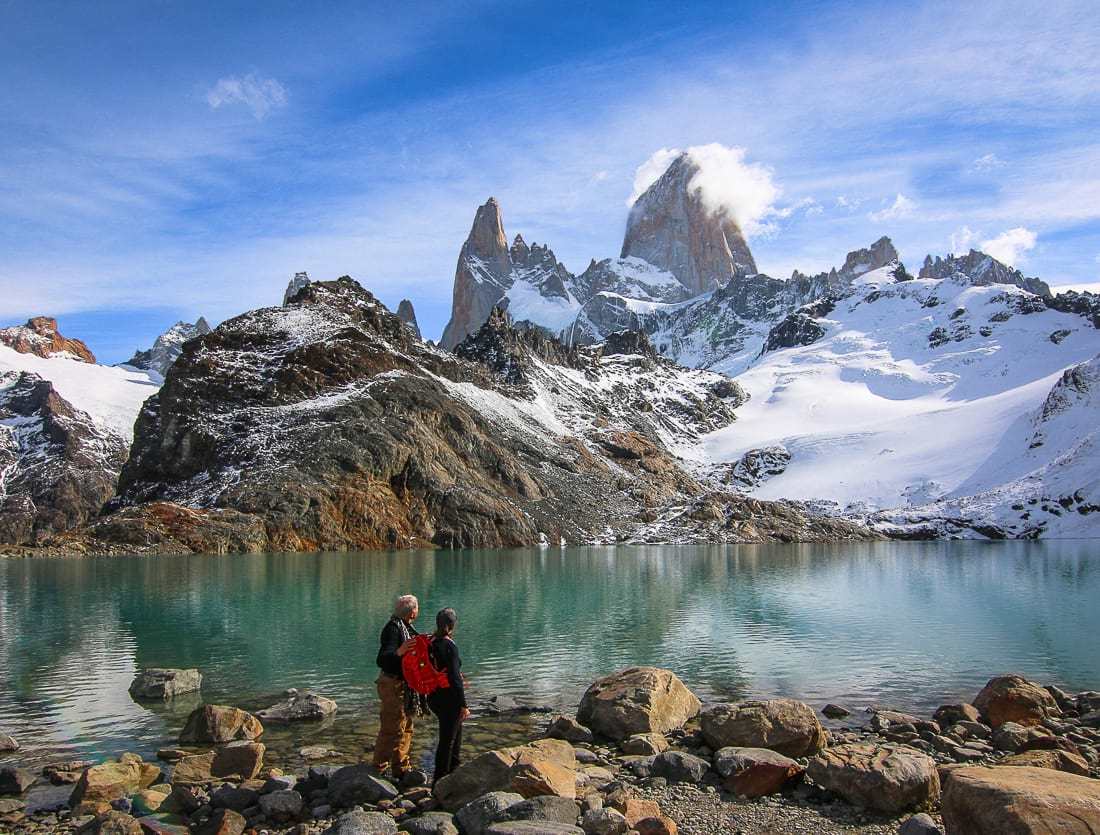
Climate in Patagonia is pretty strange. The weather may go from one extreme to the other in less than a couple of hours. You can pretty much count on very strong winds, rain, mud, and sometimes snow at any time of year. Deciding what would be the best time for you depends on your preferences, expectations and budget.
The weather is not as stable as in summer, but it’s still nice and the park is not yet full. This is one of the two shoulder seasons when you may get better prices and still have a pretty good chance for good weather.
The best tie for hiking in Patagonia. Warmer weather and less less rain, but very strong winds. Temperatures are in the mid 50s F to low 60s F. Summer the busiest season of the year and most places in Patagonia are full to capacity.
Temperatures are cooler than in summer, but there is generally less wind. The weather is still great for hiking. You may experience more rain and possibly snow. Best time for hiking because the great fall colors. Less crowds and lower prices.
The weather is cold and very unstable. Trails are closed because of the harsh conditions. Refugios and campgrounds are closed and so are most hotels in Torres del Paine and El Chalten. Great time for seeing the Southern Lights.
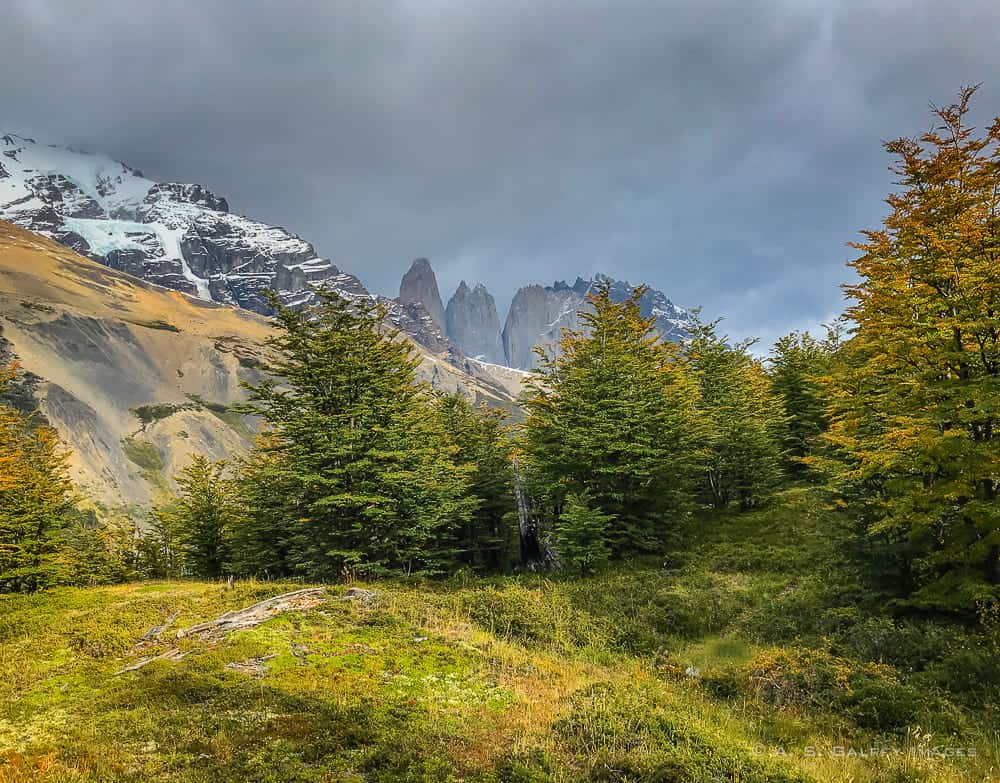
Trekking in Patagonia requires athleticism, endurance and a spirit of adventure. Doing one of the circuits in Torres del Paine can take anywhere from 4 to 8 days and is physically very challenging. You hike a lot of miles each day (mostly uphill) on very rocky trails.
At night you sleep in a tent that is exposed to the elements. So whatever weather is out there you will feel it all: wind, rain, snow or sun. Leave alone the horrible food, the bed bugs, and the horrific sewage odor in campsites and refugios.
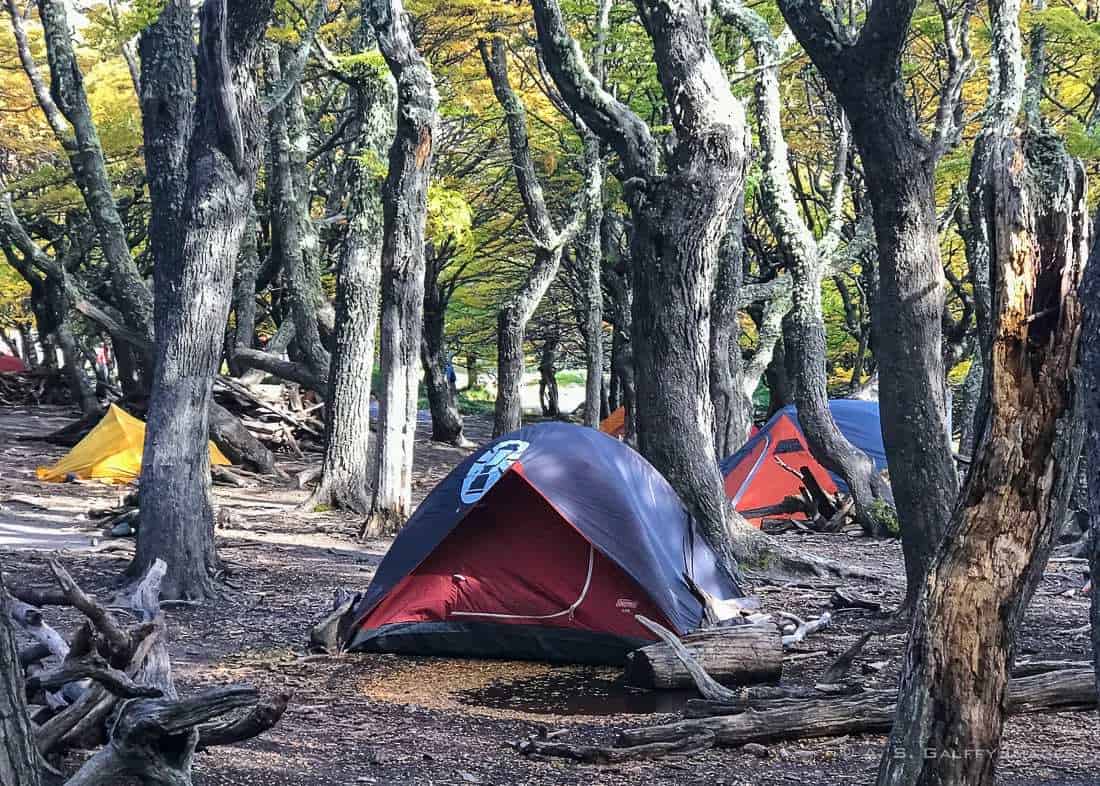
On the other hand, day hikes can be just as beautiful and rewarding. Patagonia is a maze of hiking trails varying from easy, to moderate and more difficult.
If you have no interest in carrying a huge backpack and setting up a tent in the Patagonian wind, you have the option of staying in a nice hotel room and doing day trips. I just need to mention however that this option is more costly.
Trekking or hiking in Patagonia is no walk in the park. Especially if you want to do one of the circuits in Torres del Paine. It’s not the technical difficulty of the hike or the altitude that makes it seem strenuous. It’s the length of the trails, the moodiness of the Patagonian weather, and the weight of your rucksack that will drain your strength.
That doesn’t mean that hiking in Patagonia is only for the pros or the extreme adventure seekers. In fact, thousands entry level backpackers and trackers hike every year in Chilean and Argentinian Patagonia. But it certainly helps to have some hiking experience under your belt before you venture here.
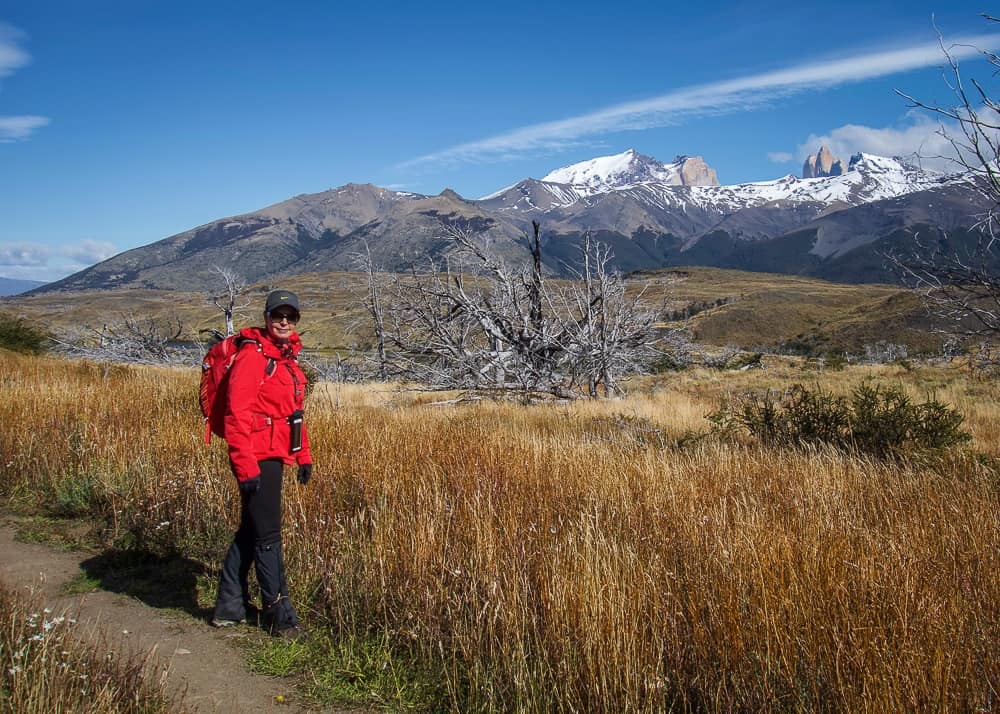
Hiking in Patagonia is doable even for people with an average level of fitness. Depending on the trails you choose, you may need more or less experience. We had a more difficult time hiking the Kalalau Trail , in Kauai, that hiking most of the trails in Patagonia. Trails in Patagonia vary from easy to moderate and more difficult.
You can choose from guided to self-guided tours, but you don’t really need a guide for hiking in Patagonia. Also, unlike the Everest Base Camp where you’ll need a permit for trekking, you won’t need any license or permit for hiking in Patagonia.
Trails are marked and well maintained, so and it’s practically impossible to get lost. In Torres del Paine there are also ranger stations or campgrounds every few hiking hours.
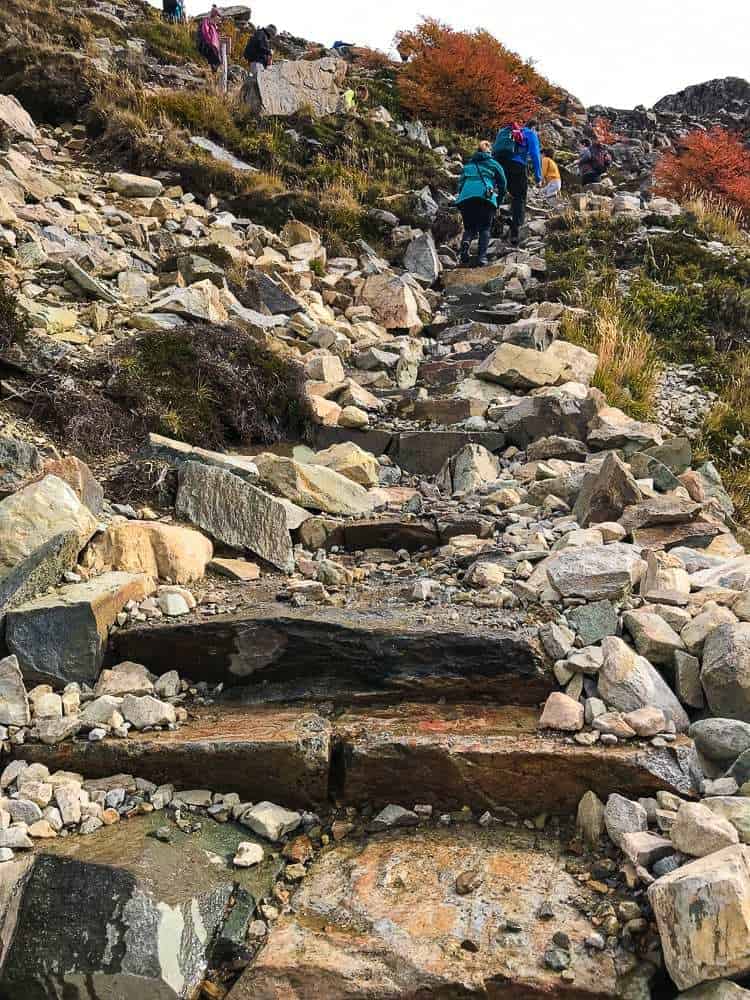
One thing to keep in mind when hiking in Patagonia is the weather. While it’s true that Patagonian weather may change in the blink of an eye, there are still good short term predictions that may help you decide whether to start on an easier or more difficult hike.
Always dress in layers, no matter how the weather looks like. You will constantly be taking off and putting on clothes. I promise you that!
Carry a light backpack if you plan to do day hikes. Some tracks may be quite challenging and the weight of your backpack may drain your strength.
There is plenty of clean water all around in Patagonia, so you can fill your bottle from any stream. Just make sure you bring a refillable bottle with you on the trek.
There is no set way to hiking in Patagonia. Some choose the rough and spartan trekking experience of the circuits and have no problem of sleeping in tents or Refugios. Others, like me, prefer to do day trips and sleep in the comfort of a hotel room at night.
Each route is unique and beautiful, which makes hiking in Patagonia a great experience for everyone attempting it. And this couldn’t be more obvious then when you see the wide diversity of tourists in the region.
READ NEXT: Patagonia packing guide for lots of useful information on what to pack for your trip to Patagonia
Did you find this information useful? Pin it to help other travelers to Patagonia
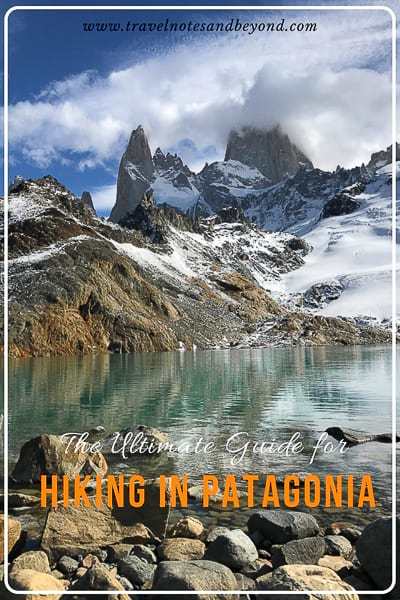
Anda is an award winning travel writer, avid globetrotter and passionate photographer. She is the voice behind "Travel Notes & Beyond," a collection of stories and travel impressions from her wanderings around the world. When she is not busy writing, traveling, or editing photographs, you can find her hiking in the foothills behind her house together with her husband and their dog.
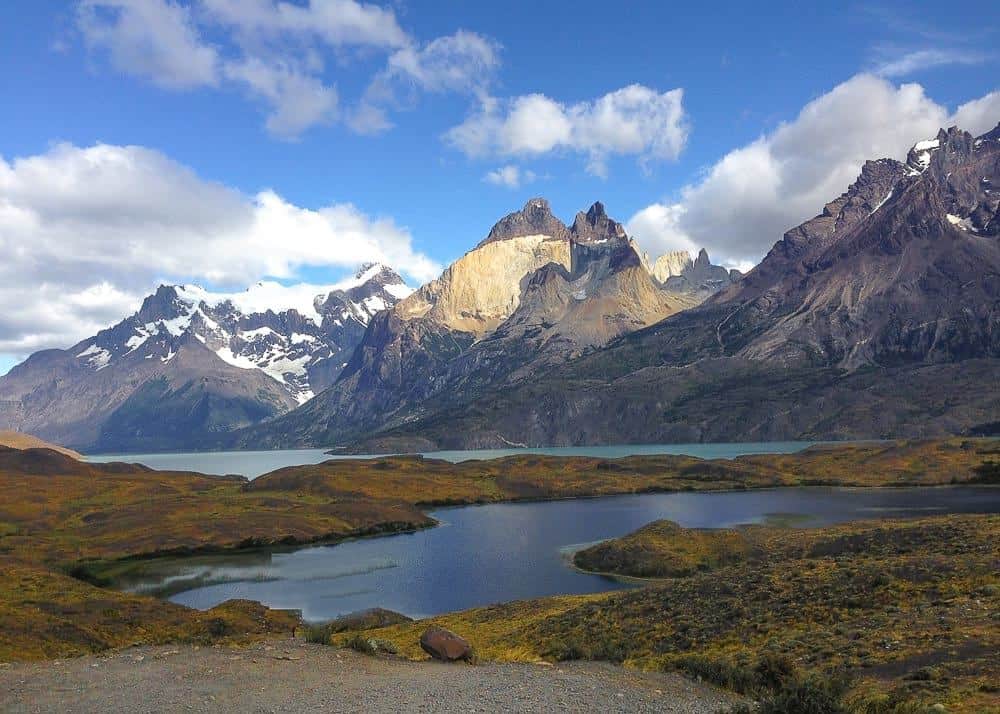
Reader Interactions
March 23, 2019 at 11:21 am
I love the photo of the alpacas crossing the road! This is a great comprehensive guide to Patagonia. I appreciate that you are blunt and educate your readers that the trails are not for everyone. It’s definitely not a beginner’s hike. This is definitely on my bucket list!
March 23, 2019 at 10:08 am
I’m planning a Patagonia trip for early 2020, so your post came at the perfect time! I’ve done some bigger hikes like Mt Kilimanjaro but always with porters and guides, so I’m looking forward to doing a completely self-sufficient hike where I carry all my gear, tents, sleeping bags, etc. Patagonia has been on my list for a while, so I am super excited that I’m finally getting to do this!
March 23, 2019 at 5:53 am
The landscapes in Patagonia are truly spectacular. I love to hike, and although I cannot do anything strenuous due to health reasons now, it is an activity that is very close to my heart. I’m also very much like you and would prefer the day trips and sleep in comfortable hotel rooms. Just reached that age when I need a good clean bathroom and a nice soft bed at the end of a tiring day.
Stuti Shrimali
March 22, 2019 at 8:56 am
Anda, that’s a Wonderful post You have written. Patagonia is so mystique. I am sure you had a lovely time. I would love to do day trek as well for that will give me the opportunity to enjoy the view as well. But if there’s a chance to sleep under the sky, I would happily camp (if there is a possibility).
Anda Galffy
March 22, 2019 at 9:36 am
Patagonia is a Paradise for camping. In fact there are more camp sites and refugios in the National Parks of Patagonia than there are hotels. However, with the weather being very unpredictable and extreme, camping is not an easy task.
March 22, 2019 at 1:10 am
I must say I have not visited this part of the world and have it on my list quite high. With the kids getting older I’m ready to venture out to the South American wilderness and the Hiking in Patagonia is without a doubt topping it. The natural beauty of the area and the wildlife you come across is unparalleled. Live the shot of those deers you have captured. A bit of planning required but the reward are great. Thanks for sharing.
Angelica Kajiwara
March 21, 2019 at 6:42 pm
You are giving me so many dreams for the future. My Littles are 3, 3, and 1, so I think we’d have to do this kid-free and put it on our list for when they’re older. I’m amazed at how much they love hiking already. Can’t wait to experience Patagonia with them.
Jane Dempster-Smith
March 19, 2019 at 1:03 pm
Excellent tips here Anda. We were in Patagonia last year and was astounded by its beauty. We are not experienced hikers but we enjoyed many of the smaller day hikes. The beauty of Mount Fitz Roy is well worth the hike to view it. The towns of El Chalten and El Calafate are great places to stay and to use as a base for the hikes. Thanks for sharing your tips.
March 19, 2019 at 4:55 am
We are a family hiker based in Switzerland so yes yes yes Patagonia, eapecially in Torrea del paine is on our hiking list! What an incredible experience! Although the weather changing situation scares me a bit! I wonder also how the area looks like now after the big fire in 2011!
March 19, 2019 at 10:26 am
Patagonia is really beautiful. As for the fire damages, you’ll be surprised how quickly nature regenerates itself. Of course, you can still see the fire traces, but the devastation didn’t take away Torres del Paine’s charm.
Blair villanueva
March 19, 2019 at 1:05 am
I admire those gorgeous landscapes and slopes, your ohotos are like paintings 🙂 I understand how expensive the hotel is, they are so lucky to have this beauty. Where will be you next destination?
June 21, 2018 at 5:17 am
So much natural beauty. Your pictures are like those gorgeous desktops that we have. And the fact that you can explore them all with hikes makes this place even more amazing. Rightly said about the long hikes being tough owing to the unending trails. It takes a lot of patience to keep going in places like this.
Kirstie Saldo
June 20, 2018 at 6:56 pm
Beautiful landscape! Even a person who doesnt enjoy hiking would love to go here! I hope it is okay for a beginner like me!
Anneklien Meanne
June 19, 2018 at 8:52 am
Wow Patagonia has been on my hiking list for a while now and reading your post makes me book my trip very soon! Torres del Paine looks so stunningly beautiful, thats ice capped mountains are so picturesque!
June 19, 2018 at 7:43 am
Personally, I’d love to try a multi-day trek in Torres del Paine for those views! Good to know about the best season to visit as it plays such a big role for experiences like this although it sounds like you need a lot of preparation to endure it.
Personally, I’d love to try a multi-day trek in Torres del Paine for those views! Good to know about the best season to visit as it plays such a big role for experiences like this although it sounds like you need a lot of preparation to endure it. Great photos btw! <3
Sandy N Vyjay
June 19, 2018 at 7:28 am
Trekking Torres del Paineindeed sounds like an experience of a lifetime. The landscapes really look out of the world. Your pictures bring alive the terrain in vivid colour and tempts one to head over there. It is nice to know that though the trek has its challenges it can be done by amateurs as well. Hope to get there someday and experience first-hand the thrill of trekking there. Till then thoroughly enjoyed reading about it here.
Punita Malhotra
June 18, 2018 at 9:09 pm
This post comes at the right time for us, as we are planning a trip to South America this October. That means ‘spring’, as you mention here. Do you have any recommendations for day trip planning? Should we go with a tour operator?
June 18, 2018 at 11:56 pm
You don’t need a tour guide in order to explore Torres del Paine. If you are interested in day trips in this national park, you should read my other posts about Torres del Paine. I have a long list of recommendations regarding how to get to the park as well.
June 17, 2018 at 11:03 pm
Stunning pictures, looks like a great place with good hiking options. The map you added gave a clearer picture of the possible hikes. Long since I stayed in a tent for the night, looks enticing from that point.
Catherine Salvador Mendoza
June 17, 2018 at 10:25 pm
Yep! So useful! I was actually waiting to read that even tho this kind of hike at Torres del Paine is not a walk in the park, could also be friendly for beginners like me. I’ve done mountain climbing, not so high ones, and trekking, you are right that it needs at least a warm up before trekking here. The landscape is extra rewarding but most fav part is sleeping in a tent! Not to mention that different types of elements going to participate such as bugs, etc!lol
June 17, 2018 at 9:38 pm
Actually I was just chatting to my best friend about his trekking experience there because he stayed in the park and dud day treks but found so many people doing the longer ones. He also concurred with the weather and though he was there in December the winds were indeed very strong
Sam (The Scratch Map)
May 13, 2018 at 2:40 pm
Wow, your photos are absolutely stunning! Patagonia has been on our list for a while, in fact after reading this and looking at your pictures it may have jumped a couple of places up the list! I feel I may need to get in better shape to get the best out of a trip here though, but I’m guessing the altitude isn’t much of an issue if it’s mostly sub 3000m?
May 13, 2018 at 6:32 pm
You are right Sam, the altitude is not an issue in Patagonia.
May 9, 2018 at 9:50 pm
Thank you, Anda! I’ve really wanted to visit this part of the world, but always thought there weren’t many day hike options – time to start planning my trip now that I know I don’t have to trek for more than a day! And your pictures are absolutely gorgeous.
May 9, 2018 at 11:55 pm
Thanks for dropping by, Cindy. Always good to hear from you. Yes, Torres del Paine is a wonderful place to visit and you don’t really need to be an experienced hiker in order to have fun there.
Jessica Norah
April 22, 2018 at 9:45 am
Hi Anda, Some great information for those thinking of hiking here! We’ve heard lots of good things about this area. Did you do a circuit or day hikes here? Jessica
April 22, 2018 at 3:42 pm
Just day hikes, Jess. The circuit is brutal. It implies sleeping in a tent or a refugio (just slightly better than a tent) and facing the dreadful Patagonian weather.
April 21, 2018 at 9:21 am
I’m speechless after reading this post. Torres del Paine has gone straight to the top of my travel wish list. I’m a total new person to hiking, but appreciate the information on these routes. I think I’d like to travel there in spring or summer. I know the heat would get to most people, but I’m a sunshine person, and would also love to capture these scenes in the sunlight.
Rhonda Albom
April 21, 2018 at 4:00 am
Those multi-day circuits look quite brutal for a softie like me. I like the idea of day treks and heading back to a comfortable hotel at night. Roughing it in a tent or even a refugio would have been fine 30 years ago. Driving in and back to comfort after a day trek works for me.
April 20, 2018 at 10:57 pm
That really does look like the trip of a lifetime! You captured such stunning photos, I can only imagine how wonderful it must be to see those views with your own eyes. It’s great that you included info on how the different seasons will affect a trek and the very informative trek routes!
April 20, 2018 at 5:46 pm
Wow! I wish I had the courage and endurance to trek Torres del Paine. The views are absolutely stunning and I’m sure very well worth it in the end. It’s crazy how the weather can change within hours and the altitude is another challenge in itself.
April 20, 2018 at 12:53 pm
Such a great post! Ps. I have tried adding the code for the badge to my post three different times (ways) and it’s not working. Is it wordpress compatable? I’ve linked to you just via your website since i couldn’t make the badge work! Lee
April 20, 2018 at 12:31 pm
This is such a great guide. I love when bloggers include the best time to visit. That is so important to me. I haven’t been to Torres del Paine yet but would love to go. I am sure I would have to exercise a little bit before the hike. I am used to high altitude so that wouldn’t be a problem, but still not fit to do large hikes like this. Thank you for sharing, such a good read 🙂
April 20, 2018 at 3:43 pm
Surprisingly enough, altitude is not a problem in Torres del Paine. The length of the trails and the moody weather is, however.
LaiAriel Samangka
April 20, 2018 at 4:20 am
Wow, I’m innately into trekking and camping, and reading this makes me grinning from to ear. I truly love the unassuming beauty of Torres Del Paine. The scenery along the way is breathtakingly stunning. If this would only be just so close to where I am now, I will surely get here by tomorrow. Thank you for providing all the useful tips and guide for this will be a great help for those that are planning to climb Torres Del Paine.
April 18, 2018 at 12:53 pm
Patagonia looks absolutely breathtaking! Thank you for such a detailed post, I would love to go on a hike there.
Stephanie (1AdventureTraveler)
April 17, 2018 at 9:35 am
With beautiful landscapes there, this looks like the ultimate place to hike. The Torres del Paine Southern Patagonia. Your information is spot on and would give me a hiker some choices to make. Seems like one of the many difficulties is the altitude. I would love to hike the circuit. Great information plus a link on what to pack in your bag. Thanks for sharing!
April 17, 2018 at 10:18 am
I think you misunderstood, Stephanie. Altitude is NOT an issue in Torres del Paine. The moody weather on the other had is. Hope you’ll get to hike in Patagonia someday.
Lyn aka The Travelling Lindfields
April 16, 2018 at 4:48 am
I love the idea of multi-day hikes but realistically I think my age, fitness level and health is far more suited to day trekking. This is definitely one for the bucket list.
April 17, 2018 at 10:19 am
I’m with you on that, Lyn. I am no longer at the age of sleeping in tents and enduring rough conditions, hahaha!
Paul and Carole
April 16, 2018 at 1:56 am
Wow what a stunning landscape Patagonia has. This is a really useful post, great detail. Have pinned.
April 14, 2018 at 8:47 pm
Anda, it is great to have insight into this beautiful part of the world. We have Chilean friends and they have invited us many times to their country. The idea is to spend some days in the capital and then move to the southern part of the country. We will love to do that one day. Right now, I am kind of hooked in Europe.
April 14, 2018 at 11:35 pm
I know what you are saying, Ruth. I love Europe too. However, Europe is easy to visit at any age, while Patagonia is a place that will test your endurance. Better go there while you are still young and energetic, lol!
April 14, 2018 at 1:00 pm
Stunning photos as always, Anda – you’ve really inspired me to attempt this one day although I’m so bad with cold weather! I’m a bit confused as to how you did your trip – the trekking routes you mentioned seem to be multi-day treks, so you carry everything with you as you hike from one place to another? But then you also had a car? (Sorry if I’m being a bit thick!)
April 14, 2018 at 3:49 pm
Hi Michelle, sorry for the confusion. We did not camp or stayed in refugios. We just did the day hikes, which means we did parts of the trekking circuits. Staying in a tend in these dreadful weather conditions is way too hard for me. Maybe I would have attempted this if I were 20 years younger, hahaha!
April 14, 2018 at 12:42 am
Beautiful place! I have been dreaming of going to Patagonia forever. I think it is a destination on every hikers bucket list.
April 14, 2018 at 3:50 pm
Patagonia is truly beautiful, but I don’t think I would like to live there. It’s way too remote for me, but some people like it precisely because it is remote.
April 13, 2018 at 1:16 pm
I love you photos! Its a bit hard to read these articles as Torres del Paine is on my bucket list for a long time 🙂 Pinned for later.
April 13, 2018 at 3:03 pm
Thank you, Thomas. I hope you’ll get to see torres del Paine someday. It’s really worth the trouble getting there.
April 13, 2018 at 10:24 am
The mountains — snowy and with jagged peaks behind that — got my attention. Then there’s the lake. And then, best of all — wildlife! It would be a dream to hike here.
April 13, 2018 at 3:05 pm
Indeed, there is a lot of wildlife in Torres del Paine. Those guanacos were as cute as they can be!
April 12, 2018 at 1:58 pm
Yes, apparently the campsites and hostels have limited space, so if you plan to travel during their high season I would recommend booking at least 4-5 months in advance.
April 11, 2018 at 12:20 pm
Amazing detail in your post. The pictures really jump off the page at you. O know want to go here for sure. Looks like one would need to do some fitness training before taking this on
April 11, 2018 at 4:36 pm
Not necessarily, Mark. You can take very easy walks in the park or just do as much as you want. There hikes for all level of fitness. Hope you’ll make it to Patagonia someday. It’s a really beautiful corner of the world.
April 11, 2018 at 4:46 am
This is such a beautiful and incredible place, and one country I’d like to see one day. This hike is probably not for beginners like me, but regardless, I’d like to try! Great tips on the day trips! At least I have a chance to see some of these beautiful sites.
April 10, 2018 at 8:44 pm
The landscape here is extremely gorgeous. I still can’t get over how expensive the hotels are, but I’d definitely like to stay in one since I am a novice hiker.
April 11, 2018 at 4:40 pm
There are hikes for every level in Torres del Paine. Besides, you can go as far as your strength will last, so don’t worry.
Leave a Reply Cancel reply
Your email address will not be published. Required fields are marked *
Save my name, email, and website in this browser for the next time I comment.
COPYRIGHT NOTICE
All rights reserved © Travel Notes & Beyond. The material on this website is protected by copyright law. Republishing the content on this blog (including text, photography, etc.) is strictly prohibited.

AFFILIATE PROGRAM DISCLOSURE
Some of the pages and posts of this blog contain links to products and services that may be useful for my readers. When clicking on these links you will have the option to purchase or register for a service at no extra cost to you, but doing so can help me offset the costs associated with running this blog. Thank you for your support!

Patagonia Backpacking Itineraries For Three Weeks & Beyond
By Author Steph Dyson
Posted on Last updated: 2nd May 2024
As one of the the most adventurous places to visit in South America , Patagonia deserves some serious travel time. Previously on the blog, I outlined four Patagonia travel itineraries for one- or two-week trips , but this time I’m tackling planning a far longer route around this dazzling region.
If a short visit just isn’t enough (believe me, it’s not), then the following Patagonia backpacking itineraries for three weeks and beyond should be more up your street.
Part of the fun of backpacking is to see where the wind takes you; picking and choosing your destinations along the way, on a whim or based upon the travel plans of new companions you meet along the way.
Why do you need to have an itinerary before backpacking in Patagonia?
And while that’s certainly my favourite way of travelling, Patagonia is a slightly different beast for several reasons:
- Travel in Patagonia is expensive. Back in March 2017, a three-week trip to Patagonia, which included hiking the O Circuit in Torres del Paine , renting a car to explore Tierra del Fuego and staying in basic to mid-level accommodation (with some camping thrown in) cost around $592,830 CLP/$900 USD. We could have done the trip cheaper, but this figure should give a sense of how expensive travel actually is.
- During the high-season (December through February) demand for accommodation and transport can exceed supply , meaning that last-minute decisions can leave you in a tight spot, particularly in places like Ushuaia, El Calafate and El Chaltén (Argentina) and Puerto Natales and Punta Arenas (Chile).
- Patagonia is huge ; 402,000 square miles huge. And it’s a region, not a country, so travelling here requires border crossings between Chile and Argentina. What you soon learn is that getting from A to B – particularly when a lot of the information isn’t to be found easily online – requires a serious amount of pre-planning.
Click to navigate this article:
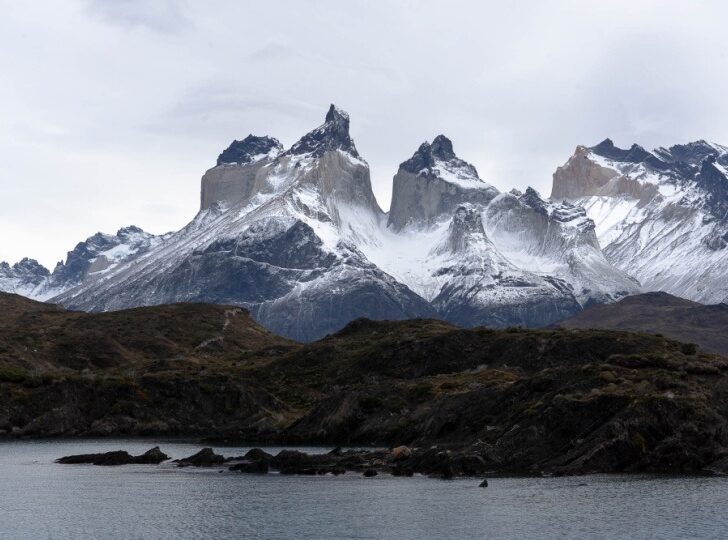
Using these Patagonia backpacking itineraries
These are my top recommendations for backpacking in Patagonia:
- Don’t try and fly from Chile to Argentina. It’s horribly expensive. If you’re not arriving in Patagonia by bus, always fly internally from Santiago or Buenos Aires and then use one of the long-distance (and generally comfortable) buses to cross the border. You will save a lot of cash.
- LATAM (expensive), Sky Airline (cheaper) and Jet Smart (budget) are Chile’s main airlines. Check out their prices on Skyscanner and then book directly. If you book through LATAM’s US site, you pay 4x the price than if you buy it via their Chilean site. It’s in Spanish though, so find someone who can translate.
- Patagonia is probably the safest part of South America. I’ve hitchhiked in Chile without problems and would thoroughly recommend this as a form of transport. (Get tips on hitchhiking in South America here ).
- Car hire is also an interesting and rewarding way of seeing Patagonia, although booking in advance during high season is again recommended. I recommend using Rental Cars and suggest you check out this complete guide to planning a Patagonia road trip for essential tips and tricks.
- The shoulder seasons, October-November and March-April are far quieter – and cheaper – for backpacking in Patagonia. Accommodation and agencies in some towns are sometimes not running in October or April though.
Argentina economy update
The Argentine economy is a huge mess at the moment, with inflation expected to hit 200% this year. Using Argentine pesos can therefore be a nightmare – and mean you lose a lot of money. The blue dollar (an unofficial exchange rate that gives you a better conversion than the official rate) is around, but if you want to avoid carrying lots of cash, you can now pay using your credit card and get an exchange rate similar to the blue dollar rate. You must choose to pay in Argentine pesos (not USD!) to secure this rate.
Both Mastercard and Visa give you what is called the MEP rate, which is almost as good as the blue dollar rate. Mastercard will charge you the official rate but refund you the money a few days later; Visa will charge you the MEP rate from the beginning.
If you do want to have some Argentine pesos for paying in cash (which I highly recommend as you will need them for some restaurants and attractions), it’s best to use Western Union, whereby you send cash to yourself using the Western Union app and then withdraw it in Argentine pesos from one of their branches in Argentina. Bear in mind, those in El Calafate and Ushuaia can run dry of notes, so it can be easiest to do this in Buenos Aires.
Additionally, you can bring USD (unmarked and untorn hundred dollar bills), which you can exchange at “cuevas” (unofficial exchange houses). These will be able to give you the blue dollar rate and any hotel owner will be able to tell you where your nearest one is. Souvenir shops in most parts of the country will be able to give you pesos in exchange for dollar bills – although they might not give you the best rate.
Avoid cash machines. Currently, the maximum withdrawal is the equivalent of $15 USD in Argentine pesos and it will cost you $10 USD in fees.
- Bus schedules vary depending on the season and change year-to-year. Always visit the bus station when you get to a new place to confirm timings and buy tickets for the next leg of your journey. It’s also important to plan additional days into your Patagonia backpacking itinerary in case you can’t travel on the day you had initially intended. For more information about this subject, check out this detailed guide about getting to Patagonia .
- Self-catering is by far the best way of keeping costs down on these Patagonia backpacking itineraries. Where possible, I’ve highlighted the best places to stock up on food. I’ve also written in more detail about visiting Patagonia on a budget .
- However, crossing the border between Argentina and Chile, you cannot take fresh fruit, vegetables, cheese or meat. It will be confiscated and if you don’t own up to it (particularly when heading into Chile), you may be fined.
Patagonia backpacking itineraries for three weeks of travel
Three weeks in Patagonia is the perfect amount of time for undertaking some of Patagonia’s finest hikes : hiking the O Circuit in Torres del Paine National Park , seeing Glacier Perito Moreno, trekking to Laguna de los Tres from El Chaltén, as well as driving to the ends of the Americas or even exploring the highlights of the Carretera Austral – Chilean Patagonia ’s ultimate road or hitchhiking trip.
Planning Your Trip to Patagonia?
Save time, stress & money with a customized travel itinerary planned for you by a Patagonia expert
What previous clients have said:
Steph’s itinerary exceeded all expectations. She provided off-the-beaten-path hikes, great restaurants and accommodations, and very helpful local contacts. Due to the weather, we had to deviate from our original plan, however, Steph quickly responded to our email during the trip with further recommendations. Her service took all the guesswork out of planning our vacation and led to the most fun and unforgettable trip we have ever had!
Patagonia backpacking itinerary for three weeks: Patagonia’s best hikes
Overview of this three-week Patagonia itinerary:
- Day One: Fly from Santiago to Punta Arenas
Day Two: Pack/plan for hiking the O Circuit
Day three: puerto natales.
- Days Four-Twelve: Hike The O Circuit, Torres del Paine National Park
Days Thirteen-Fourteen: El Calafate
- Days Fifteen-Seventeen: El Chaltén, hike Mount Fitz Roy
Days Eighteen-Nineteen: Ushuaia
- Day Twenty: Bus from Ushuaia to Punta Arenas
- Day Twenty-One: Fly from Punta Arenas to Santiago
Few places in South America have quite the same reputation as Patagonia when it comes to hiking.
Trekking in the Patagonian Andes from places such as El Chaltén, on the Argentine side, and in the “Eighth Wonder of the World”, Torres del Paine National Park , is a must-do on any trip to the region.
Luckily, this Patagonia backpacking itinerary covers the best hiking destinations and throws in a humongous glacier and the world’s southernmost city for good measure.
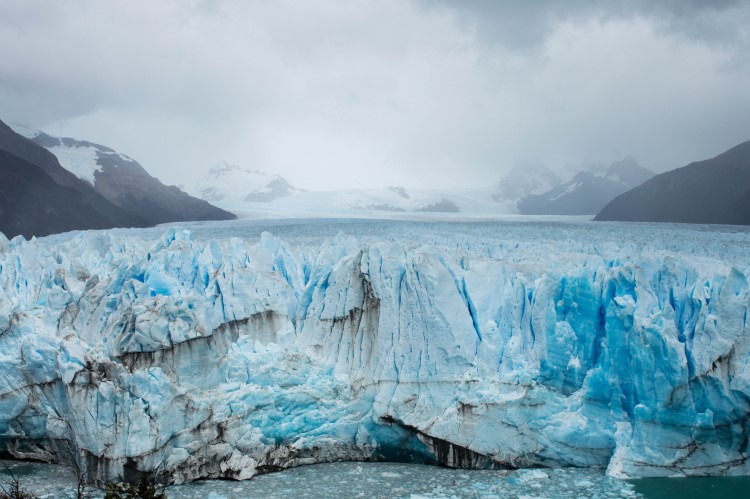
This itinerary assumes that you’ll be starting in Santiago, Chile, mainly because internal flights in this country are cheaper than in Argentina thanks to competition between LATAM and Sky Airlines, the two main carriers.
As with most flights, booking a few months in advance can significantly reduce the cost of flying to Patagonia.
Required equipment for this three-week Patagonia travel itinerary
If you’re looking to travel on a budget in Patagonia or are just open to an adventure ( wild camping is definitely my favourite pastime in South America ), I would recommend you bring camping equipment.
Not only does this reduce the cost of accommodation (which can be very expensive, particularly in the main cities in Patagonia) but it gives you a lot more flexibility, particularly if you plan on hitchhiking or road tripping.
All of my camping gear and recommendations for what exactly you should pack in your rucksack for backpacking through Patagonia is available in my Patagonia packing guide .
Day One: Santiago to Punta Arenas
Fly from Santiago to Punta Arenas in Patagonia with LATAM or Sky Airline (the latter is cheaper) (three hours 35 minutes, four flights per day).
Between December and February, LATAM offers direct flights to Puerto Natales from Santiago (twice weekly, three hours 10 minutes).
Where to eat in Punta Arenas
There’s plenty of excellent steak restaurants in town, including El Fogon De Lalo (Calle 21 de Mayo 1650), where you can try roasted lamb there – an ubiquitous Patagonia dish.
One the smartest restaurant with lovely views across the bay is La Yegua Loca (Fagnano 310). You can also try centolla (king crab – very traditional here) or local dishes such as roasted lamb in lavish settings. It’s also a posh boutique hotel if you fancy treating yourself
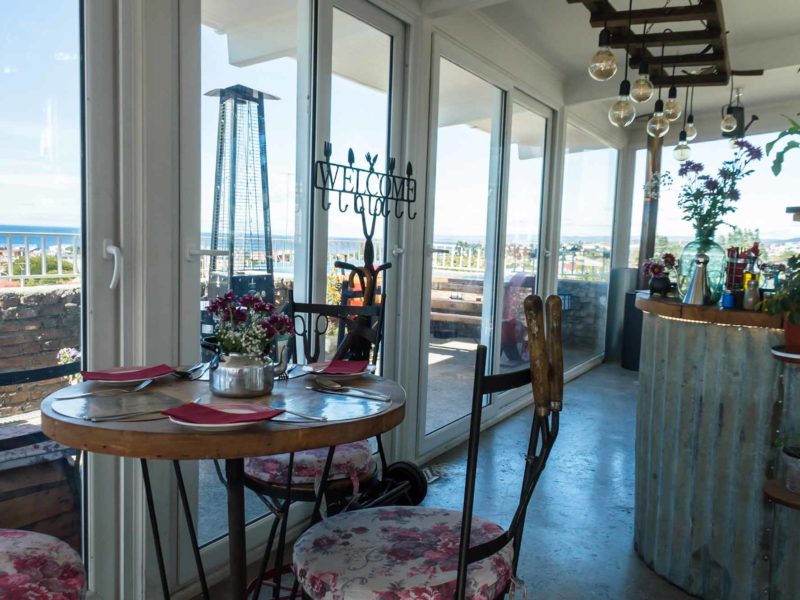
Budget accommodation in Punta Arenas
Providing excellent value and cosy lodgings, Pardo & Shackleton ($37,000 CLP ($43 USD) double) is just five blocks from the Plaza de Armas. Breakfast is very good for the price and there is a large communal kitchen and a vast second floor sitting room.
Mid-range accommodation in Puerto Natales
Set in a grand old stone brick house, the charming eight-room Hotel Lacolet ($50,000 CLP ($58 USD) double) exudes a sense of peacefulness, with a sunny front garden and beautifully furnished bedrooms. Standard doubles can feel a little on the small side; it’s worth the extra cost for a superior with king-sized bed, although bathrooms are small across the board.
High-end accommodation in Puerto Natales
Swedish design-inspired Hotel Ilaia ($94,000 CLP ($110 USD) double) is an oasis of calm only four blocks northwest of the plaza. This serene eight-bed boutique hotel has larger than average bedrooms with equally sizeable king beds, plus slick new bathroom suites.
Breakfast is excellent – there’s no going hungry here – but the real defining feature of the hotel is its beautiful third-floor sitting room, where floor to ceiling windows grant views right across the city. Secure parking is available.
On Day Four, you’ll start hiking the O Circuit in nearby Torres del Paine National Park, so use today to buy your food. The supermarkets in Punta Arenas have more selection and are cheaper than those in Puerto Natales where most backpackers stock up.
Visit the ticket office of a bus company ( Bus-Sur , Buses Pacheco or Buses Fernandez ) and purchase tickets to travel to Puerto Natales tomorrow.
Free time can be spent visiting the Museo Regional de Magallanes (with its history of Patagonia’s indigenous people and the region’s once booming wool trade) or walking up to Mirador Cerro La Cruz for panoramic views of the Strait of Magellan.
Get the bus from Punta Arenas to Puerto Natales (three hours 30 mins). Upon arrival, buy return tickets to Torres del Paine National Park.
If you’ve brought hiking gear with you (plan what you need to bring with this packing checklist for the O Circuit ), you can spend the day visiting the waterfront or just enjoying the town.
If not, visit Rental Natales (you can book online but they are very expensive), Yaghan House (O’Higgins 584; contact them here to reserve; they also have a 12pm daily talk about the park) or Lili Patagonico’s (Arturo Prat 479; you can book online here ) to hire camping gear. The latter two have the cheapest but still good-quality rental gear.
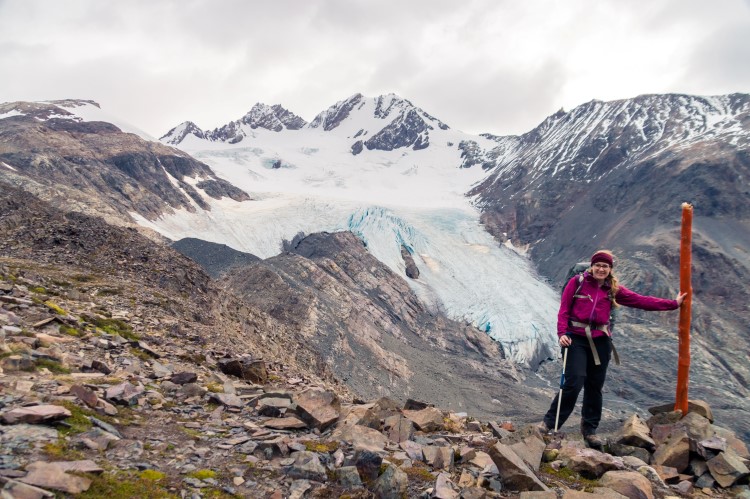
Where to eat in Puerto Natales
There’s plenty of good restaurants in Puerto Natales. For a heary dinner, opt for La Mesita Grande (Arturo Prat 196), a Puerto Natales institution named after the long, communal tables where diners eat together. There pizzas are excellent and many take the names of hiking routes in Torres del Paine, making this a great post-hiking, celebratory dinner type of restaurant!
If you like gin, Last Hope Distillery (Esmeralda 882) has the southernmost gin on the planet and should be selling their first few batches of whisky by now. Cerveza Baguales (Calle Carlos Bories 430) was also Chile’s first brew pub and has some great beers on tap.
Budget accommodation in Puerto Natales
For upmarket lodgings – at very affordable prices – stay at the characterful, vintage-style Vinnhaus ($13,000 dorm ($20 USD), $38,000-$50,000 double ($58 USD-$77 USD), where a 1920s house has been converted into smart, modern accommodation, with a comfortable attached cafe and grassy patio.
Friendly and English-speaking owner Marcela runs a tight ship at the spotless Big Bang ($48,000 ($61 USD) double). Rooms are set around a grassy garden and an ample breakfast of home baked bread, fruit and eggs, is served up each morning. Unfortunately, it can be a little noisy as the wooden floorboards and thin walls means sound carries between the rooms.
High-end acommodation in Puerto Natales
As I found during my stay, sunsets across the Seno Última Esperanza are nothing short of spectacular from the vast windows of Simple Patagonia ($127,000 double ($195 USD)), four kilometers north of Puerto Natales.
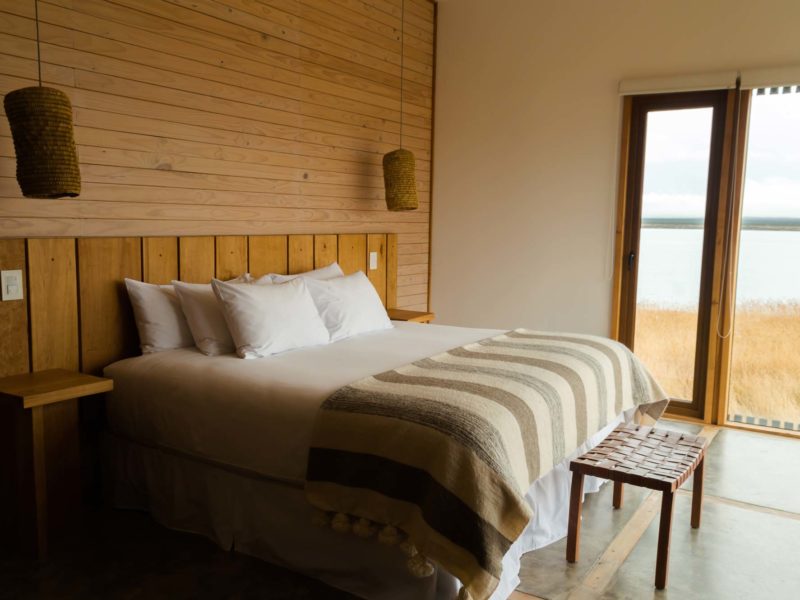
Set within what looks like an original granero (barn), it combines modernity with astonishing views from the bedrooms (eight and 11 have the best) and living and dining area. They also offer up three-course dining in the evening, using local Magellanic ingredients to produce delicious, top-quality dishes.
Days Four-Twelve: The O Circuit, Torres del Paine National Park
At 7:15am, board your bus and travel to Torres del Paine National Park .
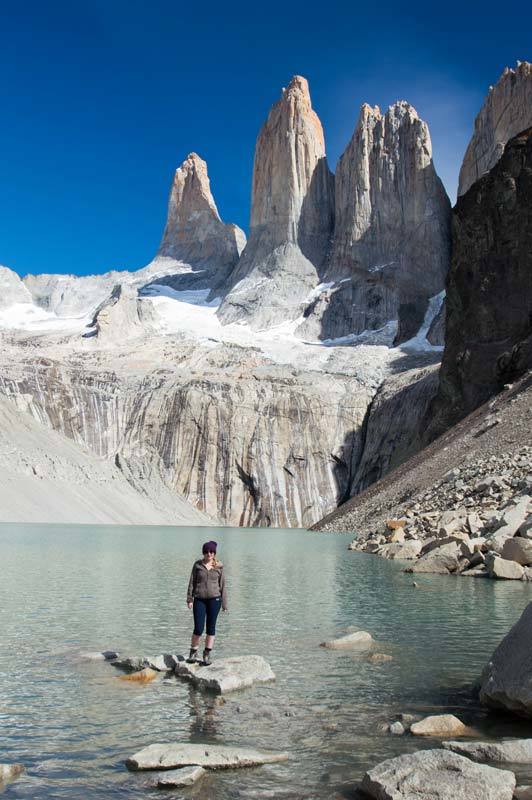
Enjoy nine days of trekking through magical scenery, spotting wildlife such as owls, guanacos and Andean Condors and finishing with the sight of the towers at dawn.
Return to Puerto Natales in the evening of Day Twelve and enjoy a celebratory beer – you’ve earned it!
Read our complete guide to hiking the O Circuit before you begin your planning .
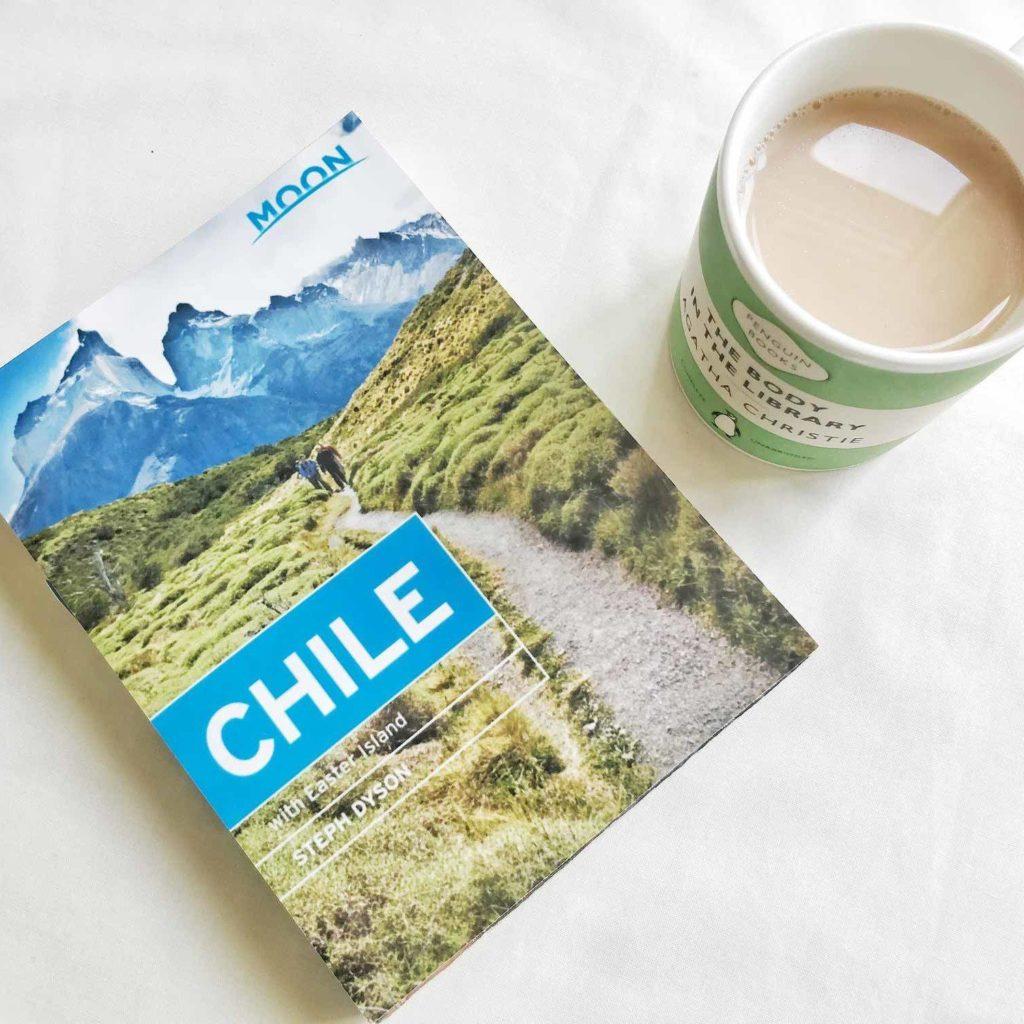
Need more inspiration?
You’ll find even more detailed itineraries, off-the-beaten-path gems, hiking routes and accommodation, restaurant and tour recommendations to suit your travel style in my brand-new guidebook, Moon Chile.
Board the morning bus from the terminal in Puerto Natales to El Calafate (five hours including border crossing).
Check the timetable for buses back to Puerto Natales if you intend on returning to Punta Arenas. Buy return tickets to El Chaltén when you arrive in El Calafate.
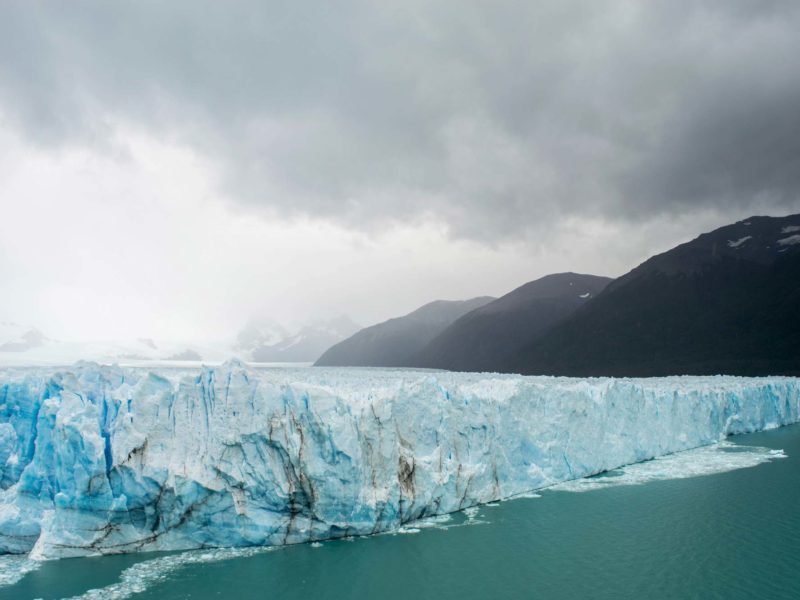
In the afternoon, visit the fascinating Glaciarium , with its range of informative displays, focusing on the Southern Patagonian Ice Field (including the nearby El Perito Moreno glacier ). Downstairs, they even have an ice bar – although visits are limited to 30 minutes!
The next morning, get up early to visit Reserva Laguna Nimez (1km from town) to see over 70 species of birds, including Chilean flamingos.
To explore Glaciar Perito Moreno , rent a taxi for the day (if there are two or more of you) or take the bus from the terminal to Los Glaciares National Park and Glacier Perito Moreno (click for our complete guide) or opt for an ice hiking tour of the glacier .
Park entry is pretty cheap these days ($800 ARS/$12 USD).
Where to eat in El Calafate
For a combination of beautiful lake views and a feast of expertly-roasted Patagonian lamb to die for, don’t miss Parrilla Don Pichon (Calle Puerto Deseado 242).
Another option is La Zaina (Gobernador Gregores 1057). They serve perhaps the best food in El Calafate with refined dishes reflecting Argentine dining, including lots of steaks and Patagonian lamb.
Budget accommodation in El Calafate
Albergue & Hostal del Glaciar Libertador ($18-25 USD dorm, $62 USD double) is one of the best hostels in town, with well-sized doubles and plenty of communal space.
A ten-minute walk or shorter bike ride and located in the converted main buildings of an old estancia , Kau Yatún ($77 USD standard double, $90 superior double) offers hotel facilities in a pretty, rural setting. Parts of the ranch are still in operation and you can take a free tour.
With incredible views of the lake, a good restaurant and indoor swimming pool, Design Suites Calafate ($115 USD double) is the perfect getaway. It’s a 10-minute drive into town (but there’s a shuttle bus for guests, but with access to a couple of short hikes and those views, you’ll be more than content staying on the ground.
Days Fifteen-Seventeen: El Chaltén
Take the bus to El Chaltén (four hours).
There are plenty of hikes to keep you busy for a couple of days, including to Laguna de los Tres and Laguna Torre , both of which offer the best views in town, or even up Mont Fitz Roy, a world’s top 100 travel adventure .
There are also multi-day hikes in the national park. Check out this website for full information about El Chaltén and where to hike in this part of Patagonia.
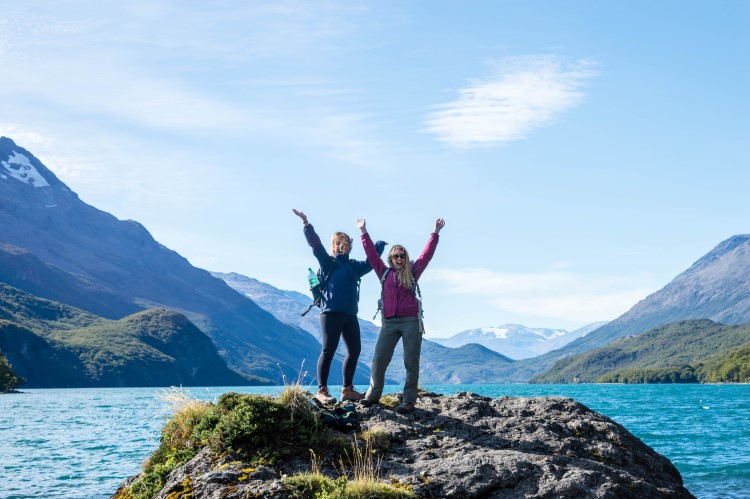
Where to eat in El Chaltén
Off the main road, so offering a great place to escape the crowds, La Ruca Mahuida (Lionel Terray 55) has huge pizzas and calzones that are big enough to share between two. Prices – and food – are superb and they have a beer garden in summer.
You also can’t miss sampling wine in Argentina, so head to the poky La Vinería (Av. Lago de Desierto 265), with really knowledgeable staff and plenty of cheese and meat sharing platters to nibble on as you sip.
If you’re planning on self-catering in El Chaltén, you’ll want to have stocked up in El Calafate, where there is more selection and cheaper prices. There are a small number mini markets around El Chaltén but don’t be surprised if they’re sold out of basics such as bread and eggs.
Budget accommodation in El Chaltén
With a friendly, young vibe, plenty of hot water and a very central location (although, to be fair, El Chaltén isn’t exactly large anyway) Patagonia Travellers’ Hostel ($25 USD dorm, $75-$105 USD double) has great dorms and decent-sized doubles.
Mid-range accommodation in El Chaltén
Offering truly excellent value for money, the friendly and cosy Nothofagus B&B ($49-$65 USD) also has wonderful Monte Fitz Roy views from some of its upstairs rooms. There are also plenty of living spaces around the guesthouse, plus a small cafeteria-style breakfast room downstairs.
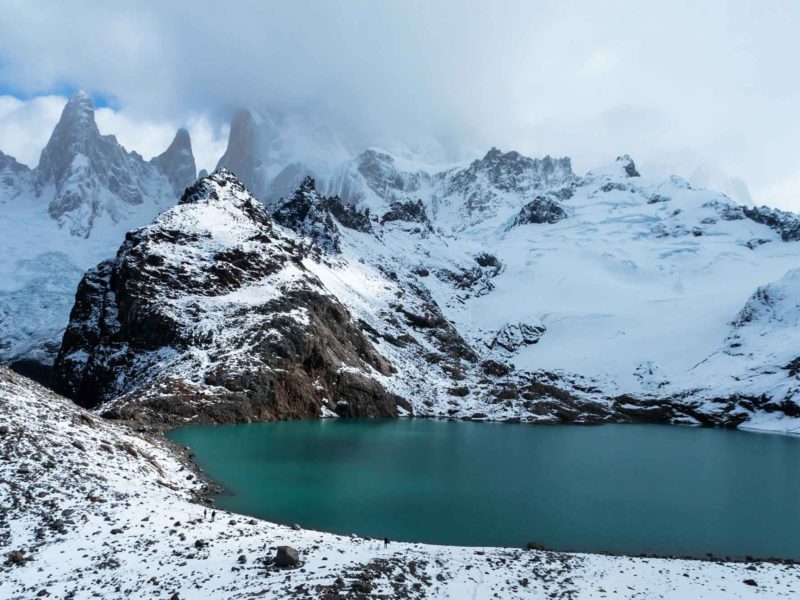
For self-catering, you can’t go wrong with Latitud 49˚ ($100 USD double apartment) and their modern apartments, complete with living room and kitchen. Owners Florencia and Lucas live next door and also have an encyclopedic knowledge of El Chaltén, its restaurants and activities.
Fly from El Calafate to Ushuaia (one flight per day, one hour 30 mins, around $140 USD if booked in advance), considered by many visitors one of the best destinations to explore in Argentina . Visit the offices of the bus companies in town to buy your onward travel to Punta Arenas.
Spend the afternoon visiting the plethora of museums and cultural attractions in the world’s southernmost city, including Museo Marítimo y Presidio , a museum about the history of the region set in the old Ushuaia prison, which is so big you could spend days here.
Alternatively, get a taxi to the trailhead for Glaciar Martial , seven kilometres out of the centre of town, which rises out of the Martial Mountains.
This two-hour, three-kilometre trail climbs steeply across glacial moraine, following the route of a ski lift to reach an 825-meter viewpoint of the Glaciar Martial and the Beagle Channel if you look south.
The next morning, take the public bus to Tierra del Fuego National Park and hike the Cerro Guanaco Trail, an 8km (five-mile) route that ends at the top of a sheer mountain overlooking the Strait of Magellan and the rest of the national park.
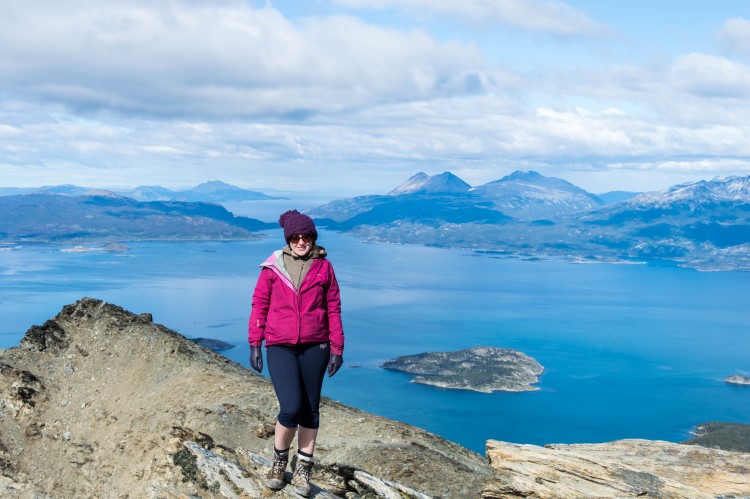
There are also a number of shorter trails and entry into the park costs around $560 ARS/$9 USD.
Where to eat in Ushuaia
Most restaurants are very expensive in Ushuaia (mostly because it’s a spot where expensive Antarctica cruises dock), but Bodegón Fueguino (Av. San Martín 859) hits the spot. It’s best known for its Patagonian lamb dishes, although hearty salads combined with a meaty empanada (US$1.50) or pumpkin soup (US$4) are an excellent option for something nutritious and cheap.
It might not sound like it, but El Turco (Av. San Martín 1410) is a great place to sample traditional Argentinean sorrentinos (pasta filled will salmon or vegetables), although there is also a wide range of pizzas and grilled meat dishes.
Budget accommodation in Ushuaia
All of the large rooms at the backpacker-friendly Antarctica Hostel ($17 USD dorm, $65 USD double) share the two blocks of bathrooms downstairs. WIFI is fast, outlets are aplenty in dorms and communal areas, but the best bits are the open-plan living area, with a shared kitchen on a platform above, and the staff’s encyclopedic knowledge of activities in the region.
Mid-range accommodation in Ushuaia
My personal favourite is Galeazzi Basily B&B ($75 USD double shared bath, $100 USD cabin for two people) because of the welcome you’ll receive! It’s a top-notch bed and breakfast that has four simple but well-maintained bedrooms that share two bathrooms, plus three cabins in their large garden, complete with kitchens and spacious bedrooms. Fluent English is spoken by the staff; the owners have a wealth of knowledge about the local area.
Another affordable choice is La Casa en Ushuaia ($80 USD double shared bath) is a superb little B&B, with simply decorated bedrooms with crisp, white sheets and views out across the Beagle Channel. The owner is very friendly and welcoming and has a wealth of local knowledge.
High-end accommodation in Ushuaia
A 20-minute drive from the centre, Los Cauquenes ($398 USD double) has exceptional views of the Beagle Channel from its bedrooms, an on-site spa has a sauna, jacuzzi and gym, as well as a restaurant offering top-quality dining.
Day Twenty: Ushuaia to Punta Arenas
Buses leave in the morning from Ushuaia and it takes around 12 hours to get to Punta Arenas (including border crossing).
Day Twenty-One: Punta Arenas
Fly back to Santiago.
Changes to this Patagonia backpacking itinerary for three weeks of travel:
- If you don’t need to return to Punta Arenas for flights, you can instead fly back to El Chaltén and take the bus to Bariloche (a hefty 22-hours but a good way of exploring more of Argentine Patagonia). From Bariloche, you can cross the border back into Chile to visit Puerto Varas and the Lakes District ; alternatively, you can fly to Mendoza to visit Argentina’s wine region and take either a short flight or overnight bus to Santiago.
- Only want to hike the W ? Trim off three days from your Torres del Paine itinerary and instead use that time to see more of El Chaltén or you can visit Puerto Williams from Ushuaia.
- Want to head to the White Continent? Most departures for Antarctica leave from Ushuaia. For the best experience, I highly recommend the brilliant Swoop Antarctica. Their staff have extensive, first-hand experience of sailing to Antarctica and, because they sell cruises for all the well-known companies, they can give you handy, impartial advice for choosing the one that best suits you. What’s more, they specialize in small ship expedition cruises, which means you’ll be allowed to get off the boat at every stop on the itinerary (which is not the case for large ships!) and you won’t pay a cent more by booking through them rather than directly with the cruise company themselves. Check out their classic cruises to the Antarctica Peninsula , or their more unusual trips to wildlife-rich South Georgia and the Falklands , or go further than most on a cruise to the Antarctic Circle .
Patagonia backpacking itinerary for three weeks: The Carretera Austral & Argentina highlights
Overview for this three-week Patagonia itinerary:
Day Two: Puerto Natales
- Day Three: Hike in Torres del Paine National Park
- Days Four-Five: El Calafate and Glaciar Perito Moreno
- Days Six-Eight: Hike in El Chaltén
- Days Nine-Ten: Hike the “no road” Border Crossing
Days Eleven-Twelve: Villa O’Higgins
- Day Thirteen: Caleta Tortel
Days Fourteen-Seventeen: Cochrane and Parque Nacional Patagonia
Day eighteen: puerto río tranquilo, days nineteen-twenty: villa cerro castillo and parque nacional cerro castillo.
- Day Twenty One: Coyhaique/Santiago
If you want to see more diversity of landscapes in Patagonia and experience the ultimate in road trips (or hitchhiking adventures!), then this three-week Patagonia itinerary is likely more for you.
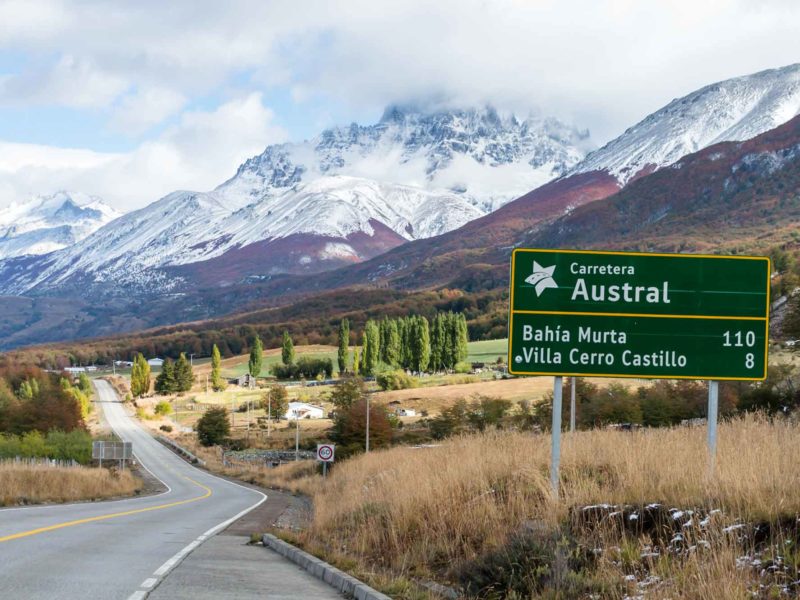
The Carretera Austral has gone from dusty backroad to top of many travellers’ itineraries – and for good reason.
Not only is it home to possibly the most picturesque glacier on the continent but there are wild camping spots galore and many an intrepid backpacker has enjoyed exploring this part of Patagonia a dedo – aka, hitchhiking.
If you fancy submitting to the hitchhiking gods and waiting for a lift by the side of Ruta 7, expect this itinerary to take more time – so give yourself at least an extra week.
For a true Patagonia adventure, camping equipment is essential. That’s not to say it’s not possible to go backpacking through Patagonia without a tent, but it seriously enhances the options available to you.
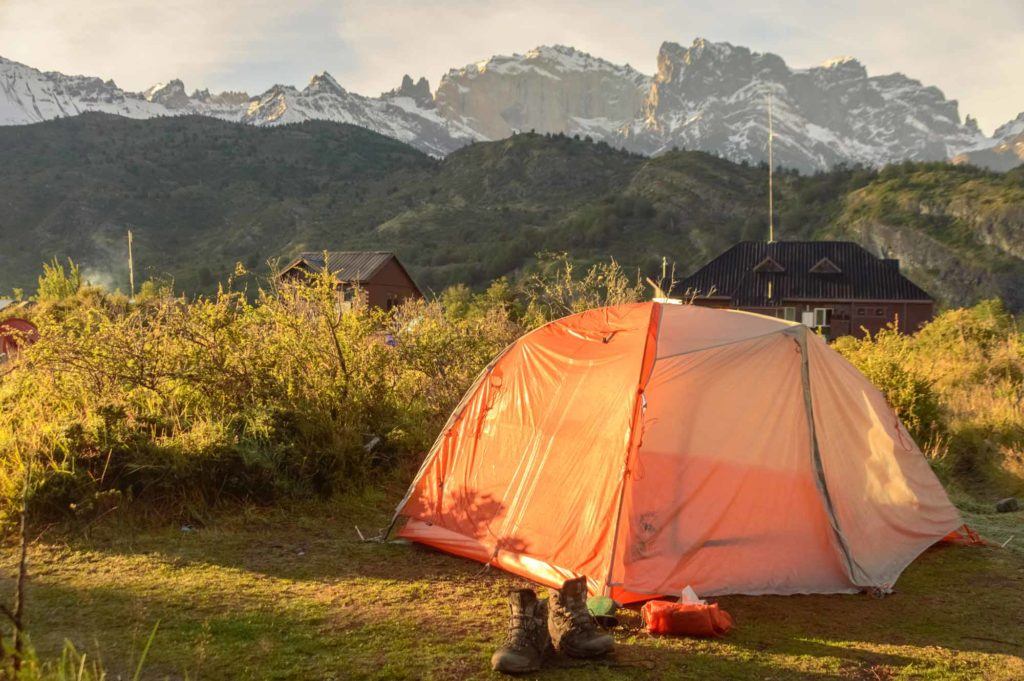
For my recommendations, check out my Patagonia packing essentials checklist and my review of Big Agnes Copper Spur, a lightweight backpacking tent .
At some points along this route, it is hard to get hold of food easily, so I’ve indicated which places are best for stocking up.
Fly with LATAM or Sky Airline to Punta Arenas (3 hours 35 minutes, four flights per day). If travelling to Patagonia between December and February, LATAM flies directly to Puerto Natales from Santiago (twice weekly, 3 hours 10 minutes).
Punta Arenas is often overlooked in favour of getting directly to Puerto Natales, but it’s actually an interesting place to spend an afternoon.
You’ve got the Museo Regional de Magallane s (with its exhibits on the indigenous and colonial history of the region), Museo Nao Victoria with its life-size replica of the Nao Victoria, the first ship to circumnavigate the earth, or the fascinating Museo de Historia Natural Río Seco , which contains a macabre but fascinating collection of skeletons pertaining to false killer whales, sea lions, and albatross.
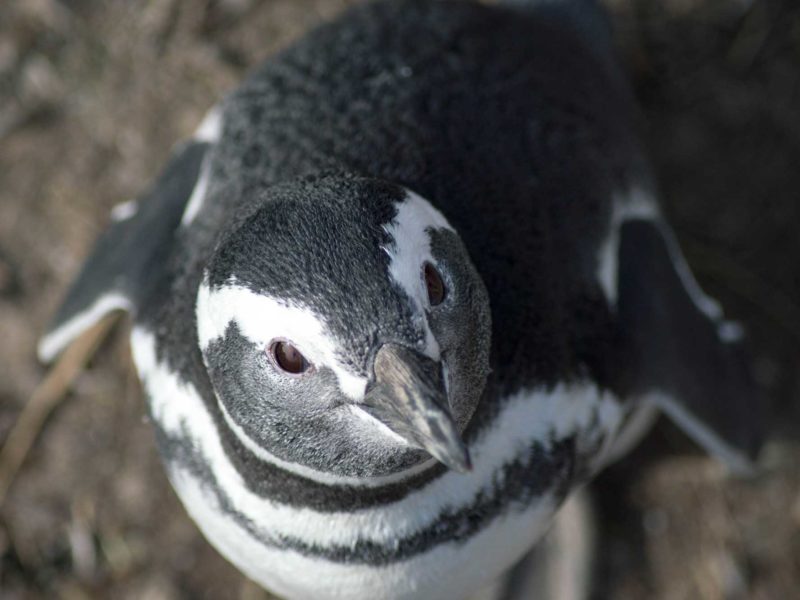
You can also add an extra morning here and head out on a morning tour to the Monumento Natural Los Pinguinos on Isla Magdalena in the Strait of Magellanes, which is home to tens of thousands of Magellanic penguins between November and March.
Go with Solo Expediciones if you want to avoid other tourists, who take the cheaper TABSA boat and descend on the island at the same time.
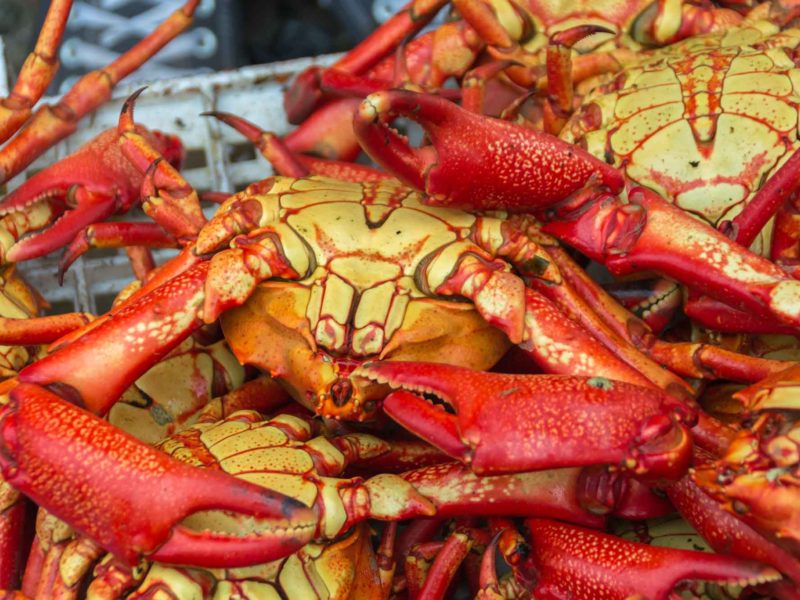
High-end accommodation in Punta Arenas
Get a bus from Punta Arenas to Puerto Natale s (three hours 30 mins) and take a wander along the fjordside. Buy tickets from the bus station for onward travel to El Calafate for Day Four.
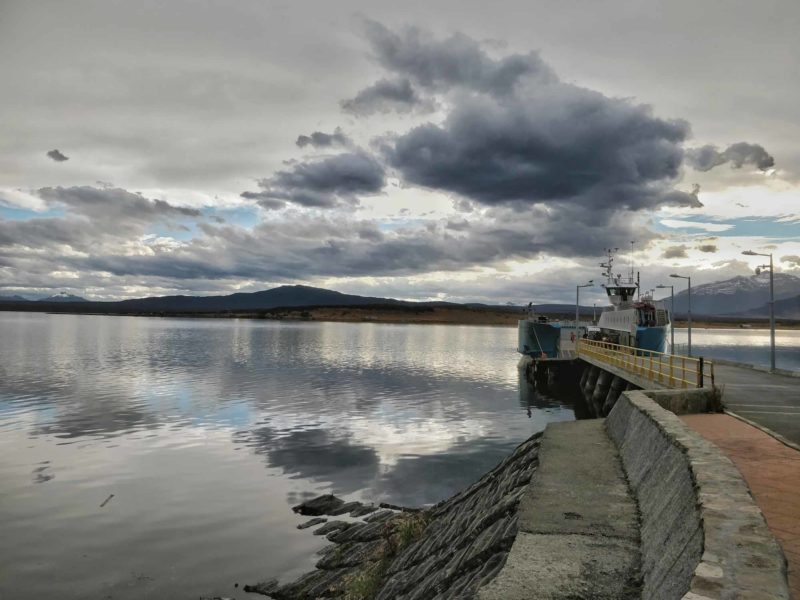
Take a walk along the shore of Seno Última Esperanza (Last Hope Sound) for views of the dazzling countryside surrounding the town.
If you fancy having an authentic Patagonian experience, add an extra day in Puerto Natales and organise a trip out to Estancia La Peninsula , for a day of horseback riding and a traditional cordero al palo (roast lamb barbecue) at a still functioning sheep ranch.
One of the hottest tables in town is at Lenga (Bories 221), which is home to innovative takes on traditional Chilean food, with its chalkboard menu updated daily. It’s tiny, so bookings are essential.
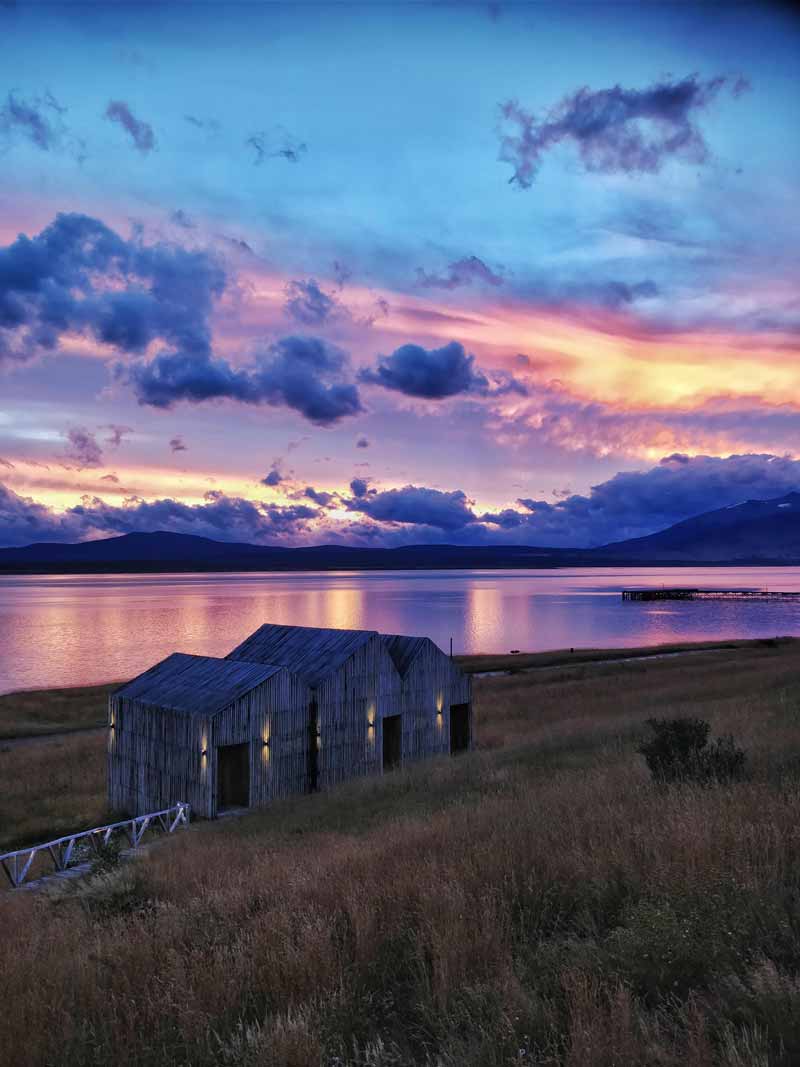
Hands down while the fanciest place in town for a sundowner and dinner is at The Singular Patagonia , a luxury hotel whose fjordside wine bar and restaurant are own to the public.
It’s also home to a fascinating museum dedicated to the town’s old abattoir (in fact, much of the hotel is built inside the former building), which you can visit for free if you buy a drink in the bar. A taxi here should cost only a few thousand pesos.
Friendly and English-speaking owner Marcela runs a tight ship at the spotless Big Bang ($64 USD double) double). Rooms are set around a grassy garden and an ample breakfast of home-baked bread, fruit and eggs, is served up each morning. Unfortunately, it can be a little noisy as the wooden floorboards and thin walls mean sound carries between the rooms.
With clean, modern bedrooms and with 360𝆩 views of the fjord and Puerto Natales from its balcony, Sheuen Patagonia ($87 USD double) is a good value choice, with friendly staff and excellent breakfasts to boot.
Day Three: Torres del Paine National Park
If you want to see Torres del Paine National Park but don’t have the time – or money – to trek (even though you can hike the W without a tour for cheaper than you might think), a day visit is an excellent alternative.
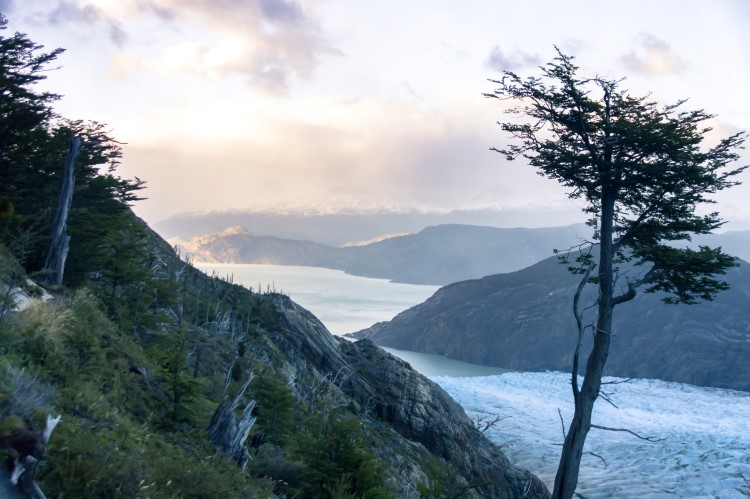
You’ve got various options: organise a rental car and head out for self-guided day hikes or arrange a day tour. I personally recommend the former (and we have a guide to the 15 best Torres del Paine day hikes ), but the latter is easy (if more expensive) to arrange.
Plenty of companies in Puerto Natales offer this service, with tours picking you up and returning you to the town. Expect to pay upwards of $23,000 CLP/$35 USD, plus park entry ($18,000 CLP/$27 USD).
Days Four-Five: El Calafate
Take the bus in the morning to El Calafate (five hours including border crossing).
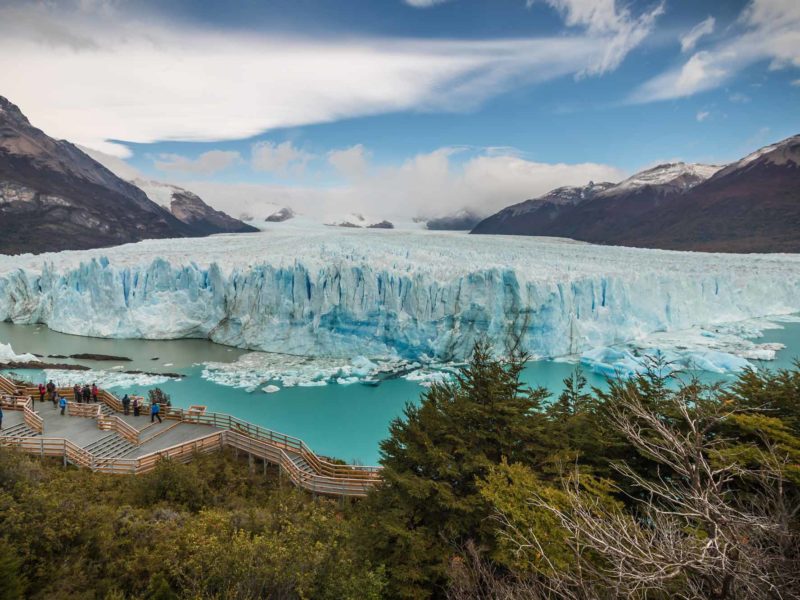
To explore Glaciar Perito Moreno , rent a taxi for the day (if there are two or more of you) or take the bus from the terminal to Los Glaciares National Park and Glacier Perito Moreno (click for our complete guide), where you can explore the boardwalks that get very close to the snout of the glacier.
Alternatively, opt for an ice hiking tour of the glacier .
Mid-range accommodation in El Calafate
High-end accommodation in el calafate.
Where to stay in El Calafate: With incredible views of the lake, a good restaurant and indoor swimming pool, Design Suites Calafate ($115 USD double) is the perfect getaway. It’s a 10-minute drive into town (but there’s a shuttle bus for guests, but with access to a couple of short hikes and those views, you’ll be more than content staying on the ground.
Days Six-Eight: El Chaltén
Buses leave regularly for El Chaltén (four hours) from the bus station in El Calafate.
If you’re planning on self-catering in El Chaltén, stock up here as there’s more selection and cheaper prices.
There are plenty of hikes to keep you busy for a couple of days, including to Laguna de los Tres and Laguna Torre , both of which offer the best views in town.
There are even multi-day hikes in the national park. Check out this website for full information about El Chaltén and where to hike in this part of Patagonia.
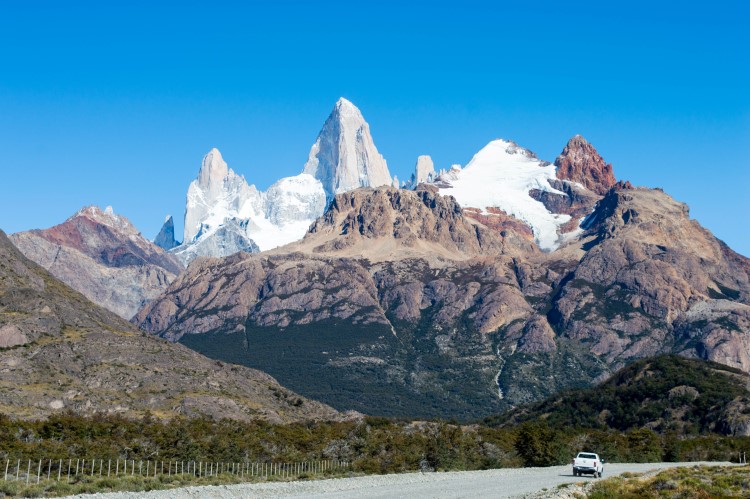
With a friendly, young vibe, plenty of hot water and a very central location (although, to be fair, El Chaltén isn’t excactly large anyway) Patagonia Travellers’ Hostel ($25 USD dorm, $75-$105 USD double) has great dorms and decent-sized doubles.
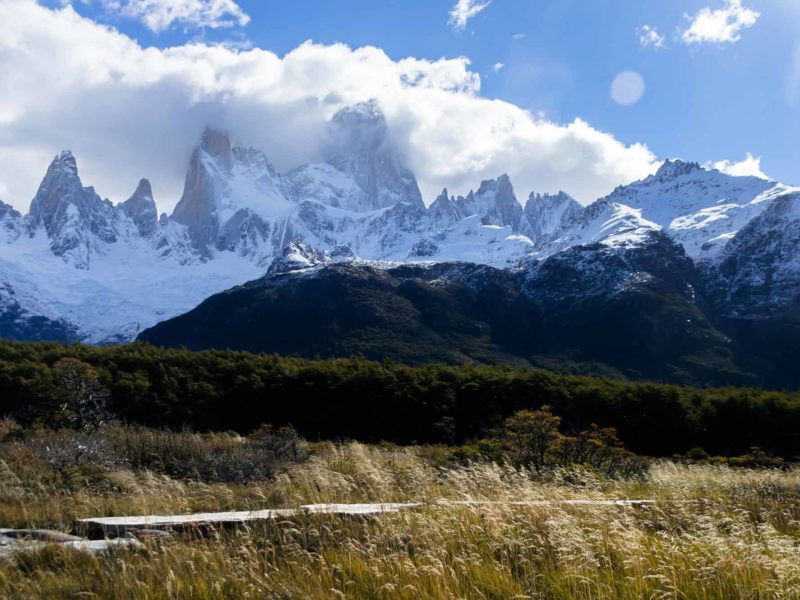
For self-catering, you can’t go wrong with Latitud 49˚ ($100 USD double apartment) and their modern apartments, complete with living room and kitchen. Owners Florencia and Lucas live next door and also have encyclopedic knowledge of El Chaltén, its restaurants and activities.
Days Nine-Ten: Border Crossing
Crossing from El Calafate to Villa O’Higgins in Chile, via Lago del Desierto, is the most adventurous border crossing in Patagonia, due to the fact that there’s no driveable road – so you can only cross on foot (with a little help from a handful of ferries).
If you’re carrying lots of gear, then this is possibly not a great option (see your alternatives below).
This route involves hiking and various ferry crossings and can take far longer than two days if the weather is poor and ferries are delayed, so budget an extra few days into your trip, bring plenty of cash (both Chilean and Argentine pesos, although USD will serve, too), extra food and lots of patience!
Read a full explanation of the route here .
Explore the tiny little town of Villa O’Higgins at the very southern edge of the Carretera Austral, a place that was only connected by road to the rest of the highway in the late 1990s!
It’s a wonderfully remote place, home to fewer than a thousand people. Here you can take a flyover of Lago O’Higgins and check out Glacier O’Higgins with WINGS (contact pilot Vincente Beasley on 9/9162 5137 or 9/9357 8196) or hike some of the short trails around the area.
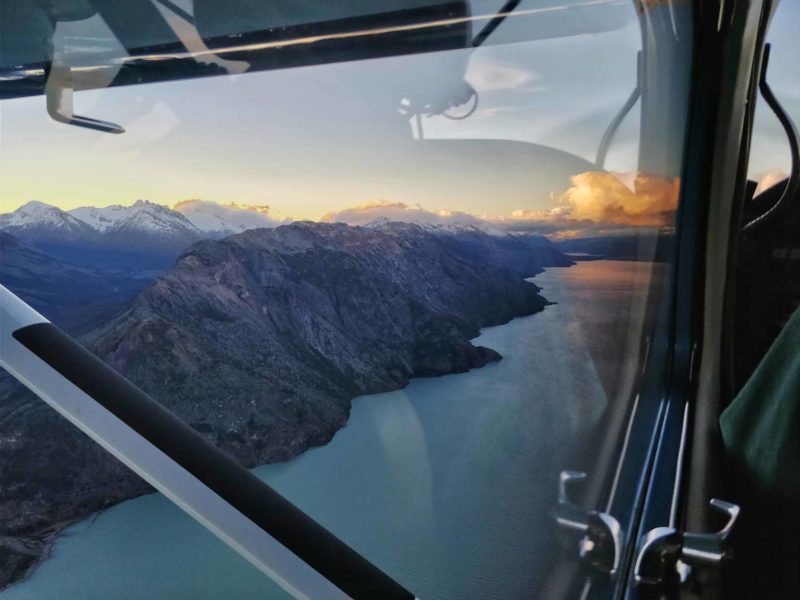
Double-check the time of the bus the following day to Cochrane (and be prepared for there not being a bus for a day or two).
Where to eat in Villa O’Higgins
Because of its size, there aren’t a lot of options for dining in Villa O’Higgins. One of the best is Lago Cisnes where you can chow down on traditional Chilean home-cooking in a spot popular among the locals. In the evenings, particularly on weekends, you can pop down here for live music or karaoke.
Budget accommodation in Villa O’Higgins
A meeting place for backpackers, cyclists and road trippers, El Mosco ($45,000 CLP ($52 USD) cabin or double, $9,000 CLP ($11 USD) dorm, $6,000 CLP ($7 USD) camping), has a range of different accommodations is suited to all budgets, with a large kitchen and attached living area perfect for self-catering.
Mid-range accommodation in Villa O’Higgins
The rustic cabins at Entre Patagones ($40,000-50,000 CLP ($47-$58) cabins, $65,000 CLP ($76 USD) yurt) range between those with a small kitchen and those with only tea- and coffee-making facilities, while two modern yurts are hidden away into the forest, with utter privacy from the road and views west across the mountains.
Both have beautifully designed circular bedrooms, up-to-date bathroom suites, a wood fire for heating and a fully equipped kitchen, plus a balcony and private hot tub.
High-end accommodation in Villa O’Higgins
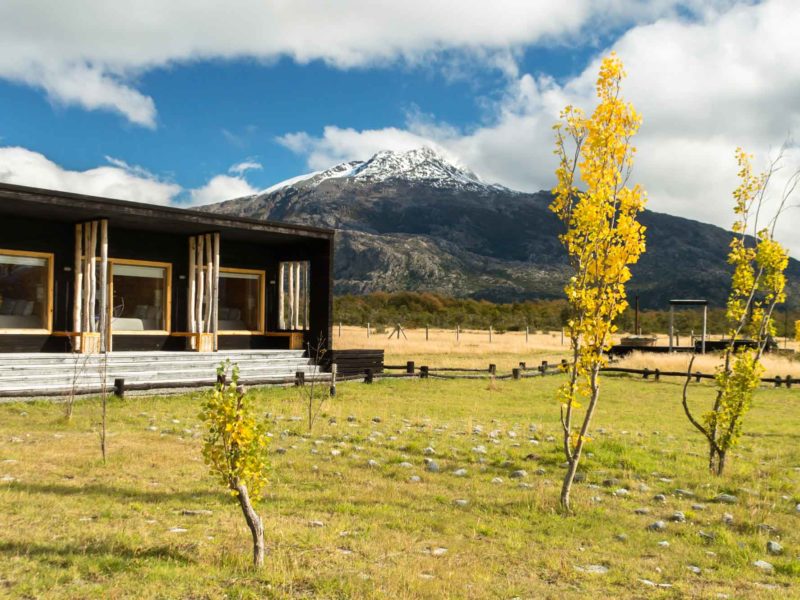
For a slice of unexpected luxury in the middle of nowhere, the ambitious Robinson Crusoe ($166,000 CLP ($194 USD) double) is stylish and beautifully designed. All bedrooms have the comforts you’d expect at this price point, plus access to hot tubs looking west across the mountains.
Day Thirteen: C aleta Tortel
Catch a minibus north through some of the most remote parts of the Carretera Austral – which makes them an excellent point to spot an endangered huemul deer.
You’ll cross a stretch of fjord before arriving a few hours later at Caleta Tortel , Chilean Patagonia’s most picturesque village.
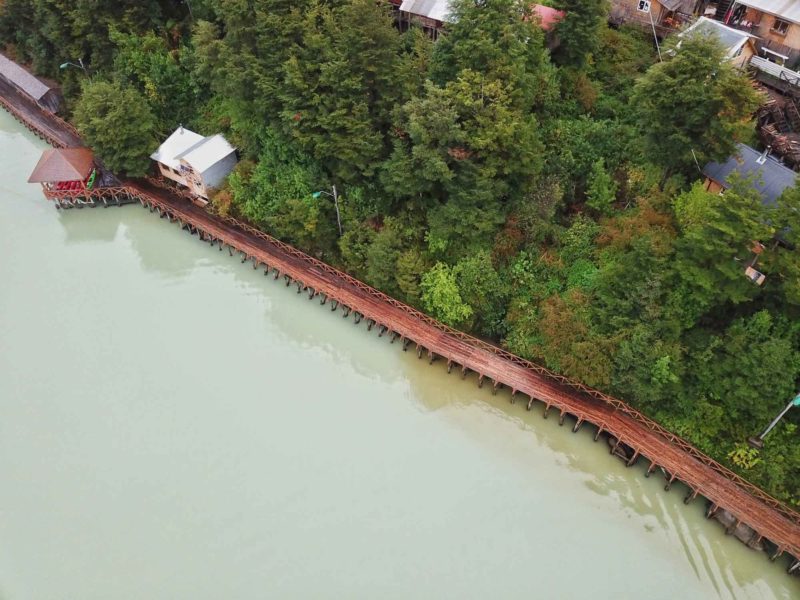
Part of its appeal is its spectacular location: the houses cling determinedly to the edges of a green-fringed hill, with the turquoise waters of the fjords lying below.
But it’s also charming in its uniqueness. There are no roads; instead, 10 kilometres of cypress-wood walkways stand in lieu of tarmac, crisscrossing the village.
There isn’t an awful lot to do here, but you can spend a day hiring kayaks to head out onto the fjords, organising a tour to two nearby glaciers, Ventisquero Steffens and Glaciar Jorge Montt or hiring a boat to take you to the fascinating, if a little macabre, Isla de los Muertos, where the original settlers of the village are buried, having died from poison or scurvy – depending on who you believe.
Where to eat in Caleta Tortel
Caleta Tortel is pretty tiny, too and dining options are limited (and mostly poor!). The best is El Mirador (Sector Centro), with great views and decent food. They have the best WIFI connection in the village and also serve their own dark beer on tap.
Budget accommodation in Caleta Tortel
There’s a dearth of good-quality accommodation in the village, too.
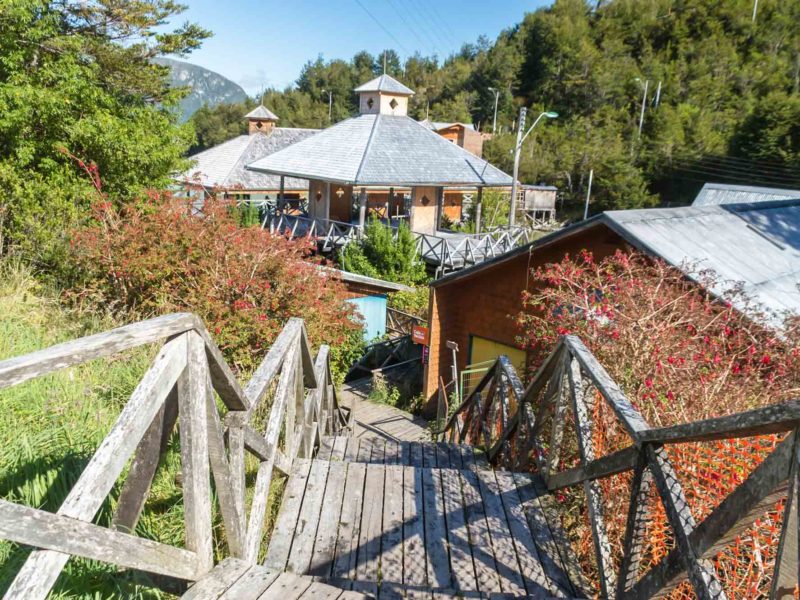
On the far southern side of the town, Residencial Brisas del Sur ($15,000 CLP ($17 USD) per person) is clean and utilitarian, with pretty views across the bay. There’s no kitchen access but WIFI and breakfast is included in the price.
Mid-range accommodation in Caleta Tortel
Caleta Tortel’s most comfortable option is the modern Entrehielos Lodge ($103,000 CLP ($20 USD) double), with stylish rooms that each have rainfall showers and central heating. They prepare gourmet Chilean dishes for guests, with an impressive wine menu.
Take the bus to Cochrane (three hours). Lying in a river valley and surrounded by the crystal waters of the breathtaking Río Cochrane, this is a small, agricultural town and an excellent place to stock up on supplies (they have the biggest minimarkets between here and Coyhaique north).
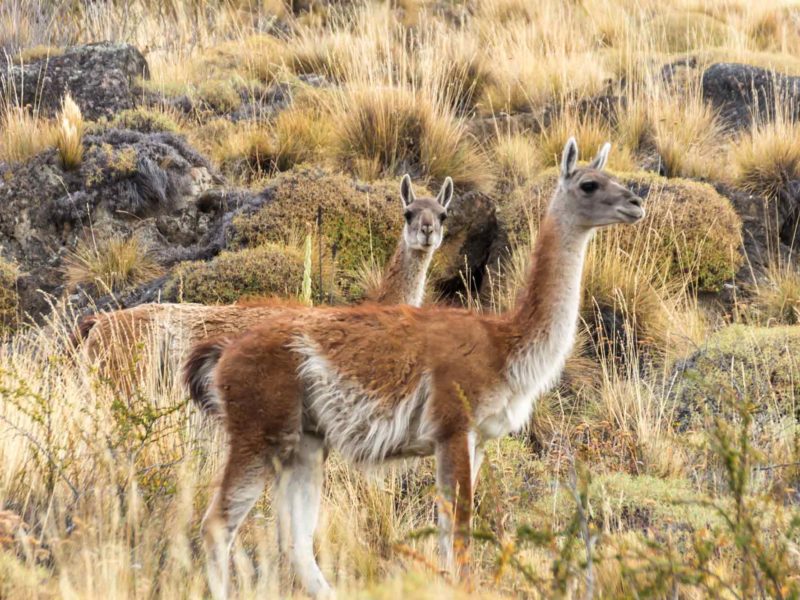
However, the reason to spend a few days here is its access to Parque Nacional Patagonia , one of the Carretera Austral’s most outstandingly beautiful – and well-maintained – national parks.
Originally set up as a private park b the late philanthropist Doug Tompkins, the national park now covers 304,000 hectares of land and is divided into three sectors. From Cochrane, you can visit Sector Tamango and Sector Valle Chacabuco.
Sector Tamango lies a few kilometres east of Cochrane and is home to a number of day hikes, plus a campground if you’ve got your own equipment. It’s an excellent spot for seeing huemul deer and glacier-fed Lago Cochrane, this sector’s centrepiece, is beautiful. Maps of the trails are found here .
Sector Valle Chacabuco is home to a sweeping valley of pampas grasslands and, at higher altitudes, spectacular glassy lagoons. You’ve got a good chance of seeing guanaco (the place is swarming with them), and a slimmer chance of spying rhea (ostrich like birds) and puma, tall of which have been reintroduced to the area.
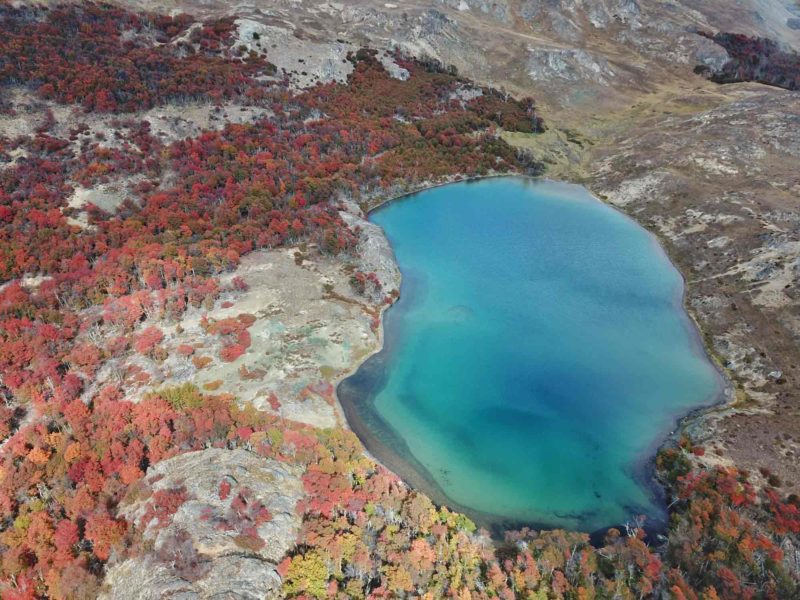
The trails here include my personal favourite, the Lagunas Altas (trailhead next to Los West Winds campground), a challenging but worthwhile hike into the hills for magnificent panoramas of the lakes and the valley beyond.
There are a number of other day hikes; information about all trails is available here .
All of the trails in Sector Chacabuco are only accessible via car and there is no public transport, although hitchhiking to the park entrance (16 kms north of Cochrane) and then either hiking or – if you’re very lucky – hitchhiking the final stretch (11 kms) to the visitor centre, is the only option.
Where to eat in Cochrane/Sector Valle Chacabuco
In Sector Valle Chacabuco, the only place to eat is El Rincón Gaucho , which serves sandwiches and salads or a gourmet evening meal. Prices are as expensive as you’d expect from a place so remote!
In Cochrane, the cozy La Isla (Pratt 100 B) has Patagonian roast lamb on weekend, plus a range of traditional Chilean home cooking.
Budget accommodation in Cochrane/Sector Valle Chacabuco
In Sector Valle Chabuco, Los West Winds Campground (Oct.-Apr., $8,000 CLP pp) is the closest to the visitor centre and restaurant, as well as at the trailhead of the Lagunas Altas trail. As the name indicates, the site experiences westerly winds that can be fierce, so it’s a good idea to camp on the eastern side of the low shrubs and trees that provide some protection.
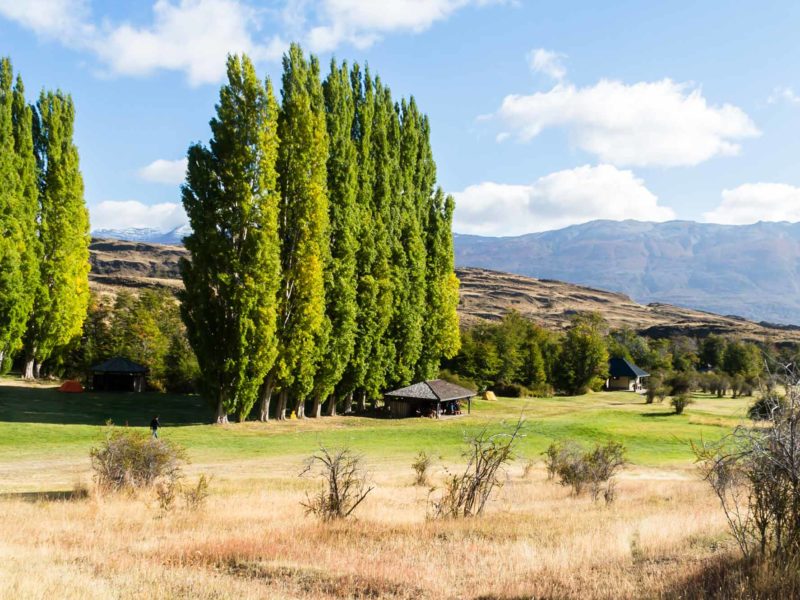
In Cochrane, When I visited, I stayed in the oh-so-homely Hostal Beraca ($25,000 CLP $34 USD) double), a very basic B&B fronted by the wonderful Marlen, whose family home she has converted. She makes probably the best breakfast along the Carretera Austral and is just a joy to be around – although she only speaks Spanish but will do her best to communicate if you don’t!
Mid-range accommodation in Cochrane
A little smarter and larger than most options in town is Lejana Patagonia ($30,000 CLP ($41 USD) double), with decent-sized bedrooms and kitchen access, although the whole building is made of wood so noise between the rooms can be an issue.
High-end accommodation in Sector Valle Chacabuco
If you’re looking to treat yourself, The Lodge at Valle Chacabuco ($500 USD double), is a luxury hotel right next to the visitor centre. Most of its 10 rooms feature sweeping views across the steppe, while the communal living area has floor-to-ceiling windows and a terrace for guests to appreciate the scenery. It’s a stunning getaway tucked into dazzling scenery.
Take a bus north to Puerto Río Tranquilo , a settlement on the shores of the cobalt-blue water of Lago General Carrera.
Book a tour from the lakeside to visit the marble caves , an incredible series of colourful, sculpted rock formations that rise out of Lago General Carrera and seem to change in hue depending on the weather.

Alternatively, book a full-day tour to visit the San Rafael Glacier , one of the fastest retreating glaciers in Patagonia. The trip is costly but supposedly worth it.
Where to eat in Puerto Río Tranquilo
If you make it all the way to Puerto Río Tranquilo, there are several campgrounds. I really liked Camping Bellavista (they also have rooms with kitchen access). There are a small number of restaurants and minimarkets with basic supplies.
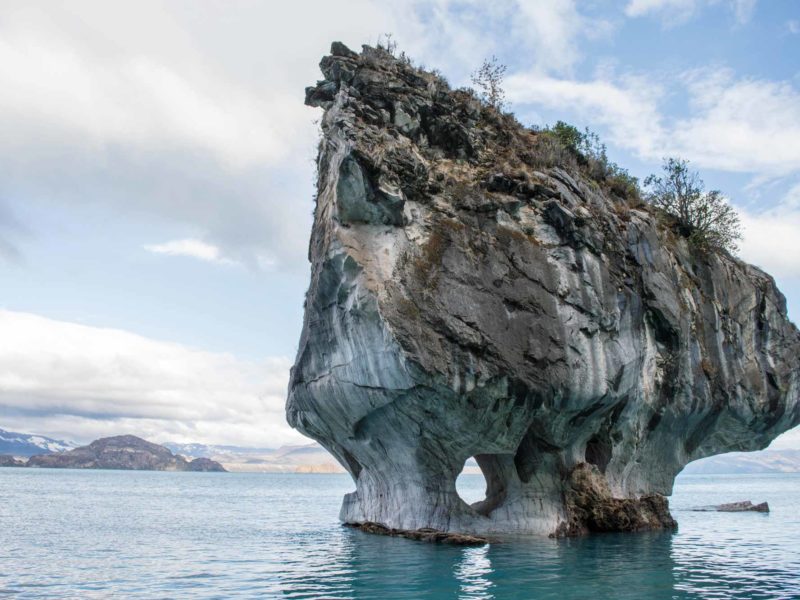
Budget accommodation in Puerto Río Tranquilo
Hospedaje y Camping Bellavista ($5,000 CLP ($7 USD) camping, $12,000 CLP ($16.5 USD) dorm, $25,000 CLP ($34 USD) double) is both comfortable and friendly, with private bedrooms in their chipboard guesthouse and a huge field for campers. Kitchen access and hot showers are included.
Mid-range accommodation in Puerto Río Tranquilo
Overpriced but offering the nicest accommodation in town, El Puesto ($100,000 CLP ($116 USD) double) has 10 small rooms, although be aware that there’s only one with a double bed (all the rest have two twin beds). There’s no WIFI.
Catch the shuttle to the next town north along the Carretera Austral, Villa Cerro Castillo (2.5 hours).
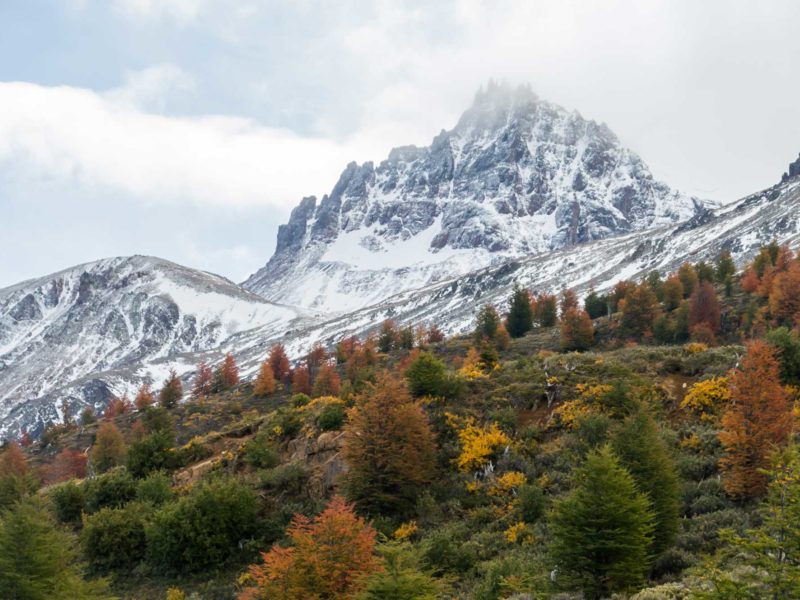
This town lies on the edges of Parque Nacional Cerro Castillo , often dubbed “the new Torres del Paine” for the three-pronged mountain after which the park is named, which does share similarities with the towers in Patagonia’s most famous national park.
You’ll want a full day for hiking the steep, 14-kilometre, six-to-eight-hour trail known as the Sendero Mirador Laguna Cerro Castillo . This takes you up to Lago Cerro Castillo (which sits beneath the park’s namesake peak).
If you’ve got extra time, you can instead enjoy the remote backcountry and glacier scenery of the four/five-day, 51-kilometre hiking circuit known as the Cerro Castillo Traverse .
Where to eat in Villa Cerro Castillo
Villa Cerro Castillo has a paucity of good restaurants. They’re all fairly similar and most close around 9pm if they have no customers, so aim to get there earlier rather than later.
Budget accommodation in Villa Cerro Castillo
Accommodation is very, very basic at mountain refuge-style Senderos Patagonia ($5,000 ($7 USD) camping, $10,000 CLP ($14 USD) dorm). It attracts backpackers and hikers, making it a good place to swap notes on local trails with fellow travellers, particularly in the expansive kitchen.
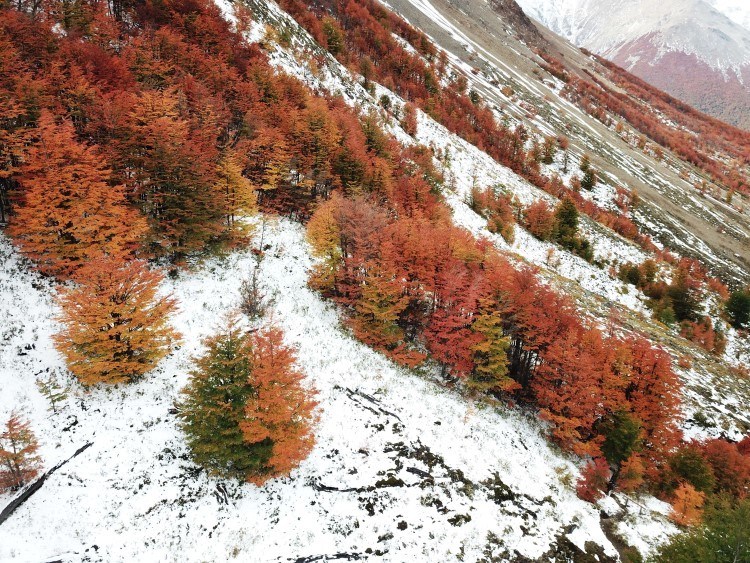
Mid-range accommodation in Villa Cerro-Castillo
A smarter option is Refugio Cerro Castillo ($131 USD double), which has views of Cerro Castillo mountain from the bedrooms. The breakfast is also good and it has a homely vibe.
Day Twenty-One: Coyhaique/Santiago
Take the bus in the morning to Coyhaique (two hours). From here, you can catch a shuttle to Aerodromo Balmaceda, for your flight to Santiago .
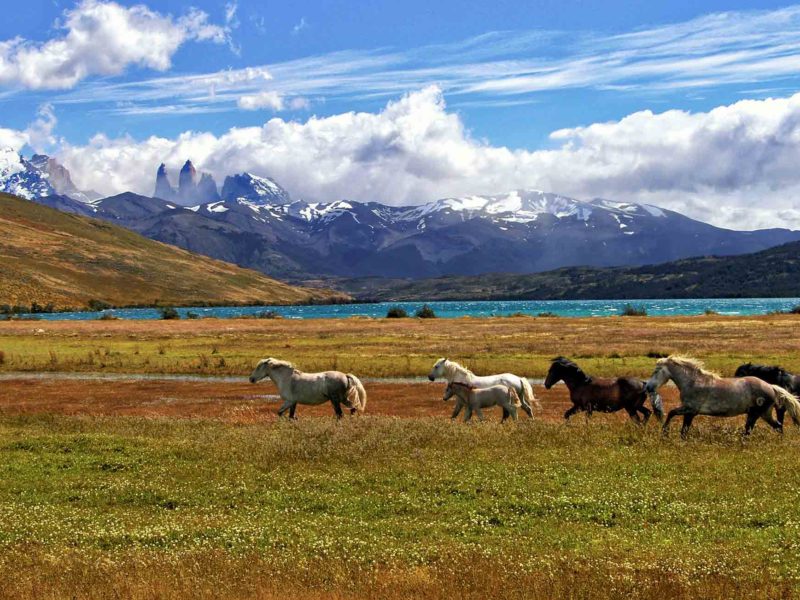
- Instead of crossing on foot into Chile at Villa O’Higgins , you can take a bus from El Chaltén to Perito Moreno (where the incredible Cave of Hands if located) then onto Los Antiguos and cross into Chile at the Chile Chico border. You can then head south to Puerto Río Tranquilo, Cochrane, Caleta Tortel and Villa O’Higgins – but you’ll have to backtrack to end your trip at Aerodromo Balmaceda.
- If you want see the northern stretch of the Carretera Austral , you can check out itineraries in our Carretera Austral articl e.
- If you want to drive to Carretera Austral or drive through southern Chilean and Argentine Patagonia , check out our Patagonia road-trip itineraries .
Patagonia backpacking itinerary for one month of travel: The Full Monty
If three weeks is still not enough, then spend an entire month exploring all of Patagonia’s spectacular corners.
I’ve put together a free ebook guide to spending a month in Patagonia, including travel tips, places to eat and stay and a comprehensive one-month itinerary.
I promise I don’t send spam: just tips, inspiration and the tools for planning off-the-beaten-trail South American adventures , straight to your inbox!
Uri Senderowitz
Friday 21st of May 2021
Hi! Great itinerary:) I have a few questions tho. My friends and I are planning to go for a 3 weeks trip next november or december, and are planning the trip. We dont want to spend over 6200 us dollars. How much did the trip cost you? Did you have to camp most of the time to keep low costs? What can we do to change the initerary to our needs? We want to get to ushuaia, Torres del Paine and all of the small amazing town a bit to the north. Thank you!
Steph Dyson
Thursday 25th of November 2021
Hi Uri, I'm not sure where you got 6200 USD from?! Camping does keep costs lower, but you can also stay in hostels with kitchens and cook rather than eating out - that should save you a lot of money. I can't say exactly how much I spent as I don't know but you can definitely make Patagonia affordable - this article has some tips. Steph
Friday 25th of October 2019
Hi Steph. Awesome article, i very much enjoyed reading it and I am still reading the rest of your articles about south america. I have one question if i may?
In couple of months, we will be hiking from Ushuaia / backpacking heading north mostly on the east side of Andes. This potentially involves multiple crossings between Chile and Argentina. We are Canadian citizens and as such don't need visa,can stay in each country for up to 90 days but how do you deal with crossing the borders legally in the backcountry please? We will be mostly off the beaten trails, meaning no buses , flights etc... It will take a long time indeed to hike , but do you have experience or recommendation for this situation please? Warm Regards. V
Thursday 7th of November 2019
Hi V, I imagine you will still have to find the official border crossings and make sure that you legally cross the border correctly. You could get into some bother if you don't do this. You can find a full list of border crossing on this website. Sounds like an incredible trip though - enjoy! Steph
David Diringer
Thursday 3rd of October 2019
Hi Your blog is the best I've seen when it comes to clear , comprehensive and useful information
Is it possible to arrange locally, on arrival or in advance, porter service for sections of the W trek ? We are a couple in our lates 60's who like to walk but are no longer willing to carry any more than a day pack Thanks
Thursday 10th of October 2019
Hi David, not that I'm aware of. If you don't want to carry your belongings, you can hire all tents and camping equipment at each campsite and get all meals included so you'll just be carrying your lunch and clothes and camera during the day. You can organise all this when you book the sites (it gives you the chance to choose a fully-equipped camping spot and full-board). I hope that helps! Steph
Sunday 13th of January 2019
Hi Steph - many thanks for your response, very helpful! I used your inputs to come up with the following:
From Córdoba (which will be my next stop) bus all the way down Argentina stopping at Mendoza, Ruta de los sietes Lagos, San Carlos de Bariloche, Perito Moreno town, El Chalten, El Calafate, Perito Moreno glacier. Hope all the bus routes along these places do not involve any border crossings - please let me know if my understanding is incorrect. Then as you recommended cross to Chile (1st border crossing) and do Torres del Paine. Head south to Punta Arenas and then bus to Ushuaia (2nd border crossing). Fly from Ushuaia to El Calafate and then follow your suggestions to Villa O’Higgins (3rd border crossing) and Puerto Montt and then continue up to Chile. Have I missed any border crossings particularly on the bus route from Villa O’Higgins to Puerto Montt? Kindly let me know.
Thursday 17th of January 2019
Hi Ram, that's true actually. If you take the plane between Ushuaia and El Calafate then you don't have to go through Chile! And no, from Villa O'Higgins up to Puerto Montt it's all through Chile. Have a great trip!
Friday 11th of January 2019
Thanks for this very informative article. I am in Argentina now near Salta and plan to travel through Patagonia over the next 2 months. I have a somewhat unique problem - my passport is only left with a few pages which will allow me to make only 2 multiple entries in Chile and 2 more entries in Argentina. I have contacted my embassy in both Argentina and Chile and they will take literally forever to issue extra pages or a new booklet. Can you please recommend an itinerary for me to cover Patagonia to the maximum extent possible while trying to minimise border crossings. I am prepared to take longer bus journeys or worst case flights to achieve the same.
Hi Ram, I suggest going through Argentina (either bus or flight) to El Chalten/El Calafate (could go via Bariloche and Puerto Madryn). You can then cross into Chile to go to Torres del Paine etc. Then back into Argentina at El Calafate and you can either do the El Chalten/Villa O'Higgins hiking crossing (which will get you to the bottom of the Carretera Austral in Chile) or you can bus it up to Perito Moreno (the town, not the glacier) and cross into Chile at Chile Chico (mid-way up the Carretera Austral), from where you can go south down to Villa O'Higgins and then back north all the way to Puerto Montt, or just go north up to Puerto Montt and continue up through Chile. You won't be able to go to Ushuaia as the trip there makes you cross in and out of Argentina and Chile several times. Hope that helps and enjoy your trip! Steph
CURRENT PRICES END MAY 12
Outside Festival feat. Thundercat and Fleet Foxes.
GET TICKETS
Start Your Free Trial
Powered by Outside
The 7 Wildest Hiking Trails in Patagonia
Dayhikes, backpacking trips, popular routes, remote backcountry trails, and more. no matter what you're looking for, patagonia has it all..
Heading out the door? Read this article on the new Outside+ app available now on iOS devices for members! >","name":"in-content-cta","type":"link"}}'>Download the app .
Straddling two countries and serving as home to rugged and imposing mountains, giant calving glaciers, and some of the world’s most adventurous spirits , Patagonia has etched itself into the fabric of my heart. After spending three months chasing horizons and navigating the unpredictable dance of the southern winds, I’ve whittled my time there down to eight can’t-miss trails that I still dream of today. If heading there is on your bucket list, you can’t go wrong with any of these trips.
Keep in mind that in Patagonia, adventure and challenge go hand-in-hand. I’ve learned that being prepared to experience all four seasons in one day is imperative. So is strapping down that backpack rain cover as if your life depends on it, because in some conditions, it does. Strong winds and rain can delay hikers on the trail, so be sure to bring enough food for a few extra days, and pack a waterproof shelter even if you’re just heading on a dayhike. (Thankfully, clean water is ever-abundant in the area thanks to the wealth of glacial melt .)

The O Circuit, Torres del Paine National Park, Chile
Length: Approximately 80 miles (130 kilometers) over 7 to 9 days Difficulty: Moderate to challenging Access: The trailhead is accessible from Puerto Natales, and you’ll have to pay a fee to enter the park. Due to its popularity, booking campsites or refugios, which are small huts that often have showers and bunk bed space available for rent, in advance is essential.
Trekkers in the know often consider the O Circuit in Torres del Paine National Park in Chile Patagonia’s crown jewel. It’s one of the most magical hikes I’ve ever experienced . If you only have time for one hike in Patagonia, make it this one: Each day offers a completely different experience and view. It’s also one of only four trails in Patagonia where you can witness the majesty of the Southern Patagonian Ice Field, the world’s second largest contiguous extrapolar expanse of ice. Though you won’t need to don crampons and cross it, you’ll be hiking right across from it for almost the entire fourth day of the trip.
Many choose to just hike the W, which is a 4 to 5 day section within the O Circuit that avoids the highest point on the trail, the John Gardner pass. But doing the whole thing is totally worth it: The three additional days that make it the O are less crowded, and some of the most beautiful out of the entire trip. This is also one of the only hikes in Patagonia where you can reserve refugio space, meals, and even pre-pitched tents ahead of time, which significantly lightens your load. It’s also one of the most popular hikes in Patagonia, so book your trip up to a year ahead.

Fitz Roy, El Chaltén, Argentina
Length: Variable; shortest route is 16 miles (26 kilometers) Difficulty: Moderate to challenging Access: El Chaltén serves as the starting point for Fitz Roy hikes. The town is easily reachable from El Calafate by bus.
One of the most legendary views in Patagonia, Fitz Roy is a famous and popular trek for good reason. Though you’ll be sharing it with plenty of other hikers, it is still so worth doing for a glimpse the legendarily rugged mountain and lake view at the top. Most of the trail is flat and lovely, with the exception of the last hour of steep, rocky terrain. It’s also possible to camp at the base and climb to the top to see the sunrise illuminate the jagged mountains.
Not looking for a long dayhike or a backpacking trip? If you’d rather stay in town but still see the mountains, the easier and more accessible 1.25-mile (2-kilometer) Condor Lookout trail is a great option.

Cerro Torre, El Chaltén, Argentina
Length: Variable, shortest route is 15 miles (24 kilometers) Difficulty: Easy Access: El Chaltén serves as the starting point.
Like Fitz Roy, Cerro Torre in El Chaltén is a do-not-miss. This is also a mostly flat hike without the climb to the top that Fitz Roy has. Most of it is through lovely landscape with scrubby bushes and some boardwalks, and although the hike is long, its lake and jagged peak view at the end is worth it. Bring a zoom lens to peep climbers on the face of the rock. It’s also possible to combine this and the Fitz Roy hike for one long but beautiful day.
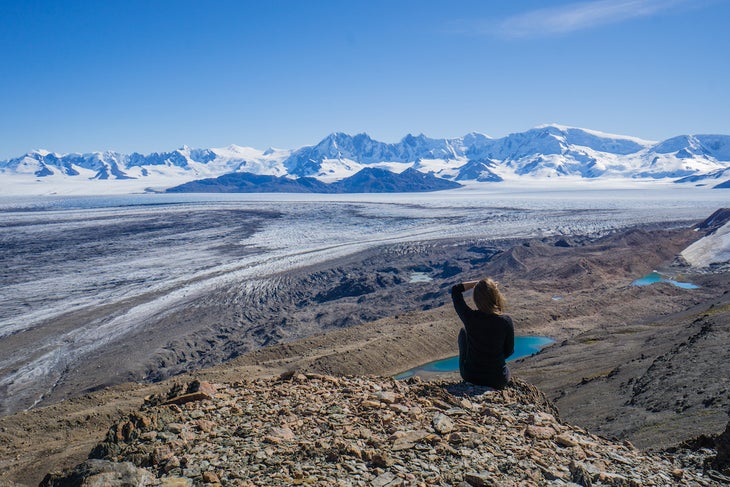
Huemul Circuit, El Chaltén, Argentina
Length: Approximately 39 miles (63 kilometers) over four days Difficulty: Challenging Access: The trail starts near El Chaltén.
The Huemul (pronounced wey-mool) Circuit is a grueling, a four-day symphony of endurance that will test any hiker’s mettle. I will always remember navigating the worst downhill of my life on this trail: It’s steep and on loose dirt with very little to brace on, and is not for the faint of heart. But, oh, the scenery: Smaller crowds, panoramic vistas, and the wildness of it all make it one of the most beautiful treks I can remember doing.
You’ll need to be totally self-sufficient on this trail. You’ll also need to bring or rent a harness and pulley from one of the shops in El Chaltén to pull yourself across not one, but two rivers on Tyrolean traverses, metal lines strung across the water. It’s another opportunity to see the Southern Patagonian Ice Field, but the difficulty makes it less popular than the O Circuit, so you won’t have to share it with many people. The views of the ice field, glacial lagoons, and mountain peaks just don’t stop, and you’ll remember the breathtaking glacial lakes long after your knees and quads stop whining.
Villa O’Higgins, Chile, to El Chaltén, Argentina
Length: Approximately 22 miles (37 kilometers) Difficulty: Challenging Access: Villa O’Higgins and El Chaltén are the start and endpoint, respectively. This trail involves a boat crossing and requires thorough planning.
Although an atypical suggestion for hikes in Patagonia, this is one of the more unique and quiet trails out there, where most of the day you’ll be walking through no-man’s land. Thankfully the path is well established, so you won’t need much in the way of routefinding skills.
Villa O’Higgins lies at the end of the Carretera Austral, the mostly-gravel road on the Chilean side of Patagonia. Most tourists don’t make it all the way to the end, because if they do, they’ll either have to turn around or take a boat then hoof it all the way into Argentina. Still, it’s a true adventure, gliding through a glacier lake followed by an evening at the farm on the other side, then a long, peaceful, sometimes muddy walk into Argentina’s El Chaltén.
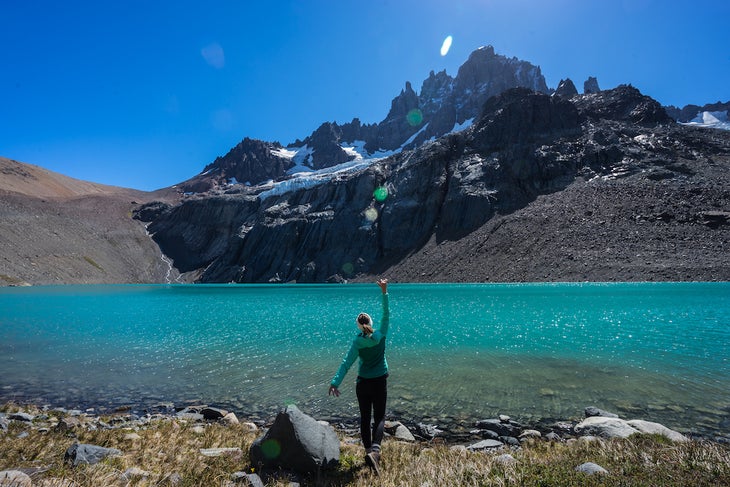
Cerro Castillo, Villa Cerro Castillo, Chile
Length: Approximately 30 miles (48 kilometers) Difficulty: Moderate to Challenging Access: The trail begins in Villa Cerro Castillo, accessible by bus or thumb from Coyhaique.
One of the more remote suggestions on this list, Cerro Castillo is an aquamarine lake at the base of a crown of jagged mountains. Although there are many such lakes and views in Patagonia, this is one of just a few that you can get all to yourself. The tiny, rural town along the Carretera Austral only has a few homestays, but it’s one of the more authentic places to lay your head in all of Patagonia, and few other tourists ever visit.
Want to cut this hike a little short? The “emergency route” is a steep one-day hike from the lake to town, and despite the name is accessible for general, non-emergency travel too. Cut your backpacking trip short by taking this route as an early bailout point, or use it as a steep dayhike to see the lakeside views . Either way, you can tote a tent and overnight at the lake (leaving no trace, of course), or spend the night in Villa Cerro Castillo near the trailhead.
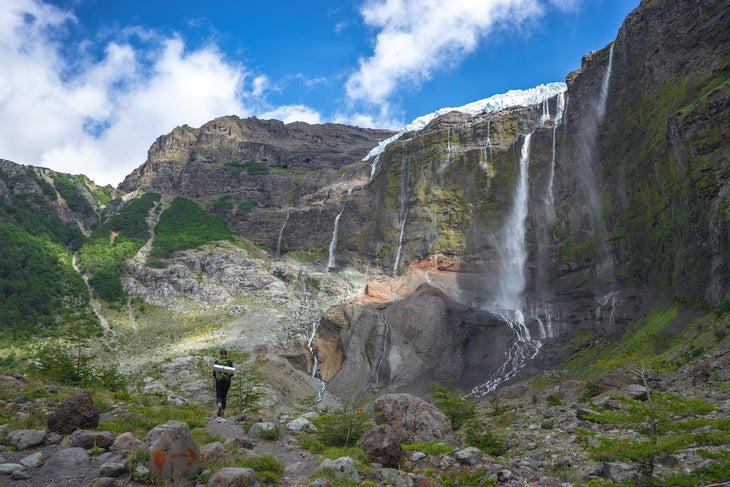
Tronador, Bariloche, Argentina
Length: Typical route is 8.7 miles (14 kilometers) Difficulty: Moderate to challenging Access: Bariloche is a common starting point for Tronador hikes, with buses connecting from nearby towns.
Widely considered the gateway to Patagonia, Bariloche is a town of lakes, mountain peaks, and ski lifts in the winter. Though there are many gorgeous hikes in the area, the Tronador is my favorite for the cascading waterfalls and the chance to set up camp on the mountain peak. The mountain bisects the borders between Argentina and Chile, but the easiest access point is on the Argentine side.
The path to Tronador weaves through ancient forests and alpine meadows, leading to a glacier-clad summit with next-level stargazing . There’s a small refugio, but most visitors tote a tent and spend the night tucked into the rocky landscape.
Popular on Backpacker
Related content from the outside network, what’s it like to go on a 200-person hike better than you think., how to pack for backcountry skiing, the original yosemite firefall, hiker charges mountain lion.

The Ultimate Guide to Patagonia Hiking: 2024 Edition
Set out for an epic adventure in Patagonia Hiking. Our 2024 guide gives expert advice on gear, preparations, top trails, and must-see sights!
Patagonia, a region located at the southern end of South America, offers some of the most breathtaking landscapes and challenging trails for hiking enthusiasts. With its rugged mountain ranges, vast glaciers, and picturesque lakes, it provides a dramatic backdrop for an unforgettable outdoor adventure. Whether you’re an experienced hiker looking for a new challenge or someone who wants to immerse yourself in the beauty of nature, Patagonia has a variety of trekking routes to satisfy every level of outdoor enthusiast.
Your journey through Patagonia’s trails will not only test your physical strength but will also reward you with encounters with diverse wildlife, insights into unique local cultures, and views of remote, unspoiled wilderness. Before you set out, it’s important to prepare and plan thoroughly, taking into account the remote nature of the area, the variable climate, and the necessary gear . With the right preparation, your Patagonia hiking trip has the potential to be a life-changing experience, leaving you with lasting memories and stories to share.
Key Takeaways
- Patagonia is a top destination for diverse hiking experiences, offering trails for all skill levels.
- Preparation is crucial, considering Patagonia’s remote terrain and variable weather.
- A successful trip includes encounters with unique wildlife, cultural insights, and stunning natural beauty.
Planning Your Patagonia Hiking Trip
Embarking on a hiking adventure in Patagonia requires careful planning. It’s important for you to choose the best time for your trip, determine a personalized itinerary, and understand the regulations of the parks you intend to visit.
Choosing the Right Season
Best Time to Go Hiking in Patagonia: The optimal season for your hike largely depends on the weather conditions and crowd preference. Peak Season for hiking in Patagonia spans from November to early March , when the weather is most favorable. However, be prepared for more companions on the trail as this is also the busiest period.
Determining Your Itinerary
Plan Your Routes: Carefully consider which places you want to explore. For a truly unique experience, mix well-known trails with some off-the-beaten-path routes. Start with accessible areas and gradually venture out to more challenging hikes based on your experience and fitness level. Always keep in mind the distance and terrain difficulty when planning.
Understanding Park Regulations
Park Permit and Regulations: Specific areas in Patagonia may require you to obtain a permit before hiking. Regulations can include designated camping sites, limited numbers of hikers per day, and mandatory guides for certain trails. Adhering to park rules ensures your safety and preserves the pristine environment for future adventurers.
Hiking Essentials and Gear
When setting out for a Patagonia hike, choosing the right clothing and gear is critical to ensure comfort and safety. Packing a functional backpack with essential items will enhance your hiking experience.
Selecting Suitable Clothing
Your choice of clothing for a Patagonia hike should prioritize functionality and adaptability to varying weather conditions. Start with a moisture-wicking base layer to keep dry and add an insulating fleece or a lightweight down jacket for warmth. Outer layers should be windproof and waterproof to protect against the elements. Opt for quality brands that are known for their durability and performance in outdoor environments.
- Base Layer: Moisture-wicking material
- Insulation: Fleece or lightweight down jacket
- Outer Layer: Windproof and waterproof garments
Top Hiking Gear to Carry
The right hiking gear can make a significant difference in your Patagonia adventure. A sturdy pair of hiking boots is essential for traction and support. Additionally, consider packing a reliable sleeping bag if you plan to camp, and a multitool for various tasks on the trail.
- Footwear: Durable hiking boots
- Multitool: For cutting, repairs, and more
- Sleeping Bag: Rated for the expected temperatures

Packing a Functional Backpack
Your backpack is your portable basecamp; it should contain everything you need without being overpacked. Ensure it has enough capacity and pockets to organize your gear. Essential items include a map, compass, water, snacks, first aid kit, and a headlamp. Balance the load in your backpack for comfort and pack heavier items closer to your back.
- Navigation: Map and compass
- Hydration: Water bottle or hydration system
- Nutrition: High-energy snacks
- Safety: First aid kit and headlamp
- Organization: Balance load and use pockets effectively
Remember to tailor your gear to the specifics of your hiking trip, considering the length of your journey, weather forecast, and personal needs. Happy hiking!
Weather Patterns and Climate
Exploring Patagonia means preparing for its unpredictable weather patterns. The region’s climate can shift rapidly due to its geographic placement, and knowing what to expect will keep you safe and comfortable on your hikes.
Understanding the Wind
Patagonia is famous for its strong and incessant winds , especially during the summer months. The wind can be relentless and sudden, testing even the most experienced hiker’s preparedness and resilience. When you’re planning a trek , always check local wind conditions and consider starting early in the day when the wind is often calmer.
- Checking Wind Forecasts : Regularly consult with local weather stations for up-to-date wind conditions.
- Sheltered Routes : Select hiking paths that offer natural windbreaks such as valleys or forested areas.
- Secure your Gear : Ensure all gear is tightly secured to prevent loss or damage.
Preparing for Rain and Snow
Your hiking experience can be affected by the frequency of rain and snowfall in Patagonia. Winters bring snow, particularly from June through August, while rain can be a year-round occurrence. Adequate preparation for these weather conditions is essential for a safe hiking experience.
- Waterproof Clothing : Invest in high-quality waterproof clothing to stay dry and comfortable.
- Layering : Utilize a layering system to adapt to changing temperatures and conditions.
- Know Your Route : Be aware that snow can obscure trails. Stay on marked paths and be prepared to turn back if conditions worsen.
By understanding and preparing for Patagonia’s winds, rain, and snow, you’ll ensure a memorable and secure hiking adventure.
Trail Profiles and Trekking Routes
In Patagonia, your hiking adventure will be defined by the trails you choose, each with its distinct beauty and challenges. From the renowned towers of Torres del Paine to lesser-known, equally breathtaking circuits, you’re set for an unforgettable trekking experience.
Famous Treks: W Trek and O Circuit
W Trek : The iconic W Trek is your ticket to some of the best sights in Torres del Paine National Park . Covering approximately 70 kilometers, this trek can be completed in about 4 to 6 days. You’ll witness the park’s most famous landmarks like the Base Torres lookout, French Valley, and Grey Glacier. Each night, rest at designated campsites or refugios dotted along the path.
O Circuit : For a more extensive experience, the O Circuit encompasses the W Trek and adds a northern section, giving you a full loop of the park. This trek is roughly 110 kilometers and typically takes 7 to 10 days to complete. The backside of the circuit is less crowded, allowing for intimate encounters with Patagonia’s wild side.
Hidden Gems: Huemul Circuit and Others
Huemul Circuit : If you’re seeking a trail less traversed, embark on the Huemul Circuit. This challenging route spans about 70 kilometers, taking you through remote parts of the southern Patagonian Ice Field. Over 4 to 5 days, your journey will involve glacier navigation, steep ascents, and potentially using a harness and rope for river crossings.
Additionally, you’ll find plenty of other hidden gems in Patagonia offering serene landscapes away from the main trekking routes. Trails like the Dientes de Navarino or the Loma del Pliegue Tumbado provide unique views and solitary treks. While they may lack the fame of the best hikes and treks in typical guidebooks, their untouched beauty makes them a true hiker’s delight.
Notable Destinations
Exploring Patagonia offers a symphony of natural wonders, including majestic mountains and breathtaking panoramas. The trails leading through this vast wilderness cater to your thirst for adventure and visual splendor.
Torres Del Paine National Park
Torres Del Paine National Park in Chile is a magnet for hikers worldwide, with its iconic horn-shaped peaks of the Paine Massif. Embarking on treks like the W Circuit, you’ll encounter the park’s gem, the Base of the Towers, famed for its dramatic granite monoliths and emerald waters.
Los Glaciares National Park
Adjacent to Chile in Argentina, Los Glaciares National Park encompasses a portion of the Andes range. The park invites you to witness colossal ice formations, serene forests, and alpine meadows. And, no Patagonia trek is complete without a Perito Moreno Glacier Hike organized by tour planners who are experts in glacial hiking.
El Chaltén and Fitz Roy
Considered Argentina’s trekking capital, El Chaltén serves as the gateway to trails leading to Mount Fitz Roy and Cerro Torre . The trek to Laguna de los Tres rewards you with unparalleled views of Fitz Roy’s daunting spires, while Cerro Torre beckons climbers with its sheer ice-clad face and challenging ascents.
Wildlife and Natural Attractions
Patagonia is a land of ethereal beauty, with its vast expanses offering you an array of natural wonders and wildlife spectacles. From the majestic pumas to the awe-inspiring glaciers, prepare to be enchanted by the raw beauty of this pristine wilderness.
Encountering Patagonian Fauna
As you trek across the rugged terrain, keep your eyes peeled for the emblematic guanacos , relatives of the llama and a common sight in the Patagonian steppes. Their elegant stature and curious gaze make a serene moment on your hike. The skies above often host the impressive Andean condors , soaring with a wingspan that can reach up to an impressive three meters. The opportunity to witness these grand birds in flight is a memory that will last a lifetime. If fortune favors you, a glimpse of the elusive puma could be the highlight of your journey. These magnificent predators are the apex of Patagonian wildlife, embodying the untamed spirit of the region.
Exploring Glaciers and Ice Fields
Patagonia’s glaciers are colossal rivers of ice, etching their way through the Andes and sculpting the landscape as they go. Among the icy expanses, the Patagonian Ice Field stands out as one of the largest expanses of ice outside the polar regions. A trek here means tracing the edges of ancient ice, where the air is crisp and the views, of blue-tinged ice against the stark mountain slopes, are unforgettable. Remember, while the glaciers are a hiker’s paradise, they are also delicate environments that require our respect and care to preserve their timeless beauty.
Safety and Difficulty Levels
When planning your hike in Patagonia, understanding the trail difficulty and ensuring proper emergency preparedness are paramount to both your safety and enjoyment. Different trails pose varied challenges, from gentle paths to demanding climbs, and unforeseen circumstances can arise, requiring self-sufficiency and readiness.
Assessing Trail Difficulty
Before setting out, assess the trail difficulty to match your skill level. Difficulty can range from easy walks, like those found on some well-maintained paths near popular tourist sites, to highly technical climbs necessitated by the rugged Patagonian terrain. Consider the following factors:
- Trail length: Longer trails require more stamina and provisions.
- Elevation gain: Steep sections may be challenging for inexperienced hikers.
- Terrain type: Unstable ground such as scree or snow increases difficulty.
- River crossings: Be prepared for potential fords, which can be hazardous due to strong currents or sudden changes in the water level.
For practicality, classify trail difficulty using a simple system:
- Easy: Flat terrain, no experience required.
- Moderate: Some elevation gain, basic hiking skills advised.
- Difficult: Steep climbs, technical skills recommended.
Check online resources like the detailed accounts found in Enduring Patagonia to gauge what to expect.
Emergency Preparedness
Your safety on the trail is crucial and requires preparation for emergencies. The unpredictable Patagonian weather and isolated stretches necessitate taking appropriate measures:
Essential safety items to pack:
- Navigation tools: Map, compass, and GPS device.
- Protection: Sunscreen, hat, and layers to accommodate rapid weather changes.
- Rations: Enough food and water, plus purification methods for longer hikes.
- Emergency gear: First aid kit, multi-tool, emergency shelter, and a whistle.
Keep in mind that you must be self-reliant; rescue services may not be readily available in remote areas. Prepare by learning essential skills, equipment, and safety techniques beforehand. Inform someone of your itinerary and expected return, and always pack a charged cellphone or a satellite communicator for critical situations.
Accommodation and Campsites
When planning your Patagonia adventure, you’ll need to decide where you’ll rest each night. Your choices can range from pitching a tent at campsites or staying in more structured accommodations known as “refugios”.
Choosing Between Camping and Refugios
Camping: If you’re looking to immerse yourself in the Patagonian wilderness, camping is an excellent choice. You’ll carry your own tent and set it up at designated campsites. The sense of adventure is unparalleled, and you’re likely to have a more intimate experience with nature. However, this means you’ll be responsible for your own gear and comfort.
Refugios: On the other end, refugios provide a more comfortable but rustic shelter, akin to mountain huts. For instance, Refugio Grey is a sought-after destination for its stunning views and amenities. Here, you can appreciate the outdoors during the day and return to a warm bed at night.
Booking and Costs
Booking: It’s crucial to book your campsites or refugio stays well in advance, especially during peak season. The accommodation options in Patagonia, particularly in popular areas, can fill up quickly. Ensure you secure your spot early to avoid any changes to your hiking itinerary.
Costs: Expect to pay for the convenience of refugios, as the prices are typically higher than campsites. Campsites offer a budget-friendly alternative, but costs can vary depending on location and the level of facilities provided. Camping generally requires a fee for pitching your tent, while refugio prices reflect the added comfort and services. Always check the latest fees and consider that these are subject to change.
Luxury Tour Operators
There is another option for those who are looking for a premium way to experience Patagonia. Top tour operators specialize in crafting luxurious Chilean adventure tours that encompass an array of exhilarating experiences. From luxury accommodations to fully planned itineraries and tour packages, these companies provide a valuable service for travelers who appreciate a more concierge-level approach to travel.
Cultural Insights and Local Life
Exploring Patagonia through hiking offers more than breathtaking landscapes; it’s an immersion into the rich tapestry of cultures that inhabit Southern Chile and Argentina. As you lace up your boots and set out on the trails, you’ll encounter the vibrant communities and the enduring spirit that define this rugged region.
The People of Patagonia
The soul of Patagonia is etched deeply into the faces of its people; a blend of indigenous communities like the Mapuche , descendants of European settlers, and hardy locals who have adapted to the windswept plains and peaks of this remote area. In towns like Punta Arenas or Ushuaia , the world’s southernmost city, you’ll likely meet these warm, resilient individuals. You might share a mate , a traditional caffeine-rich infused drink, and hear stories that are as captivating as the landscape itself. Whether you’re navigating the trails near Tierra del Fuego or setting up camp at Campamento Poincenot, each encounter adds a personal touch to your adventure.
- Mapuche Community : Traditionally from the northern Patagonian region, known for their rich cultural heritage and deep connection with the land.
- Settlers’ Descendants : Families from Europe who arrived in the 19th and 20th centuries, bringing their own customs that have since blended with local traditions.
- Local Patagonians : People born and raised here, often sharing a love for the untamed wilderness of Patagonia and a spirit of self-sufficiency.
The Spirit of Southern Chile and Argentina
Patagonia is split between Chile and Argentina , each side offering its own unique cultural experiences connected by the majestic backdrop of the Andes Mountains. In Chile, the region’s spirit is felt through vibrant cultural practices and a deep respect for the stunning environment. Across the border in Argentina, the gaucho culture adds to the mystique of Patagonia, where the lone horseman riding across the steppe symbolizes freedom and strength. As you traverse this land, from the mountains of Tierra del Fuego to the bustling streets of Ushuaia , the spirit of the south is evident in everything from the food you’ll taste to the music you’ll hear softly echoing through the valleys.
- Chilean Patagonia : Known for its intricate fjords, temperate rainforests, and the iconic Torres Del Paine National Park.
- Argentine Patagonia : Home to vast steppes, deserts, and the distinctive Patagonian ice fields.
Logistics and Travel Tips
When preparing for an exhilarating hiking adventure in Patagonia, it’s crucial to consider transportation options to access various trails and to understand the visa and entry requirements that may apply to you.
Transportation and Routes
To start your journey in Patagonia, you’ll likely fly into El Calafate , which serves as a gateway to the region’s renowned national parks and trekking routes. The town offers bus services to key hiking destinations such as the iconic Torres del Paine National Park or the more secluded Caleta Gonzalo in Chile. To optimize your travel:
- Plan ahead: Book airport shuttles or bus tickets in advance, especially during peak trekking seasons.
- Local transit: Renting a car can give you flexibility, but be prepared for potentially rough Patagonian roads.
For backpacking routes:
- Torres del Paine: Find guided tours or embark on the famous W Trek or the longer O Circuit, ensuring you have the necessary permits.
- Caleta Gonzalo: This is a less-traveled path but offers stunning vistas; arrive via the Carretera Austral or boat from Chaitén.
Visa and Entry Requirements
Before you travel, make sure you understand the visa requirements for entering Chile or Argentina, depending on your itinerary in Patagonia.
- Check your status: Determine whether you need a visa based on your nationality. Many travelers can enter visa-free for short periods.
- Travel documents: Ensure your passport is valid for at least six months from your planned date of entry.
Keep these logistics and travel tips in mind as you plan for an unforgettable hiking experience in Patagonia. With proper planning and an understanding of the travel requirements, you’ll be set to enjoy the breathtaking scenery and challenging trails that await.
Frequently Asked Questions
When planning your next adventure in Patagonia, certain details can make all the difference. Here are the answers to some frequently asked questions to ensure you’re well-prepared for your hiking journey.
What are some recommended day hikes to experience in Patagonia?
Patagonia offers a variety of day hikes, from the picturesque Laguna de los Tres near El Chaltén, offering stunning views of Mount Fitz Roy, to the Mirador Las Torres trail in Torres del Paine National Park.
What type of clothing is best for hiking in Patagonia?
For hiking in Patagonia, layering is key. Choose moisture-wicking fabrics for your base layer, an insulating fleece or down jacket for warmth, and a waterproof, wind-resistant outer shell.
Could you suggest some resources to find reliable hiking maps of Patagonia?
Reliable hiking maps of Patagonia can be found at local outdoor shops, national park visitor centers, or through online retailers specializing in topographic maps.
Are there guided tours available for hiking in Patagonia, and how do I choose one?
Yes, there are many guided tours available for hiking in Patagonia. When choosing one, consider factors such as the guide’s experience, group size, itinerary, and included amenities.
What kind of footwear is most suitable for the trails in Patagonia?
Trail-appropriate footwear is essential in Patagonia. Choose waterproof hiking boots with good ankle support and aggressive tread for stability on uneven terrain.
What should I consider when selecting a backpack for my Patagonia hiking trip?
When selecting a backpack for your Patagonia hike, prioritize comfort, capacity, and durability. Ensure it has enough space for your gear and is fitted with a supportive waist belt and shoulder straps.

Scott Meldrum
Scott founded FunOutdoors to connect his professional life with his passions. When Scott isn’t working, you’ll find him on the bike trail, riding a wave, or skiing down a mountain.
Related Content

Hiking in Sicily: Exploring the Island’s Best Trails

Discover the Beauty of Hiking in Croatia

My Day On The Trails With Silverlight Hiking Shorts & Socks

Top-Rated Hiking Backpack for Women: 2024 Gear Guide

Step Up Your Hike: Expert Picks for the Best Hiking Pants in 2024

Top-Rated 2 Person Backpacking Tents for 2024
- Trekking & Hiking in Patagonia
10 Stunning Treks & Hikes in Patagonia for 2024-2025
Patagonia wildlife safari.
- Classic W Trek
Hiking Los Glaciares
- Patagonia Hiking Express
Torres del Paine Multisport
End of the world.
- Fitz Roy & Glaciers Trekking
Discover Aysen
Fjords of tierra del fuego: punta arenas to ushuaia.
- Ultimate Patagonia Trekking
Patagonia Trekking & Travel Guide
Bioregions of patagonia.
- Patagonia- The Last Refuge of Nature
- Glacier trekking - test your mettle as you make your way across these massive sheets of ice that sprawl across South America.
- Kayaking or zodiac cruising among the fjords.
- Check out the Perito Moreno Glacier , three miles long and more than 20 stories high.
- Witness incredible waterfalls.
- Hike the Fitz Roy Range.
- Eco-camping
- Luxury trips here
- Patagonia cruises
- History and Geography of Patagonia
Tierra del Fuego- The Southernmost Point in the World
- Tierra del Fuego Culture
- Perito Moreno Glacier
- Tierra del Fuego (Argentina & Chile): The southernmost part of South America
- Torres del Paine (Chile): Home to many of the iconic mountains, icebergs, and fjords of Patagonia.
- El Calafate (Argentina): The best place to access the Perito Moreno Glacier.
- Ushuaia (Argentina): The departure point for many Antarctica cruises.
Patagonia Travel Videos
Patagonia Trekking Stories
Elusive patagonia, tres amigos en patagonia, patagonia travel guide.
- All Patagonia Trips
- Punta Arenas
- Torres del Paine
- Luxury Patagonia Cruises & Tours
- Patagonia Lodges
- Patagonia FAQs
- Patagonia Lowdown: Low Elevation South America Treks
- Best Time of Year to Visit Patagonia
Favorite Patagonia All Trips
- Highlights of Southern Argentina
- Tierra del Fuego Explorer
Top Patagonia Travel Destinations
- Ainsworth Bay
- El Calafate
- Magdalena Island
- Puerto Natales
- Tierra del Fuego National Park
Patagonia Trips by Departure Date
- 2024 Patagonia trips (87)
- 2025 Patagonia trips (92)
- 2026 Patagonia trips (59)
- October 2024 (64)
- November 2024 (70)
- December 2024 (74)
- January 2025 (74)
- February 2025 (72)
- March 2025 (74)
- April 2025 (54)
- November 2025 (53)
- February 2026 (54)
Top Experiences in Patagonia
- Patagonia Land Tours (43)
- Patagonia Cruises (41)
- Patagonia Wildlife & Safari Exploration (27)
- Patagonia Active (23)
- Patagonia Trekking (16)
- Patagonia Luxury (10)
- Patagonia Cultural (9)
- Patagonia Family (8)
- Patagonia Most Popular (7)
- Patagonia Solo Travel (5)
Patagonia Trips by Duration
- 5 day trips (19)
- 6 day trips (10)
- 7 day trips (9)
- 8 day trips (8)
- 9 day trips (10)
- 12 day trips (4)
- 13 day trips (6)
- 15 day trips (4)
- 17 day trips (4)
- 18 day trips (3)
Patagonia Trips by Activity
- Patagonia wildlife viewing (62)
- Patagonia hiking (46)
- Patagonia small ship cruises (36)
- Patagonia kayaking (26)
- Patagonia whale watching (21)
- Patagonia horseback riding (18)
- Patagonia camping (15)
- Patagonia adventure options (15)
- Patagonia wilderness lodge exploration (8)
- Patagonia village visits (7)
- Patagonia whitewater rafting (7)
- Patagonia wine tasting (7)
- Patagonia land & sea exploration (6)
- Patagonia fishing (6)
- Patagonia spa relaxation (6)
- Patagonia biking (5)
- Patagonia photography seminars (4)
- Patagonia skiing (4)
- Patagonia snorkeling (3)
- Patagonia local market visits (3)
- Patagonia urban exploration (3)
- Patagonia fly cruises (3)
Why Travel With Adventure Life
Recognized by.


Latin America
Patagonia Hiking Tours
Hiking journeys to the end of the world.
Patagonia is a land of superlatives. Stretching over the vast wilds of southern Argentina and Chile, it is a land heralded for its singular beauty. For over four decades, we’ve been exploring this masterpiece of nature and crafting unique itineraries that show you the best of the region’s most dramatic realms—with hikes on magnificent trails you’ll have practically to yourself and overnights in renowned estancias. Experience the end of the earth in WT-style!
All Trips to Patagonia
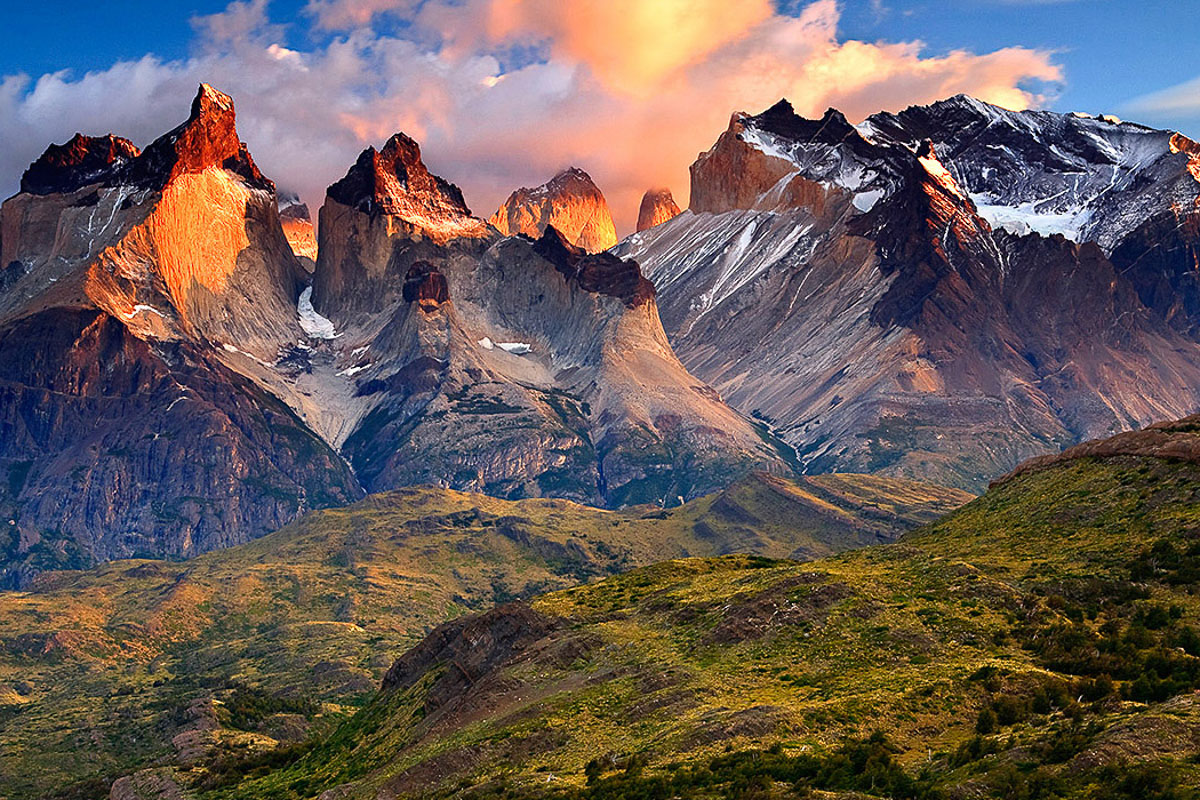
Small Group Adventure
Ultimate Patagonia
Chile, Argentina
From $11,595
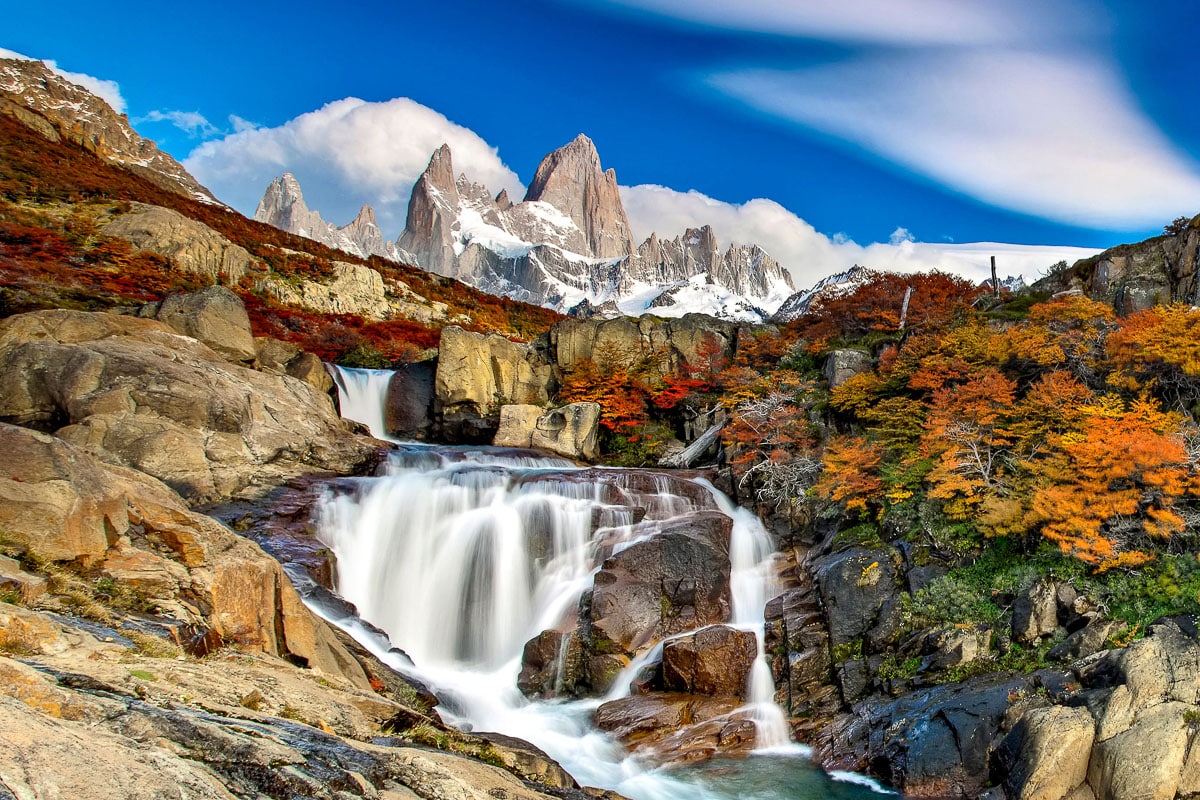
Argentina: Hikes and Estancias of Patagonia
From $9,295
Patagonia: Tracking Pumas and Cruising the Fjords
Argentina, Chile
From $13,295
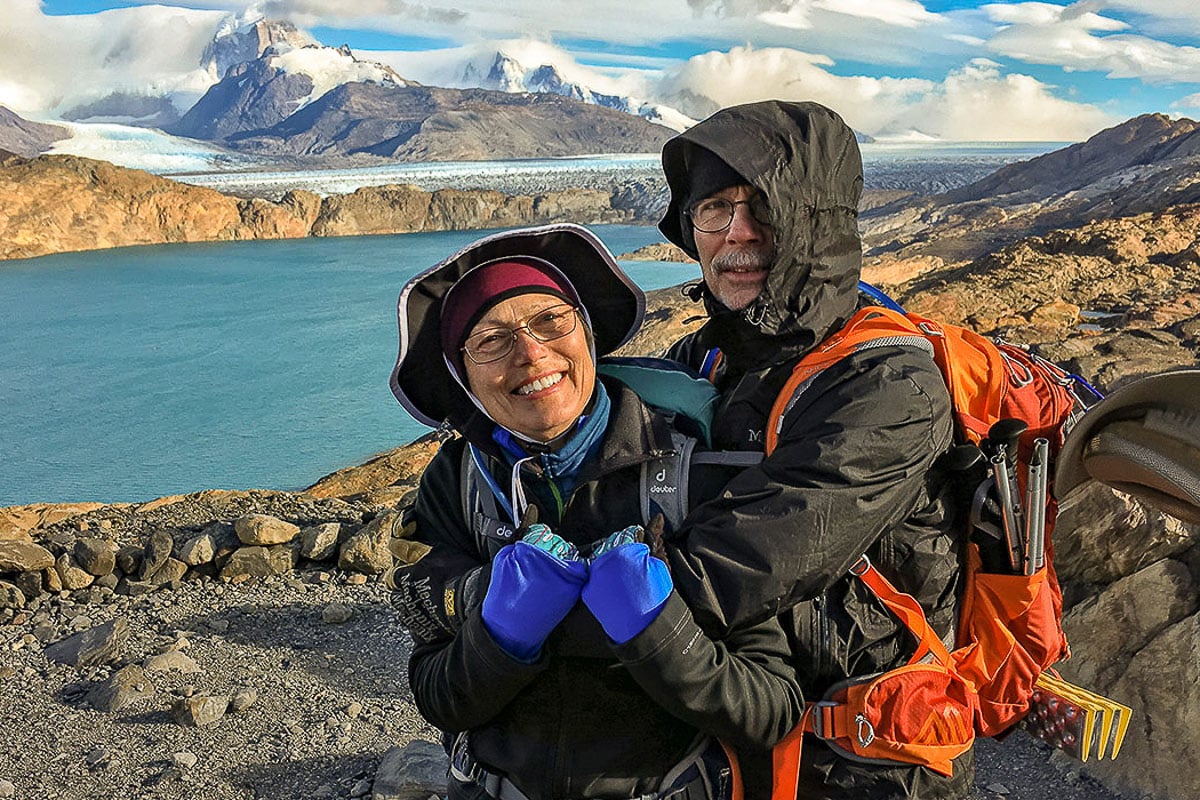
Private Journey
Argentina Private Journey
From $5,695
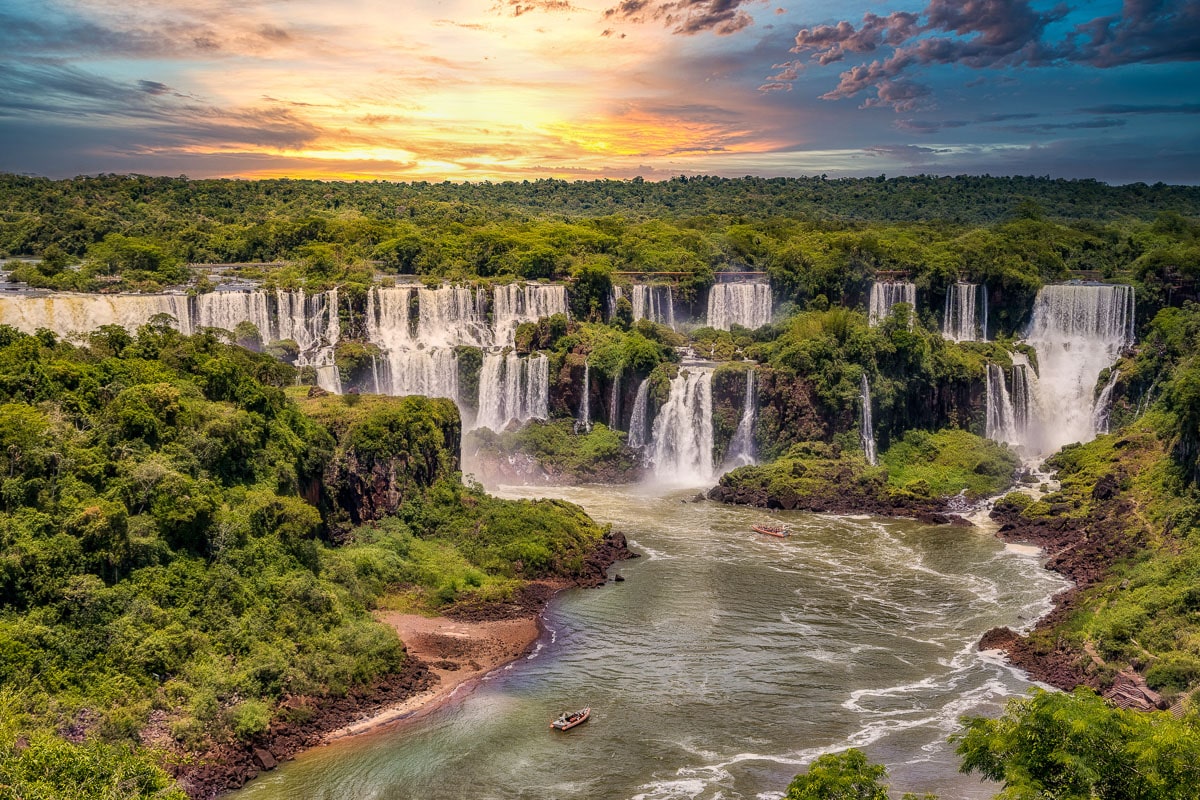
Argentina Family Private Journey
From $4,095
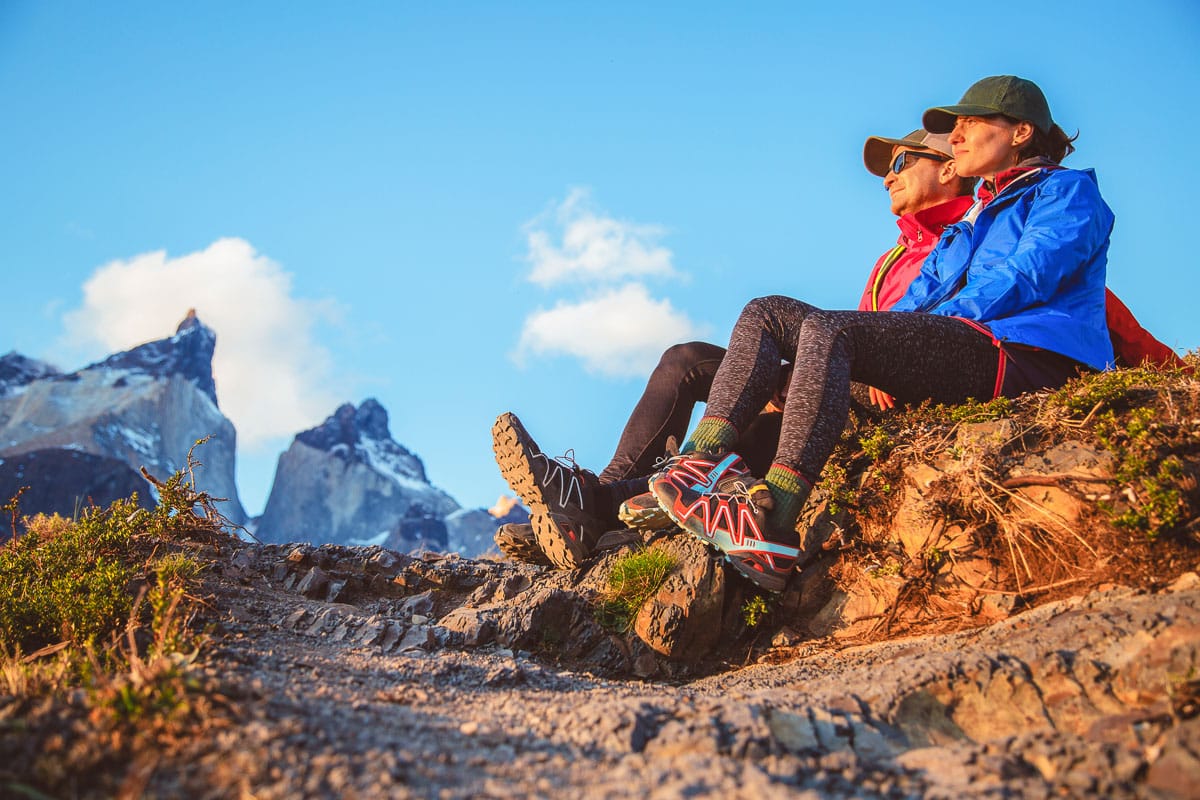
Chile Private Journey
From $5,995
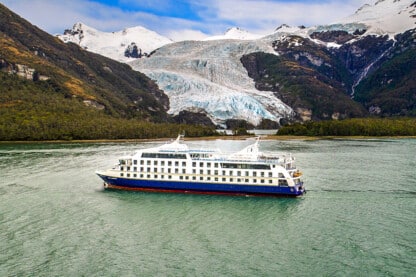
Cruise Collection
Darwin’s Route: Cruising through Patagonia
From $4,236
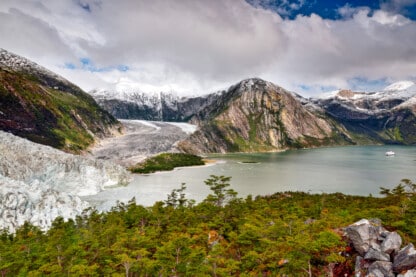
Tierra del Fuego Cruise, Punta Arenas to Ushuaia
From $2,375
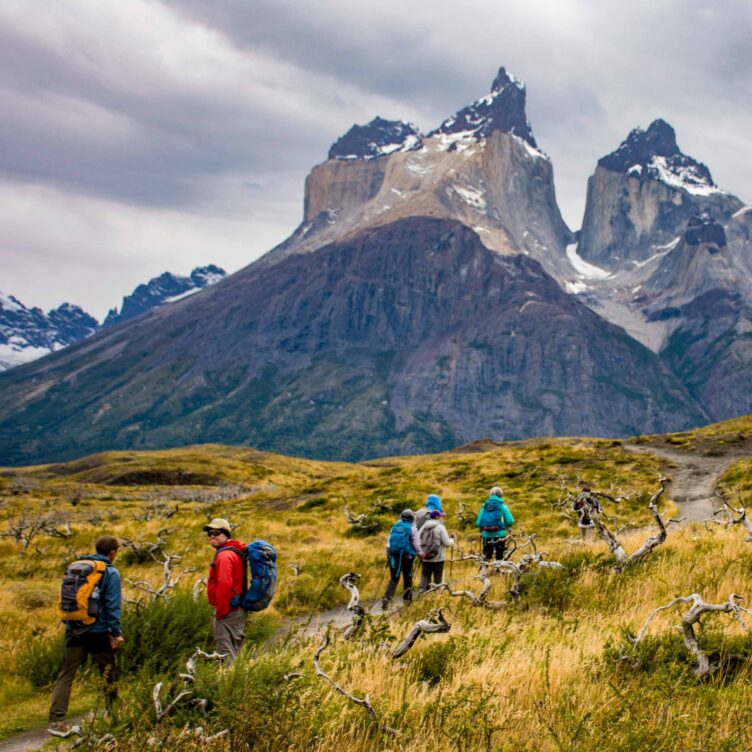
What Makes Our Patagonia Trips Special?
- The Absolute Best of Patagonia — We’ll take you to the most iconic places including Fitz Roy, Torres del Paine, and Tierra del Fuego, hiking by day and being welcomed at boutique hotels and heritage estancias by night.
- The Right Pacing to Truly Experience Patagonia — Patagonia is vast, and its weather is notoriously changeable—you can’t rush this trip, or you may never see the mountain views, much less truly experience its amazing parks.
- Insider Access to Exclusive Accommodations — Our decades-long relationships in Patagonia give you special access to some of Patagonia’s most renowned estancias and lodges. We usually have sole access to each of these boutique accommodations.
- Superb Trip Leaders and Expert Local Guides — Our Trip Leaders have decades of experience and incredible knowledge to share. You’ll be introduced to countless locals along the way and given a wonderful insider’s experience.
- Comfortable Travel — Travel here requires a few long drives, but we do it in comfort, with a redesigned bus that has half the seats removed, doubling your legroom—and we make plenty of stops for photography and wildlife spotting.
Everything You Need to Know
We time our trips for Patagonia’s ideal hiking weather, from late November through early March, when we can enjoy the mildest temperatures and 16 hours of daylight.

An immense, wild territory covering over 400,000 square miles of Chile and Argentina, Patagonia spans the entire southern tip of South America, and has endless wild territory to explore. Our trips allow you to experience the best regions of this vast wilderness area: Tierra del Fuego, Los Glaciares, and Torres del Paine.
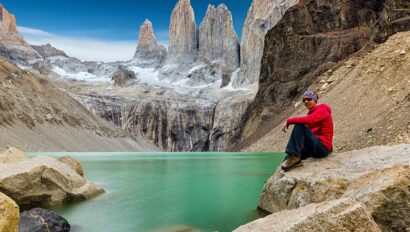
Patagonia offers everything from long through-hiking treks to short leisurely walks. Our team of experts hand-pick the very best parts of these trails that show you the most magnificent vistas while staying away from the crowds. See here for just a few of our top picks.
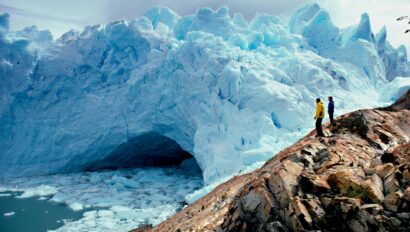
Not sure which Patagonia adventure is best for you? See below for a side-by-side comparison of our itineraries to help make your decision easier. Still unsure? Our Latin America Area Specialists are happy to answer any questions and explain the journeys in greater detail.
Our long-term relationships in Patagonia give you the privilege of insider access. The boutique, family-owned lodges and estancias we partner with are a highlight of our Ultimate Patagonia and Estancias of Patagonia journeys for many guests, welcoming us in at the end of each day with a glass of Malbec and a roaring fire. In many of the lodges, we will have the whole property for our group alone, and as Patagonia becomes more and more popular as a destination, this kind of special access is increasingly hard to find.
We’ve been staying at some of the estancias for 30 or more years. They know us, and we know the wonderful families, hosts, and long-time staff members who make these accommodations feel like home in the wilderness. They are not “fancy” per se, but instead are genuine, inviting, secret hideaways that you will long remember. We start with a bang at El Pilar, a storybook lodge on the edge of Argentina’s Los Glaciares National Park, where Fitz Roy is framed by the dining room window and the home-cooking is superb. El Pilar sits right on the trail of one of the best hikes in the park, and is run by a wonderful couple, Guillermo and Cristina. Estancia Helsingfors is way off the road, exclusive to our group, and has the most magnificent setting imaginable (we even have the trails to ourselves here).
Experience Patagonia
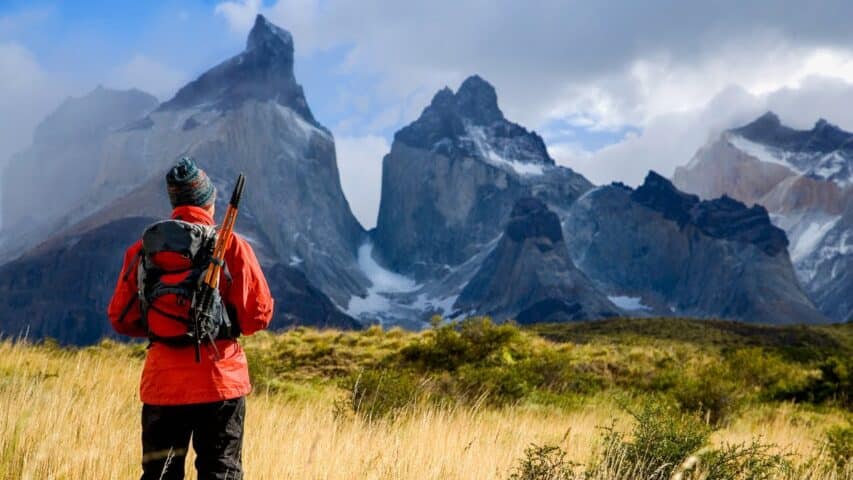
Extend Your Trip
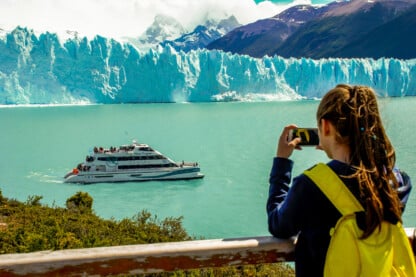
Patagonia Family Extension
From $2,795
REVIEWS FROM OUR CLIENTS
You could not have designed a better itinerary. Every day, every lodge, every meal, every experience was (unbelievably) better than the day before. Thank you for making this a phenomenal travel experience that I’ll remember for a lifetime.
We were so well taken care of—lovely hosterias, in unbelievable settings, always comfortable, and fantastic food.
The trip design was brilliant. Each day we thought we had captured “the prize” but the next day was even better. How did you do this?
The trip totally surpassed my expectations. Patagonia was absolutely breathtaking and one of the most spectacular travels I have had so far.
A fabulous itinerary, with spectacular scenery and hiking opportunities, wildlife, lodge comfort, quality dining, and no altitude—wow!
A 5-star experience—unforgettable, well organized, planned, paced.
Our Patagonia experience seemed surreal. Breathtaking views, outstanding Trip Leaders, and excellent lodging.
Of all nine of our wonderful WT adventures, Patagonia is one of our most memorable. The combination of outstanding WT staff and a truly magical place (plus the good fortune of great weather) made this trip a ‘life list’ experience for us!
This was a trip of a lifetime. I loved, loved, loved the hiking, the views, the corners turned to find a spectacular glacial lake, towering rocks, a glacier swooping down, a waterfall. What more could a person want??
Impeccable itinerary and outstanding implementation. Every day delivered a new ‘oh my’ because of the variety of the scenery and experiences. Thanks, Wilderness Travel!
Loved the variety, from penguins and glaciers, to high deserts and craggy mountains.
This was a truly exceptional trip where we felt that we were able to fully experience the Patagonian wilderness but from the relative comfort of some wonderful small hotels and estancias.
Talk to an Expert
Our Latin America Specialists know every detail about our Patagonia trips. They will be happy to answer any questions and help you choose the journey that’s right for you. Contact us to learn more or book your trip today!
Hrmm. Looks like you're using an older browser, which means some site features may not work they way they should. For the full gadventures.com experience, we recommend upgrading to the most recent version of your browser . It's worth it! Honest!
View all tours
North America
Central america & caribbean, south america, north africa & middle east.
Few travellers make it to this icy continent, but the lucky ones who do get to explore a frozen Eden ruled by the elements and teeming with wildlife.
G Adventures Land
G adventures sailing & cruises, g adventures private travel.
Whether it’s a family retreat or a girls trip, you can surround yourself with a hand-picked crew and customize a tour that fits you all perfectly.
The Geluxe Collection
Our new line of premium active adventures is officially here. With perfectly paced itineraries, one-of-a-kind accommodations and elevated dining, this is adventure at its finest.
National Geographic Journeys
Go deeper into the cultures and habitats of the places we explore. More is included and you’ll enjoy greater hands-on exploration, interactions with local experts, and freedom to roam.
National Geographic Family Journeys
Are you an adventure-loving family in search of meaningful ways to discover the world together? These tours are specially designed for travellers seven and up and their inquisitive families.
Jane Goodall Collection
Step deeper into the animal kingdom while respecting all of its inhabitants. Our incredible collection of wildlife-focused tours is endorsed by the world-renowned ethologist.
Roamies by Hostelworld
The thrill of adventure. The awesomeness of hostels. Get ‘em both on these immersive small group trips for 18 to 35-year-old travellers.
Why choose us
As the leader in small group travel for 30 years, we know how to do it right: flexible itineraries, freedom to roam, safety, peace of mind, and locally based guides.
Change the world just by having the time of your life. When you travel with us, you become a force for good by acting responsibly and creating positive impact.
Together with our non-profit partner, Planeterra, we ensure local communities touched by our tours benefit from our visits in as many ways possible.
Trees for Days
Leave your destination even greener than you found it! For every day on tour, we’ll plant a tree in your honour and ensure that our forests get to live their best lives.
Travel resources
Last minute deals.
Looking to have the time of your life in the next 90 days or so? You can save big if you’re ready to book now.
Loyalty discount
Back home from a G Adventures tour? Submit a quick trip evaluation to save 5% on your next tour with us.
Student discount
Got proof that you’re pursuing higher learning? Then we’ve got a travel voucher with your name on it.
All travel deals
New ways to save pop up all the time. Here’s where you’ll find every hot deal in one easy place.
Patagonia trekking

- Inca Trail tours
- Kilimanjaro
The wild, wild... south?
You’d be hard-pressed to identify a part of the world that can top Patagonia for natural splendour. And once you’ve seen it for yourself, you won’t even bother to try. The scenery down here at the south tip of south America is a photographer’s dream come true: stunning volcanic landscapes, massive glaciers, sprawling steppe-like plains stretching to the horizon... your shutter-finger is due for an intensive workout. Throw in rich cultural traditions, world-class food and wine, and the thriving nightlife of the big cities and you’ll wish you’d bought a one-way ticket. Adventure lovers, welcome home.
The great(est) outdoors
Words and pictures only give a flavour of Patagonia’s rugged beauty. We make sure your adventures here are up-close and personal, bringing you closer to the land and its people than anyone else. Whether you’re camping out in the shadows of the otherworldly mountain- scapes of Torres del Paine National Park, witnessing massive chunks of ice calve off the Perito Moreno Glacier or exploring Ushuaia, the world’s most southerly city, you won’t be able to shake the feeling that you’re seeing nature at its purest and rawest.

Local experts, local expertise
In a land as wild and free as this one, it’s always best to go with those in the know. Our specially-trained local mountain guides know this part of the world like the back of their hands because they’ve trekked these trails countless times. They’ll take you to an exclusive campsite in Torres del Paine and expertly guide you through the park’s classic “W” circuit, assist in glacier treks, lead you to penguin colonies, and guide you down the best mountain trails.
The G Difference
Patagonia is an out-of-this-world place, and our on-trip support services are suitably otherworldly. we employ the best mountain guides and support teams the region has to offer, and no two departures are ever exactly alike.
Exclusive sites
Options galore, unmatched experience, featured patagonia posts.

Capturing Patagonia: an analog film adventure
Steeple-like peaks, turquoise lagoons, contemplative moments at camp — our very own Haramar Kandola shares analog snaps from Torres del Paine
Written by: Haramar Kandola , 21 Feb. 2024 07:33 p.m.

Prepping for Patagonia: 7 tips for an epic trek
Hiking in Patagonia is no easy feat but our very own Jessica Moy helps you get ready to tackle those iconic peaks
Written by: Jessica Moy , 14 Feb. 2023 02:11 p.m.

Feel the love on 10 heart-pumping tours
Love is in the air and we’ve got destination suggestions for couples, solo travellers, friend groups and big-hearted adventurers
Written by: G Adventures , 2 Feb. 2023 05:27 p.m.

Hiking Patagonia: where do you start?
As part of her two year solo trek, Dina Carter gives you the lowdown on hiking hubs in Patagonia
Written by: Dina Carter , 3 Jan. 2023 03:51 p.m.
You are using an outdated browser. Please upgrade your browser or activate Google Chrome Frame to improve your experience.

- Trip Styles
- Destinations
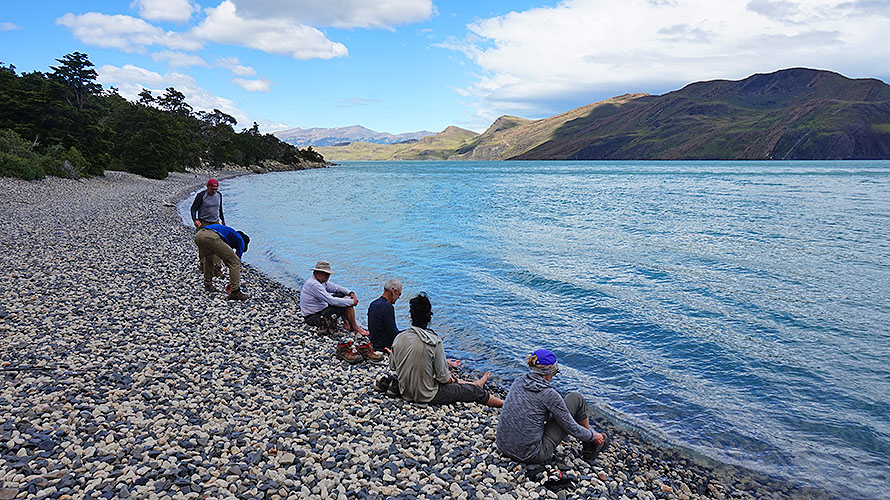
- Trip Destinations
- Patagonia Hiking Tours
- Torres del Paine Treks
Patagonia Lodge Based
Puerto natales, chile, trip highlights.
- World Class Hikes
- Cozy Lodging
- Glacial Lake Kayaking
- Glaciers, Spires, Wildlife & More
- Unique Wildlife
- Scenic Boat Shuttles
- Fantastic Chilean Cuisine
Description
Come join us for a lodge-based, multi-sport exploration of Torres del Paine National Park in Chilean Patagonia! Seven days and six nights in duration, this trip is a fantastic choice as a stand-alone trip or for guests looking to add some adventure to a longer South American visit. Featuring amazing hikes, scenic boat shuttles, a half day of kayaking, and wonderful lodging that puts us right in the action, we provide an all-around experience of Torres del Paine in a relatively short amount of time. Highlights of this tour include glaciers, glacial-fed rivers, turquoise lakes, towering granite spires, unique wildlife, amazing views, and invigorating hikes!
Please Note : some guests are not excited about the basic, communal accommodations in the Torres del Paine refugios (on the W Trek and Circuit Trek), which are co-ed and have 6-8 people per room. This lodge-based tour features private hotel accommodations with ensuite bathrooms. Also, guests hike with much lighter day packs, as we aren’t required to carry a week’s worth of clothing and personal items between the refugios. This tour still covers almost all the same hiking as the W Trek, making it a fantastic alternative.
$5290 Per Person
$1065 single supplement.
The single supplement on this trip provides for single rooms at all hotels during the trip.
DIFFICULTY LEVEL 3
Scale of 1-5. 1 is least difficult; 5 is most difficult
Hiking Distances:
Up to 13 mi
Backpack Weight:
Moderately Rugged
Max Daily Elev. ↑↓:
Up to 3,000 ft
Heights Exposure:
Please Note: Terrain, Elevation Gain and Heights Exposure ratings reflect the section or day of the trip with the maximum difficulty of each. Much of the trip is at easier levels. See the trip itinerary for more detailed information.
PHYSICAL DEMANDS OF THIS TRIP
- Hiking uphill or downhill with a 8-12 lb backpack for 8-10 hours
- Maintaining balance and footing on variable, uneven terrain
- Potential for harsh, rainy and extremely windy weather conditions.
SOLITUDE LEVEL 2
1 least solitude, 5 most solitude
We rate this Patagonia hike a solitude 2. You can expect to have as much as an hour of solitude at a time while hiking.
- Minimum Guests
Minimum of 2 Guests
We require a minimum of 2 guests to confirm this trip. If a trip date is not confirmed yet, you can register and will be notified when the trip is officially confirmed. We recommend not making final travel arrangements until your trip meets the minimum number of guests and is confirmed.
In most cases, if a trip does not reach the minimum number of guests, you may choose to transfer to another trip date or another trip, or be refunded your payments in full. We make the final determination for these trips 65-60 days before the departure date.
Private Trips
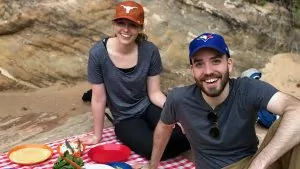
Travel in perfect company by booking a private trip exclusively for your group!
Our sliding scale for private trips is based on the final number of guests in your group. Rates are per person and do not include sales tax, national park fees or guide gratuity. The final rate is based on the actual number of guests on the trip and may adjust based on cancellations or additions.
Please Note: you can also enjoy a private trip at our normal scheduled rates by filling any empty tour to capacity. However, if group members drop from the tour those spots will automatically become available on our website for instant booking. By purchasing a private trip at the rates listed below, your trip will remain exclusive to your group regardless of cancellations.
Private Rates FOr This Trip
- 4-5 People: Rate x 1.5
- 6-10 People: Rate x 1.15
- 11-12 People: Rate x 1
- 13+ people: contact us for availability and pricing
*all rates are per person and single supplements apply
Private 10+ Guest Patagonia Trips
On all Patagonia trips for private or custom groups of more than 10 guests, a non-refundable deposit of 30% of the total trip cost is needed to secure the group’s reservations.
Learn About Our Private Trips
On this Patagonia hiking tour , we will pick you up at the airport in Puerto Natales, Chile. We will transfer you to your accommodation and before dinner we will all meet for our orientation meeting and become acquainted with our guides, itinerary, gear, etc. After our meeting, we will have our first Patagonian dinner together!
Important Note : When you enter Chile, you will be issued a document called a PDI (tourism card). Please do NOT throw this away. You will need it to exit the country and nearly every lodge we stay in also asks for a copy.
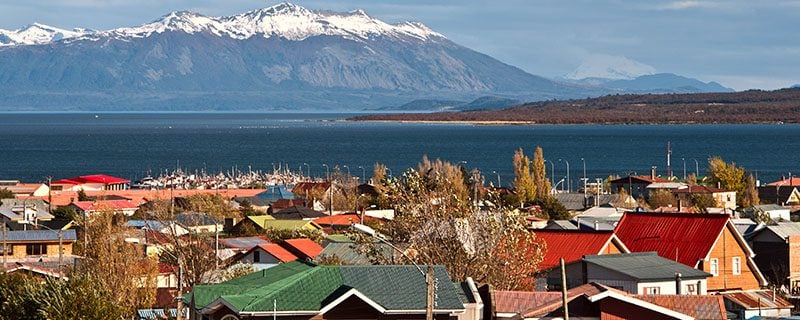
- Hiking Mileage: 9.3 mi (15 km)
- Elevation Gain: 820 ft (250 m)
- Elevation Loss: 985 ft (300 m)
- Trekking Duration: 5-6 hours
- Driving Duration: 1.5 hours
Today we depart Puerto Natales after breakfast and head toward Torres del Paine National Park. Our drive takes us to the region’s biggest lake, Mirador Lago Toro. The views from this lake of the Torres del Paine massive are a great introduction to the types of sweeping landscapes we’ll experience throughout our coming days. Upon arrival at the lake, your guides will give an overview of the natural and cultural history of the area. Our hike today starts directly from the lake and ends at our lodging by the Rio Serrano. Don’t worry our luggage will get transferred to the lodge for us as we hike. This hike is definitely off the beaten path, full of solitude and showcases well the Patagonia environments you came to enjoy. Once arriving to this isolated lodge, we’ll join our awaiting luggage, get checked in, and relax before dinner together.
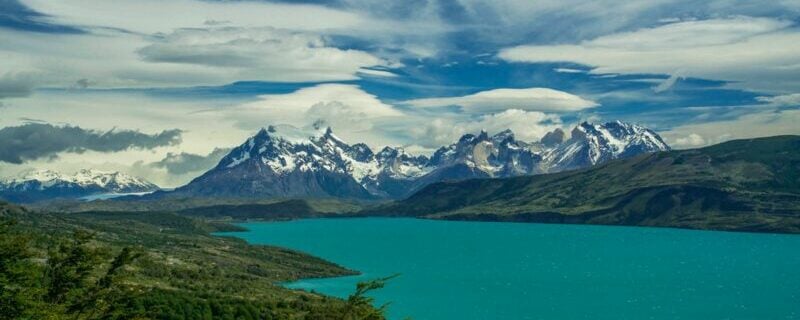
- Hiking Mileage: 11.8 mi (19 km)
- Elevation Gain/Loss: 2524 ft (740 m)
- Trekking Duration: 7-8 hours
- Driving Duration: 1 hour
After an early wake-up call and scrumptious breakfast, we’ll depart the lodge. Our objective today is quite possibly the most popular hike in Torres del Paine National Park. Our early start will let us beat the crowds on the trail to this iconic destination. We begin our trek to the Ascencio Valley, while having views of the stunning Ascencio River. We will come to refugio Chileno (a backcountry lodge) and have a break for water and snacks. We then continue through a beautiful forest of native Lenga (Beech) trees and keep hiking until we reach a glacial moraine (a ridge made from debris pushed out by the glacier). From the moraine, we trek another hour until we reach the most impressive Torres del Paine rock spires! Our views of the iconic granite towers and turquoise glacial lake are absolutely breathtaking, and they are the features that made this park world-famous.
After our hike we will head back to the Serrano River area, where we will enjoy another night at the Kau River Lodge. We will have time for relaxation until dinner is served.
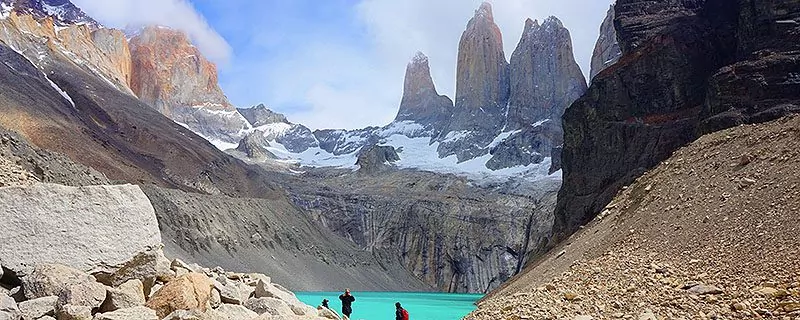
- Hiking Mileage: 5 mi (8.1 km) *optional hike
- Elevation Gain/Loss: 2780 ft (847 m) *optional hike
- Elevation Loss: 2780 ft (847 m) *optional hike
- Trekking Duration: 3-4 hours
This morning after breakfast, we will drive roughly 30 minutes to Grey lake, where we will have the opportunity to kayak for the morning if weather conditions are safe. We begin our paddle on the Pingo River in an area full of icebergs that have broken off of the Grey Glacier. It’s absolutely magical to paddle around floating blue icebergs in Patagonia! After we have seen the icebergs and if the weather allows we’ll continue on down river via kayak back to our lodge, where we will have lunch and change into our trekking clothes. After changing clothes, we will begin hiking to our special Two Glacier Look Out Point. This is a special and lesser known hike that leads us to an awesome vantage point to see Grey and Tyndall Glaciers. This hike is optional* for guests and if you prefer you can relax at the lodge while the rest of the group hikes. We will then head back to our lodge for free time and dinner.
Due to occasionally harsh weather conditions, the kayaking is not always possible and will be substituted by an alternative activity if not possible.

- Hiking Mileage: up to 13 mi (20.9 km)
- Elevation Gain/Loss: up to 2953 ft (900 m)
- Elevation Loss: 2953 ft (900 m)
- Trekking Duration: 7-9 hours
This morning after breakfast we transfer to Pudeto and cross lake Pehoe by catamaran. Today we explore the French Valley, one of the most picturesque valleys in Torres del Paine National Park with hanging glaciers and awe-inspiring granite walls and spires. With any luck we’ll witness glaciers calving and hear the resulting natural symphony echoing throughout the granite amphitheater.
Today’s lengthy hike is through the French Valley and up to a stunning viewpoint to witness the spectacular surrounding mountain vistas. We will then descend back to Lake Pehoe, board our catamaran, and travel back to Kau River Lodge for some free time before dinner.
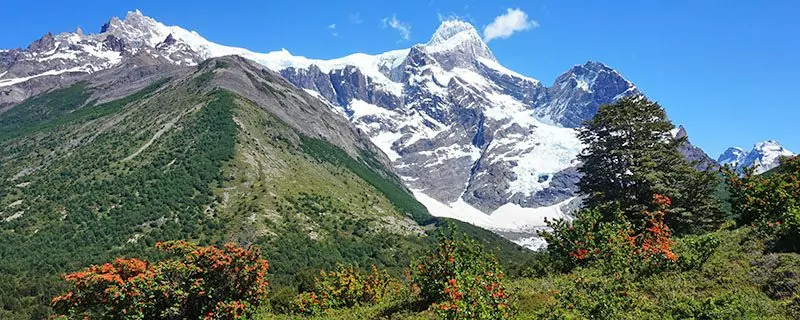
- Boat Excursion: 2.5 hours
- Driving Duration: ~3 hours
This morning after breakfast we board the Grey III catamaran for a 2.5-hour boat tour of the lake, glaciers, and mountain views. The boat gets up close and personal to Grey Glacier and there is an option for a Chilean pisco sour served with glacial ice as we absorb the majesty of our surroundings. We will have lunch in the area near the boat harbor.
In the afternoon, we start our return to Puerto Natales. We’ll stop along our route to explore the Milodon Cave natural reserve. This reserve is surrounded by magnificent snow capped mountains and glacier colored fjords. Here we can learn about of the beginning of the Holocene era (12.500 years BC), where the early human settlers to this region first left remnants of their presence. We’ll follow the coast of the paleo-lake of the Last Hope Fjord, here we visit various caves and learn about how the settlers lived and survived in this area.

This morning, after breakfast our shuttle driver will deliver you back to the airport in Puerto Natales. Thank you for choosing Wildland Trekking!
Please Note : We always do everything in our power to follow the set itinerary, however occasionally trips are subject to itinerary changes based on a variety of circumstances, including but not limited to: extreme weather, availability of refugios, political or bureaucratic obstacles, earthquakes, fires, flooding and more. Also, the kayaking portion on this trip is weather-dependent and not guaranteed; we will substitute alternate activities in the case kayaking is not possible. Normal terms and conditions apply to trips with itinerary changes.
Trip Dates & Booking
Trip dates & booking.
Click on a date to register. You can also click here to request new dates or book through customer service.
AVAILABLE TO BOOK
This trip is available and bookable online! Click on the date to register now or contact us online to book through our award-winning customer service team!
This trip has 1 or 2 spots remaining and is bookable online! Click on the date to book now or contact us online to book through customer service.
REQUEST A RESERVATION
This trip is exclusively booked through customer service due to logistics with lodging, permits, staffing, availability, or something else. Please contact us online or call us at 800-715-HIKE (4453) to request a reservation.

Don't see your dates? Call us! We may be able to add new trip dates.
Trip details, what's included.
- A detailed trip packet that takes the guesswork out of your travel, training, packing, and preparing for the trip
- Trained hiking guide(s) with years of personal wilderness and hiking experience, medical certifications, and a passion for leading people into breathtaking landscapes. See Guide Bios .
- Transportation for the duration of the tour starting on Day 1 and ending on Day 7
- Lodging for the duration of the tour
- All meals for the duration of the tour (dinner Day 1 through breakfast on the final day of the tour)
- Use of a day pack and trekking poles
- Kayak equipment and local kayak guides for one day (weather permitting, not guaranteed)
- Emergency equipment including a company-issued first-aid kit and communication device
What's Not Included
- Transportation to Puerto Natales, Chile
- Trip insurance that includes medical coverage and at least $30,000 in evacuation and repatriation coverage (required in Chile)
- Bar bills, drink bills, extra snacks, telephone bills, Wi-Fi bills and other personal expenses (shopping/ laundry)
- Clothes, rain gear, and footwear ( see recommendations )
- Sunscreen, toiletries and personal items
- Water bottles and a headlamp or flashlight
- All expenses due to unavoidable events e.g. flight cancellation, personal illness, strikes, etc. (we recommend trip insurance coverage for these variables)
- Guide gratuities are optional and at the discretion of each customer. A suggested guideline is to reward outstanding service with a tip of 5-10% of the total trip cost. Please tip your lead guide and they will distribute responsibly to the crew. Local currency is preferred, or USD is also appreciated; Gratuities for kayak guides (recommended $25-$50 per kayak guide)
Click here to see a printable, downloadable trip information packet with more detailed guidance about what to pack.
Meals: What to Expect
This Patagonia hiking tour features a combination of in-town meals and meals prepared by your guides. We’ll have dinners at carefully selected, wonderful restaurants in Puerto Natales and in some of the backcountry lodges, as well as meals prepared on the trail by your guides and/or support staff.
For optimal taste and energy, we supplement all our meals with spices, herbs, oils, cheeses, butter, sugar, and fruits and vegetables. In addition, we provide you with an assortment of trail snacks* (nuts, dried fruit, chocolate, & cookies) to eat at your own discretion.
We can often accommodate vegan, vegetarian, kosher and non-gluten diets and make adjustments for food allergies. These and other special dietary requests may require an additional fee, and in some countries may be more difficult to accommodate than others. Please inquire with us for more information about the specific trip you’re interested in.
*Common trail snack brands and items found easily in the US are not readily available in this destination. (i.e. protein bars, trail bars, beef jerky, etc.) We recommend guests that prefer these types of trail snacks to bring a few of their own choice items from home.
Gear We Provide
We provide all group gear which includes the following:
- Trekking poles
- Company-issued first-aid kit
- Emergency communication device(s)
Guest Packing List
When you register for this tour you’ll receive access to a printable, downloadable trip information packet with a detailed packing list specific to this trip ( click here to see it now.) All trips require a sturdy pair of hiking shoes or hiking boots, rain gear, a recommended clothing system, a headlamp or flashlight, a hydration system (water bottles and/or bladder) and other items specific to each trip.
Trip Logistics
How do i register.
Reserve your spot today! In the Trip Dates & Booking section of this page, the green and red dates are bookable online by simply clicking on the date, and blue dates must be booked through our customer service team for a variety of possible reasons. To email our customer service team, you can click here to get the ball rolling. Our adventure consultants will confirm availability, and if you’re ready to register we’ll email you a link to a registration profile. You’ll have 72 hours to complete your profile (and that of any dependents) and pay the deposit.
Feel free to call us for more info – we’re here 7 days a week!
Where Do We Meet?
We will meet you at the airport in Puerto Natales Day 1 and transport you to the first night’s hotel (included), where we’ll conduct an orientation meeting at 5:00 PM the first evening (your flight should arrive before 4 pm) Our communications team in Patagonia will be in contact approximately 45 days before your trip to coordinate your rendezvous and answer any last-minute questions you have.
Click here to see a printable, downloadable trip information packet with more detailed guidance about flights, shuttles, recommended lodging and more.
Travel to Puerto Natales
Booking flights.
For our Patagonia treks we recommend flying directly into Puerto Natales, Chile on the day the trip begins. LATAM Airlines, Sky Airline , & Jet Smart offer direct flights from Santiago to Puerto Natales.
Please arrive no later than 4 pm on Day 1 into Puerto Natales. Our Patagonia team will rendezvous with you at the airport and transport you to our hotel. An orientation meeting, dinner and accommodations are included on Day 1. Your flight on the final day from Puerto Natales can leave at anytime.
Flights to and from Chile are the guest’s responsibility. Multiple airlines operate flights into Puerto Natales, but there are no direct flights from U.S. or European cities. Most flights connect through Lima, Santiago, and/or Puerto Montt, Chile. The duration of these multiple-stop flights, including layovers, from the US is normally between 20 and 28 hours.
If you choose to fly into Punta Arenas (a 3 hour’s drive from Puerto Natales), we recommend the following local bus companies. These are comfortable coach busses and the process is easy to navigate. The website can be viewed in both English and Spanish. The cost is roughly $10-$12 per person and must be purchased online in advance. If you choose to take the bus from Punta Arenas, instead of flying directly into Puerto Natales, we will pick you up from the bus terminal and take you to the first nights’ hotel.
Buses Fernandez: http://busesfernandez.com Bus Sur: http://www.bussur.com
Important Note : When you enter Chile, you will be issued a document called a PDI (tourism card). Please do NOT throw this away. You will need it to exit the country and nearly every lodge we stay in also asks for a copy. It is also a good idea to take a picture of it, front and back.
Pre and Post-trip On Request Lodging
We secure limited amounts of pre and post trip lodging in Puerto Natales as an optional add-on for guests of this trip. This lodging is on request, and is available on a first come, first serve basis. If interested, please reach out directly to our team to check availability.
Safety Precautions
Your safety is our top priority. Our hiking tours are led by professional hiking guides, all of whom are wilderness-certified first responders or EMT’s, each with years of guiding and wilderness experience. Guides adhere to standardized risk management protocols in case of any potential or actual incident, and all tours carry an emergency communication device and comprehensive first-aid kit. Additionally we have a “24/7” system through which guides or guests can reach Wildland support personnel at any time.
In the interest of your safety, it’s important to refer to the Center for Disease Control website for up-to-date recommendations on immunizations before your trip.
Essential Eligibility Criteria
Essential Eligibility Criteria (“EEC”) have been specifically identified to help you understand the skills and abilities necessary to participate on each Wildland trip, and they apply uniformly to all potential trip participants, irrespective of the presence or absence of any disability.
Once you identify a trip in which you may be interested, please carefully review the EEC and itinerary details. If after reviewing the EEC that apply to your desired trip, you determine you need an accommodation in order to meet the EEC, please contact us prior to registering to discuss your requested accommodation.
The EEC exist for your own safety and the safety and enjoyment of all participants. If you are unable to meet the EEC for the trip, with or without an accommodation, you are not eligible for that trip. If you register and arrive for a trip for which you do not meet the EEC, you will be disqualified from participation on the trip and will be dismissed or evacuated from the trip without a refund.
Our approach to international travel is to combine the best of two worlds: the dialed-in details, professionalism and consistency Wildland trips are known for; and the cultural immersion and intimate regional knowledge that only locals can provide. To excel with this approach, we vet and hire the best local guides, welcome them into the Wildland family and train them to meet our standard of excellence with every aspect of a trip. But along with managing logistics and safety, your guides will teach you about the area’s history and culture, and provide a level of familiarity and intimate detail only locals can.
Check out our Meet Our Team page for staff bios.
Guide Working Parameters
Guides are required to take 8 hours off each 24-hour period to sleep, recuperate, take personal/down time…etc. In addition, as part of the 8 hours off they must sleep/rest or be in their tents/rooms uninterrupted for a minimum of 5 hours each night. We ask guests to respect these requirements and to not interrupt guides’ off time and sleep time unless there is a true emergency.
Age Restrictions
Age restrictions on this trip are as follows:
- 12 and older to join scheduled tours (mixed groups)
- 5 and older to join private tours, with final approval and specific logistical requirements (such as porter or stock assist) determined on a case by case basis
Trip Insurance
Field evacuation (minimum coverage of at least $30,000), repatriation, and medical trip insurance is required on all Chile trips as a condition of partnership terms with our Chilean vendors.
If you wish to purchase trip insurance, we recommend IMG/iTravelinsured. They are one of the world’s leading providers of travel insurance.
For information on recommended IMG/iTravelinsured policies please click here .
For even greater information, or if you simply prefer communicating with a real, live person, feel free to contact our exclusive agent Michael Bennett. Michael will help you identify the best product for your needs, and there is no cost associated with his assistance. You may contact him at:
Email: [email protected] US by Phone: 877-305-9083 Direct/International by Phone: 702-448-3664
If you already have insurance or wish to purchase from anyone other than IMG/iTravelinsured, we recommend careful consultation with the provider to ensure appropriate coverage. This is because many providers have a number of policy exclusions.
Weather In Patagonia
Chile is a long, thin country extending North-South more than half the length of South America which gives it a tremendous diversity of climates. The Patagonia region of Chile, where we operate our trips, is at the far southern tip of South America, relatively far from the equator and close to the South Pole. It is a generally cool climate with potential for year round inclement weather including rain, snow, sleet, and very strong winds.
The average temperatures and precipitation in the Patagonia region are:
- Accommodations
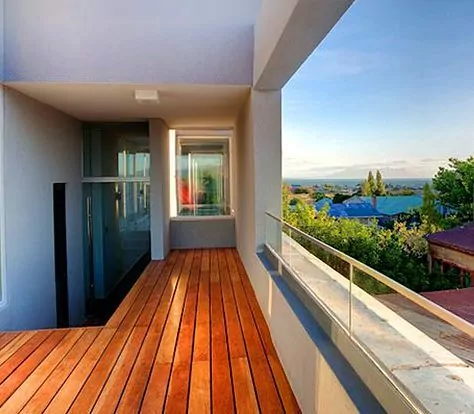
HOTEL NATALINO
This modern, comfortable hotel, with architecture that evokes the form of Patagonia’s natural landscapes, is a premier accommodation in the town of Puerto Natales. Just a couple years old, and with all the amenities, it is a fantastic place to prepare before, and rest after, our Patagonia trek. (heated pool)
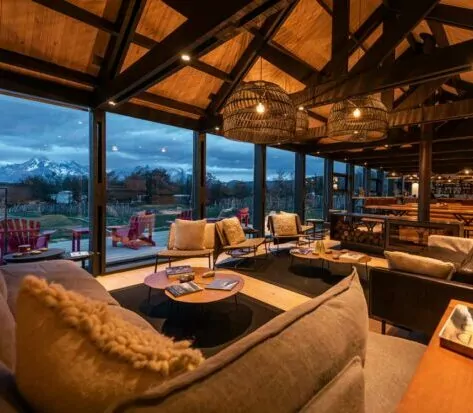
KAU RIO SERRANO
This wonderful, boutique lodge is near the village of Serrano on the shores of the Serrano River. The setting is stunning, and the location is perfect for exploring Torres del Paine on a lodge-based tour. KAU translates to “home” in the Tehuelche language and the hotel has been designed to feel like home by including a beautiful and comfortable living room to enjoy a drink or read a book while with the Paine Massif as the backdrop. Each room has an individual bathroom and shower for the occupants of that room.
* These exact accommodations are not guaranteed. In some instances alternative accommodations of similar quality and location may be used.
Trip Reviews
Average customer ratings:.
- 4.9 (15 reviews)
- Most recent
Wonderful Experience
This was a bucket list trip for me and it exceeded all of my expectations! The guides were superb, the accommodations amazing and the food, fabulous. And our guides were so amazing, they even arranged the weather in our favor :). I highly recommend this trip to all hiking fans. Trip of a lifetime and wonderful experience. Thank you Wildland!
It was the BEST.
The Wildland Team could not have been better! If you have not done a trip with them, I highly recommend it!
I would def choose Wildland again for future adventures!
Andrea took care of our small group well and cheered us up every step of the way. Food and accommodations were top notch, honestly a huge advantage compared to other standard W-trek tours. Driver was super friendly. I would def choose Wildland again for future adventures!
See All Guest Reviews!
Related trips, you might also like....
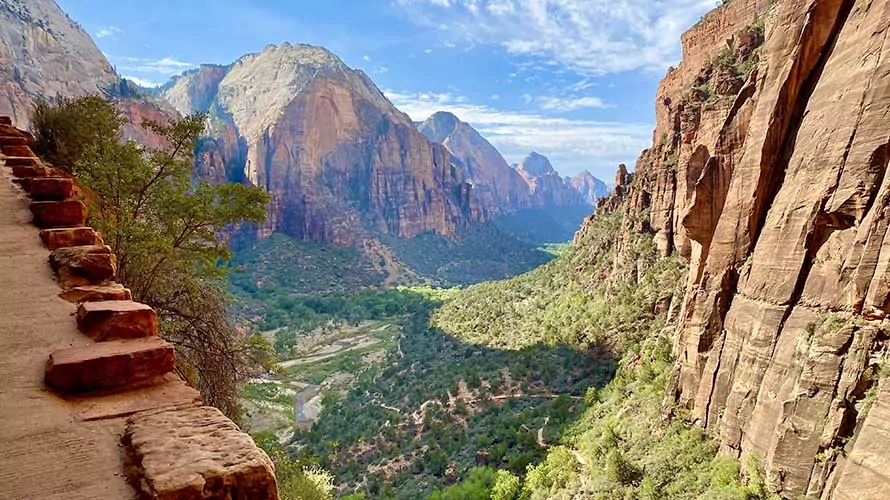
Ultimate Utah National Parks Hiking Adventure
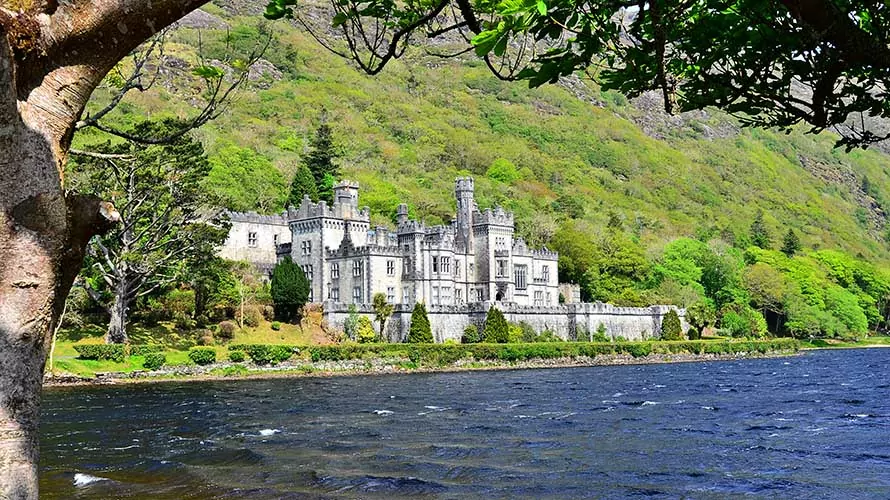
Hiking Ireland: Burren, Connemara, and the Aran Islands
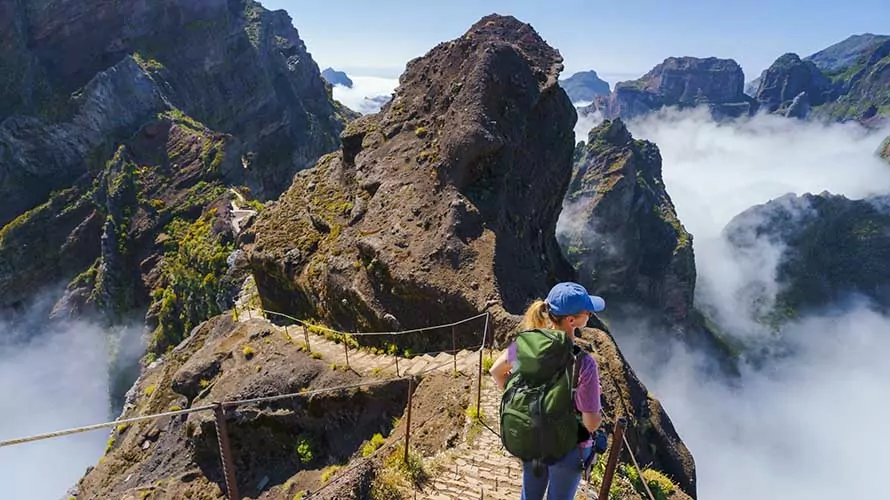
Madeira Island Hiking Adventure
- Similar Trips
- day by day itinerary
- logistical and travel information
- gear and clothing lists and more
Leave a Reply Cancel reply
Your email address will not be published. Required fields are marked *
First Name & Last Initial *
Save my name and email in this browser for the next time I comment.
wildland Wires
Sign up to receive our exclusive Wildland Wire emails and stay up to date with Wildland Trekking's promotions, discounts, contests, outdoor tips and tricks, trip reports and more!

El Chaltén to Ushuaia: Hiking in Patagonia
Chaltén -Calafate -Torres del Paine - Ushuaia
- Sail to see the Perito Moreno Glacier from close.
- Hike near the stunning Mount Fitz Roy and stay in Torres del Paine National Park.
- Travel to Ushuaia, the most southern city of the world and sail the Beagle Channel.
- Best time to travel: From October to April
Welcome to Your 2-Week Patagonia Hiking Trip - El Chalten

- Transfer from El Calafate to El Chaltén – Day at leisure
Upon arrival at the El Calafate airport, we will start our 4-hour trip to El Chaltén, the most famous hiking village in Patagonia. Let the adventure begin!
You’ll travel along the famous Route 40, surrounded by the Patagonian steppe, and pass through La Leona River, which connects Lake Argentino and Lake Viedma, and where you’ll get to see La Leona Road house, where the famous thieves Butch Cassidy and the Sundance Kid hid for a while. After discovering some other gems along your journey, you’ll reach El Chaltén and we’ll drop you off at your hotel.
El Chaltén is the top-rated hiking destination in Argentine Patagonia. This charming little village sits at the foot of Mount Fitz Roy and it’s surrounded by glaciers, lakes, rivers and forests. It’s also the jumping-off point for most hiking trails in the area. A paradise for sunny walkers and trekkers alike.
Enjoy your first afternoon of leisure in Patagonia by relaxing in the local brewery or strolling around a little waterfall…
Say Hueque Tips
- Our recommended hike for your first day in El Chaltén:
There is quick hike you can enjoy to warm up and discover El Chorrillo del Salto, just 1 hour away from the village. Reach its little waterfall encircled by native trees and flora, like the Patagonian Orchid.

First Hike Recommendation in Patagonia - El Chalten

- Recommended hike: Cerro Torre Viewpoint
Today, be prepared for an exciting journey into the wild. El Chaltén offers a wide range of hiking paths with varied difficulties. You can choose where and when to go since paths are self-guided and very well-marked and maintained.
From the main door of your hotel, you can go for an easy 2-mile walk to Cerro Torre viewpoint — it will only take you around 1 hour. Enjoy the sounds of Rio de las Vueltas, take in some amazing views of the Lenga forest, and be prepared to see all kinds of birds—this is a great woodpecker-spotting opportunity!
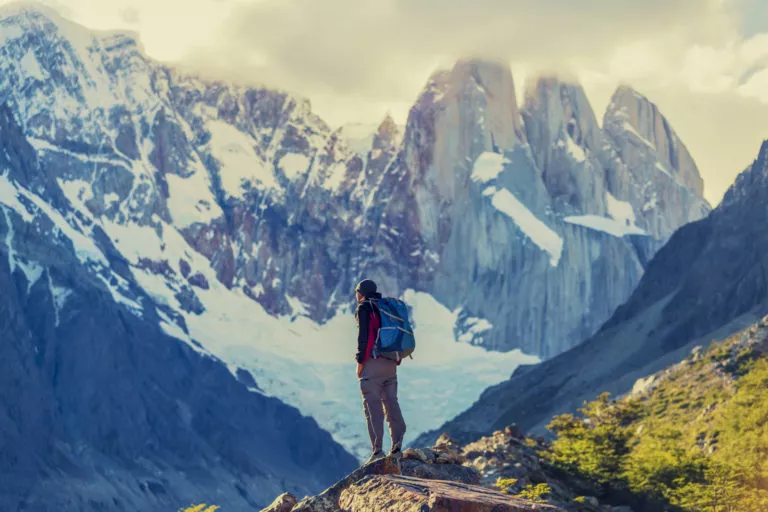
Second Recommended Gike in Patagonia - El Chalten

- Hike to Laguna Torre (self-guided paths)
Today, we have a recommendation for true hiking lovers: trek all the way to Cerro Torre and Laguna Torre, one of the most famous hiking trails in the area. Step into the wild for about 8 hours and 12 miles. This is a moderate-difficulty hike, but there is no steep climbing involved, so no previous experience is required!
The journey starts at a notable wooden sign that reads ‘Laguna Torre’ and features a woodpecker; you probably already saw the sign if you visited the Cerro Torre Viewpoint the previous day. From there, you will continue through a stunning, multi-colored landscape; snow-capped mountains will rein over the native forest of lenga and ñire trees.
You’ll pass by the De Agostini campsite and continue to the front moraine…you can hit the summit in 15 minutes! From here you can descend to the lagoon and watch the floating icebergs, or continue to the Mascardi viewpoint, 1 mile up the hill.

Third Hiking Recommendation in Patagonia - El Chalten

- Recommended hike: Laguna de los Tres and base of Mt. Fitz Roy
If you liked the Laguna Torre hiking trail, you’ll love our next hiking favorite: Laguna de los Tres and the base of Mount Fitz Roy. Go for a medium-difficulty, 9-hour hike to the most impressive views of Rio de Las Vueltas Valley. You’ll cross Del Salto Stream, with its icy waters cradled by orange-tinted rocks which frame the breathtaking views of Mount Fitz Roy.
And here’s a little secret: You can also reach Laguna Sucia from Laguna de los Tres… It’s only a 5- minute walk away. Though this hike increases in intensity during the last bit, it’s totally worth it. This is one of the best day hikes in the world!
- A little secret to enjoy this hike
Seize the day, wake up early, and watch the sunrise at Laguna de los Tres (see Fitz Roy’s peaks turning red) — this is truly a once-in-a-lifetime opportunity. You can depart from the town of El Chaltén during the night or stay one night at Poincenot campsite, just 1 hour away from Laguna de los Tres.

Patagonia Hiking Trip - El Calafate

- Transfer from El Chaltén to your hotel in El Calafate – A day at leisure
In the afternoon you will board your bus back to El Calafate. The 3-hour drive back will be a good opportunity to relax while enjoying the passing landscapes out your window.
Once you arrive in El Calafate, the bus will drop you off at your hotel. Now is your chance to try some tender Patagonian Lamb, or maybe a heavenly Calafate ice cream. In Calafate, food options are varied and plentiful; from veggie delicacies to the best demonstration of national steaks, there really is something for everyone. You can choose a fancy restaurant for dinner, or a more traditional local tavern to spend an unforgettable night.

Mayo Trek Spirit & Perito Moreno Glacier - El Calafate

- Mayo Trek Spirit & Perito Moreno Glacier
Start the day with a pick-up at your hotel, travel to Puerto Bandera, and embark on an 8-hour nautical safari to discover secluded glaciers and waterfalls of Glacier National Park that can be only reached by boat!
Sail Mayo Channel and disembark on Toro Bay to hike through the Patagonian forest; your specialized guide will tell you about the vegetation of this area (very different from other kinds inside the park) and show you the millenary cherry tree and its 3-meter-in diameter trunk.
Set sail again to reach the Cerro Negro (Black Hill) and make a half-mile soft hike to the base of the hill to admire the hanging Black Glacier. Enjoy your free time in this place that not many travelers have seen, before departing for our third stop, the famous Perito Moreno Glacier. Our boat will pass by the immense icy wall -take your beanie and grab your camera, you may see a piece of ice breaking!- before stopping at Puerto Moreno. Enjoy your free time, wander the traditional catwalk circuit that surrounds the glacier before sailing back to Puerto Bandera, and be driven back to El Calafate.

Your Day at Leisure in El Calafate - El Calafate

- Optional tour to a Patagonian ranch
El Calafate has much more to offer than just its magnificent glaciers… we recommend that you complete this 2-week hiking trip to Patagonia by taking a day tour to immerse yourself in the rural culture of Patagonia.
Inside Glaciers National Park, at the end of National Route 15 and after a 1 hr 30 min drive over a rubble road, sits one of the oldest and most traditional Patagonian ranches in the area. It’s the only ranch that continues to maintain sheep and Hereford cattle breeding as its main occupation. You can take a day trip to visit its 30,000 acres of land, learn about its history, and witness a sheep-shearing demonstration and horse training. At the end of the day, a grilled lamb will await, sizzling on its traditional Patagonian rotisserie.
If you would like to add on this tour for your free day, just let your travel advisor know.

Patagonia Hiking Trip - Torres del Paine, Chile

- Travel to Torres del Paine National Park
In the early morning, we’ll pick you up from your hotel to start your trip to Chile and your full-day visit to Torres del Paine National Park.
First, we’ll drive through the Patagonian steppe for 2hr 30min (you might be able to see rheas, guanacos, Patagonian hare, and even condors!) until reaching the border of Chile in Cancha Carrera, where we’ll go through customs.
We’ll keep traveling through isolated and windy landscapes, occasionally dotted by guanacos and native green-orange-tinted bushes; you’ll truly feel the momentous solitude that characterizes Patagonia. Torres del Paine is a gift that keeps on giving; it will unveil its enthralling natural beauties little by little…
Along a winding road, we’ll make different stops to have a close-up view of various attractions like Cascada Paine (Paine Waterfall), Paine Range at Lake Sarmiento, and the Paine Horns at Lake Nordenskjold. Depending on the weather, we’ll depart on an hour-long walk to reach the lake and get closer to the striking mountain peaks. At midday, after having stopped by the Lago Pehoé Viewpoint to gaze at the vastness of the French Valley, we’ll have our boxed lunch with this mountainous backdrop.
At the end of this dreamy excursion, we’ll leave you at Laguna Amarga, where your transfer will pick you up and take you to your accommodation inside the park.
- Something to take into account
Things to take into account during your trip from Argentina to Chile: It is not allowed to take any fresh food, plants, seeds, etc. They are very strict, and fines can be high. If you are not sure whether something is allowed, please declare it (they will provide you with a form) and they will inform you if you can bring it or not. And please, don’t forget your passport!

Hiking Recommendation in Torres del Paine - Chile

- Hike to Base las Torres
Torres del Paine is one of the most beautiful protected areas of South America, and the best way to explore it is by foot. If you like hiking and nature, this should be one of the highlights of your trip. Depending on which area of the Park you are staying in, you will be able to explore different paths — please check with your travel advisor about which are the best options for your location.
Our recommendation is to make a solo hike to Base de las Torres del Paine. This is the most famous hike in the park since it takes you to the base of the Paine Horns (8500 f.o.s.l.), a challenge for climbers all over the world. It takes 8-10 hours round-trip.
The first 2 hours of the trek are very tiring since you are walking up, leaving the valley where the Hosteria and Refuge Torres del Paine are located. You’ll cross Ascensio Valley, taking its winding path and gazing over Ascensio River until you get to the first stop, Refugio El Chileno. From here, you’ll continue for one hour through a lenga forest — the changing landscapes will combat any tiredness!
You’ll finally get to the moraine; the last beat of the trek, and the hardest. The last hour will be an uphill climb, but take your time, you’ll definitely make it to the top! Every effort will be compensated with breathtaking views of these massive granite mountains that grow past a blue lake and up to the sky.

Lake Crossing and The French Valley trek

- French Valley – Hike into the ‘Heart of Torres del Paine’
Today, prepare to continue this hiking adventure on the other side of the park. We’ll pick you up at your accommodation to take you on a 1-hour ride to the Pudeto area, where you will take a 45-minute navigation to the opposite shore of Lago Pehoé.
You can take a day pack with your valuables and the things you might need for today and tomorrow — for your convenience, our local operator can keep your heavier luggage until tomorrow. Please just let us know in advance. Upon your arrival, you’ll go to Paine Grande Refuge (very close to the dock), where you’ll stay overnight.
From here, we recommend that you enjoy the French Valley Hike (not included). This is a unique opportunity to visit one of the least-accessible areas inside the park since there is no road nearby. But, with your own two legs, you’ll definitely make it!
What will you find in the French Valley? Hanging glaciers, pristine woods, and some daunting jagged peaks: the multi-colored Paine Grande and the forbidding Paine Horns. You can also cross the rope bridge over the French River to reach some stunning views of the French Glacier or continue to the French Valley Plateau, or down to the Pehoé River and the glacier.
Take into account that, these last two options, though amazing experiences, will demand an extra effort since you’ll have to hike a rocky path alongside the moraine. You will get back to the campsite by skirting Lake Skottberg.

Hiking in Patagonia - End of Your Travel Experience - Torres del Paine & Puerto Natales

- Boat trip to Glacier Grey
In the early morning, you will hike to the Grey Mountain Hut. This is an amazing hike that will lead you to the shores of Grey Lake and its floating glaciers, with stunning views of the massive Southern Ice Field and the Grey Glacier that blend together and extend their white cloak far beyond what the eyes can see.
You already have a boat scheduled for later this day. Right after the hike, you’ll embark on a cruise from Grey Lake’s beach, and after crossing the blue waters, filled with floating icebergs and dramatically framed by glaciers and snow-capped mountains, you’ll get to Hosteria Grey.
- Transfer to Puerto Natales – Free evening
When you arrive, a transfer will be waiting to take you on a 4-hour trip through dry, mountainous steppes to finally reach Puerto Natales, where you’ll spend the night.

Hiking in Patagonia - Punta Arenas

- Bus to Punta Arenas – Day at leisure
Today you’ll make your way to the bus station of Puerto Natales to depart to Punta Arenas. We advise arriving there 30 minutes before the departure time, in order to avoid any last-minute inconveniences. This is a 4-hour trip in a standard bus through the steppe, crisscrossed by mountains and fjords. Upon your arrival at the bus station in Punta Arenas, you’ll head to your hotel — you can walk or take a taxi for around $5-7 US dollars.
Punta Arenas is the southernmost city in Chile, located on the Magellanic Strait, and is the leading port for Antarctic cruises and scientific research. Before the construction of the Panama Canal, Punta Arenas was the most important maritime crossroad between the Pacific and Atlantic Ocean, and thus, the city grew as a commercial center surrounded by European-style buildings. Its colorful houses, standing out from a backdrop of snow-capped mountains, are a site for sore eyes.
- What to do in Punta Arenas?
You can enjoy the evening by taking a 3-hour city tour to learn about Chilean history, visit the Mirador Hill (and get the most gorgeous views of Magellan Strait), or stop by the Maggiorino Borgatello Museum to see the masterfully crafted pieces made by the Onas, Yaganes and other natives of the area.

Hiking in Patagonia - Ushuaia

- Bus to Ushuaia – Day at leisure
In the early morning, you will get to the bus station to embark on a full-day bus trip to Ushuaia, the last destination of your 16-day trip in Argentina and Chile. Take into account that you’ll be crossing borders again today!
This is a 12-hour trip in a comfortable bus, equipped with reclining seats, where you’ll cross the Patagonian steppe. Look out the window and you’ll see yellow and green grasslands with Chilean gauchos riding into the wild and grazing unbothered sheep until you reach the ferry crossing. It will take around 45 minutes to cross the mythical Strait of Magellan and hit the road again to cross the Chilean border, finally entering Tierra del Fuego Island on Argentine soil.
As the famous end-of-the-world city approaches, grazing sheep will turn into wild guanacos and horses, with snow-capped mountains and evergreen woods arising at the entrance of Ushuaia. Once you get your “Southernmost City” passport stamp, you’ll realize that this intrepid journey through remote Patagonian roads was absolutely worth it.
Upon arrival in Ushuaia, you will be transferred to your hotel. Ushuaia is a small town, and it is really easy to get around on foot.
Take the afternoon to explore the town, learn about the region’s rich history at the Prisoners’ Museum, or visit the Galleria of Fuegian History (it has a lovely restaurant as well!). Please, don’t forget the local gastronomy! Ushuaia has the best seafood in Argentina.
- Something you should take into account
This bus trip allows you to see the landscape of other, lesser-known parts of Chile and will give you a much more complete perspective of the area. However, we understand that it is a long journey, and can be a very tiring day. For an additional cost, you can choose a less adventurous option; from Torres del Paine, you can drive back to El Calafate and then fly to Ushuaia.

Ushuaia Tour - National Park - Ushuaia

- Discover Tierra del Fuego National Park wildlands
Today we’ll pick you up from your hotel to start a 10-hour, moderate-difficulty, adventure in Tierra del Fuego National Park, just 7.4 miles away from the city and bordering the shore of the famous Beagle Channel.
Upon arrival at Ensenada Bay, you will have time to enjoy the view over the Beagle Channel before you start hiking along the coast. Four miles of trail await you, where you’ll discover native flora, wild fauna, and the remains left by the Yamanas , the native inhabitants of the area. After this 3-hour hike, you will reach Lake Roca, where lunch will be served.
After a full homemade picnic, you will start the second part of this adventure. Take your oar and plunge into a 1hr 30 min paddling trip along the Lapataia River (only available for children over 5 years old). Make it all the way to Lapataia Bay, where the Panamerican Highway and National Route 3 end at an awe-inspiring landscape.
After discovering the unique vastness of this stunning setting, we’ll take you back to your hotel to rest and enjoy another Patagonian evening.
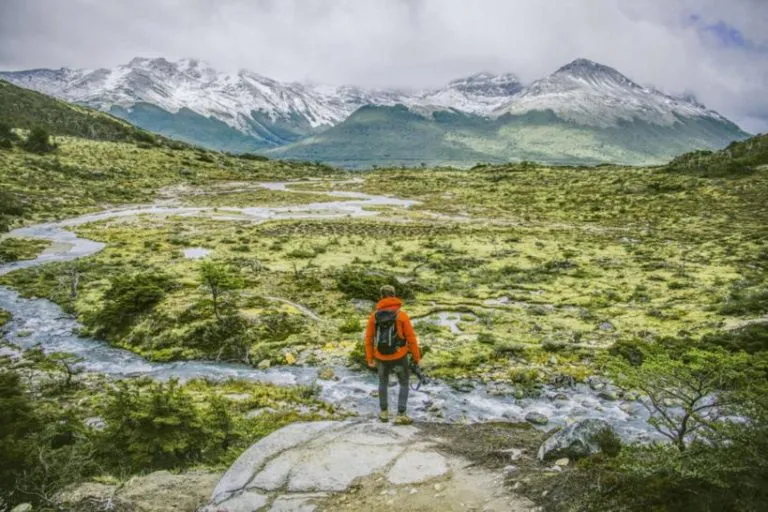
Beagle Channel Cruise - Ushuaia
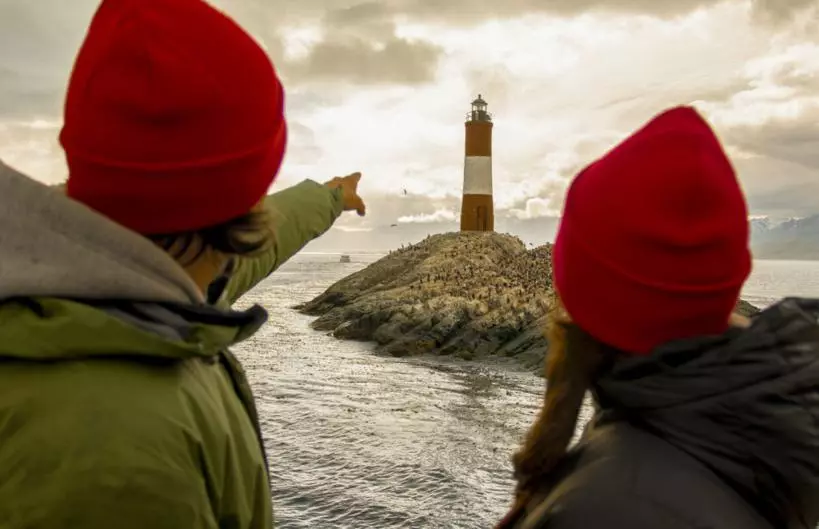
- Beagle Channel boat trip – Tour Ushuaia’s famous islands
In 1833 Charles Darwin sailed the Beagle Channel and found something great. Today it’s your turn: become another explorer of this channel, primitively named Onashaga Channel since the Onas where its first discoverers.
Make your way to the tourist pier (located downtown) to embark on a 4-hour Beagle Channel navigation in a fully equipped boat with a capacity for up to 26 people. With Argentina on your left and Chile on your right, you’ll sail this natural border until reaching the iconic Les Eclaireurs Lighthouse, which is still in operation.
On the way, enjoy uplifting panoramic views of Ushuaia Bay, crowned by the Martial Glacier’s diverse marine wildlife, such as cormorants (flying birds, closely related to penguins) and fur seals. Hop off on Bridges Island to explore its vegetation, and visit the archeological remains of the Yamanas (the native inhabitants) accompanied by a specialized bilingual guide.
During the trip, enjoy bottomless hot cocoa and cookies, or try the maté (loose herbal tea), which is every Argentinian’s favorite drink. Once we get back to the port, you can make your way back to your hotel or stop in a local cafe or brewery to enjoy an amber craft beer paired with a traditional Patagonian appetizer.
- Have you ever walked amongst penguins?
If not, Ushuaia is your chance to fulfill that bucket-list dream… You can switch out the Beagle Channel Navigation to take the Magellanic Penguin Rookery Tour on Martillo Island (available from October to April at an additional cost), or add one day to your Ushuaia itinerary so that you can do both. On Martillo Island, you will also see a very rare type of penguin that is typically only found in Antarctica: the yellow-crested penguin.

The End of Your Hiking Trip to Patagonia - Ushuaia

- Transfer from your hotel to Ushuaia airport
Today we’ll take you to the airport, where your 2-week hiking trip in Argentine and Chilean Patagonia will come to an end. But don’t be sad! You can return whenever you want (we’ll welcome you with open arms) or… continue your trip towards the North of Argentina , to beautiful Salta or the wine region in Mendoza. Argentina still has plenty to offer! Check out our travelers’ favorite trips to Argentina and Chile .
Request a quote
- Prices in US Dollars.
- Valid until April 2025 (ask for prices at Christmas and New Year).
- Prices are per person, based on 2 people in double occupancy. Single rates are available on request.
- Flights are not included in the price but can be arranged on request.
- 3-night accommodation in El Calafate
- 4-night accommodation in El Chaltén
- 3-night accommodation in Torres del Paine, Chile
- 1-night accommodation in Puerto Natales, Chile
- 1-night accommodation in Punta Arenas, Chile
- 3-night accommodation in Ushuaia
- Daily breakfast
- Meals according to the itinerary: boxed lunch on day 8; lunch on day 14
- Round-trip bus El Calafate / El Chalten / El Calafate
- One-way bus Puerto Natales / Punta Arenas.
- One-way bus Punta Arenas / Ushuaia.
- Transfers and tours mentioned in the itinerary
- Bilingual guide (English / Spanish).
- Torres del Paine National Park entrance fee
- National Park entrance fees
- International or domestic flights
- Please note- while in El Chaltén, hiking the mountain trails is a very popular activity. Most trails are clearly marked and well-maintained; however, if you would prefer to be accompanied by a local mountain guide, just let us know and we will be happy to arrange it (cost will be confirmed at the time of booking)
- Travel / Medical Insurance – To get a free quote please follow this link: Faye Travel Insurance (only available for U.S. Travelers)
ESTIMATED COST FOR THE FLIGHTS ON THIS TRIP: Local flights cost from $150 per person per segment. We offer special rates on flights for this tailor-made itinerary.
Customize Your Adventure:
Share your trip plans, and we’ll tailor it to your needs and budget.
We deeply care about our planet, just like you do. When you book with us, you’re not only fulfilling your travel dreams but also leaving a positive impact on the destination you’re about to discover. We are proud to plant 10 trees in damaged zones of Patagonia for every traveler. It feels good to do it right. Let’s move beyond sustainable!

Complete the form and a member of Say Hueque's team will get in touch with you in about 48 hours
You can accelerate the process by reserving "El Chaltén to Ushuaia: Hiking in Patagonia" right now!
I wanted to express our gratitude for your exceptional assistance in planning our recent trip to Argentina and Chile. The experience exceeded all expectations, and we are incredibly thankful for your recommendations that played a significant role in creating lasting memories for our family.
Here are some highlights from our trip that we wanted to share: Glacial trek, Aldebaran Hotel - a unanimous favorite for its post-trek relaxation and rejuvenating massages, El Chalten hikes and the New Year's Eve dinner
We had an incredible journey, and your contributions made it truly special.
Thank you once again for your excellent planning and support. We look forward to working with you in the future.
Best regards
My brother and I had a fantastic time in Patagonia and are so grateful for everything you did to make this such an amazing trip!! The itinerary you put together for us was perfect and we especially enjoyed the Laguna de los tres hike and big ice trek on the Perito Moreno glacier. Thank you so much for squeezing us into all the activities and accommodations. We are already looking forward to coming back and I've attached a few pictures of us :).
The trip was absolutely fantastic. We had such a great time! The guides were all knowledgeable and enthusiastic and a lot of fun to spend the days with. I want to give personal recognition to the tours/groups in Buenos Aires, El Calafate, Puerto Madryn, Peninsula Valdes, and the jeep tour on day 1 of Rio de Janeiro. Thank you for your hard work and support for setting up this trip. The Vamos app is also fantastic and really helped throughout the trip!
I hope to keep in touch for any future trips!
Gracias y saludos a todos!
All very good I used you with my 14 year old in 2017. It is more money but there were a number of times we were impressed how on top of things your team and organization were. We forgot we locked up our money and passports in a hotel safe. Calmy people were contacted and a remedy was found. There was a definite feeling that you all were there, ready to help or to juist make sure things were going well. Really glad we asked to go to the coast; Valparaiso, Isla Negra and Nerudas house. Really no need to see Viña del Mar, too much hotel and vacationer feeling there, would have preferred something additional in Valparaiso. Peulla hotel Natura was wonderful, could have spent another night there, and done more than a small walk in that area. Glad we took the bus over the Andes and the lake crossing. Thanks much. All four of us loved it.
The most remarkable aspect of the expedition was, undoubtedly, the breathtaking wildlife. The landscapes were a sanctuary to an array of unique creatures. Majestic whales gracefully breached the icy waters, while adorable penguins waddled along the shores, seemingly unfazed by our presence. Observing these creatures in their natural habitat was an experience that words cannot fully capture. It's a memory that will forever be etched in my mind.
the service on the cruise was exceptional. The crew’s knowledge and passion for the region were evident in their informative lectures and their willingness to share their expertise. They ensured our safety while also going above and beyond to make our journey comfortable and memorable.
This cruise to Antarctica was an incredible expedition. Adventure, natural beauty, and wildlife encounters were the main stars. Luckily we enjoyed a smooth sail through the Drake Passage, so we could admire the astounding wildlife, and the outstanding service made this journey a once-in-a-lifetime experience that exceeded all expectations. If you seek an adventure that stirs the soul and leaves an indelible mark, an Antarctic cruise is an absolute must.
The opportunity to step foot on the untouched Antarctica was a privilege. The glaciers, the icy terrain, and the absolute stillness were both humbling and invigorating. Exploring via zodiac boats allowed us to get up close to the landscape and wildlife, providing an intimate experience of this raw, unspoiled wilderness. Thanks to every member of the crew that made this adventure an unforgettable experience!
Working with Say Hueque was great.
Everyone at the company was responsive and thoughtful, even when I sent that "emergency" message they solved my problem very fast . When I'm traveling in a foreign country, it's important to me to know that there's someone I can contact that will help me figure things out. I appreciated Say Hueque's service.
Thank you again for all of the help in planning, specially Sol and Andrea.
We had a wonderful time in the desert! If I ever plan to go to Argentina or Chile in the future, I'll be sure to contact you.
I specially want to thank Antonella and Lucia for their hard work and dedication towards our very successful holiday. Your dedication and eye to detail was very much appreciated.
Celia our guide for our two days at Iguazu falls was exceptional.
We will definitely recommend Sayhueque to our friends back in Australia.

Buenos Aires - El Calafate - Ushuaia - Salta - Iguazú Falls
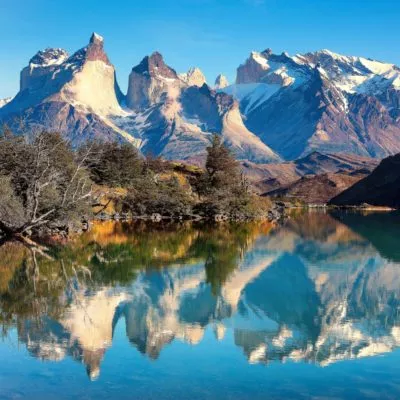
El Calafate - Torres del Paine - Bariloche - Ushuaia - Buenos Aires - Puerto Varas

El Calafate

Buenos Aires - Northern of Argentina - Santiago de Chile - Atacama Desert - Uyuni Salt Flats
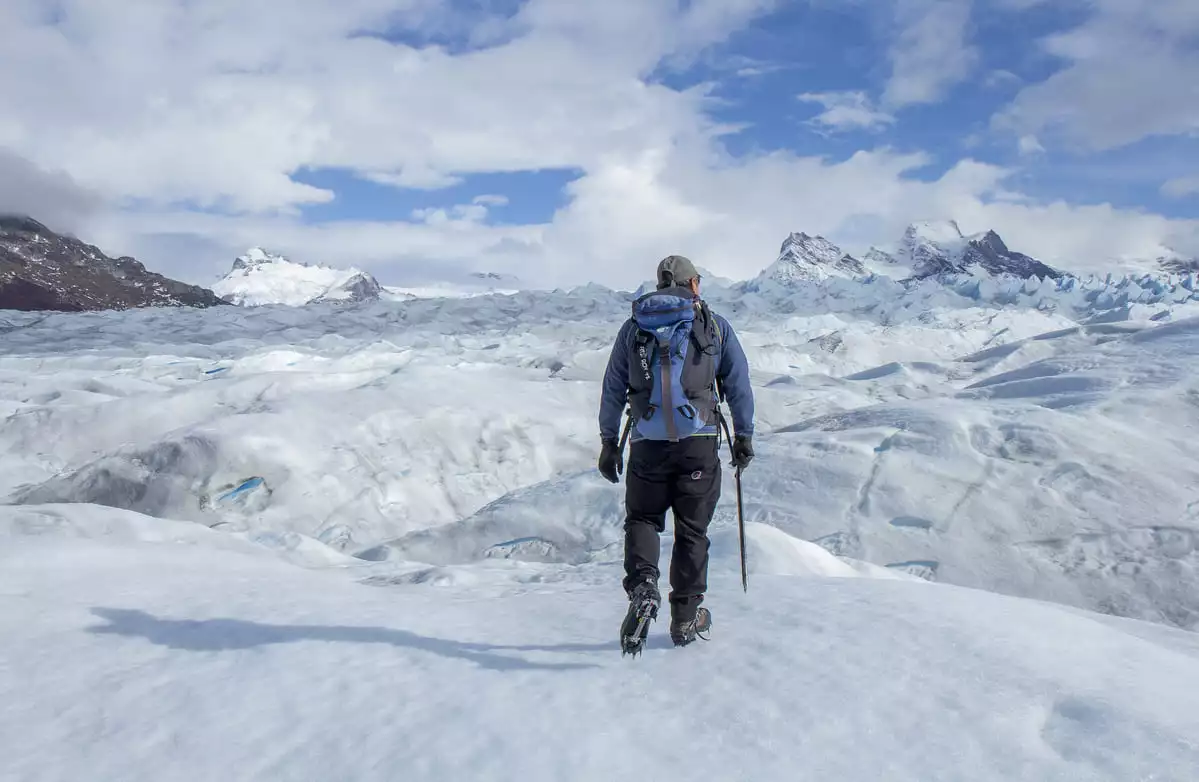
El Calafate - Ushuaia - Buenos Aires - Iguazú Falls

Buenos Aires - Calafate - Chaltén - Ushuaia - Torres del Paine

Buenos Aires - Perito Moreno Glacier - Chaltén - Ushuaia

Buenos Aires - Puerto Madryn - Ushuaia - El Calafate - Iguazú
In these hand-picked articles from our Travel blog you will find useful information for your next trip

South American Hike: What Not To Do
A South American hike can be an interesting challenge. This is our expert “Not to-do” list followed by a “Favorite […]

5 Hidden Treasures in the Patagonia Chilena
What is the first place that pops up in your mind when we say Patagonia Chilena? Torres Del Paine, Chile’s […]

Travel Patagonia in 2024
Traveling to Patagonia during this season is going to be the highlight this year. Get prepared for the experience with […]
Once the payment and availability are confirmed we will proceed with bookings, and you will receive a confirmation in 24 working hours
Select a type of payment

Let's keep together & connected through our social media channels:
The website uses cookies to enhance your experience. By continuing, you agree to our Cookie Policy
Fill out the form, and our Travel Specialists will craft your quote within 48 Hours
Complete the form and our Travel Specialists will craft your quote within 48 Hours
Hiking in Patagonia: A Complete Guide
By Jack Barker
Updated: September 4, 2021
The region of Patagonia refers to a large region in Southern Argentina and Chile. Covering a length of more than 1,500 miles, there is more than a lifetime to explore all the hiking in Patagonia.
Patagonia is a loosely defined geographic area. Most people consider Patagonia to include the southernmost region of Tierra del Fuego and then constricted north to the Colorado River. Bariloche, Argentina is loosely defined as the “gateway” city to Patagonia. To put this area in perspective, the length of Patagonia is roughly the driving distance from Boston to Miami. This area includes an incredibly vast amount of different ecosystems and environments.
From arid deserts too low lying volcanoes to the Southern Patagonia ice field, there are different places to explore for everyone. The region is magical, you’ll see wild animals grazing near glacial rivers, with the view of inspiring mountains in the distance. This is a part of the world that all hikers should visit. It is hard to put into perspective just how spectacular the vast landscape really is.
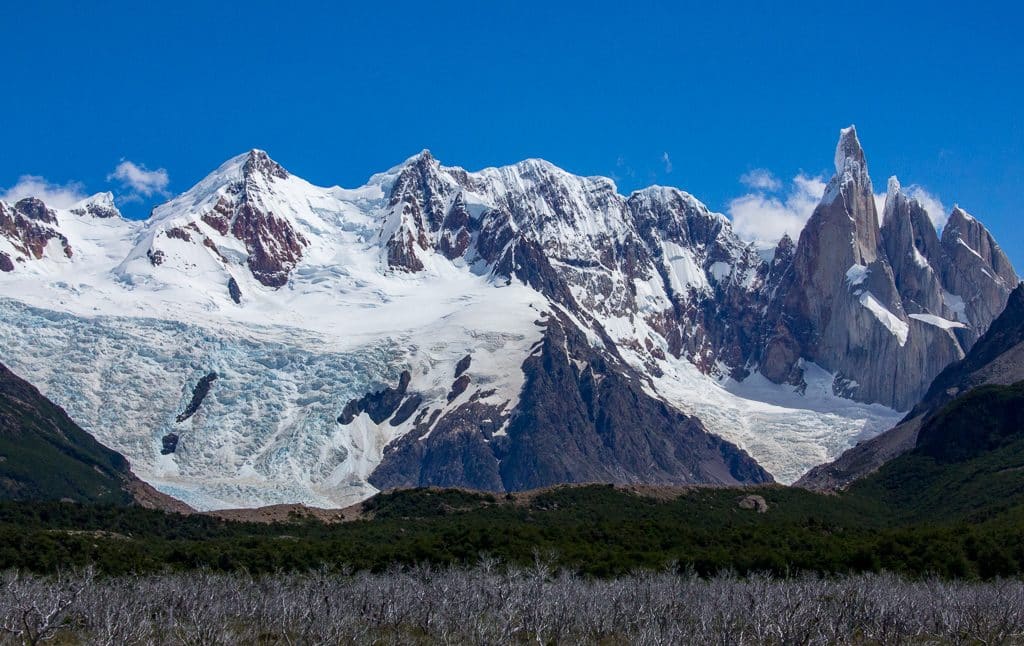
Getting there and getting around
To get to Patagonia, the easiest way is to first fly to Santiago, Chile, or Buenos Aires, Argentina. You won’t have a problem grabbing an international flight to these cities. From here, one can catch regional flights to cities like Bariloche, Puerto Montt, Coyhaique, Calafate, Punta Arenas, and Ushuaia. Once you arrive in these Patagonian cities, the easiest way to travel is by bus. There are many bus companies that operate in Patagonia, and most stay within a moderate price range.
A great resource to use while deciding how to travel in Patagonia is Rome2Rio . Put in your location and desired destination, and it will show you all the different travel options, from the ferry to bus, rental car to taxi.
For smaller cities, you can buy bus tickets on the day of or a day before. Smaller towns will have a regional bus station with options for smaller bus rides, often known as a “collectivo.” Collectivos are commonly 10 people or less in a large van. Most towns will have a central bus station and it will be easy to communicate to learn about destination choices. When paying for buses in smaller towns, they will often only take cash.
Much of the region has put a large emphasis on growing tourism in the last few years, detailed maps with English translation are readily available.
Rental cars are also available, but they would be more useful in Northern Patagonia, where there are more paved routes and better access to fuel and maintenance.
Taxi service is widespread across the smaller towns, to grab a taxi, head towards the town square or ask you host to contact one. A really amazing part of hiking access in Patagonia is that you can often have a taxi take you to hiking trails just outside of town! Ride-sharing services such as Uber are available in the Chilean cities of Osorno, Puerto Montt, Punta Arenas, and Coyhaique.
Accommodations
Even if you are planning to mostly camp while hiking in Patagonia, you’ll still need to stay in town at some point!
In the larger towns of Patagonia, hostels and hotels are easy to book via sites like hostelworld or booking.com .
Camping in town is often available but is not to be relied on. December-February is the peak hiking season in Patagonia, and it is a good idea to make reservations online in advance.
When to go?
The best time to visit Patagonia is in the Southern Hemisphere’s summer, December to February.
Hiking weather in Patagonia can be extreme all year round, but the summer is your best bet for mild temperatures and low winds.
The Southern Patagonian Ice-field is known for having some of the worst weather on the planet, and it often expands to popular hiking areas all over the region.
In the summer months, be prepared to experience rain and snow and temperatures from 25 degrees F up to 80 degrees F. Expect the majority of hiking to be done in 50-degree weather. The further South you go, the colder the average will be. Westerly winds coming from the Southern Patagonian Ice-field can gust over 100 mph, even in the summer. You are likely to experience intense winds while hiking in Torres Del Paine, Tierra del Fuego, or in El Chaltén.
Sites like Meteoblue and Winy.com are excellent forecasting tools for hiking in Patagonia. The Northern regions of cities like Bariloche will have much more of a summer vibe to them, think sitting on the beach after a long day of hiking!
What gear to bring?
If there is one piece of gear that can be recommended for Patagonia, it would be a good rain jacket to fight off intense winds and precipitation!
Travelers in Patagonia are mainly characterized by backpackers who spend a few days hiking in one region before moving on to the next. It is definitely possible to just do day hikes in Patagonia, but one should consider bringing overnight gear to experience the incredible landscapes far out in the backcountry.
Outdoors gear is available for purchase in both Chilean and Argentinan Patagonia, but it is much more expensive than gear available for purchase in the United States. Larger outdoor towns such as Torres Del Paine and El Chalten will have gear available for rent, such as sleeping bags and tents.
Here is a gear list to be comfortable while hiking Patagonia.
This hiking jacket should be made from a durable waterproof material. It should also fit large enough to fit more layers underneath.
Check out our complete guide to the best rain jackets for hiking .
Insulating jacket
A lightweight synthetic jacket for those 40 degree hiking days is perfect. Make sure it can layer well under your shell if you get really cold!
A fleece jacket is another great part of your layering system while hiking. In a region with such volatile weather, you’ll be happy for the ability to drop and swap layers based on your body temperature.
A polyester or wool shirt with UV protection and a hood will be great for protecting from the sun’s harmful rays. Don’t forget your sunglasses too! With so many glaciers and snow, the reflection of the sun can be quite harmful.
These can double as protecting you from the winds as well as the rain. Look for durable, waterproof pants that can layer over your hiking pants. If you have the pleasure of experiencing the westerly winds from the Southern Patagonian Icefield, you’ll be sure to have these pants with you.
Trekking poles
The hiking terrain is quite variable. Patagonia may not be at a very high altitude, but that doesn’t mean you won’t be gaining elevation. Trekking poles can make it much easier to navigate tough terrain and will save your knees when moving downhill.
Hiking pants
Long hiking pants will be best for hiking Patagonia. You may consider bringing a pair of long underwear to layer underneath your pants- especially if you will be spending nights out in the backcountry.
An easy way to hike the region is to travel to different cities and bring your day hiking items with you in a daypack . Many hikes are accessible just from town!
Hiking shoes
A waterproof pair of hiking boots or shoes are recommended for hiking in Southern South America. It is a good idea to buy your shoes at home and break them, walk in them for at least 10 miles before bringing them on an extended trip. The higher the shoe is on your ankle, the more support you will have, but the heavier the boot will be.
Hiking in Patagonia in the austral summer will require gear for a wide variety of temperatures. A good recommendation would be to have at least two different pairs of gloves. A light layer of liner gloves and a heavier pair of waterproof insulated gloves would be recommended. For more information on hiking gloves, please view our article on hiking gloves .
If you are planning on doing multi-day hikes, a tent would be good to bring. They are available for rent but are not always the best quality tent. Also, in some smaller towns, you can camp in someone’s established campground in their backyard. This is a very economical way to travel, you can be prepared to pay $7-$10 a night for backyard camping.
Hiking stove
A stove is great to have if planning on multi-day hikes, or long 12-16 hour hiking days. It is very important to note that white gas is not readily available in Patagonia, most report that white gas is only available in El Chalten. Canister gas for stoves is available at many outdoor stores and grocery stores. Remember to not travel by air with any kind of gas!
Water purifier
A water pump is a great tool to have for those long day hikes. Consider bringing a pump, and a backup supply of iodine tablets. Check out our complete guide on water purifiers .
Hiking food in Patagonia
Although ecotourism is becoming increasingly popular in southern South America, it is still expensive or not possible to purchase freeze-dried food and nutrition bars for the trail. Peanut butter and hazelnut spread products make for great trail food but are very expensive in Patagonia. A good idea is to fill up your suitcase with your favorite bars, trail mix, and freeze-dried foods. There is plenty of access to grocery stores in Patagonia, but because of the short growing season and remoteness, groceries can be very pricy.
Even purchasing some food in Buenos Aires or Santiago en route to the southern region of Patagonia would not be a bad idea. On the Argentinian side, meat is very cheap. If you are a big meat eater, you will be very satisfied in Argentinian Patagonia. Consider going to a traditional “asado.” An asado is a traditional Argentinian barbecue that is prepared by cowboys over a fire.
Hiking by Region
For this next section, hiking in Patagonia will be broken up into different regions around the Southern hemisphere. Here you will find specific hiking recommendations and notes about the area.
Tierra Del Fuego
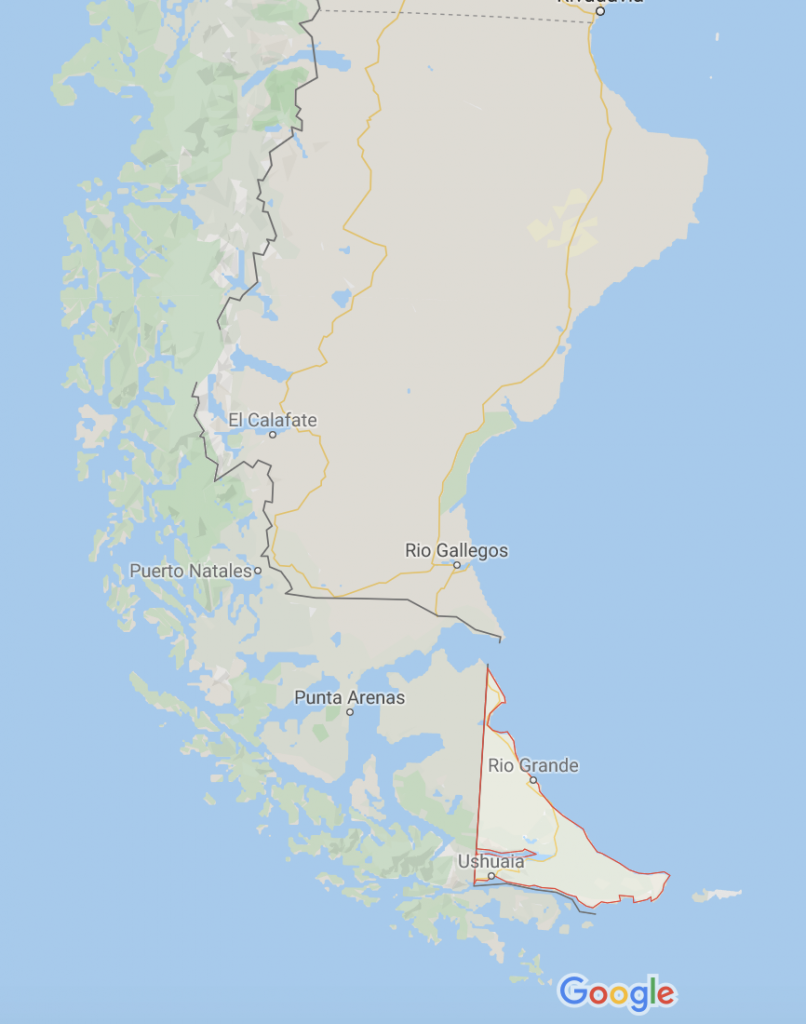
Tierra del Fuego roughly translates to “land of the fire” in Spanish. It is referred to this because when Ferdinand Magellan sailed past the area in 1520, he saw large fires on the shores that were made by indigenous people in the region. Tierra del Fuego refers to Argentinean land and a small sliver of Chile.
The majority of hiking in Tierra del Fuego is based out of the Argentinean capital of the region, Ushuaia. Ushuaia is the southernmost populated city in the world! Ushuaia is a port town by the Beagle Channel and is known for its vast landscapes, and for being the gateway to Antarctica. Nearly all of the ships headed to Antarctica with tourists leave from Ushuaia. Penguins and many marine mammals can also be seen while hiking in Ushuaia! Tierra del Fuego National Park is the only hiking area on public land that requires a few to enter.
Tierra del Fuego National Park is only about a half-hour bus ride from town. The park contains stunning lakes, snowcapped mountains, and low-lying landscapes filled with powerful rivers. To access the park, take a private taxi or a bus from town. It is about a half-hour car ride. There is an entry fee to the park. There are several different day hikes in the national park, all of which are well marked, and are relatively easy due to the flat land. The tourist office in town will have plenty of maps and information on the National Park. For your more advanced hikes, you’ll have to venture North and Northwest of town.
The Marshall glacier hike provides a stunning view of Ushuaia. One can actually see the glacier from town as it is quite close to town. Leave about 4-5 hours for this moderate hike. The hike itself is about 1500 vertical feet, and more if you want to venture onto the glacier. Make sure you have the proper technical equipment to access this glacier. Crampons, an ice axe, and a helmet would be a good idea before venturing up higher than the hiking trail. One can take a taxi from town to access this hike.
For a harder hike that is accessible close to town, consider the Lago de Los Tempanos and Glacier Vinciguerra hike . One can take a taxi to the trailhead for this hike, expect about a half-hour drive from down on paved and dirt roads. This is a spectacular and challenging hike. The hike starts by passing a small river in the valley surrounded by larger peaks. Wild horses can often be seen wandering in this area. You will then ascend steeply up towards the lake, ascending over 2500′ feet in a few short miles. Once you arrive at Lago de Los Tempanos, you will have a great view of Glacier Vinciguerra. If you hike on the glacier (be sure to do so with proper glacier equipment), you will have an amazing view looking down on the Beagle Channel, and of rugged mountains to your west and North.
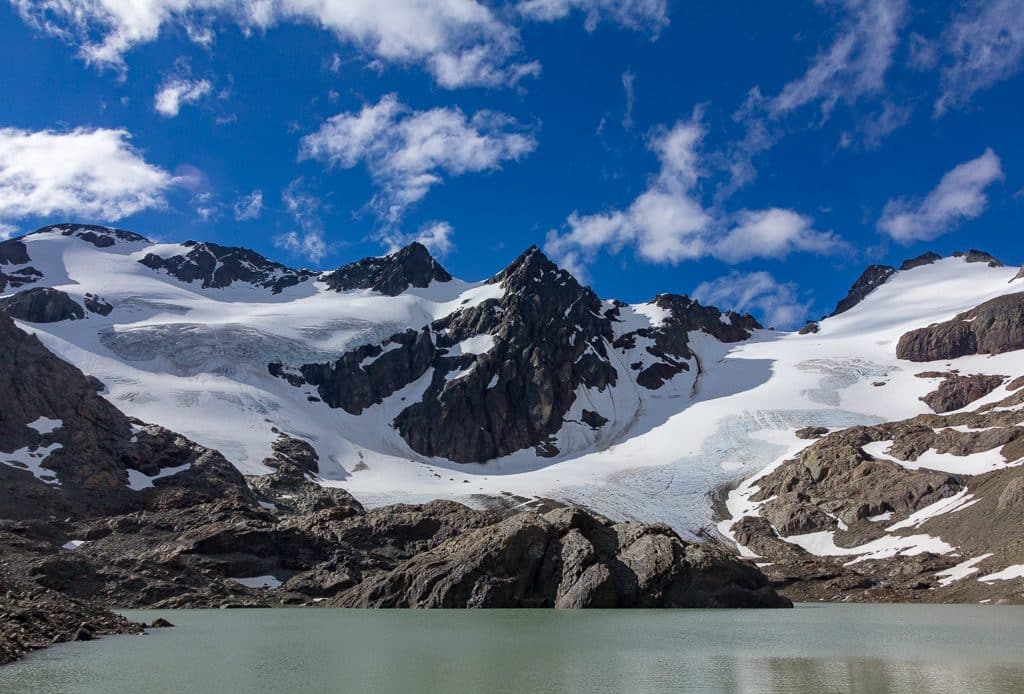
If you want to experience true remoteness in Tierra del Fuego, consider looking at the Teeth of the Narvarino trek. This is one of the most challenging hikes in Tierra del Fuego. This hike is across the Beagle Channel in Puerto Williams, Chile. It is directly south of Ushuaia, and would include a boat ride. This multi-day hiking trip is known for its rugged mountains that look like sharp teeth, and intense weather and winds. To schedule a ferry ride to Puerto Williams, visit the main port in town.
Magallanes y la Antártica Chilena Region
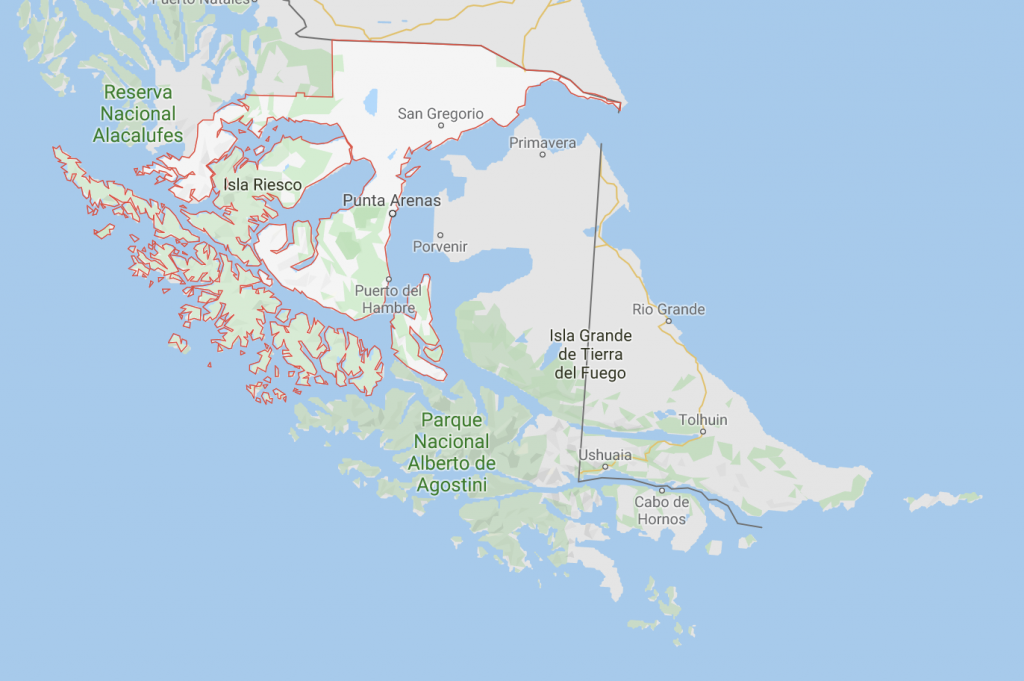
This area is known for its wildlife spotting that is more often accessible by boat and then some hiking. The Chilean capital of los Magallanes is Punta Arenas. Like Ushauia, this is a port town. Much of the industry in Punta Arenas is either tourism or import/export to this rather remote area of Chile. For hiking in this region, it would be recommended to coordinate with a tour group. There are few ways to get around to hike here, there is only one main road in the entire province!
If you enjoy an easy day paired with a boat ride to see penguins and vast landscapes at the literal end of the world, considering visiting this province. A private tour company could access Alberto de Agostini National Park by boat or plane. One of Chile’s most remote national parks includes large glaciers and dozens of endangered wildlife far from the port cities. The ruggedness of the terrain would make hiking in Agostini quite challenging.
Torres del Paine
This is the most popular hiking area in Patagonia. Do not miss this! The stunning mountain landscapes are often featured in the most well-known hiking and backpacking magazines. Think rugged mountains shooting into the sky from glaciers surrounded by deep blue waters. It is exactly what one would imagine it to be, and much more. While there are single-day hikes that can be organized most easily through tours, a multi-day trek is the best way to fully immerse oneself in the Torres del Paine region.
This section will primarily cover the three well-known treks; the W, the O, and the Q treks in Torres del Paine National Park. For any camping in the national park, you will need to reserve your campsites through Chile’s national park website. The park has gotten so popular that the Chilean National Park Service encourages visitors to reserve their campsite months in advance, as this is how they are able to decrease the number of daily visitors. One can do the treks independently, but you will still need to stay at designated campsites and organize travel in and out of the park. The nearest larger city is Puerto Natales.
This is the most popular multi-day hike and covers some of the park’s most popular sites. It takes about 3-5 days to complete and will cover about 50 miles. One can experience the famous Torres towers, see the Grey Glacier, and hike through the Francis valley. Long hiking days and poor weather can make this multi-day hike trivial.
This includes the W trek, but also includes about 2-3 days on the more remote area in the west of the Park, which includes hiking over an exposed pass. This hike will take most people about 8 days to complete. Here you will be able to have more solitude in the park. This is a more challenging hike than the W trek, and will be closer to 70 miles in length.
This is the most challenging and most remote hiking available in Torres Del Paine National Park. This trek adds another day to the O trek, making it at least a 9-day hike. Hiking distance is closer to 75 miles and allows for a rare chance of solitude in the park while experiencing what the other treks have to offer, but with more hiking below the stunning Cordillera Paine.
El Calafate and El Chaltén
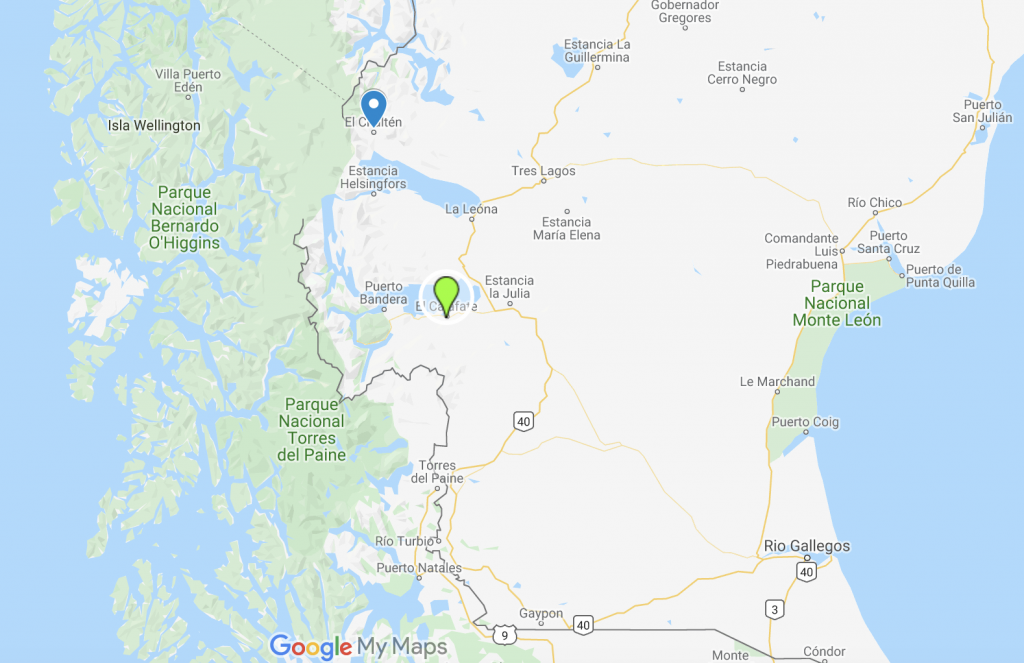
Back to Argentina. These are the most popular hiking areas in Argentinean Patagonia. El Calafate is a larger town that is the entry point to reaching El Chaltén. There are great restaurants and shops in El Calafate. El Calafate is most known for the hike out to see the Perito Moreno glacier in Los Glaciares National Park. This is not to be missed. While more of a walk, seeing this UNESCO world heritage landmark is very worth it. Consider signing up for a group tour that will take you hiking onto the glacier itself! The glacier rises more than 200 feet above the surface of the water and covers almost 100 square miles!
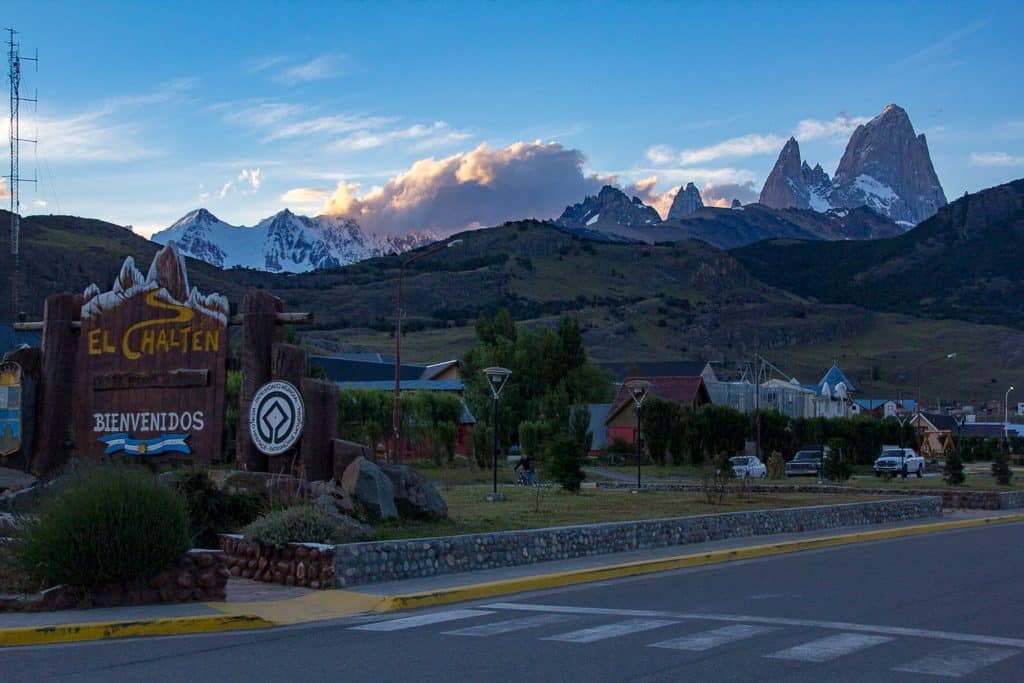
El Chaltén includes some of the most stunning scenery in South America. Some of the world’s most extreme mountains are boarded by the expansive and desolate Southern Patagonian Ice cap. You may recognize the view from town as the logo of a popular outdoor brand, named after the region. El Chaltén is a small outdoors town that was more or less founded on eco-tourism.
The only way to reach the town is by bus from Calafate (3 hours) or by boat from O’Higgins, or by bus from Perito Moreno (12 hours). Every year, climbers flock to this small town to climb some of the hardest rock and ice climbing routes in South America. Hiking and backpacking have become increasingly popular in El Chaltén.
The best way to hike this town is to get a hostel and do several day trips, and then an overnight hiking trip. The great part about hiking Los Glaciares National Park in Argentina is that entry is free, and the start of most hiking trails is within walking distance from most hotels.
El Chaltén is known for its horrendous weather that stems from the westerly winds coming from the Southern Patagonian Ice cap, just a few miles west of town. Be prepared to hike in poor weather, or leave extra time in your schedule to wait out weather days in town.
Mirador de los Condores Hike
This is a great way to start your introduction to the Fitz Roy Massif. This hike starts from the visitors center at the southernmost point of the town and is only a 1-2 hour hike. It would be a great option to do right when you get into town. It ascends a few hundred feet to give an expansive view of Cerro Torre, Mount Fitz Roy, and other magical mountains in the distance.
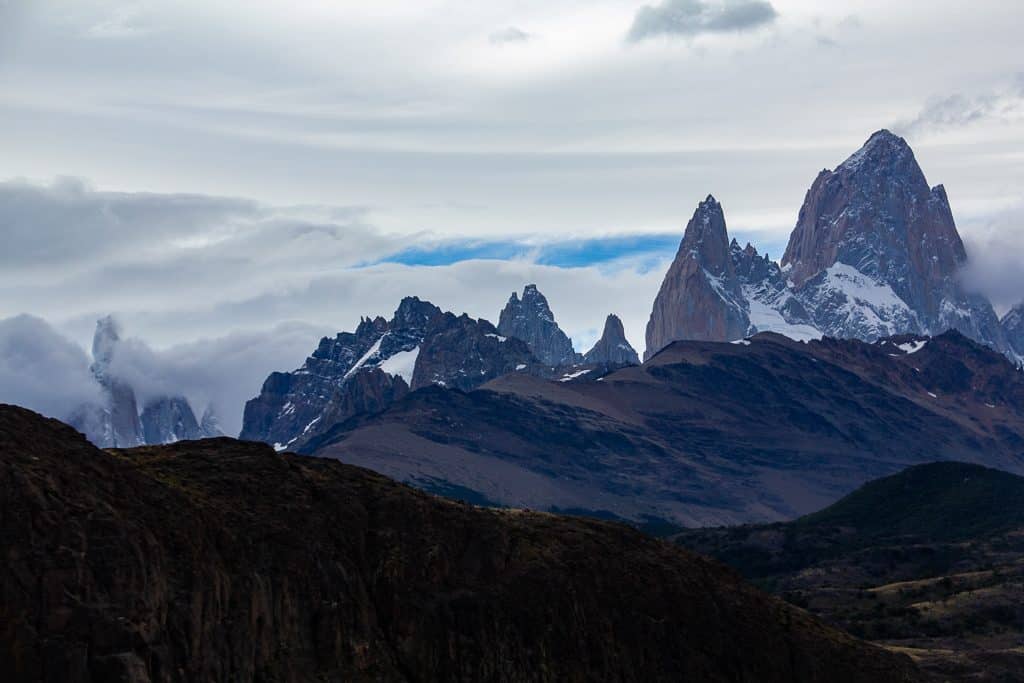
Laguna Torre Hike
This is certainly the most popular hike in El Chaltén. Expect a moderate 6-7 hour hike that ascends about 1700′ feet. This hike leaves from the center of town and will leave you at the base of the Glacier Grande and looking up at the inspiring summit of Cerro Torre. The 12-mile round trip hike includes amazing viewpoints of the higher peaks and a great view of several different glaciers from a distance.

Laguna de los Tres
This 13-mile hike includes much more vertical gain than the Laguna Torre hike, one should expect 10-12 hours of hiking for this day hike. This allows for stunning views of the lake itself, and to be under the shadow of Mount Fitz Roy and its neighboring peaks.
Paso del Viento/ Huemal Circuit
This is a multi-day hiking trip and is one of the most challenging hikes a hiker could do in El Chaltén. Expect 4-5 days for this trip. You will cover 40 miles+ of rugged terrain with access to the Southern Patagonian Ice cap and the Viedma glacier. Hiking the Paso del Viento requires good weather, the direct translation for Paso del Viento is the windy pass! It is a good idea to check in with park rangers before attempting this hike. Often a harness is needed to pass one of the rivers while completing the circuit.
The Carretera Austral – Aiysen Region
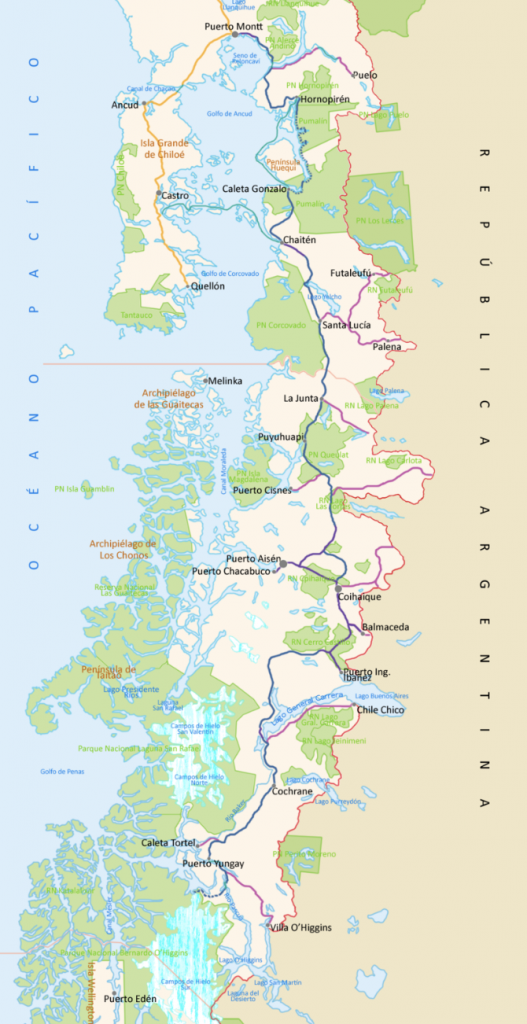
The Carretera Austral is a 745 mile long dirt road that connects the Aiysen region in Chile. An entire blog could be written on this remote highway. This region is quickly becoming a popular hiking destination. Because of its remoteness and lack of infrastructure compared to other areas in Patagonia, you will encounter fewer people. That being said, the hiking is not as recorded online as in other regions, giving this region more of an adventurous feeling. Due to the absence of such information, the ruggedness of terrain, and remoteness, hiking in this area is recommended for experienced hikers only. It is recommended to have an emergency contact device. Emergency services are few and far.
Mentioned below are only some of the dozens of hiking areas in the Aiysen region. Unless you are planning to book with a tour group, this is an area of Patagonian travel that should be left flexible. Local knowledge is best for the Carretera. There is so much to explore in Aiysen. If you are looking to be alone in vast landscapes and experience the true, raw spirit of adventure, this is where to hike. The area is being developed for hiking as we speak. Just recently, Chile has added several new national parks to the Aiysen region, due to the land donation of Tompkins Foundation.
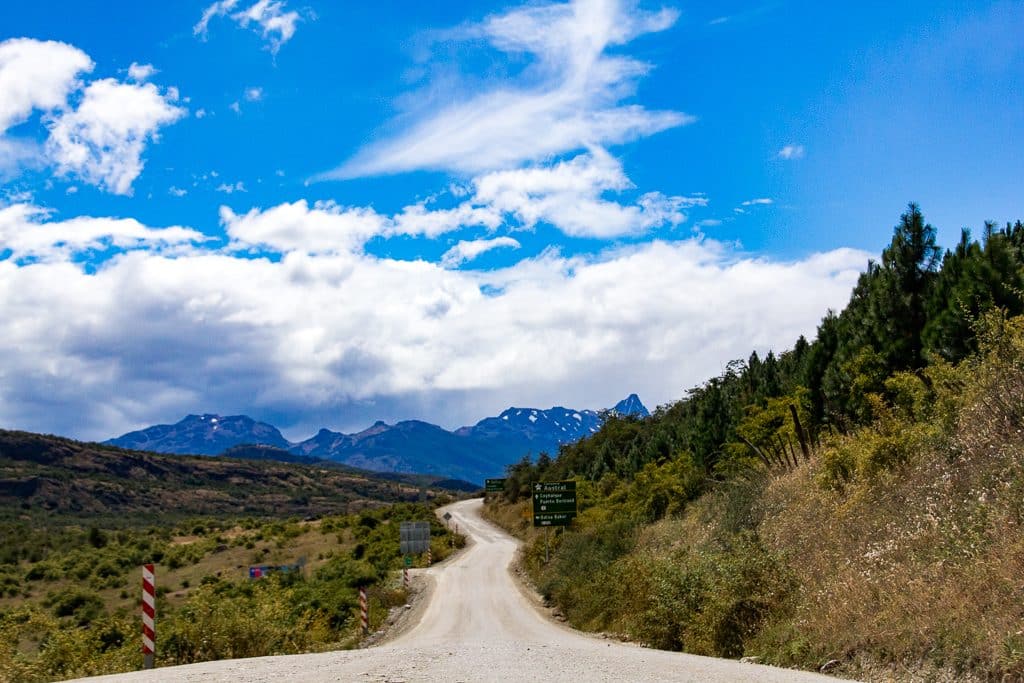
Cochrane and Parque Patagonia
The small town of Cochrane is only accessible from buses and cars on the Carretera. Cochrane is the gateway town to the new national park, Parque Patagonia . Currently, Parque Patagonia has limited infrastructure and hiking trails mapped, but there is so much to explore. Expect to see wild guanacos and intensely blue lakes underneath glacially covered mountains. The landscape is vast and undeveloped. Cochrane is one of the smaller towns where backyard camping is available. Like many other towns in this region, there is a tourist office at the bus station and free wifi in the town square. If in Cochrane consider hiking in La Reserva Tamango. This park is several miles from town and includes a 2-day hiking trip loop to see glacial-fed lakes.
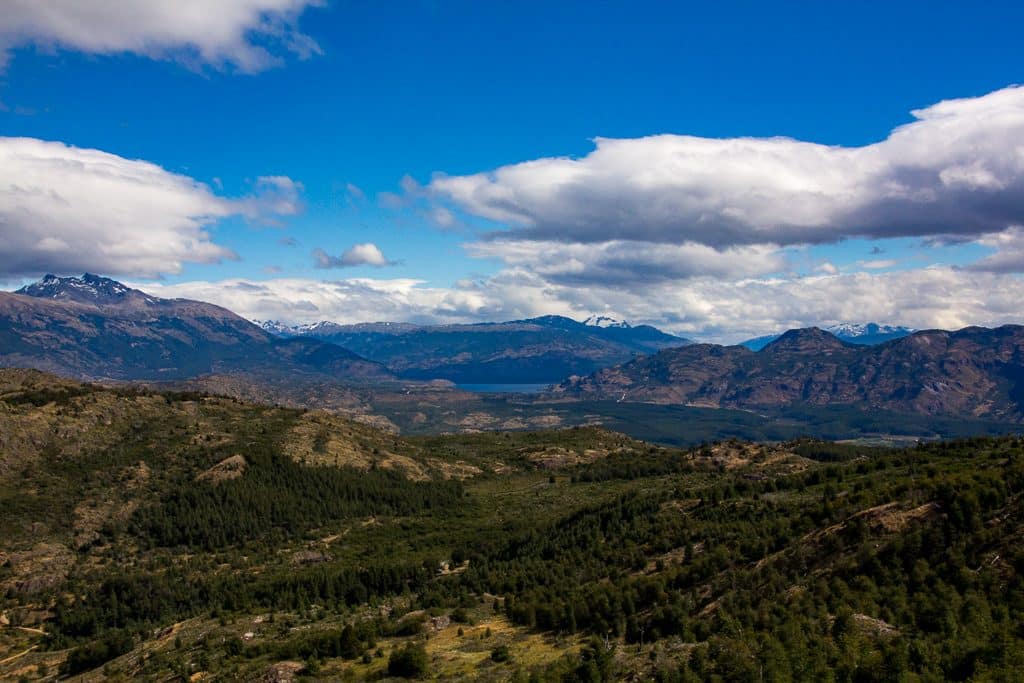
Cerro Castillo Reserve
Further north on the Carretera is the Cerro Castillo National Reserve. This is a great place for hiking to view the mountains that make up the namesake of the area, castillo that translates to castle. The pointy mountain landscapes also are home to the Andean condor and the guanaco, a symbol of Chilean Patagonia. The small town of Villa Cerro Castillo is your entrance to the reserve. There is a popular 5-day circuit that can be done by experienced hikers independently or with a guided group.
Chaitén and Parque Pumalin
Chaitén is a beautiful small town that borders the Pacific ocean across from the Island of Chiloé. It was nearly wiped out from the Chaitén volcano in 2008. Hiking in Chaitén can be found in Pumalín National Park . You will have few other people hiking with you in Pumalín. It is hard to get to, and Chaitén has very little infrastructure. In contrast to National parks down south, the climate here tends to be wetter and warmer.
The highlights of Parque Pumalín are the Chaitén volcano hike, where one can hike up to the volcano and see its incredible path of destruction. Be sure to check out Sendero de Los Alerces , which features large trees that can be 3,000 years old. The best way to access Parque Pumalín is by asking your host in Chaitén to arrange a driver to take you up to the park, it is a short drive from town.

Los Lagos Region- Chile
North of the Carretera Austral is a far more commercialized and developed region. Here it will be easier to find a hotel, find means of travel, and the wifi will be much better. There are larger cities in Los Lagos. While it is not as wild as the Carretera, there are still places to hike and experience the region. This region is known for its lakes and volcanos. Many of the volcanos include mountaineering-style summits and are recommended to do with a guided tour.
Cochamo Valley
Take a visit to the Yosemite of South America. Flanked by 1,000-foot granite walls, Cochamo looks like Yosemite National Park. There are several multi-day hikes that can be done in this valley via a bus from the city of Puerto Montt. Cochamo Valley is privately owned, and you’ll have to pay to camp in the valley. Local knowledge in Puerto Montt would provide good information on the hiking in Cochamo.
Argentinan Lakes- San Carlos de Bariloche
Bariloche is the unofficial northernmost point of Patagonia in the Argentinian Lakes region. This is a large tourist town known for its amazing hiking and good food. This is one of the few places in Patagonia that will have more luxurious places to stay. The hiking options are endless in Bariloche.
From half-day hikes to multi-day hikes, to the non-technical summit of Cerro Tronador. Hiking in Bariloche echoes hiking in the Alps in contrast to Southern Patagonia. There are multiple huts to hike to and rent, and several of the ski gondolas operate in summer to transport hikers. Bariloche is the type of destination you can arrive that and plan day hikes based on local recommendations.
Cerro Campanario
This short hike will provide a stunning view and a great warm-up for some of the harder hikes in the region. The hour-long hike to a viewpoint provides a 360-degree view of Bariloche. There is a cafeteria by the summit.
Refugio Frey
The hike to Refugio hut is about 4 hours one way and will take you to the most popular mountain hut in Bariloche. The sharp mountain range looks like the alps. Expect there to be some snow on the ground, even in the summer.
Related content
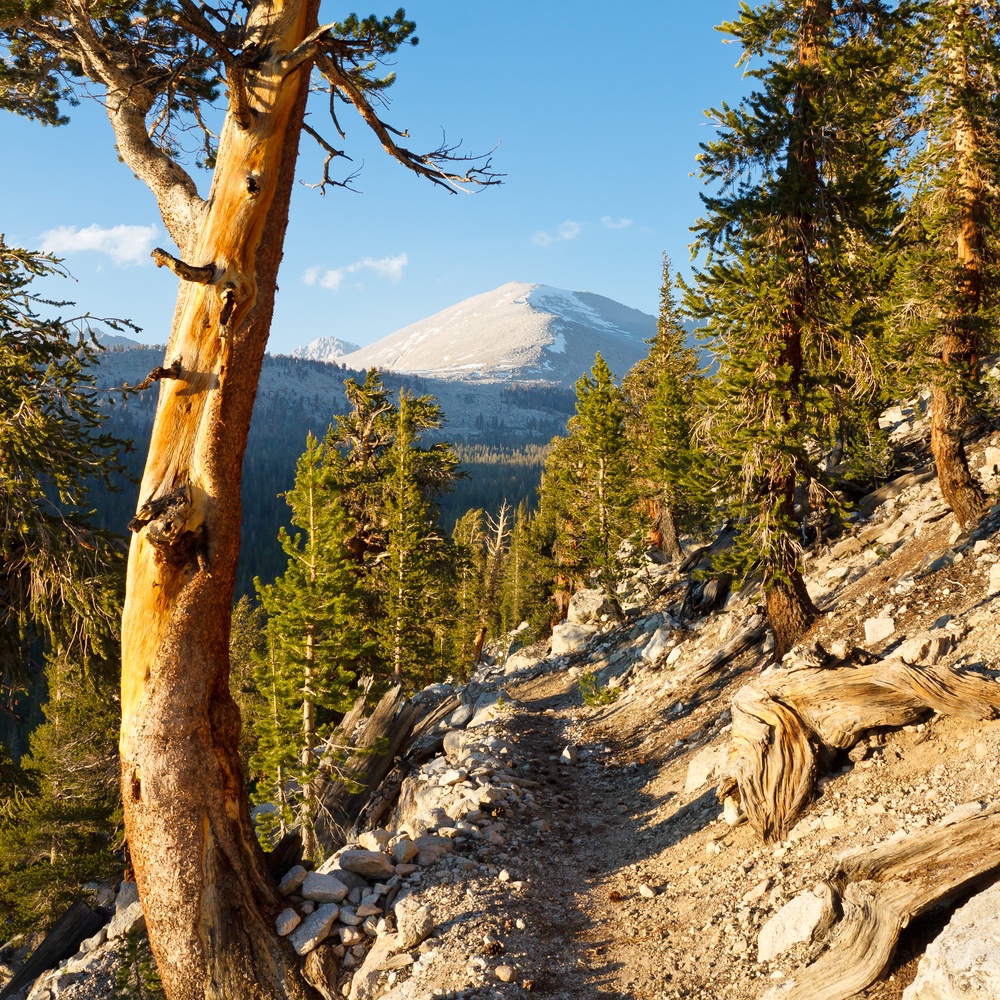
The 10 Best States for Hiking + The 50 Best Hikes
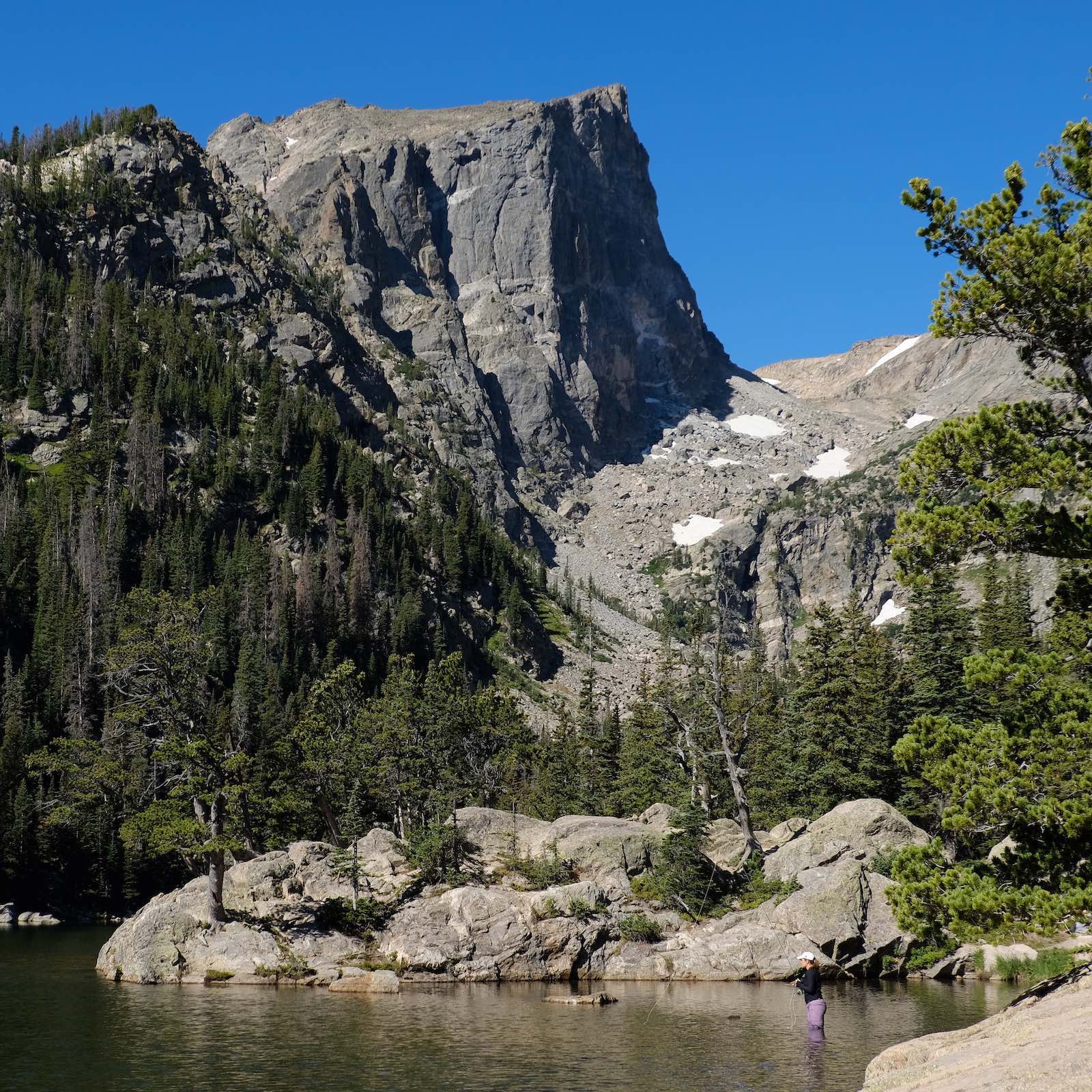
15+ Best Hikes In Rocky Mountain National Park

10 Best Winter Hikes in Colorado
We use affiliate links in our content and may receive a small commission on your purchases. Read more about us and our disclosure .
Patagonia Hiking: Torres del Paine W Trek
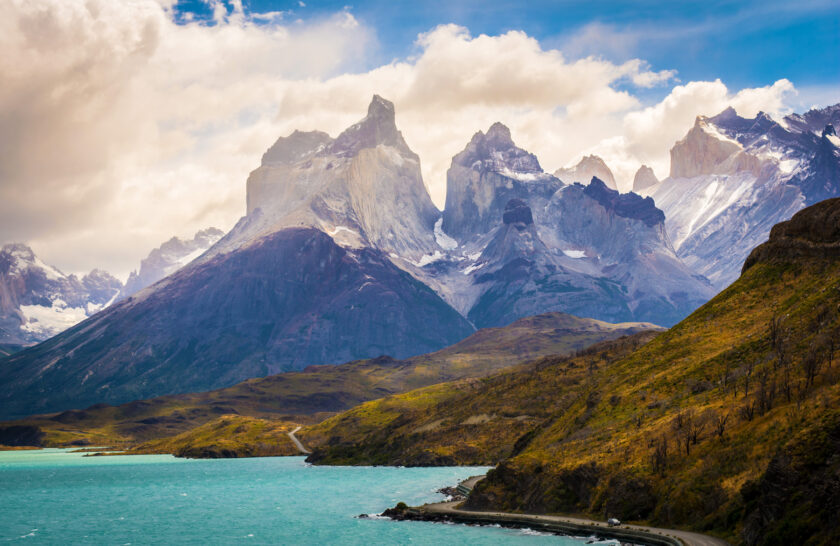
Dates & Prices
Trip details, request more info.
" * " indicates required fields
Step 1 of 2
Book Now – Reservation Request
Hike the famous w trek in torres del paine national park on this guided patagonia hiking adventure where each day’s hike ends at a cozy dome or refugio with hot showers and hearty meals..
Join us as we explore Southern Patagonia’s most iconic landscape in Chile’s Torres del Paine National Park. On this week-long Patagonia hiking adventure, we follow the world-famous and challenging W route carrying only daypacks, with accommodations including a comfortable base camp and two nights of camping. We’ll hike to the foot of the granite spires that give this park its name; explore the shorelines of Nordenskjold, Pehoe, and Grey Lakes; climb deep into French Valley; get to know the local flora and fauna and even get up close and personal with a calving glacier. Each night at our lodging accommodations we’ll share the day’s stories over hearty and delicious meals. It’s an unforgettable Patagonia hiking trip that should definitely be on your bucket list.
Trip Highlights
- Trek the famous W route in Torres del Paine National Park, the quintessential Patagonia hiking experience
- Soak in the majesty of the Paine Massif and the iconic view of the three Towers
- Marvel at calving glaciers, granite spires, turquoise lakes, and an impressive array of Patagonian fauna
- 4 nights lodging in comfortable geodesic domes and 2 nights tent camping
- Begin and end your trip in the quaint towns of Punta Arenas or Puerto Natales
What to Expect
Itinerary & Map
Itinerary at a glance.
We pride ourselves in running a relaxed and flexible schedule. Every Patagonia hiking trip is different depending upon the group, other trips in the area, and sometimes the weather. The following is a sample of what your trip might be like:
Your Patagonian Adventure Begins!
You’ll be picked-up from your hotel or the airport in Punta Arenas or Puerto Natales (depending on your preferred flight) and driven to the basecamp located in the world-famous Torres del Paine National Park. For guests coming from Punta Arenas, we’ll stop in Puerto Natales, a small town on the shores of “Seno de Ultima Esperanza,” where we enjoy a hearty local lunch.
The journey is scenic and highly atmospheric, featuring many wild birds and wonderful Patagonian landscapes. The day ends with our arrival and overnight stay at our basecamp, nestled in the heart of Torres del Paine National Park, with a prime view of the majestic Torres. Sunset is usually around 11 PM during the summer months, meaning that there will still be enough daylight for you to admire the Patagonian steppe with its guanacos and snow-peaked, mountainous horizon once you arrive.
Los Cuernos – Torres del Paine National Park, Chile
We will begin our trek with a pleasant walk along the sinuous Cuernos Trail, which meanders beside the beautiful Lake Nordenskjold. During this warm-up walk, we will have the opportunity to admire the park’s exquisite flora and fauna as we enjoy the magnificent views of the park’s central lakes and the Paine’s Horns—majestic, black, horn-like peaks of slate atop gray granite, which crown the center of the Massif. The trek ends at Refugio Los Cuernos, a small mountain refuge located by the shores of Lake Nordenskjold. Alternatively, the trek ends at Domo el Francés, located between Cuernos and Italiano camping sites, with an amazing view of Lake Nordenskjöld. The evening will be free for relaxing and enjoying dinner.
Prior to departing for the trek, you will be asked to remove your luggage from your dome accommodations since you will not be returning to basecamp until day 4. Luggage will be stored inside the secure storage dome and will be placed inside a new dome upon your return.
Hiking miles: 7.5 / ~5 hours Total elevation gain: 1,000 ft; Loss: 1,118 ft. Highest point: 800 ft.
The Paine Massif’s Heart: Valle Frances
After breakfast at the refugio, we will begin the challenging trek to Valle Francés (French Valley), along a steep trail that leads to the very heart of the Paine Massif. How far we go depends on our group’s trekking rhythm. A swifter walk will lead us to the hanging bridge over the French River, located at the foot of the southeast face of the Massif, where we will be treated to fantastic views of the valley. We will then continue to ascend towards the upper section of the valley where we will marvel at the extensive mass of the valley’s geological formations: Hoja (Blade), Máscara (Mask), Espada (Sword), Catedral (Cathedral), Aleta de Tiburón (Shark’s Fin), and the magnificent Fortaleza (Fortress).
After our upward trek, we will pause for a picnic and relax a while. This day’s trek will end as we descend through an undulating terrain of mixed grassland and light forest which will take us to Paine Grande Refugio.
Hiking Miles: 16 / ~10 hours Total elevation gain: 2,778 ft; Loss: 2,893 ft. Highest point: 2,250 ft.
Grey Glacier and Lake Pehoe
Today we’ll hike from Paine Grande Refugio, along the shores of Lake Pehoe, to the northern side of the beautiful, glacial Lake Grey. We will feast on a picnic lunch before boarding a boat that sails right to the huge, crystalline facade of Grey Glacier, where we will have plenty of time to marvel at the calving glacier. From the southern end of Grey Glacier, we will transfer back to basecamp.
Due to the temperamental weather of the region, boat trips across the lake may occasionally be restricted during Shoulder Season (October and April) or canceled if the required minimum of 10 passengers is not reached. If either is the case, we will trek up to the sightseeing point and enjoy panoramic views of the glacier instead. Then we will return on foot to Paine Grande and take a catamaran to Pudeto’s dock, where we will be picked up and driven back to the basecamp.
Hiking Miles: 7 / ~4 hours. Total elevation gain: 1161 ft; Loss: 1,158 ft. Highest point: 800 ft.
The Big Challenge: Torres del Paine
The goal of our fifth day of our 7-day Trek will be to complete the most famous trekking trail in Torres del Paine National Park! We will walk from the basecamp towards Hostería Las Torres before ascending to Ascencio Valley on the Tower’s eastern face. Mountain ridges, beech forests, and small rivers line the scenic walk toward the valley. Our big challenge will come in the form of the steep moraine, a huge mass of boulders that will lead us to that iconic base-view of the Towers—three gigantic, granite monoliths, the remains of a great cirque sheared away by the forces of glacial ice. After a tough uphill climb, the Towers will eventually come into full view, rising majestically before us, with the glacial lake visible below. Is there any better place in the world to have lunch? After feasting on the view and our picnic, we’ll backtrack along the same trail through Ascencio Valley and return to basecamp for a well-deserved dinner.
Hiking Miles: 14 / ~9 hours. Total elevation gain: 3,608 ft.; Loss: 3,608 ft. Highest point: 3,000 ft.
The Eastern Lakes
This day consists of a less strenuous trail in order to counter the exhausting efforts of the previous day. After breakfast, we will take a leisurely car journey towards Laguna Azul, passing Cañadón Macho—home to many wild guanacos and ñandúes. We will pause occasionally to admire the views of the Patagonian steppe and the towers from a different perspective. At Laguna Azul, we will hike to the lookout point, where we will be treated to a gorgeous view of both the lagoon and granite towers. (Depending on group interest, cycling to Laguna Azul may be an option.)
After lunch, we will drive to the northern shore of Sarmiento Lake where the Fauna Trail begins. As we hike northbound, we will spot an impressive range of Patagonian fauna on the vast plains, including guanacos, ostrich-like ñandús, and maybe the occasional puma print! We will pass the charming Goic lagoon and, after approximately 3 miles of relaxed walking, we will reach the Laguna Amarga Ranger Station, where we will be picked up and driven back to basecamp to celebrate over our farewell dinner.
Hiking Miles: 4 / ~3 hours. Highest point: 590 ft.
Adiós Torres del Paine!
After another hearty breakfast, we’ll take a scenic ride back to Puerto Natales and on to Punta Arenas. The included transfer arrives at the Punta Arenas Airport at approximately 12:30 PM, in time to catch flights departing later in the afternoon.
Meeting Time & Place
Chile: Punta Arenas or Puerto Natales (airport or hotel)
Meeting time
Punta Arenas: 9 -11 AM or 3 PM Puerto Natales: 2:30 PM or 6:30 PM
Punta Arenas: 12:30 PM (to hotel or for flights after 2 PM) Puerto Natales: 10:30 AM (to hotel or for flights after 12 PM)
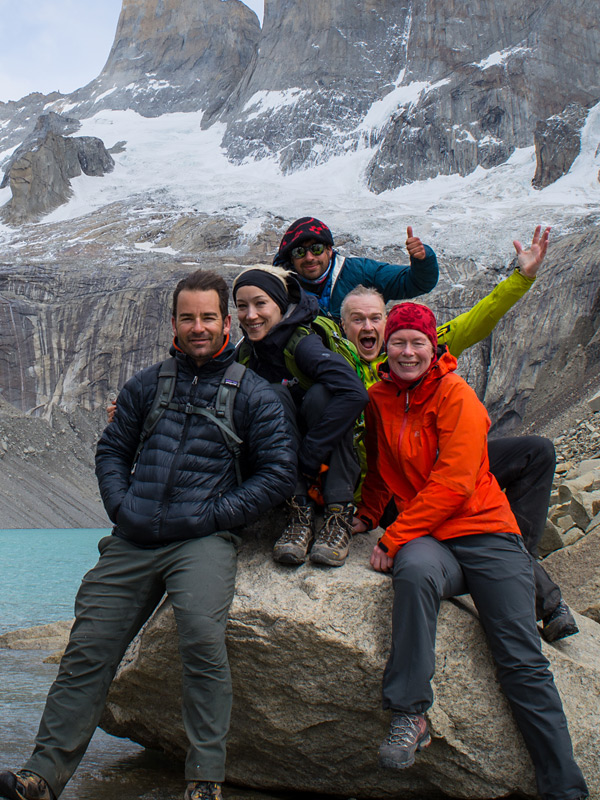
Per person based on double occupancy in a Standard dome and shared camp tent. Please call for pricing and availability for Superior and Suite domes.
$500, $800, or $1200 per person based on trip price
Additional Costs
• Mandatory emergency medical & evacuation coverage
Single Supplement*
2024: $729 (Low Season); $919 (Shoulder Season); $1351 (High Season); $1494 (Peak Season)
2024-2025: $970 (Shoulder Season); $1640 (High Season); $1860 (Peak Season)
*based on standard dome
Ways to Save
To book with one of our special offers, call 1-800-346-6277 or contact us today.
International Rewards
Receive 5% back on international trip fees & redeem on select U.S. adventures.
Frequent Floater
After 5 trips with OARS, automatically save 5-15% on most adventures.
The Need-to-Know Info
Included in Your Trip Cost
- Skilled, professional guide service provided by our affiliate operator
- 4 nights accommodation at basecamp (based on double occupancy)
- 2 nights tent camping with sleeping bag, sleeping pad, and tent provided
- Roundtrip ground transport between Punta Arenas, Puerto Natales, or El Calafate (Argentina) to Torres del Paine National Park
- All meals from lunch on day 1 through breakfast on day 7 (and limited beverages offered with meals at basecamp)
- Activities as outlined in the itinerary
- Entry fee for Torres del Paine National Park
- Porter services and all excursions included in the itinerary
- 13-liter dry bag for personal items being transported on itinerary days 2, 3 & 4
Not Included in Your Trip Cost
- Round-trip international and domestic (in Chile) flights
- Pre- and post-trip accommodation and meals
- Single supplement fee (for single occupancy of a dome at the basecamp)
- Ground transport service outside of scheduled times (day 7 early transfer from the basecamp is available), private transfers, or transportation between the El Calafate bus station and the airport (additional fee)
- Any beverages not included with each meal at basecamp or from the bar at basecamp. Non-alcoholic beverages are available for purchase from the bar at the basecamp. Beverages are not included while camping adjacent to the refugios (nights 2 & 3).
- Trekking poles (wooden walking sticks are available at camp upon request)
- Insurance of any kind, including a travel protection plan or mandatory emergency medical & evacuation coverage
Our basecamp is the perfect mix of adventure, environmental sustainability, and comfort in the wilderness offering delicious food and wine in a friendly hospitable atmosphere. It is an award-winning geodesic dome hotel that uses only green energy and a sophisticated waste recycling system.
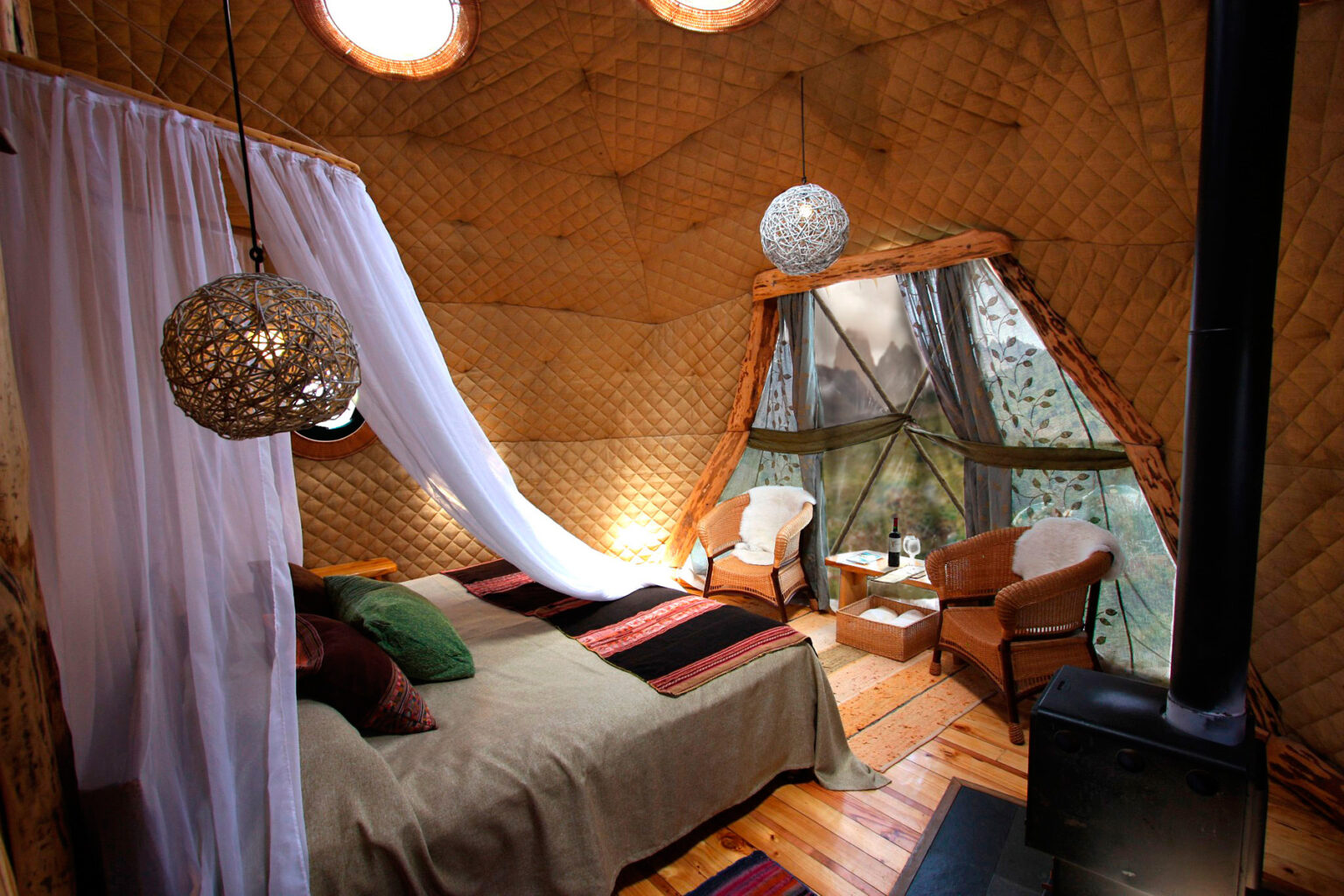
The domes come in four options:
- Standard Dome – 108 sq.ft.; no heat source; queen or two twin beds; shared bathroom (no power source, available in community dome)
- Superior Dome – 250 sq.ft.; propane heat; queen or two twin beds; private bathroom
- Suite Dome – 300 sq.ft.; wood & propane heat; king and/or twin beds; private bathroom
- Suite Loft Dome – 389 sq.ft.; wood & propane heat; king and twin beds; private bathroom
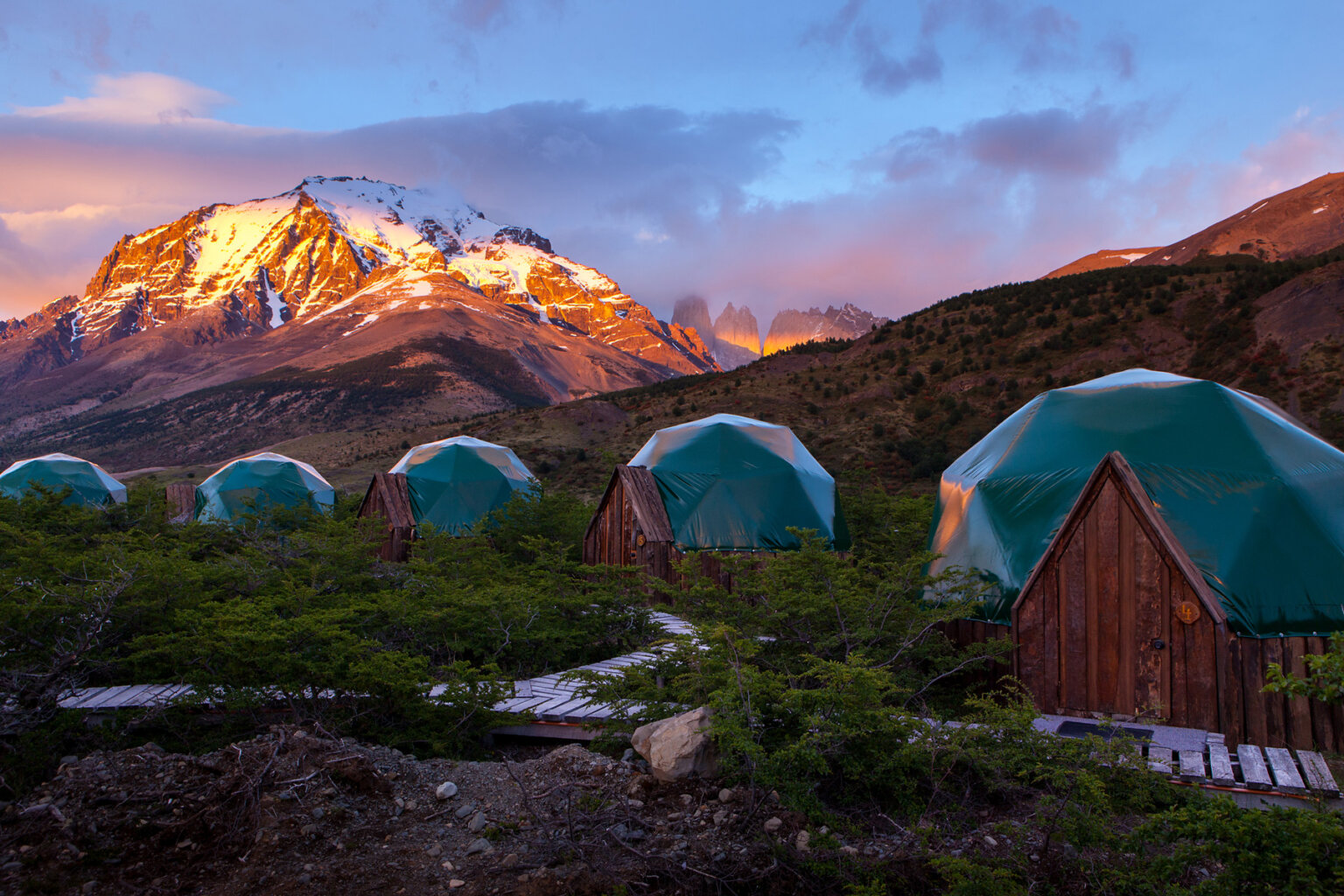
After a day’s trek guests head back to camp to dine and relax in Community Domes and later sleep in their cozy Standard, Superior, or Suite Dome. All domes are immersed in nature, resistant to the Patagonian elements, and have ceiling windows to look up at the starry night sky. (Note that upon return to camp on day 4, you may be accommodated in a different dome than your first night.)
For the two nights spent out on the trail, you’ll be accommodated at a campground adjacent to a refugio with access to the refugio’s shared bathrooms (with hot showers) and dining facilities. Sleeping bags, sleeping pads, and tents are included.

The basecamp provides tasty, innovative high-quality meals using locally-sourced ingredients, fusing Chilean, Altiplanic, Patagonian and international food. Groups eat together in Community domes and meals are a very social affair. Meals at the refugios along the trekking route are simple but plentiful.
We need to know as soon as possible about any dietary restrictions we must consider in planning your trip. If you have food allergies or necessary restrictions, we will do our best to accommodate your needs.
The vast unbroken stretch of ocean to the west and south of the South American continent leaves the Patagonian Andes very exposed to the saturated winds that circle the Antarctic landmass. Also, the influence of the strong marine currents and the Southern Patagonian Ice Field make the weather hard to predict.
In Torres del Paine in spring or early summer, fine weather may deteriorate almost without warning, bringing rain and possibly snow. Even in summer (December to March), you should come prepared for cold, strong winds (up to 130 km/hr) and rainfall. The summer’s average temperature is 52ºF (11ºC) (max: 75ºF/24ºC, min: 35ºF/2ºC).
Rest assured, however, that just as quickly as the weather turns nasty, it can become pleasantly warm! Night-time temperatures will most likely range from 20ºF to 30ºF to (–5°C to -1°C), depending on the weather.
Average Temperatures
Before booking your trip with OARS, there are a few important considerations we’d like you to know about.
- Purchase Travel Protection: In order to take part in this trip, each participant must have a minimum of Emergency Medical Evacuation coverage in place for the dates of the trip. Learn more about the plan we recommend .
- Essential Travel Documents: A passport is required for travel to Chile.
- Physical Requirements: Your outdoor adventure will be an active participatory trip. Please inform us of any physical limitations you may have as soon as possible. If you exceed 260 pounds, please give us a call. Make sure you are exercising frequently in the months leading up to your trip and can meet our Essential Eligibility Criteria .
- Trip Forms: Each participant will need to complete the required trip forms within two weeks of making a booking. If you are reserving within 90 days of departure, your forms must be completed immediately to ensure we can properly plan for your trip.
Reservations and Deposits
A non-refundable deposit is required at the time of reservation based on the following:
Deposits may be made by check, money order, or Visa/Mastercard (American Express and Discover incur a 3% processing fee). Prices are in US Dollars, and all payments must be made in US Dollars. Payment of the deposit establishes your acceptance of our complete Terms and Conditions. Individual departures and trip capacity are strictly limited by the managing agency.
Canceling your trip after your deposit is processed will incur cancellation fees because OARS has absorbed costs on your behalf and will turn others away who would like to book the spaces we’re holding for you. Final payment is due 90 days before departure. Accounts on which final payment has not been received 80 days before the departure date will be canceled without exception.
Cancellations and Refunds
Your deposit is fully refundable, less a 3% processing fee, for 7 days after you book when you submit a deposit 7 days or more before the final payment due date. If you must cancel your reservation after the rescission period described above, your cancellation fee will be determined according to the schedule below. We regret we cannot make exceptions to the cancellation policy for any reason, including foul weather, poor air quality, wildfire activity, acts of terrorism, civil unrest, or personal emergencies. There is no refund for arriving late or leaving a trip early. For these reasons, we strongly urge you to consider purchasing a travel protection plan .
A one-time request to change your departure date is possible if 60 days or more prior to the departure and is subject to any rate change if moving to another season or accommodation type.
Canceled Trips
OARS International and the outfitter Cascada Expediciones reserve the right to cancel any trip due to insufficient registration or other factors that make the trip impractical to operate. Do not make nonrefundable travel arrangements unless you have spoken to your Adventure Consultant regarding the status of your trip.
If a trip must be canceled or postponed due to force majeure (factors outside the control of OARS), OARS will provide full credit for payments made toward future travel, or a refund less a 5% service fee plus any nonrefundable payments made on your behalf to 3rd-party suppliers. OARS will make good faith efforts to recover deposits made on your behalf to 3rd-party suppliers, however, we can’t guarantee recovery of any or all of the advance payments made. OARS is not responsible for expenses incurred by participants in preparation for a canceled trip.
Under most circumstances, if you are of an adventurous spirit and in reasonably good health, you should have no problem enjoying this trip. People with medical conditions, including pregnancy, should have a physician’s approval before taking an adventure travel trip.
Our Patagonia Hiking: Torres del Paine W Trek is run by an affiliate company and arranged through O.A.R.S. International, Inc.
Related Blog Posts
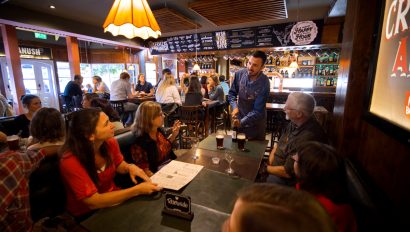
A Local’s Guide to Patagonia’s Culture and Customs
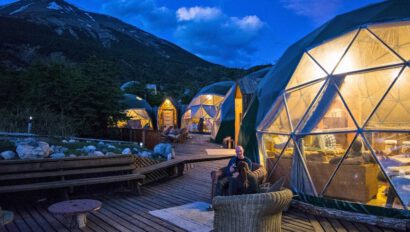
7 Amazing Lodge-based Adventures
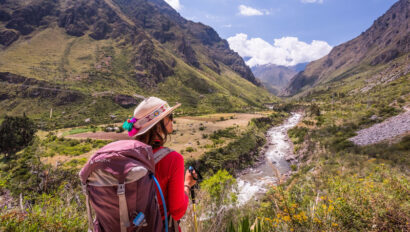
5 Essential Tips for Staying Safe Outdoors
You may also like.
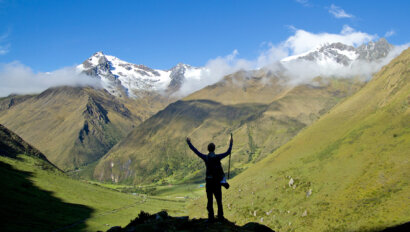
Mystical Peru Lodge Trek
Location: Machu Picchu, Peru Adventure Level: Challenging Minimum Age: 12
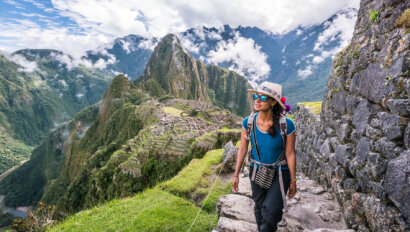
Machu Picchu Hiker
Location: Machu Picchu, Peru Adventure Level: Moderate Minimum Age: 10
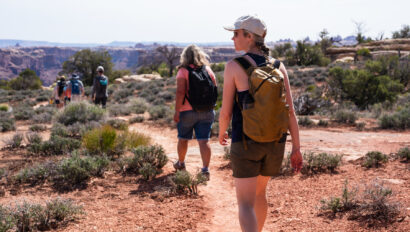
Stillwater & Cataract Canyon Hiker
Location: Utah Adventure Level: Moderately Challenging Minimum Age: 12
Can’t Decide?
Use our Compare tool to find your perfect Adventure.
Compare Adventures
Select up to 3 trips to compare

IMAGES
COMMENTS
Alesha enjoying the view over Grey Glacier. The French Valley - Valle Del Frances. Time Required: 3 to 4 hours Distance: 12km Difficulty: Moderate Start / Finish Points: Refugio Los Cuernos You always have energy in Patagonia, even when you are literally falling asleep, so don't miss this epic side trip that takes you between the Cerro Paine Grande and the Cuernos del Paine following the ...
WHEN TO VISIT. SUMMER (December-February): The peak hiking season in Patagonia is during the summer months of December through February when the temperatures are the warmest and days are the longest.Though hiking in 60-70 degree temperatures is quite nice, the crowds will be high and the wind can be fierce during this time of year, with gusts up to 75 mph at times.
Wildland's Guided Patagonia hikes are all-inclusive opportunities to discover Patagonia's sheer granite spires, towering mountains, glaciers, lakes, rivers, wildlife and more! Our Patagonia hiking tours are focused on Torres del Paine National Park, an invaluable conservation and wilderness gem in Chile; and Parque Patagonia, a vast ...
Difficulty level: easy to moderate. The hike to Laguna Esmeralda is one of the easy hikes in Patagonia. It takes you to a beautiful emerald lagoon at the base of Glacier Albino. The starting point of the hike to Laguna Esmeralda is in Valle de Los Lobos, about 17 Km (10.5 miles) east of Ushuaia, along Ruta 3.
Highlights: Witness the famous Torres del Paine towers mirrored in the glacial lake. One cannot speak of hiking in Patagonia without mentioning Torres del Paine National Park. A must-visit for any trekking enthusiast, the Mirador Las Torres trail offers a challenging but immensely rewarding day hike.
Other hikes in Torres del Paine National Park: There are dozens of trails in the park, so read my guide to the best Torres del Paine day hikes for inspiration. 10. Hike to Cabo Froward, Punta Arenas. The beginning of the Cabo Froward trail, a truly beyond-the-beaten-trail hiking route in Patagonia.
Volcan Chaitén Crater Trail, Parque Nacional Pumalín Douglas R. Tompkins (Chile) Best all-encompassing view. 2.7 miles (4.4km) round trip, 3 hours, moderate. In 2008, the eponymous volcano in northern Patagonia staged a surprise eruption and buried half the town of Chaitén under mud and ash. This relatively steep five-hour round-trip trek ...
Patagonia is a hiker's paradise with world class trails. Whether you're looking to see the highlights on the famous W Trek or go off the beaten track somewhere more remote, there are group trekking trips in every region of Patagonia.. Most group trekking tours come packaged with fixed itineraries, dates and prices, making them easy to plan around to give you peace of mind.
The Glacier Viewpoint Trail is a popular hike in Chilean Patagonia's Pumalín National Park. This trail takes you through lush forests and scenic river valleys, leading to a stunning view of the park's glaciers. This hike is approximately 4 mi (6.4 km) round trip and takes approximately 2 to 3 hours to complete.
SUMMER. The best tie for hiking in Patagonia. Warmer weather and less less rain, but very strong winds. Temperatures are in the mid 50s F to low 60s F. Summer the busiest season of the year and most places in Patagonia are full to capacity.
Travel in Patagonia is expensive. Back in March 2017, a three-week trip to Patagonia, which included hiking the O Circuit in Torres del Paine, renting a car to explore Tierra del Fuego and staying in basic to mid-level accommodation (with some camping thrown in) cost around $592,830 CLP/$900 USD.We could have done the trip cheaper, but this figure should give a sense of how expensive travel ...
Length: Variable; shortest route is 16 miles (26 kilometers) Difficulty: Moderate to challenging. Access: El Chaltén serves as the starting point for Fitz Roy hikes. The town is easily reachable from El Calafate by bus. One of the most legendary views in Patagonia, Fitz Roy is a famous and popular trek for good reason.
Scott founded FunOutdoors to connect his professional life with his passions. When Scott isn't working, you'll find him on the bike trail, riding a wave, or skiing down a mountain. Set out for an epic adventure in Patagonia Hiking. Our 2024 guide gives expert advice on gear, preparations, top trails, and must-see sights!
Build your ideal Patagonia trip. Call 1.406.541.2677. Start Planning My Trip. Patagonia has some of the world's premier hiking and trekking destinations such as Torres del Paine National Park, Los Glaciares National Park, and the Fitz Roy range near El Chalten. You'll have the unique opportinity to go hiking on top of glaciers, or hike one of ...
Paine National Park, Chile. Days 11-12 (2 nights) With its prime setting along an iceberg-dotted lake in Paine National Park, Hotel Lago Grey gives us direct access to Paine's glaciers and trails. From the dining room's large picture windows, we'll have a stunning perspective on the calving ice of the Grey Glacier.
The Absolute Best of Patagonia — We'll take you to the most iconic places including Fitz Roy, Torres del Paine, and Tierra del Fuego, hiking by day and being welcomed at boutique hotels and heritage estancias by night. The Right Pacing to Truly Experience Patagonia — Patagonia is vast, and its weather is notoriously changeable—you can ...
As part of her two year solo trek, Dina Carter gives you the lowdown on hiking hubs in Patagonia. Written by: Dina Carter , 3 Jan. 2023 03:51 p.m. To hike across Patagonia is by far, one of the most active travel experiences to be found anywhere in the world. Do it with G Adventures.
Group Size: 2-12 Guests. Trip Length: 7 Days. Distance: 34.1MI / 54.9KM (*Optional: 5MI / 8.1KM) Minimum Guests. We're here to help. If you have any questions, call 800-715-HIKE or contact us online . PDF Trip Itinerary Packet Book online. Or fill out a Reservation Request.
El Chaltén to Ushuaia: Hiking in Patagonia. from 4850 USD. HIGHLIGHTS. Chaltén -Calafate -Torres del Paine - Ushuaia. days 16. Request Info. Sail to see the Perito Moreno Glacier from close. Hike near the stunning Mount Fitz Roy and stay in Torres del Paine National Park. Travel to Ushuaia, the most southern city of the world and sail the ...
The region of Patagonia refers to a large region in Southern Argentina and Chile. Covering a length of more than 1,500 miles, there is more than a lifetime to explore all the hiking in Patagonia. Patagonia is a loosely defined geographic area. Most people consider Patagonia to include the southernmost region of Tierra del Fuego and then ...
Where to Stay:Mid-range:Yelcho en la Patagonia|Mid-range:Paraiso Patagonico|Mid-range:Hotel Mi Casa. #2 Hanging Glacier in Queulat National Park. Queulat National Park, near a small village called Puyuhuapihides one of the most photogenic places in Patagonia, the Hanging Glacier.
Trek the famous W route in Torres del Paine National Park, the quintessential Patagonia hiking experience. Soak in the majesty of the Paine Massif and the iconic view of the three Towers. Marvel at calving glaciers, granite spires, turquoise lakes, and an impressive array of Patagonian fauna. 4 nights lodging in comfortable geodesic domes and 2 ...
For a day hike in Patagonia, it is enough to have a maximum of 20 liters backpack where you can store your extra layers, snack, camera, and water. Backpack 45-55L| For traveling between hiking destinations in Patagonia, you'll need a bigger backpack that will contain all your things. Footwear.